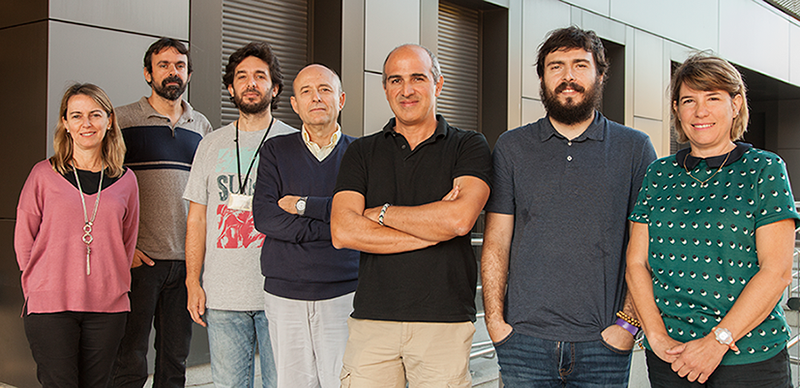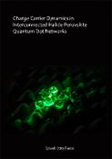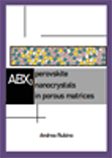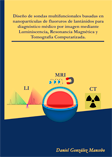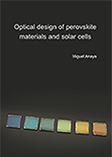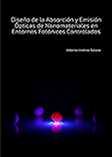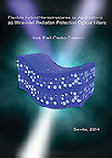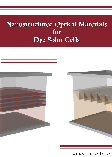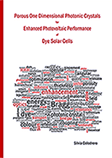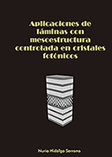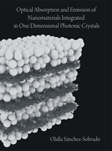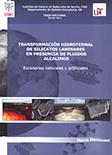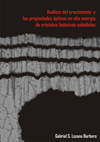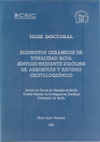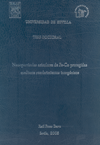Optical Materials
Profesores de Investigación
Míguez García, Hernán RuyProfesor de Investigación CSIC ✉ h.miguez@csic.es ☎ 954 48 95 81 ✆ 446181 ORCID 0000-0003-2925-6360 |
Ocaña Jurado, ManuelProfesor de Investigación CSIC ✉ mjurado@icmse.csic.es ☎ 954 48 95 33 ✆ 446133 ORCID 0000-0001-9989-606X |
Investigadores Científicos
Becerro Nieto, Ana IsabelInvestigadora Científica CSIC ✉ anieto@icmse.csic.es ☎ 954 48 95 45 ✆ 446145 ORCID 0000-0003-2243-5438 |
Calvo Roggiani, MauricioInvestigador Científico CSIC ✉ mauricio.calvo@icmse.csic.es ☎ 954 13 92 20 ✆ 446151 ORCID 0000-0002-1721-7260 |
Lozano Barbero, GabrielInvestigador Científico CSIC ✉ glozano@icmse.csic.es ☎ 954 13 92 21 ✆ 446152 ORCID 0000-0002-0235-4924 |
Científicos Titulares
Caliò, LauraCientífica Titular CSIC ✉ laura.calio@icmse.csic.es ☎ 954 13 92 25 ✆ 446158 ORCID 0000-0002-7394-9263 |
Galisteo López, Juan FranciscoCientífico Titular CSIC ✉ juan.galisteo@csic.es ☎ 954 48 95 87 ✆ 446180 ORCID 0000-0002-7987-4813 |
Núñez Alvarez, NuriaCientífica Titular CSIC ✉ nurianu@icmse.csic.es ☎ 954 48 96 21 ✆ 446121 ORCID 0000-0003-3910-6489 |
Doctores Contratados
Anaya Martín, MiguelDoctor Contratado Universidad de Sevilla ✉ anaya@us.es ORCID 0000-0002-0384-5338 Materiales Semiconductores para la Sostenibilidad |
Esteso Carrizo, VictoriaDoctora Contratada Universidad de Sevilla ✉ vesteso@us.es ORCID 0000-0002-1976-8306 Materiales Semiconductores para la Sostenibilidad |
Fernández Carrión, Alberto JoséDoctor Contratado Universidad de Sevilla ✉ afernandez15@us.es ORCID 0000-0002-5044-3227 |
Ngo, Thi TuyenDoctora Contratada CSIC ✉ thituyen.ngo@icmse.csic.es ☎ 954 13 92 25 ✆ 446158 ORCID 0000-0002-6312-4129 |
Personal Investigador en Formación
Coto Ruiz, Francisco JavierInvestigadora en FormaciónCSIC ✉ francisco.coto@icmse.csic.es ORCID 0009-0007-6431-9271 |
De Sola Báez, BeatrizInvestigadora en Formación CSIC ✉ beatriz.desola@icmse.csic.es ☎ 954 48 95 93 ✆ 446194 ORCID 0000-0002-5388-604X |
Fernández Muñoz, SolInvestigadora en Formación Universidad de Sevilla ✉ sol.fernandez@icmse.csic.es ORCID 0000-0001-8114-5567 Materiales Semiconductores para la Sostenibilidad |
Hidalgo Montero, CarmenInvestigadora en Formación Universidad de Sevilla ✉ chidalgo1@us.es ORCID 0009-0008-1591-9323 Materiales Semiconductores para la Sostenibilidad |
Romero Aguilar, ManuelInvestigador en FormaciónCSIC ✉ manuel.romero@icmse.csic.es ☎ 954 48 95 93 ✆ 446193 ORCID 0000-0002-7594-1361 |
Santiago Andrades, LucíaInvestigadora en FormaciónCSIC ✉ lucia.santiago@icmse.csic.es |
Vega Morrone, GuadalupeInvestigadora en FormaciónUniversidad de Sevilla ✉ gvega2@us.es Materiales Semiconductores para la Sostenibilidad |
Personal Técnico
Gutiérrez Lázaro, María del CarmenTitulado Superior CSIC ✉ carmen.g.l@csic.es ☎ 954 13 92 52 ✆ 446194 |
Personal Técnico Contratado
Abrante Fernández, JorgeTécnico en FormaciónCSIC ✉ jorge.abrante@icmse.csic.es ☎ 954 13 92 32 ✆ 446167 |
Castillo Flores, Lucía T.Project Manager CSIC ✉ lucia.castillo@icmse.csic.es ☎ 954 48 95 93 ✆ 446193 |
Photonic Design of Optoelectronic Devices based on Perovskite Quantum Dot Solids (PQD-Photonics)

01-09-2024 / 31-12-2027
Investigador Principal
Hernán Ruy Míguez García / Mauricio Calvo Roggiani
Organismo Financiador: Ministerio de Ciencia e Innovación y Universidades
Code: PID2023-149344OB-I00 (Proyectos de Generación del Conocimiento)
Equipo de Investigación: Juan Galisteo López, Laura Caliò, Carmen Gutiérrez Lázaro, Lucía Castillo Flores
Quantum dot (QD) solids are mainly prepared by deposition of nanocrystal suspensions onto flat substrates, typically after a lengthy ligand exchange procedure, needed to achieve the dot-to-dot charge transport required in an optoelectronic device. While this process has been optimized to yield high absorption coefficient and luminescence quantum yield together with good carrier mobility, which has allowed the fabrication of efficient solar cells and light emitting diodes, QD films built in this way usually present imperfections (inhomogeneities, aggregates, thickness variations, surface roughness…), whose main fingerprint is the presence of diffuse light scattering that gives rise to partial opacity. One of the deleterious consequences of this scattering is that it hinders the implementation of a photonic design that could maximize light absorption and/or emission through a rational, deterministic, spatial distribution of the in-coupled or out-coupled electromagnetic fields. Recent advances made by the applicant group in (i) the development of transparent (i.e., scattering free) lead halide perovskite quantum dot (PQD) based solids, (ii) the realization of the first optoelectronic materials based on these transparent PQD solids and (iii) the analysis of charge transport through them by advanced spectroscopic techniques, allow foreseeing a credible solution to this limitation. In this context, the PQD-Photonics project aims at realizing improved configurations in which both the optical and charge transport properties are optimized, giving rise to more energy efficient, versatile, stable and functional PQD solid-based optoelectronic devices. Enhanced performance of solar cells, color converting layers, light emitting diodes, lasers, and photodetectors, is targeted by integrating a variety of device processing-compatible photonic designs. Although all materials and devices that will be studied are halide perovskite based, the results of this project could be straightforwardly extended to any kind of solution processed semiconductor QD, which widely broadens the range of materials and devices that can benefit from the results achieved in the PQD-Photonics project.
X-ray Detectors Based on Perovskite Composites

01-10-2023 / 31-03-2025
Investigador Principal
Miguel Anaya Martín
Organismo Financiador: BBVA
Code: LEO23-11319
Photon counting detectors have the potential to transform how we obtain CT scans to achieve low dose, high resolution images for medical diagnosis and monitoring. However, the materials currently used to manufacture these detectors require extremely high purity and are, therefore, economically expensive to achieve, limiting their widespread adoption. This project will employ perovskite composites to considerably reduce production costs and facilitate the scalability of direct X-ray detectors, thus opening avenues to making them universal in CT imaging.
Photonic materials boost afterglow in transparent persistent luminescence thin films

01-12-2023 / 30-11-2025
Investigador Principal
Gabriel S. Lozano Barbero
Organismo Financiador: Ministerio de Ciencia e Innovación. "Europa Excelencia"
Code: EUR2023-143467
Persistent luminescent (PersL) materials are able to store optical energy in structural defects that act as traps and generate light long after the excitation source disappears, i.e. afterglow, allowing the introduction of time as a design element in new lighting solutions. Despite the advantages associated with size reduction, the properties of persistent nanomaterials are far from those of their bulk counterparts. PHLOW seeks to find new ways to control PersL by designing the optical environment of emitters, a path unexplored until today. To this end, it is proposed to process transparent thin films with PersL for integration into photonic architectures in order to optimize the charging process and improve the amount of light emitted during the afterglow. It is relevant to note that the charge storage and emission processes compete with each other. That is, as the traps are filled, they are also partially emptied in a dynamic process. However, there is no strategy specifically designed to alter the charging process or increase the population of the traps. At the same time, the radiative de-excitation rate of a transition depends on the optical environment through the local density of optical states. For this reason, the optical design is expected to have an impact, in addition to the outcoupling mechanism, on the intrinsic process of light generation, which should allow altering the trap population balance, affecting the charge kinetics and the intensity of the PersL. Thus, the general objective is to study the impact of changes in the optical environment on the processes of energy storage and persistent light emission in order to highlight the potential of optical design as a tool to control PersL in transparent thin films. This naturally interdisciplinary approach will have a profound scientific impact, as photonics has never been explored to control the charge and emission mechanisms that determine PersL, but also technological, as it enables the development of timedependent light sources to drive more versatile color converters, smart labels, novel coatings for anti-counterfeiting or optical data storage.
Ligand Free Halide Perovskites in Porous GaN for Next Generation Light Emission Applications (PEROGAN)

01-09-2023 / 31-08-2026
Investigador Principal
Miguel Anaya Martín / Sol Carretero Palacios
Organismo Financiador: Ministerio de Ciencia e Innovación
Code: PID2022-142525OA-I00
Equipo de Investigación: Alberto Jiménez Solano
PEROGAN proposes a material disruption by growing halide perovskite emitters within nanostructured GaN pores. The project will be driven by the optical modelling and visualisation of the material properties where the interplay between photophysics, composition and structure will be controlled at the nanoscale. Defect tolerant, soft perovskite materials will be combined with highly performing GaN in a monolithic fashion. This project will lay the foundations for future scientific achievements where operating, cost-effective LEDs with output a la carte will be able to cover photonic applications such as lighting, imaging and sensing.
PHOTOelectrocatalytic systems for Solar fuels energy INTegration into the industry with local resources

01-09-2023 / 31-08-2027
Investigador Principal
Hernán Míguez y Laura Caliò
Organismo Financiador: Unión Europea
Code: HORIZON-CL5-2022-D3-02-06
The PHOTOSINT project presents solutions to the challenges chemical industries are facing in integrating renewable energy sources into their processes. The project will deliver sustainable processes to produce hydrogen and methanol as energy vectors using only sunlight as an energy source and wastewater and CO2 as feedstocks, making the industries more auto-sufficient. The pathway is based on solar-driven artificial photosynthesis, and aims to develop new catalytic earth-abundant materials and modifications of existing ones to improve catalytic processes. Design parameters of the PEC cell will be tuned to maximize solar to fuel (STF) efficiency. Moreover to improve the conversion for industrial implementation, PHOTOSINT will develop a novel way to concentrate and illuminate the semiconductor surface to maximize overall energy efficiency. Perovskite solar PV cells will be integrated to harvest the light to supply the external electrical voltage.
PHOTOSINT is an ambitious project due to precedents in research conducted to date and the low production rate of the desired products. For integrating sunlight energy into the industry, the catalyst will be studied, and then the best one/s will be implemented in prototypes. The obtained results will be used for making scale-up in pilots with tandem PEC cells. These steps are necessary to assess the industrial scale-up feasibility, promoting the increased competitiveness of renewable process energy technologies and energy independence. MeOH and H2 will be tested in engines. Also, an HTPEM fuel cell will be used for electricity generation, and hydrogen will be tested as an alternative fuel for energy generation instead natural gas in melting furnaces avoiding CO2 emissions.
Influence of the optical environment on persistent luminescence nanomaterials: A new tool for the design of nanobatteries of light

19-05-2023 / 19-11-2024
Investigador Principal
Gabriel S. Lozano Barbero
Organismo Financiador: Fundación BBVA
https://www.redleonardo.es/beneficiario/gabriel-s-lozano-barbero/
The development of societies is linked to their ability to generate artificial light, from torches to today's ubiquitous light-emitting diodes (LEDs). Persistent luminescence (PersL) materials are able to store optical energy in structural defects and generate light long after the excitation source disappears, making them batteries of light. Despite the advantages associated with size reduction, the properties of persistent nanomaterials are far from those of their bulk counterparts used in signaling or ornamentation. This proposal pursues to integrate PersL nanomaterials into transparent thin films and to precisely characterize the charging kinetics and the amount of light emitted during afterglow as a function of the optical environment of the coatings. Photonics has never been explored to control the charging and emission mechanisms that determine PersL, which may have an impact on the development of more versatile color converters, smart labels, anti-counterfeiting elements or optical data storage
Photophysical analysis of parameters affecting efficiency and stability of dry processed metal halide perovskite solar cells: activation and degradation processes

01-12-2022 / 30-11-2024
Investigador Principal
Hernán Míguez García / Juan Francisco Galisteo López
Organismo Financiador: Ministerio de Ciencia e Innovación
Code: TED2021-129679B-C22
Equipo de Investigación: Mauricio Calvo Roggiani, Gabriel Lozano Barbero
Advanced photophysical characterization has proven to be a key tool in the study of the optoelectronic properties of metal halide perovskites. Over the past decade time-resolved absoprtion and emission measurements have unveiled the unique photophysics of this material and have contributed to explain both, their outstanding performance in light harvesting and emitting devices but also its main limitations, such as material instability. These measurements have thus been used as a means to guide materials fabrication beyond trial and error approaches and have contributed to turning perovskites into the fastest growing photovoltaic technology. In this regard, advanced optical characterization will be employed in the present subproject (ESPER2) to bring vacuum thermal evaporated PV devices one step closer to the optimal performance in terms of efficiency as well as stability. A combination of steady state and time-resolved optical characterization experiments will be performed on perovskite films, architectures and devices in order to understand those factors affecting its performance: the presence of crystalline defects (and means to avoid them via compositional changes and passivating agents), the transfer of charges from the perovksite to adjacent charge transporting layers and the presence of photo-induced processes (such as photo activation and degradation) as well as the possibility of using the latter as a means to improve the materials optoelectronic properties. Beyond extracting critical information regarding charge recombination and transport, an optical design will be carried out in order to optimize light harvesting within the device comprising the best performing materials. The proposed characterization will thus help bringing a technology amenable to be used for mass production, such as vacuum deposition, closer to the market demands in terms of efficiency and durability.
Lanthanide-based bioprobes for MRI and persistent luminescence imaging

01-09-2022 / 31-08-2025
Investigador Principal
Ana Isabel Becerro Nieto / Manuel Ocaña Jurado
Organismo Financiador: Ministerio de Ciencia e Innovación "Generación de Conocimiento"
Code: PID2021-122328OB-100
Equipo de Investigación: Nuria O. Núñez Álvarez
The overall objective of this project is the development of new contrast agents (CAs) to improve medical diagnostics using two advanced imaging techniques such as magnetic resonance imaging (MRI) and persistent luminescence (PersL) imaging. Specifically, it is planned to develop dual MRI (T1-T2) CAs and PersL bioprobes. The advantage of dual MRI CAs over classical MRI CAs is that they allow two types of resonance images (T1-and T2 weighted images) to be obtained with a single agent. Obtaining both images is very useful as it allows avoiding false positives by cross-validation of both images. On the other hand, the use of probes with PersL significantly improves the signal-to-noise ratio of the luminescence image since, by irradiating the probe outside the organism, autofluorescence of the tissues is avoided. An additional advantage of this type of luminescent probes is that they avoid direct irradiation of living tissues with harmful ultraviolet light. Both types of CAs (MRI and PersL CAs) will consist of uniform nanoparticles (NPs) based on various carefully selected inorganic matrices containing lanthanide ions, whose excellent magnetic and luminescent properties make them ideal candidates for the pursued applications. For MRI CAs, two types of architectures will be addressed, consisting of single-phase nanoparticles (NPs), where the T2 (Dy3+) and T1 (Gd3+ or Mn2+) active cations are in solid solution, and NPs with core-shell architecture, where the T2 ions will be located in the core while the active ions for T1 imaging will be located in the shell. In both cases, phosphate, vanadate and molybdate matrices will be tested, which have been shown to be suitable in the case of T1 or T2 single MRI CAs. In the case of PersL probes, several compounds that have shown excellent luminescence properties in terms of both intensity and persistence duration as bulk materials, will be synthesized as uniform NPs. Specifically, various germanate and gallate matrices doped with lanthanide ions (Pr3+, Yb3+), that emit infrared light within the biological windows, where the radiation is not absorbed by biological tissues or fluids thus improving the penetration depth, will be addressed. Both types of CAs (MRI and PersL CAs) will be submitted to functionalization and bioconjugation processes to provide them with colloidal stability and tumor-specific recognition capabilities. Their biocompatibility will also be tested by studying their cytotoxicity in specific cell lines. Finally, the optimal probes obtained will be applied to MRI and PersL imaging, both in vitro and in vivo, using mice as a model. The research team has extensive experience in the synthesis of lanthanide-based inorganic NPs and has most of the necessary means for their morphological, structural and chemical characterization, as well as for the study of their luminescent properties. In addition, this team has the support of researchers from other institutions who will collaborate in the development of some of the tasks, mainly with regard to bioconjugation, biocompatibility and image recording studies, which guarantees the correct development of the project.
New multimodal contrast agents for medical diagnostic imaging
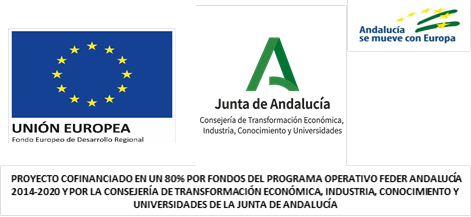
05-10-2021 / 30-06-2023
Investigador Principal
Ana Isabel Becerro Nieto
Organismo Financiador: Junta de Andalucía
Code: P20_00182 - PAIDI 2020
Equipo de Investigación: Manuel Ocaña Jurado, Nuria O. Nuñez Alvarez, María Luisa García Martín
The project aims to design multimodal contrast agents (CAs) for medical diagnostic imaging. The CAs will consist of lanthanide-based inorganic nanoparticles with properties suitable for different bioimaging techniques. The CAs developed will allow obtaining a more rigorous medical diagnosis without the need to inject the patient with several technique-specific CAs. An additional advantage of the proposed probes over commercial CAs is that they allow control of the residence time in the body and their biodistribution, and thus reduce the doses needed, resulting in a clear benefit for the patient. Specifically, dual magnetic resonance imaging (MRI) CAs will be developed with additional functionality as contrast agents for X-ray computed tomography (CT) and luminescence imaging in the near-infrared (NIR) region known as the biological window (650-1800 nm), where radiation is not harmful to tissues and has high tissue penetration power. Several compositions will be tested: phosphates, vanadates, molybdates, and volframates of lanthanide elements such as Gd, Dy, and Ho, which will provide the magnetic functionality and whose high atomic number is optimal for CT. Doping all of them with Nd3+ will allow luminescent imaging in the NIR. The applicability of these probes to medical imaging will be explored by in vivo imaging in mice.
Optimized photonic design of ligand-free perovskite quantum dot based optoelectronic devices
01-09-2021 / 31-08-2024
Investigador Principal
Hernán R. Míguez García / Mauricio E. Calvo Roggiani
Organismo Financiador: Ministerio de Ciencia e Innovación
Code: PID2020-116593RB-I00 PN2020 - Proyectos I+D+i "Retos Investigación"
Equipo de Investigación: Gabriel S. Lozano Barbero, Juan F. Galisteo López
The motivation of the FreeDot project is three-fold. First, to propose solutions to the specific drawbacks hindering further development of perovskite optoelectronic technology (instability, durability, environmental sensitivity, etc.) by developing nanostructured solar cells and LEDs based on novel porous scaffolds that permit the synthesis of ligand-free nanocrystal assemblies, which show dot-to-dot charge transport while, simultaneously, minimizing their exposure to degrading environments. Second, to prove that improved power conversion efficiency, in the case of solar cells, and enhanced outcoupling and control over the spectral and directional properties of the emitted light, in the case of LEDs, are achievable through the optimization of the optical design also for quantum dot based devices. Finally, the synthesis of ligand-free nanocrystals opens the possibility to study fundamental photophysical properties of quantum dots, which are hindered by the presence of organic cappings in colloidal nanocrystals.
PERovskite SEmiconductors for PHOtoNics

01-03-2021 / 28-02-2025
Investigador Principal
Hernán R. Míguez García
Organismo Financiador: Unión Europea
Code: H2020-MSCA-ITN-ETN/0748 Comisión Europea MSCA-ITN
Funded by the Marie Skłodowska-Curie programme, PERSEPHONe is a coordinated training network that aims to equip young researchers with new skills and knowledge regarding the development of a novel photonics technological platform based on metal-halide perovskite semiconductors. These materials present unrivalled optoelectronic properties and can be engineered to achieve a large set of desirable functionalities which may change the roadmap of currently established photonic technologies. They also show great promise for their integration with silicon photonics and silicon-oxynitride-based photonics. The programme will expose 14 early-stage researchers to a wide spectrum of research activities including material synthesis, photonic (and optoelectronic) device and integrated circuit fabrication, characterisation, modelling, upscaling and manufacturing. PERSEPHONe will lay the foundation for a novel photonic technology, strengthening Europe’s position in the field.
Development of light emitting devices based on nanostructured perovskite
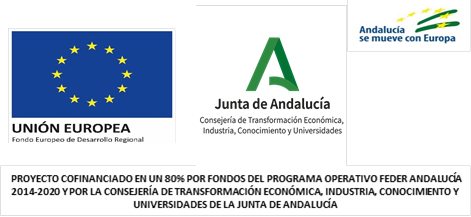
01-01-2020 / 31-12-2022
Investigador Principal
Hernán R. Míguez García
Organismo Financiador: Junta de Andalucía
Code: P18-RT-2291 "Frontera"
Equipo de Investigación: Juan Francisco Galisteo López, Mauricio E. Calvo Roggiani, Gabriel S. Lozano Barbero
The Nano-ABX LED project focuses on finding ways to solve the main challenges facing the field of perovskite-based light emission. These are the chemical and thermal instability of perovskites, as well as the difficulty of maintaining a high quantum efficiency regardless of the emission color, which makes it difficult to obtain both a varied color range and different shades of white (ie, different temperatures color).
The Nano-ABX LED project arises with the motivation to find solutions to these problems. Based on recent preliminary results of the Multifunctional Optical Materials Group, an attempt will be made to demonstrate that the integration of hybrid perovskite nanocrystals inside matrices with controlled porosity dramatically improves the environmental stability of these materials, an aspect that the group requesting this proposal has studied in depth, as well as it allows to increase the luminescent quantum efficiency at controlled emission wavelengths. In another aspect of the project, the increase in efficiency and performance (directionality, spectral control) of the devices will be explored through the integration of different photonic structures, taking as a starting point.
Multifunctional nanoparticles for luminescent, magnetic resonance and X-ray computed tomography bioimaging

1-1-2019 / 30-09-2022
Investigador Principal
Manuel Ocaña Jurado / Ana Isabel Becerro Nieto
Organismo Financiador: Ministerio de Ciencia e Innovación
Code: RTI2018-094426-B-I00 "Retos Investigación"
Equipo de Investigación: Nuria O. Nuñez Alvarez
The project pursues the preparation of multifunctional nanoparticles (NPs) with improved properties and suitable characteristics (size, colloidal stability and toxicity) that can be used to get images of cells, tissues and organs by means of more than one bioimaging technique, thus providing complementary information essential for a more reliable medical diagnosis. Specifically, we shall study
bifunctional probes for both, luminescence and magnetic resonance (MRI) or luminescence and X-ray computed tomography (CT), and trifunctional probes that are useful for the three imaging techniques.Two types of luminescent probes will be addressed. On the one hand, luminescent NPs will be designed consisting of single matrices doped with lanthanide cations (Nd3+ or Er3+lYb3+ or Tm3+lYb3+), whose excitation and emission takes place in the near-infrared (NIR) region known as the biological window (650-1800 nm), in which radiation is not harmful to tissues and has a high penetration power. On the other hand, nanoprobes whose luminescence persists after ceasing the excitation will be also developed, thus avoiding the possible undesirable effects of the excitation radiation on the tissues. In the first case, our aim is to achieve greater chemical and thermal stability of the pro bes by selecting oxifluoride-type matrices, more stable than the
fluoride-type matrices proposed so far. In the second case, the aim of the project resides in the exploration of new synthetic routes to obtain nanoparticulated ZnGa204:Cr3+ and Y3AI2Ga3012:Ce3+,Cr3+,Nd3+, with uniform size and shape, which are essential for bioapplications. Regarding MRI technique, this project aims at developing NPs made up of Dy- and Ho-based oxifluorides, vanadates and phosphates in response to the need of new contrast agents that work at high magnetic fields, which are increasingly being used in clinics to improve image resolution. Finally, due to the high atomic number of the constituent elements of the selected probes, it is expected that they show a high X-ray attenuation capacity, being therefore also useful as CT contrast agents. The advantage of the NPs proposed in this research with respect to the CT CAs currently used in clinics is the longer circulation time of the former, which will allow decreasing considerably the dosage to be given to the patient. The project contemplates both the manufacture of optimised probes and the exploration of their applicability to the field of medical diagnosis by obtaining "in vivo" images in mice. The research team has long experience in the synthesis of rare earths-based inorganic NPs and has most of the necessary equipment for their characterisation. The participation in the work plan of researchers from other institutions, with long expertise on various aspects of the project, who have successfully collaborated with the research team, gives further support to the viability of the proposal.
Verification of the existence of macroscale repulsive Casimir forces in suspend self-standing films

1-11-2018 / 30-04-2021
Investigador Principal
Hernán Ruy Míguez García
Organismo Financiador: Ministerio de Ciencia e Innovación
Code: FIS2017-91018-EXP "Explora"
The ultimate goal of the VERSUS project is the first observation of repulsive Casimir-Lifshitz forces in macroscopic plane-parallel systems. To this end, it will focus on the design, fabrication, and characterization of optical materials that allow controlling the intensity and nature of the Casimir-Lifshitz force, so that levation phenomena can be observed and characterized due to the balance between the latter and gravity force. This radically new approcah makes use of optical spectroscopic techniques (based on optical interferometry between the partially reflected and transmitted light at the interfaces of the plane-parallel system) for characterizing the equilibrium distance at which the system levitates over a substrate. According to very recent results attained by the applicant group, it is possible to find materials whose optical constants and densities are such that when they are immersed in a fluid they can levitate over a substrate as a result of the aforementioned force balance. Our group has recently demonstrated theoretically that there is a number of materials that prepared in this films (<1 micrometer) can levitate several tens or hundreds of nanometers over a carefully selected substrate. Specifically, thin layers made of teflon, polystyrene or silicon dioxide immersed in glycorel are expected to levitate over a silicon wafer, being possible to tune the equilibrium distances at which such layers will be suspended through their thicknesses and temperature of the system. The devised selft-standing thin films (in single layers or multilayer arrangements) must be compact, mechanically stable, of smooth surfaces, of controlled thickness, and chemically compatible with the fluid in which they are immersed. The macroscopic observation of repulsive Casimir-Lifshitz forces, never reported before, through optical spectroscopic measurements would constitute an unprecedented milestone in the field of fundamental matter interactions.
Advanced optical materials for more efficient optoelectronic devices

01-01-2018 / 30-09-2021
Investigador Principal
Hernán Ruy Míguez García / Mauricio E. Calvo Roggiani
Organismo Financiador: Ministerio de Ciencia e Innovación
Code: MAT2017-88584-R "Retos de la Sociedad"
Equipo de Investigación: Gabriel S. Lozano Barbero, Juan Galisteo López
The MODO project is focused on the optimization of the optical design of optoelectronic devices, be they photovoltaic or light emitting ones, with the aim of increasing their efficiency or endow them with new functionalities. The hypothesis on which it is based is that this goal can be reached by means of the integration of optical materials that allow controlling the radiation-matter interaction in the absorbing or optically active layers of the device. The strategy herein proposed is based on the sequential realization of design, preparation, characterization and integration of devices of diverse photonic structures (photonic crystals, metallic particles, disordered optical media, corrugated surfaces) employing mainly solution processing techniques fully compatible with those used to fabricate the targeted devices. Optoelectronic technology based on perovskites has attracted a great deal of interest in the last years as a result of the high solar to electric power conversion efficiency, above 20%, that have been reached in a relatively short time compared to other photovoltaic technologies. At the same tiem, they present high photoemission quantum yields in the green and the red, which make them also good candidates as color converter layers for LEDs. However, these expectations are partially threatened by both the stability problems and potentially toxic environmental effects they present. It is one of the main goals of this project to propose solutions to specific drawbacks present in the optoelectronic technology based on hybrid perovskites through the implementation of optical designs that gives rise to a reduction ot both the amount of material employed as well as the exposure to environments that typically degrade them. We seek to deepen our understanding of phenomena that give rise to the photoinduced degradation of these materials when exposed to diverse environments, which will allow us to propose specific solutions to develop more stable and efficient perovskite layers. Simultaneously, concepts based on the strict control over the local density of photon states and oriented to the directional amplification of luminescence at selcted spectral ranges will be applied to light emitting devices based on semiconductor nanocrystals as well as to photo- and electro-luminescent organic compunds. Full control over the excited state decay dynamics over large areas and observation of laser emission will also be sought after. In all cases, the energy efficiency of the targeted devices has not been optimized before from the point of view ot the optical design.
The proposal is included in the framework of the Societal Challenge called "Secure, clean and efficient energy" and aims to develop photonic technology using nanotechnology tools and in the advanced materials field, all identified as Key Enabling Technologies KETs in the Spanish Strategy on Science and Technology, aligned with the European Program H2020.
Nanophosphor-based photonic materials for next generation light-emitting devices NANOPHOM

01-04-2017 / 31-03-2023
Investigador Principal
Gabriel S. Lozano Barbero
Organismo Financiador: Unión Europea
Code: H2020-ERC-STG/0259 STARTING GRANT
Energy-efficient and environmentally friendly light sources are an essential part of the global strategy to reduce the worldwide electricity consumption. Light-emitting diodes (LEDs) emerge as a key alternative to conventional lighting, due to their high power-conversion efficiency, long lifetime, fast switching, robustness, and compact size. Nonetheless, their implementation in the consumer electronic industry is hampered by the limited control over brightness, colour quality and directionality of LED emission that conventional optical elements relying on geometrical optics provide.
This project exploits new ways of controlling the emission characteristics of nanophosphors, surpassing the limits imposed by conventional optics, through the use of nanophotonic concepts. The development of reliable and scalable nanophosphor-based photonic materials will allow ultimate spectral and angular control over the light emission properties, addressing the critical shortcomings of current LEDs. The new optical design of these devices will be based on multilayers, surface textures and nano-scatterers of controlled composition, size and shape, to attain large-area materials possessing photonic properties that will enable a precise management of the visible radiation.
Nanophom will significantly advance our comprehension of fundamental phenomena like the formation of photonic modes in complex optical media to which light can couple, as well as advancing the state of the art of high-efficiency solid-state lighting devices.
PhoLED – Photonic Nanostructures for Light-Emitting Devices

1-09-2015 / 31-08-2017
Investigador Principal
Hernán Míguez García
Organismo Financiador: Unión Europea
Code: EU144490_01 Marie Curie Actions
Equipo de Investigación: Dongling Geng
This project has received funding from the European Union’s H2020 Programme for research, technological development and demonstration under grant agreement no 657434.
The PhoLED project seeks to largely surpass the optical performance of state-of-the-art light emitters devised for illumination applications and contribute to solve some of the main technical limitations that the current technology presents. This project aims at integrating novel optical nanostructures and emitters, such as colloidal quantum dots or nanophosphors, to yield the next generation of light-emitting devices in which full spectral and angular control over the emission properties will be possible. The approach focuses on the development of: i) new synthetic routes to achieve efficient nanophosphors, and ii) preparation and processing strategies, based on surface textures and colloidal scatterers, to attain large area optical nanostructures possessing photonic properties that will allow a precise control on the intensity, angular distribution and color quality of light emission. Results achieved within this project will provide significant advance both in the comprehension of fundamental phenomena as well as in the development of versatile solid-state lighting devices of optimized efficiency, aiming to overcome technical barriers and maximize performance. The project’s outcome is twofold: a substantial expansion of the preparation of optical nanostructures to control light-mater interaction, and the practical realization of nanostructured lightemitting devices with unprecedented properties.
Advanced optical materials for efficient optoelectronic devices

1-01-2015 / 31-12-2017
Investigador Principal
Hernán Míguez García / Manuel Ocaña Jurado
Organismo Financiador: Ministerio de Economía y Competitividad
Code: MAT2014-54852-R
Equipo de Investigación: Ana Isabel Becerro Nieto, Nuria Núñez Alvarez, Mauricio E. Calvo Roggiani, Gabriel Lozano Barbero, Juan Francisco Galisteo López, Miguel Anaya Martin
The MODO project will focus on the development of optical materials to optimize the performance of optoelectronic devices such as solar cells or light emitting devices, thereby improving their energy conversion efficiency. The main objective of this proposal is to increase their performance by controlling light absorption and emission processes occurring in the materials composing these devices. This will be achieved through the design and integration of photonic nanostructures whose properties are also compatible with the manufacture and operation requirements of these systems, such as thermal, chemical and mechanical stability, durability, ease of processing and scale-up.
Integration of Photonic Nanostructures in Flexible Dye Solar Cells

1-07-2014 / 30-06-2016
Investigador Principal
Hernán Míguez García
Organismo Financiador: Unión Europea
Code: FP7-PEOPLE-2013-IIF Marie Curie Actions
Equipo de Investigación: Yuelong Li
It is the main goal of this project to bring to the host institution and the European Research Area the knowledge and technology to prepare current record flexible dye sensitized photovoltaic devices, previously developed by the candidate in South Korea and then the USA, in order to be able to further improve them, while endowing them with semi-transparency, using stretchable and bendable optical materials. The candidate has demonstrated that several key materials and processes provide better
performance of bendable dye solar cells, i.e., enhanced efficiency and flexibility, by allowing the preparation of electrodes in which the electron diffusion length is longer and charge collection efficiency is consequently enhanced. However, highly efficient dye solar cells are opaque as a consequence of the particular diffuse scattering design employed to improve light absorption, which limits their application in building or automotive integrated photovoltaics. This proposal seeks to solve such drawback by
introducing photonic nanostructures in different configurations, yielding both light harvesting enhancement and preserving transparency, hence placing Europe at the forefront of research in this specific area within the field of renewable energy. This final goal will be attempted through different approaches, each one challenging from the materials science perspective. Preparation of such highly efficient and transparent devices will combine the flexible solar cell processing tools previously developed by the candidate with the versatile optical material preparation techniques pioneered by the host institution. More specifically, integration of novel porous flexible photonic structures into the light harvesting layer, use of flexible mirrors attached to the back of the counter-electrode, and designed distribution of scatterers will be employed to
reach the target.
Highly optimized unit for a sustainable enhanced solar system HOUSESS

03-02-2014 / 31-12-2017
Investigador Principal
Hernán Míguez García
Organismo Financiador: Ministerio de Economía y Competitividad
Code: RTC-2014-2333-3 (Programa Retos)
Equipo de Investigación: Juan Francisco Galisteo López, José María Miranda Muñoz
The aim of the project is the design, development, prototyping and validation of a hybrid photovoltaic-thermosolar system that allows the storage and manageability of the generated solar energy. This integrated system will generate electricity at lower costs than standard thermosolar technology.
The hybrid system consists of a parabolic cylinder system and a low concentration photovoltaic solar receiver. Between these two components a dichroic filter is placed, which receives the reflected light from the parabolic cylinder primary mirror and allows the selective separation of the solar spectrum, letting pass a portion of the light to the photovoltaic receiver and reflecting the rest to the thermal tube receiver. Said dichroic filter sends to the photovoltaic receiver photons with wavelengths which are more efficiently absorbed by the solar cell. The thermal part of the system also shows the ability to controllably deliver power, allowing energy storage for its use in the most suitable moment of the day.
Control of the Optical Emission and Absorption properties of Nanomaterials Integrated in Multifunctional Porous Photonic Structures

01-01-2012 / 31-12-2014
Investigador Principal
Hernán R. Míguez García
Organismo Financiador: Ministerio de Ciencia e Innovación
Code: MAT2011-23593
Equipo de Investigación: Nuria Nuñez Alvarez, Mauricio Calvo Roggiani, Carmen López López, Sonia Rodríguez Liviano, Manuel Ocaña Jurado, Silvia Colodrero Pérez, José Raúl Castro Smirnov
In this project the modifications of both optical emission and absorption of nano-materials of different sort (rare earth doped nanoparticles, semiconductor quantum dots, metallic nanoparticles, and films of organic dyes of nanometer dimensions) that occur when they are embedded in different types of photonic structures will be investigated. Both fundamental and applied aspects of the subject will be analysed. Efforts will be mainly focused on materials of current technological interest for solar cells, sensors and light emitting devices. From the applied point of view, this project finds its motivation in the possibility that photonic structures offer of modifying absorption and emission processes in a controlled manner so that they can be inhibited or amplified depending on the specific goal pursued. Particularly, we seek to put into practice these concepts to generate new designs of more efficient solar cells, capable of harvesting a larger amount of the incident radiation, and in the development of films for sensing devices responsive to modifications of different kind, such as presence of targeted molecules, variations of ambient gas pressure, etc... Also, more efficient or controlled light extraction from light emitting devices is sought after. The development of small prototype devices to prove the novel concepts under research is also an objective of this grant proposal.
In its more fundamental aspect, our project aims at deepening our knowledge of the interaction between light and matter in systems in which there exists a strong dispersion and anisotropy of the dielectric constant, and in which it is possible to attain very low photon propagation speeds. For this analysis, we will employ different types of porous photonic structures, such as one-dimensional and three-dimensional photonic crystals, as well as disordered assemblies of particles, as hosts in which a wide range of organic and inorganic nanomaterials will be integrated in different configurations and whose absorption and emission will be experimentally and theoretically studied.
Although this project has a fundamental character due to the nature of the prepara-tion techniques and complex optical properties we seek to analyze, it is our aim to continue generating and transferring intellectual property based on the novel concepts, properties and designs which are the subject of our research.
Polymer-Inorganic Flexible Nanostructured Films for the Control of Light (POLIGHT)

01-01-2012 / 30-11-2017
Investigador Principal
Hernán R. Míguez García
Organismo Financiador: Unión Europea
Code: (FP7/2007-2013)/ERC Grant Agreement No. 307081 (POLIGHT)
The POLIGHT project will focus on the integration of a series of inorganic nanostruc-tured materials possessing photonic or combined photonic and plasmonic properties into polymeric films, providing a significant advance with respect to current state of the art in flexible photonics. These highly adaptable films could act either as passive UV-Vis-NIR selective frequency mirrors or filters, or as matrices for light absorbing or optically active species capable of tailoring their optical response. The goal of this project is two-fold. In one aspect, the aim is to fill a currently existing hole in the field of materials for radiation protection, which is the absence of highly flexible and adaptable films in which selected ranges of the electromagnetic spectrum wavelengths can be sharply blocked or allowed to pass depending on the different foreseen applications. In another, the POLIGHT project seeks to go one step beyond in the integration of absorbing and emitting nanomaterials into simple flexible polymeric matrices by including hierarchically structured photonic lattices that provide fine tuning of the optical properties of these hybrid ensembles. This will be achieved by means of enhanced matter-radiation interactions that result from field localization effects at specific resonant modes. The opportunity arises as a result of the recent development of a series of robust inorganic photonic structures that present interconnected porous networks susceptible of hosting polymers and thus inheriting their mechanical properties.
Flexible hybrid nanostructures for applications as ultraviolet, visible and near infrared filters

03-02-2010 / 03-02-2013
Investigador Principal
Hernán Míguez García
Organismo Financiador: Junta de Andalucía
Code: FQM6090
Equipo de Investigación: Mauricio Calvo Roggiani, Agustín Mihi Cervelló, Silvia Colodrero Pérez, Nuria Hidalgo Serrano, Gabriel Lozano Barbero, Olalla Sánchez Sobrado
This project aims at developing radiation filters and screens in the shape of films and capable of blocking or selecting ultraviolet (UV), visible (Vis) or near infrared (NIR) radiation within well-defined spectral ranges. Biocompatibility, flexibility and specific adhesive proper-ties will be sought after in order to make these films usable to protect all types of ill, wounded or burnt skin. The aim is to fill a currently existing hole in the field of skin phototherapy based on the healing properties of UV-Vis-NIR light, which is the absence of biocompatible patches in which selected ranges of the electromagnetic spectrum wavelengths can be sharply blocked or allowed to pass depending on the needs of the patient. For clinical cases that so required, an integral approach to skin photo-healing will be taken, devising materials that allow therapeutic wavelengths to reach the skin while blocking harmful ones and providing the controlled topical release of substances that have a beneficial effect on the skin. This project is based on a new series of novel prototype materials that have recently been developed in the group headed by the applicant in the Institute of Materials Science of Seville.
Applications of photonic crystals in solar cells: power conversion efficiency enhancement though optical absorption amplification

14-01-2009 / 13-01- 2012
Investigador Principal
Hernán R. Míguez García
Organismo Financiador: Junta de Andalucía
Code: P08-FQM-03579 (Proyecto de Excelencia)
Equipo de Investigación: Manuel Ocaña Jurado, Mauricio Calvo Roggiani, Nuria Nuñez, Agustín Mihi, Gabriel Lozano, Silvia Colodrero, Nuria Hidalgo, Olalla Sánchez Sobrado
Porous photonic crystals introduced in heterojunction solar cells allow to enhance sig-nificantly their photovoltaic performance by increasing the light harvested by the device. This concept, pioneered by the multifunctional optical materials group, have lead to highly efficient and transparent dye solar cells that preserve their potential application as window modules, one of their main added values. The concepts proposed in this project are not only interesting from a fundamental point of view in photonics and energy conversion, but also of clear relevance for building integrated photovoltaics.
Control of Optical Emission and Absorption Properties of Nanomaterials in Photonic Crystals

01-01-2009 / 31-12-2011
Investigador Principal
Hernán R. Míguez García
Organismo Financiador: Ministerio de Ciencia e Innovación
Code: MAT2008-02166
Equipo de Investigación: Manuel Ocaña Jurado, Mauricio Calvo Roggiani, Nuria Nuñez, Agustín Mihi, Gabriel Lozano, Silvia Colodrero, Nuria Hidalgo, Olalla Sánchez
In this project the modifications of both optical emission and absorption of nano-materiales of different sort (rare earth doped nanoparticles, semiconductor quantum dots, and films of organic dyes of nanometer dimensions) that occur when they are embedded in a photonic crystal structure. Both fundamental and applied aspects of the subject will be ana-lysed, efforts being focused on materials of current technological interest. From the applied point of view, this project finds its motivation in the possibility that photonic crystal offer of modifying those absorption and emission processes in a controlled manner so that they can be inhibited or amplified depending on the specific goal pursued. Particularly, we seek to put into practice these concepts to generate new designs of more efficient solar cells, capable of harvesting a larger amount of the incident radiation, and in the development of films for sensing devices sensitive to modifcations of different kind, such as presence of targeted molecules, variations of ambient gas pressure, etc... In its more fundamental aspect, our project aims at deepening our knowledge of the interaction between light and matter in systems in which there exists a strong dispersion and anisotropy of the dielectric constant, and in which it is possible to attain very low photon propagation speeds. For this analysis, we will employ photonic crystals with three dimensional order as hosts in which a wide range of organic and inorganic nanomaterials will be integrated in different configurations and whose absorption and emission will be experimentally and theoretically studied.
Crust to core: The fate of subducted material

01-7-2006 / 31-01-2011
Investigador Principal
Ana Isabel Becerro Nieto
Organismo Financiador: Unión Europea
Code: MRTN-CT-2006-035957
Equipo de Investigación: Universidad de Bayreuth (Alemania), Universidad de Milán (Italia), University College London (Reino Unido), Geological Survey of Norway (Noruega), Universidad Pierre et Marie Curie, París (Francia), Friedrich Schiller Universitat Jena (Alemania), UniverzitaKarlova V Praga (República Checa)
At convergent plate boundaries material is transported from the Earth's surface to its interior; this is one of the central processes in the solid Earth, determining its dynamic, chemical, and thermal evolution. It is linked to a wide range of surface features, ranging from plate tectonics to earthquakes and volcanoes to the chemical evolution of the Earth's atmosphere.Despite this importance many aspects of the subduction process and associated material fluxes are poorly understood to date, and advances in understanding require the integrated efforts of many sub-disciplines in the Earth sciences as well as integration of neighbouring fields. To overcome the fragmentation and advance the basic understanding of the subduction process we form a European network which combines unique facilities and expertise in petrology, experimental and computational mineralogy, analysis, synthesis, and dynamic studies of the Earth's interior.
2025
2025
Materiales Semiconductores para la Sostenibilidad
Impact of metal oxidation on ice growth and melting
Carretero-Palacios, S; Esteso, V; Li, Y; Kuthe, S; Brevik, I; Iordanidou, K; Malyi, OI; Glaser, B; Persson, C; Bostrom, MPhysical Review B, 111 (2025) 085407. DOI: 10.1103/PhysRevB.111.085407
Abstract
In this paper, we investigate the Casimir-Lifshitz free energy mechanism that governs both ice growth and melting near metal surfaces, with a particular focus on the role of oxidation. Our study reveals that metals such as gold, iron, and aluminum induce incomplete premelting, resulting in micron-sized liquid water layers when in contact with ice. These layers could have significant implications for the defrosting of metallic surfaces. When exposed to water vapor at the triple point, aluminum and other metals can induce the formation of notably thick layers of either liquid water or ice, which can theoretically become infinitely thick if other interactions are disregarded. However, when aluminum undergoes oxidation to form alumina, its behavior changes dramatically. Alumina surfaces cause complete melting when in direct contact with bulk ice and result in only micron-sized layers of water or ice in vapor conditions. In contrast, magnetite, the oxidized form of iron, retains metalliclike behavior due to its high dielectric constant, similar to other metals, and continues to support thick layers of water or ice. This distinction highlights the significant influence of oxidation on the dynamics of ice growth and melting near different metal surfaces.
February, 2025 · DOI: 10.1103/PhysRevB.111.085407
Materiales Ópticos Multifuncionales
Photoinduced Spin Centers in Photocatalytic Metal-Organic Framework UiO-66
Kultaeva, A; Biktagirov, T; Sperlich, A; Dorflinger, P; Calvo, ME; Otal, E; Dyakonov, VAdvanced Functional Materials, 35 (2025) 3 DOI: 10.1002/adfm.202413297
Abstract
Metal-Organic frameworks (MOFs) are promising candidates for advanced photocatalytically active materials. These porous crystalline compounds have large active surface areas and structural tunability and are thus highly competitive with oxides, the well-established material class for photocatalysis. However, due to their complex organic and coordination chemistry composition, photophysical mechanisms involved in the photocatalytic processes in MOFs are still not well understood. Employing electron paramagnetic resonance (EPR) spectroscopy and time-resolved photoluminescence spectroscopy (trPL), the fundamental processes of electron and hole generation are investigated, as well as capture events that lead to the formation of various radical species in UiO-66, an archetypical MOF photocatalyst. A manifold of photoinduced electron spin centers is detected, which is subsequently analyzed and identified with the help of density-functional theory (DFT) calculations. Under UV illumination, the symmetry, g-tensors, and lifetimes of three distinct contributions are revealed: a surface O2-radical, a light-induced electron-hole pair, and a triplet exciton. Notably, the latter is found to emit (delayed) fluorescence. The findings provide new insights into the photoinduced charge transfer processes, which are the basis of photocatalytic activity in UiO-66. This sets the stage for further studies on photogenerated spin centers in this and similar MOF materials.
January, 2025 · DOI: 10.1002/adfm.202413297
Materiales Semiconductores para la Sostenibilidad
The impact of interfacial quality and nanoscale performance disorder on the stability of alloyed perovskite solar cells
Frohna, K; Chosy, C; Al-Ashouri, A ; Scheler, F; Chiang, YH; Dubajic, M; Parker, JE; Walker, JM; Zimmermann, L; Selby, TA; Lu, Y; Roose, B; Albrecht, S; Anaya, M; Stranks, SDNature Energy, 10 (2025) 66-76 DOI: 10.1038/s41560-024-01660-1
Abstract
Microscopy provides a proxy for assessing the operation of perovskite solar cells, yet most works in the literature have focused on bare perovskite thin films, missing charge transport and recombination losses present in full devices. Here we demonstrate a multimodal operando microscopy toolkit to measure and spatially correlate nanoscale charge transport losses, recombination losses and chemical composition. By applying this toolkit to the same scan areas of state-of-the-art, alloyed perovskite cells before and after extended operation, we show that devices with the highest macroscopic performance have the lowest initial performance spatial heterogeneity—a crucial link that is missed in conventional microscopy. We show that engineering stable interfaces is critical to achieving robust devices. Once the interfaces are stabilized, we show that compositional engineering to homogenize charge extraction and to minimize variations in local power conversion efficiency is critical to improve performance and stability. We find that in our device space, perovskites can tolerate spatial disorder in chemistry, but not charge extraction.
January, 2025 · DOI: 10.1038/s41560-024-01660-1
2024
2024
Materiales Coloidales
Topotactic Reduction-Induced Stabilization of β-La2Mo2O8.68 Phase: Structure, Static Oxygen Disorder, and Electrical Properties
Zhang, XT; Genevois, C; Li, C; Yang, XY; Pitcher, MJ; Allix, M; Kuang, XJ; Fernández-Carrión, AJInorganic Chemistry, 63 (2024) 22667-22676 DOI: 10.1021/acs.inorgchem.4c02151
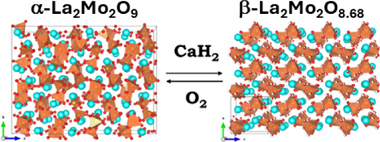
Abstract
La2Mo2O9 is acknowledged as an exceptional oxide ion conductor. It undergoes a reversible phase transition around 580 degrees C from the nonconductive low-temperature monoclinic alpha-La2Mo2O9 phase to the highly conductive high-temperature cubic beta-La2Mo2O9 phase. In addition, La2Mo2O9 demonstrates complex chemistry under reducing conditions. This study reports, for the first time, the stabilization at ambient temperature of a novel cubic phase through a topotactic reduction of alpha-La2Mo2O9 employing CaH2. This phase contains approximately similar to 3 atom % oxygen vacancies relative to the nominal composition (La2Mo2O8.68(1)). The cubic symmetry is associated with a static distribution of these vacancies, in contrast to the dynamic distribution observed in the high-temperature cubic beta-La2Mo2O9 phase reported previously. Additionally, the material exhibits mixed-ion-electronic conduction, which expands its potential use in applications requiring both ionic and electronic transport.
December, 2024 · DOI: 10.1021/acs.inorgchem.4c02151
Materiales Semiconductores para la Sostenibilidad
Better together: Monolithic halide perovskite@metal-organic framework composites
Avila, E; Salway, H; Ruggen, E; Çamur, C; Rampal, N; Doherty, TAS; Moseley, ODI; Sstranks, SD; Faren-Jimenez, D; Anaya, MMatter 7 (2024) 4319-4331 DOI: 10.1016/j.matt.2024.08.022

Abstract
The instability and limited scalability of halide perovskites hinder their long-term viability in applications as X-ray detectors. Here, we introduce a sol-gel ship-in-bottle approach to produce a monolithic perovskite@metal-organic framework (MOF) composite, combining the properties of the individual building blocks and enhancing density, robustness, and stability. By tuning seed particles below 100 nm, we achieve highly crystalline, dense composites with up to 40% perovskite loading. Structural and optical characterization unveils perovskite nanocrystals forming within MOF mesopores, maximizing stability and preventing degradation, maintaining over 90% photoluminescence and structural integrity after weeks of exposure to humidity, heat, and solvents. Proposed as an innovative class of scintillator, these monolithic perovskite@MOFs attenuate X-rays efficiently and exhibit outstanding stability under high radiation doses equivalent to 110,000 typical chest X-rays, with a radioluminescence lifetime of 10 ns, outperforming commercial scintillators. This approach offers vast potential for developing high-performance, cost-effective, and stable devices for radiation detection and other optoelectronic applications.
December, 2024 · DOI: 10.1016/j.matt.2024.08.022
Materiales Coloidales
Decontamination and Circular Economy of Dredged Material and Mining Waters Using Adiabatic Sonic Evaporation and Crystallization (ASEC) Technology
Delvalls, TA; Blasco, J; Vera, S; Nuñez, NO; Bonnail, EApplied Sciences-Basel, 14 (2024) 11593 DOI: 10.3390/app142411593
Abstract
Dredged material is a common environmental and economic issue worldwide. Tons of highly contaminated material, derived from cleaning the bottoms of bays and harbours, are stored until depuration. These volumes occupy huge extensions and require costly treatments. The Ria of Huelva (southwest Spain) receives additionally high metal contamination inputs from the Odiel and Tinto Rivers which are strongly affected by acid mine drainage (acid lixiviates with high metal content and sulphates). These two circumstances convert the port of Huelva into an acceptor/accumulator of contamination. The current study proposes an alternative active treatment of dredged material and mining residues using ASEC (Adiabatic Sonic Evaporation and Crystallization) technology to obtain distilled water and valuable solid conglomerates. Different samples were depurated and the efficiency of the technology was tested. The results show a complete recovery of the treated volumes with high-quality water (pH similar to 7, EC < 56 mu S/cm, complete removal of dissolved elements). Also, the characterization of the dried solids enable the calculation of approximate revenues from the valorization of some potentially exploitable elements (Rio Tinto: 4 M, Tharsis: 3.7 M, dredged material: 2.5 M USD/yr). The avoidance of residue discharge plus the aggregated value would promote a circular economy in sectors such as mining and dredging activities.
December, 2024 · DOI: 10.3390/app142411593
Materiales Coloidales
Zn2-xGeO4-GeO2:(x)Mn2+ films with long persistence, intense brightness and high quantum efficiency, deposited by ultrasonic spray pyrolysis
Calderón-Olvera, RM; Mendoza-Pérez, R; Arroyo, E; García-Hipólito, M; Falcony, C; Alvarez-Zauco, EOptical Materials, 157 (2024) 116132 DOI: 10.1016/j.optmat.2024.116132
Abstract
This work shows the synthesis and characterization of the Zn2-xGeO4-GeO2:(x)Mn2+ (x = 0.10, 0.25, and 0.50 at.%) films using the Ultrasonic Spray Pyrolysis (USP) technique. These films were deposited at 500 degrees C and heat treated at 800 degrees C for 13 h. X-ray diffraction (XRD) measurements showed the rhombohedral and hexagonal phases of Zn2-xGeO4 (78.8 %) and GeO2 (21.2 %), respectively. SEM micrographs exhibited the surface morphology of these films. The STEM and HAADF show Ge, Zn, and O atomic layers. In addition, XPS was carried out to observe the oxidation states of Mn2+ (75.4 %) and Mn3+ (24.6 %) for the films doped with Mn ions (0.10 at.%). Incorporating manganese ions into the Zn2-xGeO4-GeO2 host lattice generated an extremely green emission, exciting at 250 nm. The photoluminescence and persistence luminescence properties were studied in accordance with the manganese doping concentration. For photoluminescence, it was found that the optimal doping percentage was 0.25 at.%, and for persistence luminescence, it was 0.10 at.% Mn with lambda(ex) = 250 nm. Quantum efficiency measurements gave a result of 100 %. In addition, preliminary CL measurements were exhibited.
November, 2024 · DOI: 10.1016/j.optmat.2024.116132
Materiales Ópticos Multifuncionales
Intense and Stable Blue Light Emission From CsPbBr3/Cs4PbBr6 Heterostructures Embedded in Transparent Nanoporous Films
Romero-Pérez, C; Delgado, NF; Collado, MH; Calvo, ME; Mïguez, HAdvanced Optical Materials, 12 (2024) 2400763 DOI: 10.1002/adom.202400763
Abstract
Lead halide perovskite nanocrystals are attractive for light emitting devices both as electroluminescent and color-converting materials since they combine intense and narrow emissions with good charge injection and transport properties. However, while most perovskite nanocrystals shine at green and red wavelengths, the observation of intense and stable blue emission still remains a challenging target. In this work, a method is reported to attain intense and enduring blue emission (470–480 nm), with a photoluminescence quantum yield (PLQY) of 40%, originating from very small CsPbBr3 nanocrystals (diameter < 3 nm) formed by controllably exposing Cs4PbBr6 to humidity. This process is mediated by the void network of a mesoporous transparent scaffold in which the zero-dimensional Cs4PbBr6 lattice is embedded, which allows the fine control over water adsorption and condensation that determines the optimization of the synthetic procedure and, eventually, the nanocrystal size. The approach provides a means to attain highly efficient transparent and stable blue light-emitting films that complete the palette offered by perovskite nanocrystals for lighting and display
November, 2024 · DOI: 10.1002/adom.202400763
Materiales Ópticos Multifuncionales
Interplay between connectivity and passivating agents in perovskite quantum dot networks
Moran-Pedroso, M; Tiede, DO; Romero-Perez, C; Calvo, ME; Galisteo-Lopez, JF; Miguez, HJournal of Materials Chemistry C (2024). DOI: 10.1039/d4tc02362e
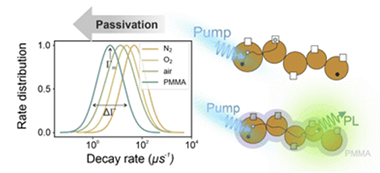
Abstract
Introducing quantum dots (QDs) as the active element of an optoelectronic device demands its incorporation in the shape of interconnected arrays that allow for some degree of electronic coupling in order to inject/extract charge carriers. In doing so, beyond reducing the degree of quantum confinement, carriers are exposed to an enhanced defect landscape as they can access adjacent QDs, which is at the origin of the strong reduction of photoluminescence observed in QD solids when compared to that of the isolated QDs. In this work we demonstrate how a proper defect passivating strategy or atmospheric treatment can greatly enhance charge diffusion in a QD film, needed for an optimal carrier injection/extraction demanded for optoelectronic applications, and also improved its stability against external radiation. From a fundamental perspective, we provide evidence showing that trap density distribution, rather than QD size distribution, is mostly responsible for the observed variations in emission decay rates present in the QD networks under analysis.
Different treatments (comprising polymeric encasement and different atmospheres) are applied to quantum dot solids in order to modify their defect landscape. The role of the latter in both, carrier recombination and stability, is unveiled.
October, 2024 · DOI: 10.1039/d4tc02362e
Materiales Coloidales
Lanthanide vanadate-based nanoparticles as multimodal T1 -T2 MRI contrast agent and NIR luminescent imaging probe
Gómez-González, E; Núñez, NO; Caro, C; García-Martín, ML; Becerro, AI; Ocaña, MJournal of Alloys and Compounds, 1003 (2024) 175647 DOI: 10.1016/j.jallcom.2024.175647

Abstract
We report the development of a multimodal lanthanide vanadate system suitable as dual T1-T2 MRI contrast agent as well as a luminescent imaging probe in the near-infrared region, using Dy3+ and Gd3+ as T2 and T1 components, respectively, and Nd3+ as the luminescent center. The vanadate matrix was chosen to avoid the undesired solubility associated to previously reported fluoride-based contrast agents. With such aim, we first optimized the design of the MRI system by comparatively evaluating the magnetic relaxivities of two different architectures consisting of i) uniform NPs incorporating both paramagnetic cations in solid solution (single-phase NPs), and ii) core-shell NPs consisting of a DyVO4 core coated with a homogeneous GdVO4 shell (DyVO4@GdVO4). We found that, although both samples presented magnetic relaxivity properties that make them adequate for their use as dual T1-T2 contrast agents for magnetic resonance imaging, the core-shell architecture would be more suitable because of their higher magnetic relaxivity values. Secondly, to prepare the multimodal system, the GdVO4 layer of such optimal dual T1-T2 MRI probe was doped with Nd3+ cations. An inert YVO4 intermediate shell was also introduced between the cores and the outer layer aiming to avoid energy transfer from Nd3+ to Dy3+, which would cause luminescence quenching. These core-shell-shell nanoparticles showed magnetic relaxivity values similar to those of the core-shell system and an intense luminescence in the near-infrared region. Moreover, they were dispersible and chemically stable under conditions that mimic the physiological media, and they were nontoxic for cells. Therefore, such multimodal nanoparticles meet the main requirements for their use as a dual T1-T2 contrast agent for magnetic resonance imaging and as a probe for luminescent imaging in the near-infrared region.
October, 2024 · DOI: 10.1016/j.jallcom.2024.175647
Materiales Ópticos Multifuncionales
Strong Grain Boundary Passivation Effect of Coevaporated Dopants Enhances the Photoemission of Lead Halide Perovskites
Justin, IAK; Tiede, DO; Piot, M; Forzatti, M; Roldán-Carmona, C; Galisteo-López, FJ; Míguez, H; Bolink, HJACS Applied Materials & Interfaces, 16 (2024) 61305-61313 DOI: 10.1021/acsami.4c13434

Abstract
Herein, we demonstrate that coevaporated dopants provide a means to passivate buried interfacial defects occurring at perovskite grain boundaries in evaporated perovskite thin films, thus giving rise to an enhanced photoluminescence. By means of an extensive photophysical characterization, we provide experimental evidence that indicate that the codopant acts mainly at the grain boundaries. They passivate interfacial traps and prevent the formation of photoinduced deep traps. On the other hand, the presence of an excessive amount of organic dopant can lead to a barrier for carrier diffusion. Hence, the passivation process demands a proper balance between the two effects. Our analysis on the role of the dopant, performed under different excitation regimes, permits evaluation of the performance of the material under conditions more adapted to photovoltaic or light emitting applications. In this context, the approach taken herein provides a screening method to evaluate the suitability of a passivating strategy prior to its incorporation into a device.
October, 2024 · DOI: 10.1021/acsami.4c13434
Materiales Coloidales
Sodium lanthanide tungstate-based nanoparticles as bimodal contrast agents for in vivo high-field MRI and CT imaging
Gómez-González, E; Caro, C; Núñez, NO; González-Mancebo, D; Urbano-Gámez, JD; García-Martín, ML; Ocaña, MJournal of Materials Chemistry B (2024). DOI: 10.1039/d4tb01157k
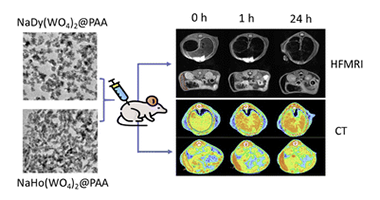
Abstract
Research on high-field magnetic resonance imaging (HF-MRI) has been increased in recent years, aiming to improve diagnosis accuracy by increasing the signal-to-noise ratio and hence image quality. Conventional contrast agents (CAs) have important limitations for HF-MRI, with the consequent need for the development of new CAs. Among them, the most promising alternatives are those based on Dy3+ or Ho3+ compounds. Notably, the high atomic number of lanthanide cations would bestow a high capability for X-ray attenuation to such Dy or Ho-based compounds, which would also allow them to be employed as CAs for X-ray computed tomography (CT). In this work, we have prepared uniform NaDy(WO4)(2) and NaHo(WO4)(2) nanoparticles (NPs), which were dispersible under conditions that mimic the physiological media and were nontoxic for cells, meeting the main requirements for their use in vivo. Both NPs exhibited satisfactory magnetic relaxivities at 9.4 T, thus making them a promising alternative to clinical CAs for HF-MRI. Furthermore, after their intravenous administration in tumor-bearing mice, both NPs exhibited significant accumulation inside the tumor at 24 h, attributable to passive targeting by the enhanced permeability and retention (EPR) effect. Therefore, our NPs are suitable for the detection of tumors through HF-MRI. Finally, NaDy(WO4)(2) NPs showed a superior X-ray attenuation capability than iohexol (commercial CT CA), which, along with their high r(2) value, makes them suitable as the dual-probe for both HF-MRI and CT imaging, as demonstrated by in vivo experiments conducted using healthy mice.
September, 2024 · DOI: 10.1039/d4tb01157k
Materiales Ópticos Multifuncionales
Role of Inter-Particle Connectivity in the Photo-Carrier Cooling Dynamics in Perovskite Quantum Dot Solids
Tiede, DO; Koch, KA; Romero-Pérez, C; Ucer, KB; Calvo, ME; Galisteo-López, JF; Míguez, H; Kandada, ARSAdvanced Optical Materials, (2024) 2401483 DOI: 10.1002/adom.202401483
Abstract
Intraband carrier relaxation in quantum dots (QDs) has been a subject of extensive spectroscopic investigation for several decades, and have been used to optimize the efficiency of opto-electronic processes. In the past few years, metal halide perovskites-based QDs have been shown to exhibit slow hot-carrier cooling characteristics that are desirable for photo-energy harvesting technologies. While several mechanisms are proposed to rationalize the retardation of the cooling dynamics, including hot-phonon bottleneck and polaronic effects, the role of inter-particle connectivity in these dynamics is largely ignored. Here, an in-depth study of photo-excitation dynamics and carrier cooling on perovskite QD solids with varying degrees of inter-dot coupling is presented. It is observed that inter-particle connectivity has deterministic effects on the many-body interactions that are relevant for carrier cooling. These include carrier-carrier interactions that result in Auger-reheating of the carriers, and lattice characteristics that subsequently affect the phonon-assisted cooling dynamics. This spectroscopic study of ultrafast carrier dynamics in perovskite QD solids establishes inter-dot separation as a critical material design parameter for the optimization of photo-generated carrier temperature, which fundamentally determines the luminescence characteristics and thus the opto-electronic quality of the material.
The photo-excitation dynamics and carrier cooling in metal halide perovskite quantum dot solids are investigated here. Evidence for the deterministic role of inter-particle connectivity on the many-body interactions relevant to carrier cooling is discussed. These include carrier-carrier interactions that result in Auger-reheating of the carriers, and lattice coupling that subsequently affects the phonon-assisted cooling dynamics. image
September, 2024 · DOI: 10.1002/adom.202401483
Materiales Ópticos Multifuncionales
Trap Depth Distribution Determines Afterglow Kinetics: A Local Model Applied to ZnGa2O4:Cr3+
Romero, M; Castaing, V; Lozano, G; Míguez, HJournal of Physical Chemistry Letters, (2024). DOI: 10.1021/acs.jpclett.4c01296

Abstract
Persistent luminescence materials have applications in diverse fields such as smart signaling, anticounterfeiting, and in vivo imaging. However, the lack of a thorough understanding of the precise mechanisms that govern persistent luminescence makes it difficult to develop ways to optimize it. Here we present an accurate model to describe the various processes that determine persistent luminescence in ZnGa2O4:Cr3+, a workhorse material in the field. A set of rate equations has been solved, and a global fit to both charge/discharge and thermoluminescence measurements has been performed. Our results establish a direct link between trap depth distribution and afterglow kinetics and shed light on the main challenges associated with persistent luminescence in ZnGa2O4:Cr3+ nanoparticles, identifying low trapping probability and optical detrapping as the main factors limiting the performance of ZnGa2O4:Cr3+, with a large margin for improvement. Our results highlight the importance of accurate modeling for the design of future afterglow materials and devices.
August, 2024 · DOI: 10.1021/acs.jpclett.4c01296
Materiales Coloidales
Realization of Extreme Nonstoichiometry in Gadolinium Aluminate Garnets by Glass Crystallization Synthesis
Fang, X; Castaing, V; Becerro, AI; Cao, WW; Veron, E; Zanghi, D; Dyer, MS; Genevois, C; Allix, M; Pitcher, MJChemistry of Materials, 36 (2024) 8555-8563 DOI: 10.1021/acs.chemmater.4c02266
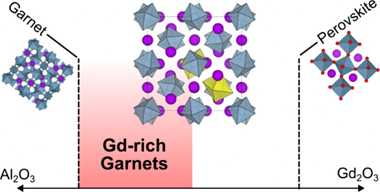
Abstract
The garnet aluminates RE3Al5O12 (RE = Gd - Lu, Y) are an important class of optical materials with a range of applications. Typically, they do not tolerate large deviations from ideal stoichiometry, and their luminescence properties are controlled by dopant selection rather than modification of the host structure. Here, we use glass crystallization as a nonequilibrium synthesis route to a new family of highly nonstoichiometric gadolinium aluminate garnets, of formula Gd3+xAl5-xO12 with x <= 0.60. Remarkably, this range is much broader than the previously reported Y3+xAl5-xO12 series (x <= 0.4), despite the vast size contrast between Al3+ and Gd3+, which are forced to share a crystallographic site in the nonstoichiometric materials: the endmember Gd3.6Al4.4O12 lies halfway between ideal garnet and perovskite stoichiometries, with 30% of its octahedral Al3+ sites substituted by Gd3+. In principle, this crystal chemistry should allow the synthesis of phosphor systems with rare-earth activators distributed over two different cation sublattices. To probe the response of luminescence properties to extreme nonstoichiometry in Gd3+xAl5-xO12, we synthesized three model phosphor systems by doping with Ce3+, Tb3+, or Tm3+/Yb3+ and found that upconversion (Tm3+/Yb3+) phosphors have the most potential to be tuned by this approach. These results demonstrate that highly nonstoichiometric garnet aluminates are not limited to small rare-earth hosts such as YAG, opening new opportunities for development of different garnet-based optical and magnetic materials.
August, 2024 · DOI: 10.1021/acs.chemmater.4c02266
Materiales Ópticos Multifuncionales
Transparent porous films with real refractive index close to unity for photonic applications
Miranda-Muñoz, JM; Viaña, JM; Calvo, ME; Lozano, G; Míguez, HMaterials Horizons (2024). DOI: 10.1039/d4mh00826j
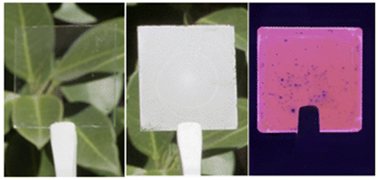
Abstract
Herein, we demonstrate mechanically stable large-area thin films with a purely real refractive index (n) close to 1 in the optical range. At specific wavelengths, it can reach values as small as n = 1.02, the lowest reported for thin solid slabs. These are made of a random network of interwoven spherical silica shells, created by chemical vapour deposition of a thin layer of silica on the surface of randomly packed monodisperse polymer nanoparticles that form a film. Thermal processing of the composites results in highly porous silica-based transparent thin films. We demonstrate the potential of this approach by making novel photonic materials such as strong optical diffusers, built by integrating scattering centers within the ultralow n transparent films, or highly efficient light-emitting slabs, in which losses by total internal reflection are practically absent as a result of the almost null optical impedance at the film-air interface.
August, 2024 · DOI: 10.1039/d4mh00826j
Materiales Coloidales
Mixed oxide ion-proton conductivity and the ionic migration mechanism in isolated tetrahedral LaVO4 by acceptor doping
Geng, XY; Hang, GQ; Fernadez-Carrion, AJ; Ming, X; Deng, SH; He, LH; Kuang, XJ; Yang, XYInorganic Chemistry Frontiers, 11 (2024) DOI: 10.1039/D4QI00870G
Abstract
Solid-state oxide ion and proton conductors are garnering significant attention due to their high ionic conductivity and potential applications in a range of electrochemical devices, including solid oxide fuel cells and gas sensors. In this study, we report the influence of partial substitution of La3+ in isolated tetrahedral LaVO4 ceramics with 0.01 mol of alkaline-earth metals Ca2+, Sr2+ and Ba2+ on the phase stability and electrical properties. It was found that acceptor doping effectively enhances mixed oxide ion and proton conductivities, with Sr2+ substitution yielding the highest conductivity, achieving ∼10−3 S cm−1 at 900 °C under a wet O2 atmosphere. DFT calculations and ab initio molecular dynamics simulations revealed that protons preferentially form hydrogen bonds with the lattice oxygen near the dopants and migrate through a continuous process of hopping and rotation between inter- and intra-tetrahedral VO4 groups. Additionally, the existence of oxygen vacancies facilitates the formation of V2O7 dimers through sharing corners with adjacent isolated VO4 tetrahedra, enabling ion exchange through a synergistic mechanism involving V2O7 dimer breaking and reforming. This research highlights the critical role of the deformation and rotational flexibility of isolated tetrahedral units in facilitating oxide ion and proton transport, underscoring the potential for developing mixed oxide ion and proton conductors in oxygen vacancy-deficient oxides with tetrahedral-based structures.
August, 2024 · DOI: 10.1039/D4QI00870G
Materiales Semiconductores para la Sostenibilidad
Strong angular and spectral narrowing ofelectroluminescence in an integrated Tamm-plasmon-driven halide perovskite LED
Ying, Z; Jiménez-Solano, A; Gatkowski, K; Sun, Y; Ferrer Orri, J; Frohna, K; Salway, H; Kahmann, S; Nie, S; Vega, G; Kar, S; Novak, MP; Máckowski, S; Nyga, P; Ducati, C; Greenham, NC; Lotsch, BV; Anaya, M; Stranks, SDNature Commications, 15 (2024) 5802 DOI: 10.1038/s41467-024-49838-1
Abstract
Next-generation light-emitting applications such as displays and opticalcommunications require judicious control over emitted light, includingintensity and angular dispersion. To date, this remains a challenge as con-ventional methods require cumbersome optics. Here, we report highly direc-tional and enhanced electroluminescence from a solution-processed quasi-2-dimensional halide perovskite light-emitting diode by building a devicearchitecture to exploit hybrid plasmonic-photonic Tamm plasmon modes. Byexploiting the processing and bandgap tunability of the halide perovskitedevice layers, we construct the device stack to optimise both optical andcharge-injection properties, leading to narrow forward electroluminescencewith an angular full-width half-maximum of 36.6° compared with the con-ventional isotropic control device of 143.9°, and narrow electroluminescencespectral full-width half-maximum of 12.1 nm. The device design is versatile andtunable to work with emission lines covering the visible spectrum with desireddirectionality, thus providing a promising route to modular, inexpensive, anddirectional operating light-emitting devices.
July, 2024 · DOI: 10.1038/s41467-024-49838-1
Materiales Coloidales
B-site deficient hexagonal perovskites: Structural stability, ionic order-disorder and electrical properties
Yang, X; Fernández-Carrión, AJ; Geng, X; Kuang, XProgress in Solid State Chemistry, 74 (2024) 100459 DOI: 10.1016/j.progsolidstchem.2024.100459
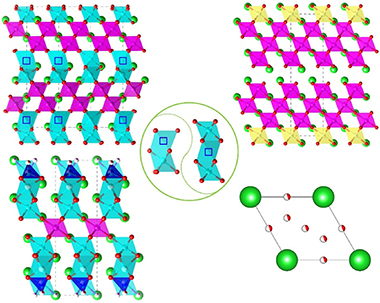
Abstract
This review presents an overview on the structures and electrical properties of B-site deficient hexagonal perovskite oxides, which have been receiving increasing attention as key components as dielectric resonators in microwave telecommunications, as well as solid-state oxide ion and proton conductors in solid oxide fuel cells. The structural evolution and stability, order-disorder of cation and anions, and mechanisms underlying the dielectric and ionic conduction behaviors for the B-site deficient hexagonal perovskites are summarized and the roles of the B-site deficiency on the structural stability and option, ion order-disorder and electrical performance are highlighted. This provides useful guidance for design of new hexagonal perovskite oxide materials and structural control to enhance their electrical properties and discover new functionality as dielectric resonators and solid-state ionic conductors.
May, 2024 · DOI: 10.1016/j.progsolidstchem.2024.100459
Materiales Semiconductores para la Sostenibilidad
Multifold Enhanced Photon Upconversion in a Composite Annihilator System Sensitized by Perovskite Nanocrystals
Chua, XW; Dai, LJ; Anaya, M; Salway, H; Ruggeri, E; Bi, PQ; Yang, ZH; Stranks, SD; Yang, LACS Nano, 18 (2024) 15229-15238 DOI: 10.1021/acsnano.4c03753

Abstract
Photon upconversion via triplet-triplet annihilation (TTA-UC) provides a pathway to overcoming the thermodynamic efficiency limits in single-junction solar cells by allowing the harvesting of sub-bandgap photons. Here, we use mixed halide perovskite nanocrystals (CsPbX3, X = Br/I) as triplet sensitizers, with excitation transfer to 9,10-diphenylanthracene (DPA) and/or 9,10-bis[(triisopropylsilyl)ethynyl]anthracene (TIPS-An) which act as the triplet annihilators. We observe that the upconversion efficiency is five times higher with the combination of both annihilators in a composite system compared to the sum of the individual single-acceptor systems. Our work illustrates the importance of using a composite system of annihilators to enhance TTA upconversion, demonstrated in a perovskite-sensitized system, with promise for a range of potential applications in light-harvesting, biomedical imaging, biosensing, therapeutics, and photocatalysis.
May, 2024 · DOI: 10.1021/acsnano.4c03753
Materiales Coloidales
Nanoparticulated Bimodal Contrast Agent for Ultra-High-Field Magnetic Resonance Imaging and Spectral X-ray Computed Tomography
González-Mancebo, D; Becerro, AI; Caro, C; Gómez-González, E; Luisa, GMM; Ocaña, MInorganic Chemistry, 63(23) (2024) 10648-10656 DOI: 10.1021/acs.inorgchem.4c01114
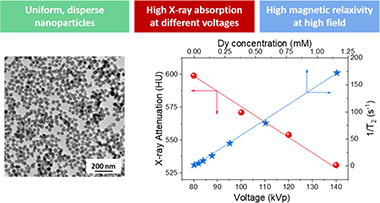
Abstract
Bimodal medical imaging based on magnetic resonance imaging (MRI) and computed tomography (CT) is a well-known strategy to increase the diagnostic accuracy. The most recent advances in MRI and CT instrumentation are related to the use of ultra-high magnetic fields (UHF-MRI) and different working voltages (spectral CT), respectively. Such advances require the parallel development of bimodal contrast agents (CAs) that are efficient under new instrumental conditions. In this work, we have synthesized, through a precipitation reaction from a glycerol solution of the precursors, uniform barium dysprosium fluoride nanospheres with a cubic fluorite structure, whose size was found to depend on the Ba/(Ba + Dy) ratio of the starting solution. Moreover, irrespective of the starting Ba/(Ba + Dy) ratio, the experimental Ba/(Ba + Dy) values were always lower than those used in the starting solutions. This result was assigned to lower precipitation kinetics of barium fluoride compared to dysprosium fluoride, as inferred from the detailed analysis of the effect of reaction time on the chemical composition of the precipitates. A sample composed of 34 nm nanospheres with a Ba0.51Dy0.49F2.49 stoichiometry showed a transversal relaxivity (r(2)) value of 147.11 mM(-1)s(-1) at 9.4 T and gave a high negative contrast in the phantom image. Likewise, it produced high X-ray attenuation in a large range of working voltages (from 80 to 140 kVp), which can be attributed to the presence of different K-edge values and high Z elements (Ba and Dy) in the nanospheres. Finally, these nanospheres showed negligible cytotoxicity for different biocompatibility tests. Taken together, these results show that the reported nanoparticles are excellent candidates for UHF-MRI/spectral CT bimodal imaging CAs.
May, 2024 · DOI: 10.1021/acs.inorgchem.4c01114
Materiales Ópticos Multifuncionales
Exciton-carrier coupling in a metal halide perovskite nanocrystal assembly probed by two-dimensional coherent spectroscopy
Rojas-Gatjens, E; Tiede, DO; Koch, KA; Romero-Perez, C; Galisteo-López, JF; Calvo, ME; Míguez, H; Kandada, ARSJournal of Physics-Materials, 7 (2024) 025002 DOI: 10.1088/2515-7639/ad229a
Abstract
The surface chemistry and inter-connectivity within perovskite nanocrystals play a critical role in determining the electronic interactions. They manifest in the Coulomb screening of electron-hole correlations and the carrier relaxation dynamics, among other many-body processes. Here, we characterize the coupling between the exciton and free carrier states close to the band-edge in a ligand-free formamidinium lead bromide nanocrystal assembly via two-dimensional coherent spectroscopy. The optical signatures observed in this work show: (i) a nonlinear spectral lineshape reminiscent of Fano-like interference that evidences the coupling between discrete electronic states and a continuum, (ii) symmetric excited state absorption cross-peaks that suggest the existence of a coupled exciton-carrier excited state, and (iii) ultrafast carrier thermalization and exciton formation. Our results highlight the presence of coherent coupling between exciton and free carriers, particularly in the sub-100 femtosecond timescales.
April, 2024 · DOI: 10.1088/2515-7639/ad229a
Materiales Semiconductores para la Sostenibilidad
Synergetic Near- and Far-Field Plasmonic Effects for Optimal All-Perovskite Tandem Solar Cells with Maximized Infrared Absorption
Bueno, J; Carretero Palacios, S; Anaya, MJournal of Physical Chemistry Letters, 15(9) (2024) 2632-2638 DOI: 10.1021/acs.jpclett.4c00194

Abstract
The efficiency and reliability of perovskite solar cells have rapidly increased in conjunction with the proposition of advanced single-junction and multi-junction designs that allow light harvesting to be maximized. However, Sn-based compositions required for optimized all-perovskite tandem devices have reduced absorption coefficients, as opposed to pure Pb perovskites. To overcome this, we investigate near- and far-field plasmonic effects to locally enhance the light absorption of infrared photons. Through optimization of the metal type, particle size, and volume concentration, we maximize effective light harvesting while minimizing parasitic absorption in all-perovskite tandem devices. Interestingly, incorporating 240 nm silver particles into the Pb-Sn perovskite layer with a volume concentration of 3.1% indicates an absolute power conversion efficiency enhancement of 2% in the tandem system. We present a promising avenue for experimentalists to realize ultrathin all-perovskite tandem devices with optimized charge carrier collection, diminishing the weight and the use of Pb.
February, 2024 · DOI: 10.1021/acs.jpclett.4c00194
Materiales Ópticos Multifuncionales
Strong Light-Matter Coupling in Lead Halide Perovskite Quantum Dot Solids
Bujalance, C; Caliò, Dirin, DN; Tiede, DO; Gaisteo-López, JF; Feist, J; García-Vidal, FJ; Kovalenko, MV; Míguez, HACS Nano, 18(6) (2024) 4922-4931 DOI: 10.1021/acsnano.3c10358
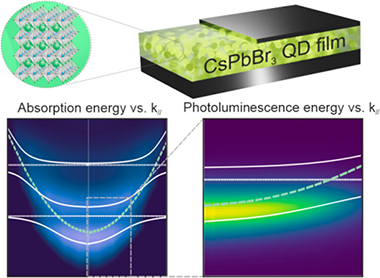
Abstract
Strong coupling between lead halide perovskite materials and optical resonators enables both polaritonic control of the photophysical properties of these emerging semiconductors and the observation of fundamental physical phenomena. However, the difficulty in achieving optical-quality perovskite quantum dot (PQD) films showing well-defined excitonic transitions has prevented the study of strong light-matter coupling in these materials, central to the field of optoelectronics. Herein we demonstrate the formation at room temperature of multiple cavity exciton-polaritons in metallic resonators embedding highly transparent Cesium Lead Bromide quantum dot (CsPbBr3-QD) solids, revealed by a significant reconfiguration of the absorption and emission properties of the system. Our results indicate that the effects of biexciton interaction or large polaron formation, frequently invoked to explain the properties of PQDs, are seemingly absent or compensated by other more conspicuous effects in the CsPbBr3-QD optical cavity. We observe that strong coupling enables a significant reduction of the photoemission line width, as well as the ultrafast modulation of the optical absorption, controllable by means of the excitation fluence. We find that the interplay of the polariton states with the large dark state reservoir plays a decisive role in determining the dynamics of the emission and transient absorption properties of the hybridized light-quantum dot solid system. Our results should serve as the basis for future investigations of PQD solids as polaritonic materials.
February, 2024 · DOI: 10.1021/acsnano.3c10358
Materiales Ópticos Multifuncionales - Materiales Semiconductores para la Sostenibilidad
Casimir-Lifshitz Optical Resonators: A New Platform for Exploring Physics at the Nanoscale
Esteso, V; Frustaglia, D; Carretero-Palacios, S; Míguez, HAdvanced Physics Research, 3 (2024) 2300065. DOI: 10.1002/apxr.202300065
Abstract
The Casimir-Lifshitz force, FC − L, has become a subject of great interest to both theoretical and applied physics communities due to its fundamental properties and potential technological implications in emerging nano-scale devices. Recent cutting-edge experiments have demonstrated the potential of quantum trapping at the nano-scale assisted by FC − L in metallic planar plates immersed in fluids through appropriate stratification of the inner dielectric media, opening up new avenues for exploring physics at the nano-scale. This review article provides an overview of the latest results in Casimir-Lifshitz based-optical resonator schemes and their potential applications in fields such as microfluidic devices, bio-nano and micro electromechanical systems (NEMS and MEMS), strong coupling, polaritonic chemistry, photo-chemistry, sensing, and metrology. The use of these optical resonators provides a versatile platform for fundamental studies and technological applications at the nano-scale, with the potential to revolutionize various fields and create new opportunities for research.
February, 2024 · DOI: 10.1002/apxr.202300065
Materiales Ópticos Multifuncionales
Scattering Spheres Boost Afterglow: A Mie Glass Approach to Go Beyond the Limits Set by Persistent Phosphor Composition
Castaing, V; Romero, M; Torres, J; Lozano, G; Míguez, HAdvanced Optical Materials, 12 (2024) 2301565 DOI: 10.1002/adom.202301565
Abstract
Persistent luminescence phosphor nanoparticles (PersLNPs) offer exciting opportunities for anticounterfeiting, data storage, imaging displays, or AC-driven lighting applications owing to the possibility to process them as shapable thin coatings. However, despite unique delayed and long-lasting luminescence, the relatively low storage capacity of persistent phosphor nanoparticles combined with the difficulty of harvesting photons from transparent thin layers drastically hinder the perceived afterglow. In order to enhance persistent luminescence (PersL) of thin coatings, herein a novel approach is proposed based on resonant optical nanostructures. In particular, it is demonstrated that the integration of TiO2 scattering spheres in films (with thickness comprised between 1 and 10 mu m) made of ZnGa2O4:Cr3+ PersLNPs enables a significant increase in afterglow intensity due to the combination of effective charging and enhanced outcoupling. As a result, a approximate to 3.5-fold enhancement of the PersL is observed in 2 mu m-thick films stuffed with scattering centers using low-light illumination conditions. Furthermore, inclusion of scattering centers leads to an unprecedented acceleration of the PersL charging speed. These results constitute the first example of photonic engineering applied to enhance the properties of PersL materials coatings.
January, 2024 · DOI: 10.1002/adom.202301565
Materiales Ópticos Multifuncionales
Quantification of Emission Efficiency in Persistent Luminescent Materials
Castaing, V; Romero, M; Rytz, D; Lozano, G; Lozano, G; Miguez, HAdvanced Optical Materials, 12 (2024) 36 DOI: 10.1002/adom.202401638
Abstract
Accurate quantification of efficiency enables rigorous comparison between different photoluminescent materials, providing an optimization path critical to the development of next-generation light sources. Persistent luminescent materials exhibit delayed and long-lasting luminescence due to the temporary storage of optical energy in engineered structural defects. Standard characterization methods do not provide a universal comparison of phosphor performance, hindering the evaluation of the efficiency of the various processes involved in afterglow. Here, a protocol is established to determine the quantum yield of persistent phosphors by considering the ratio of photons emitted in the afterglow and during charging to those absorbed. The method is first applied to transparent single crystals of the most common persistent phosphors, such as SrAl2O4:Eu2+,Dy3+ and Y3Al2Ga3O12:Ce3+,Cr3+. The versatility of the methodology is demonstrated by quantifying the quantum yield of a ZnGa2O4:Cr3+ thin film, a material widely used in in vivo imaging. The high efficiency of strontium aluminate is confirmed, and a strong dependence of the obtained values on the illumination conditions is revealed, highlighting a trade-off between efficiency and brightness. The results contribute to the development of standardized protocols for analyzing afterglow mechanisms and assessing overall efficiency, facilitating rigorous comparison and optimization of persistent materials beyond trial-and-error approaches.
· DOI: 10.1002/adom.202401638
Materiales Ópticos Multifuncionales
Effect of Connectivity on the Carrier Transport and Recombination Dynamics of Perovskite Quantum-Dot Networks
Tiede, DO; Romeo-Pérez, C; Koch, KA; Ucer, KB; Calvo, ME; Kandada, ARS; Galisteo-López, JF; Míguez, HACS Nano, 18(6) (2024) 2325-2334 DOI: 10.1021/acsnano.3c10239
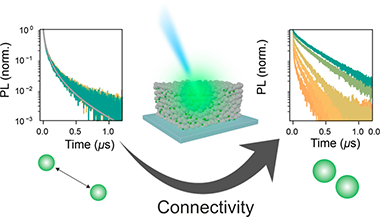
Abstract
Quantum-dot (QD) solids are being widely exploited as a solution-processable technology to develop photovoltaic, light-emission, and photodetection devices. Charge transport in these materials is the result of a compromise between confinement at the individual QD level and electronic coupling among the different nanocrystals in the ensemble. While this is commonly achieved by ligand engineering in colloidal-based systems, ligand-free QD assemblies have recently emerged as an exciting alternative where nanostructures can be directly grown into porous matrices with optical quality as well as control over their connectivity and, hence, charge transport properties. In this context, we present a complete photophysical study comprising fluence- and temperature-dependent time-resolved spectroscopy to study carrier dynamics in ligand-free QD networks with gradually varying degrees of interconnectivity, which we achieve by changing the average distance between the QDs. Analysis of the photoluminescence and absorption properties of the QD assemblies, involving both static and time-resolved measurements, allows us to identify the weight of the different recombination mechanisms, both radiative and nonradiative, as a function of QD connectivity. We propose a picture where carrier diffusion, which is needed for any optoelectronic application and implies interparticle transport, gives rise to the exposure of carriers to a larger defect landscape than in the case of isolated QDs. The use of a broad range of fluences permits extracting valuable information for applications demanding either low- or high-carrier-injection levels and highlighting the relevance of a judicious design to balance recombination and diffusion.
· DOI: 10.1021/acsnano.3c10239
2023
2023
Materiales Coloidales
Mn2+-doped MgGeO3 nanophosphors with controlled shape and optimized persistent luminescence
González-Mancebo, D; Arroyo, E; Becerro, AI; Ocaña, MCeramics International, 49 (2023) 36791-36799 DOI: 10.1016/j.ceramint.2023.09.008
Abstract
Mn2+-doped MgGeO3 (MgGeO3:Mn2+) is an efficient persistent phosphor that emits red luminescence for long time after stopping excitation with UV light. For optical and biotechnological uses a precise control of particle size and shape is highly desired since these parameters may have a strong influence on the properties and suitability of phosphor materials for the intended applications. To the best of our knowledge, MgGeO3:Mn2+ has been synthesized by conventional solid-state-reaction, which yields particles of heterogeneous size and shape. Here, we report for the first time in the literature a salt-assisted method for the synthesis of MgGeO3:Mn2+ nanoparticles with uniform shape (nanorods) and a mean size of 350 nm x 99 nm. The rigorous study of the luminescence properties of the MgGeO3:Mn2+ nanorods revealed that whereas the optimum doping level for photoluminescence was 2.0 mol% Mn2+, the best persistent luminescence was attained with just 0.5 mol% Mn2+, which is ascribed to the different mechanisms of both luminescence processes. The optimum persistent nano-phosphor showed an intense red emission, which persisted at least 17 h after stopping the excitation. Such excellent properties make the developed nanophosphor an attractive candidate for use in optical and biotech-nological applications.
November, 2023 · DOI: 10.1016/j.ceramint.2023.09.008
Materiales Ópticos Multifuncionales
Enhancement of upconversion photoluminescence in phosphor nanoparticle thin films using metallic nanoantennas fabricated by colloidal lithography
Ngo, TT; Viaña, JM; Romero, M; Calvo, ME; Lozano, G; Miguez, HMaterials Advances, 4 (2023) 6381-6388 DOI: 10.1039/D3MA00775H
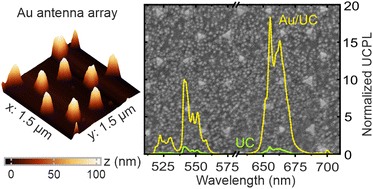
Abstract
Lanthanide-doped upconversion nanoparticles (UCNPs), as multifunctional light sources, are finding utility in diverse applications ranging from biotechnology to light harvesting. However, the main challenge in realizing their full potential lies in achieving bright and efficient photon upconversion (UC). In this study, we present a novel approach to fabricate an array of gold nanoantennas arranged in a hexagonal lattice using a simple and inexpensive colloidal lithography technique, and demonstrate a significant enhancement of UC photoluminescence (UCPL) by up to 35-fold through plasmon-enhanced photoexcitation and emission. To elucidate the underlying physical mechanisms responsible for the observed UCPL enhancement, we provide a comprehensive theoretical and experimental characterization, including a detailed photophysical description and numerical simulations of the spatial electric field distribution. Our results shed light on the fundamental principles governing the enhanced UCNPs and pave the way for their potential applications in photonic devices.
November, 2023 · DOI: 10.1039/D3MA00775H
Materiales Nanoestructurados y Microestructura - Materiales Ópticos Multifuncionales
Understanding the Problem of Hydrogen Storage Using a Demonstration: Coupling a Hydrogen Generator Based on the Hydrolysis of Sodium Borohydride to a Fuel-Cell Kit
Arzac, GM; Calvo, ME; Fernández, AJournal of Chemical Education. 100 (2023) 4554-4558 DOI: 10.1021/acs.jchemed.3c00590

Abstract
In the context of a green global energy paradigm, hydrogen (H-2) is a very promising energy carrier. In fuel cells, hydrogen can be used to generate electricity to drive an electric motor, producing water as its only byproduct. However, to implement hydrogen as an energy vector, developing methods for its production, storage, distribution, and use is essential. Sodium borohydride is a potential hydrogen source capable of releasing H-2 through catalytic hydrolysis. Herein, we present a demonstration that couples a hydrogen generator based on the hydrolysis of sodium borohydride to a commercial fuel-cell kit. The commercial fuel-cell kit operates using the hydrogen generated by an electrolyzer and includes a small fan to prove the successful generation of electricity. The performance of the fuel cell coupled with the borohydride-based reactor is compared to the performance achieved using the hydrogen produced by the electrolyzer. The borohydride-based reactor is designed to power the fan for 300 s and demonstrates efficient and safe hydrogen storage within a small volume of sodium borohydride. This study showcases the hydrogen cycle, the hydrogen storage problem, and the potential of sodium borohydride as a hydrogen storage material in a simple and useful way, contributing to science education and dissemination in the field of energy sustainability.
October, 2023 · DOI: 10.1021/acs.jchemed.3c00590
Materiales Semiconductores para la Sostenibilidad
Understanding ice and water film formation on soil particles by combining density functional theory and Casimir-Lifshitz forces
Bostrom, M; Kuthe, S; Carretero-Palacios, S; Esteso, V; Li, Y; Brevik, I; Gopidi, HR; Malyi, OI; Glaser, B; Persson, CPhysical Review B, 108 (2023) 125434 DOI: 10.1103/PhysRevB.108.125434
Abstract
Thin films of ice and water on soil particles play crucial roles in environmental and technological processes. Understanding the fundamental physical mechanisms underlying their formation is essential for advancing scientific knowledge and engineering practices. Herein, we focus on the role of the Casimir-Lifshitz force, also referred to as dispersion force, in the formation and behavior of thin films of ice and water on soil particles at 273.16 K, arising from quantum fluctuations of the electromagnetic field and depending on the dielectric properties of interacting materials. We employ the first-principles density functional theory (DFT) to compute the dielectric functions for two model materials, CaCO3 and Al2O3, essential constituents in various soils. These dielectric functions are used with the Kramers-Kronig relationship and different extrapolations to calculate the frequency-dependent quantities required for determining forces and free energies. Moreover, we assess the accuracy of the optical data based on the DFT to model dispersion forces effectively, such as those between soil particles. Our findings reveal that moisture can accumulate into almost micron-sized water layers on the surface of calcite (soil) particles, significantly impacting the average dielectric properties of soil particles. This research highlights the relevance of DFT-based data for understanding thin film formation in soil particles and offers valuable insights for environmental and engineering applications.
September, 2023 · DOI: 10.1103/PhysRevB.108.125434
Nanotecnología en Superficies y Plasma - Materiales Ópticos Multifuncionales
Effect of the effective refractive index on the radiative decay rate in nanoparticle thin films
Romero, M; Sánchez-Valencia, JR; Lozano, G; Míguez, HNanoscale, 15 (2023) 15279-15287 DOI: 10.1039/d3nr03348a
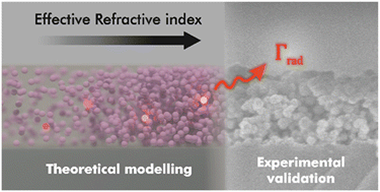
Abstract
In this work, we theoretically and experimentally study the influence of the optical environment on the radiative decay rate of rare-earth transitions in luminescent nanoparticles forming a thin film. We use electric dipole sources in finite-difference time-domain simulations to analyze the effect of modifying the effective refractive index of transparent layers made of phosphor nanocrystals doped with rare earth cations, and propose a correction to previously reported analytical models for calculating the radiative decay rate. Our predictions are tested against an experimental realization of such luminescent films, in which we manage to vary the effective refractive index in a gradual and controllable manner. Our model accurately accounts for the measurements attained, allows us to discriminate the radiative and non-radiative contributions to the time-resolved photoluminescence, and provides a way to rationally tune the spontaneous decay rate and hence the photoluminescence quantum yield in an ensemble of luminescent nanoparticles.
September, 2023 · DOI: 10.1039/d3nr03348a
Materiales Coloidales
Lanthanide vanadate-based trimodal probes for near-infrared luminescent bioimaging, high-field magnetic resonance imaging, and X-ray computed tomography
Gomez-Gonzalez, E; Gonzalez-Mancebo, D; Nunez, NO; Caro, C; Garcia-Martin, ML; Becerro, AI; Ocaña, MJournal of Colloid and Interface Science, 646 (2023) 721-731 DOI: 10.1016/j.jcis.2023.05.078
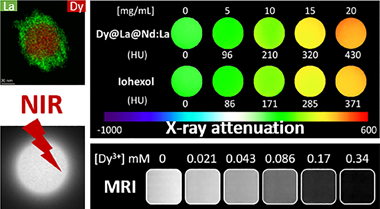
Abstract
We have developed a trimodal bioimaging probe for near-infrared luminescent imaging, high-field magnetic resonance imaging, and X-ray computed tomography using Dy3+ as the paramagnetic component and Nd3+ as the luminescent cation, both of them incorporated in a vanadate matrix. Among different essayed architectures (single phase and core-shell nanoparticles) the one showing the best luminescent properties is that consisting of uniform DyVO4 nanoparticles coated with a first uniform layer of LaVO4 and a second layer of Nd3+-doped LaVO4. The magnetic relaxivity (r2) at high field (9.4 T) of these nanoparticles was among the highest values ever reported for this kind of probes and their X-ray attenuation properties, due to the presence of lanthanide cations, were also better than those of a commercial contrast agent (iohexol) commonly used for X-ray computed to-mography. In addition, they were chemically stable in a physiological medium in which they could be easily dispersed owing to their one-pot functionalization with polyacrylic acid, and, finally, they were non-toxic for human fibroblast cells. Such a probe is, therefore, an excellent multimodal contrast agent for near-infrared luminescent imaging, high-field magnetic resonance imaging, and X-ray computed tomography.
September, 2023 · DOI: 10.1016/j.jcis.2023.05.078
Materiales Ópticos Multifuncionales
Inkjet-Printed and Nanopatterned Photonic Phosphor Motifs with Strongly Polarized and Directional Light-Emission
Cabello-Olmo, E; Romero, M; Kainz, M; Bernroitner, A; Kopp, S; Muhlberger, M; Lozano, G; Miguez, HAdvanced Functional Materials, (2023) 2305907 DOI: 10.1002/adfm.202305907
Abstract
Herein a versatile and scalable method to prepare periodically corrugated nanophosphor surface patterns displaying strongly polarized and directional visible light emission is demonstrated. A combination of inkjet printing and soft lithography techniques is employed to obtain arbitrarily shaped light emitting motifs. Such predesigned luminescent drawings, in which the polarization and angular properties of the emitted light are determined and finely tuned through the surface relief, can be used as anti-counterfeiting labels, as these two specific optical features provide additional means to identify any unauthorized or forged copy of the protected item. The potential of this approach is exemplified by processing a self-standing photoluminescent quick response code whose emission is both polarized and directionally beamed. Physical insight of the mechanism behind the directional out-coupled photoluminescence observed is provided by finite-difference time-domain calculations.
August, 2023 · DOI: 10.1002/adfm.202305907
Materiales Ópticos Multifuncionales
Measurement principles for quantum spectroscopy of molecular materials with entangled photons
Moretti, L; Rojas-Gatjens, E; Uboldi, L; Tiede, DO; Kumar, EJ; Trovatello, C; Preda, F; Perri, A; Manzoni, C; Cerullo, G; Kandada, ARSJournal of Chemical Physics, 159 (2023) 084201 DOI: 10.1063/5.0156598
Abstract
Nonlinear spectroscopy with quantum entangled photons is an emerging field of research that holds the promise to achieve superior signal-to-noise ratio and effectively isolate many-body interactions. Photon sources used for this purpose, however, lack the frequency tunability and spectral bandwidth demanded by contemporary molecular materials. Here, we present design strategies for efficient spontaneous parametric downconversion to generate biphoton states with adequate spectral bandwidth and at visible wavelengths. Importantly, we demonstrate, by suitable design of the nonlinear optical interaction, the scope to engineer the degree of spectral correlations between the photons of the pair. We also present an experimental methodology to effectively characterize such spectral correlations. Importantly, we believe that such a characterization tool can be effectively adapted as a spectroscopy platform to optically probe system-bath interactions in materials.
August, 2023 · DOI: 10.1063/5.0156598
Materiales Semiconductores para la Sostenibilidad
Surfactant-Dependent Bulk Scale Mechanochemical Synthesis of CsPbBr3 Nanocrystals for Plastic Scintillator-Based X-ray Imaging
Ghosh, J; O'Neill, J; Masteghin, MG; Braddock, I; Crean, C; Dorey, R; Salway, H; Anaya, M; Reiss, J; Wolfe, D; Sellin, PACS Applied Nano Materials, DOI: 10.1021/acsanm.3c02531
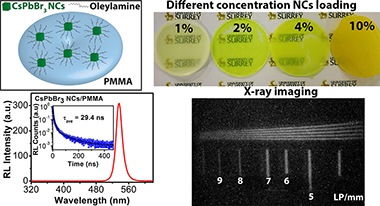
Abstract
We report a facile, solvent-free surfactant-dependentmechanochemicalsynthesis of highly luminescent CsPbBr3 nanocrystals (NCs)and study their scintillation properties. A small amount of surfactantoleylamine (OAM) plays an important role in the two-step ball millingmethod to control the size and emission properties of the NCs. Thesolid-state synthesized perovskite NCs exhibit a high photoluminescencequantum yield (PLQY) of up to 88% with excellent stability. CsPbBr3 NCs capped with different amounts of surfactant were dispersedin toluene and mixed with polymethyl methacrylate (PMMA) polymer andcast into scintillator discs. With increasing concentration of OAMduring synthesis, the PL yield of CsPbBr3/PMMA nanocompositewas increased, which is attributed to reduced NC aggregation and PLquenching. We also varied the perovskite loading concentration inthe nanocomposite and studied the resulting emission properties. Themost intense PL emission was observed from the 2% perovskite-loadeddisc, while the 10% loaded disc exhibited the highest radioluminescence(RL) emission from 50 kV X-rays. The strong RL yield may be attributedto the deep penetration of X-rays into the composite, combined withthe large interaction cross-section of the X-rays with the high-Zatoms within the NCs. The nanocomposite disc shows an intense RL emissionpeak centered at 536 nm and a fast RL decay time of 29.4 ns. Further,we have demonstrated the X-ray imaging performance of a 10% CsPbBr3 NC-loaded nanocomposite disc.
August, 2023 · DOI: 10.1021/acsanm.3c02531
Materiales Ópticos Multifuncionales
Ultrapure Green High Photoluminescence Quantum Yield from FAPbBr3 Nanocrystals Embedded in Transparent Porous Films
Romero-Pérez, C; Delgado, NF; Herrera-Collado, M; Calvo, ME; Míguez, H (MigChemistry of Materials, 35 (2023) 5541-5549 DOI: 10.1021/acs.chemmater.3c00934
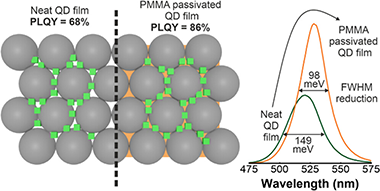
Abstract
Achieving highly transparent and emissive films based on perovskite quantum dots (PQDs) is a challenging task since their photoluminescence quantum yield (PLQY) typically drops abruptly when they are used as building blocks to make a solid. In this work, we obtain highly transparent films containing FAPbBr(3) quantum dots that display a narrow green emission (lambda = 530 nm, full width at half-maximum (FWHM) = 23 nm) with a PLQY as high as 86%. The method employed makes use of porous matrices that act as arrays of nanoreactors to synthesize the targeted quantum dots within their void space, providing both a means to keep them dispersed and a protective environment. Further infiltration with poly(methyl methacrylate) (PMMA) increases the mechanical and chemical stability of the ensemble and serves to passivate surface defects, boosting the emission of the embedded PQD and significantly reducing the width of the emission peak, which fulfills the requirements established by the Commission Internationale de l'E ' clairage (CIE) to be considered an ultrapure green emitter. The versatility of this approach is demonstrated by fabricating a color-converting layer that can be easily transferred onto a light-emitting device surface to modify the spectral properties of the outgoing radiation.
July, 2023 · DOI: 10.1021/acs.chemmater.3c00934
Materiales Ópticos Multifuncionales
Modeling Weakly Scattering Random Media: A Tool to Resolve the Internal Structure of Nanoporous Materials
Jimenez-Solano, A; Miranda-Munoz, JM; Carretero-Palacios, S; Miguez, HAdvanced Photonics Research, 4 (2023) 5 DOI: 10.1002/adpr.202200267
Abstract
Nanoporous media scatter a small fraction of the light propagating through them, even if pore sizes are significantly smaller than the characteristic visible wavelengths. The disordered spatial modulation of the refractive index at the few or few tens of nanometers length scale, resulting from the presence of randomly distributed air bubbles or solid aggregates within a continuous solid background, gives rise to these weak scattering effects. However, standard theoretical approaches to describe this kind of media use effective medium approximations that do not account for diffuse, ballistic, and specular components. Herein, all spectral components and the angular distribution of the scattered light are captured through optical modeling. A Monte Carlo approach, combining scattering Mie theory and Fresnel equations, implemented within a genetic algorithm, allows us to decode the void and aggregate size distribution and hence the internal structure of a nanocrystalline titania (TiO2) film chosen as a paradigmatic example. The approach allows to generically describe the scattering properties of nanoporous materials which, as shown herein, may be used to decipher their internal structure from the fitting of their far-optical field properties.
May, 2023 · DOI: 10.1002/adpr.202200267
Materiales Ópticos Multifuncionales - Materiales Coloidales
Oxidation and coordination states assumed by transition metal dopants in an invert ultrabasic silicate glass
Zandona, A; Castaing, V; Shames, AI; Helsch, G; Deubener, J; Becerro, AI; Allix, M; Goldstein, AJournal of Non-Crystalline Solids, 603 (2023) 122094 DOI: 10.1016/j.jnoncrysol.2022.122094
Abstract
An ultrabasic invert silicate glass (46SiO2.11Na2O.21CaO.22BaO, optical basicity index equal to 0.71) was synthesized (O2 atmosphere) and used as host for various transition metal dopants. Optical absorption, emission and electron paramagnetic spectroscopies were used to characterize oxidation and coordination states. Some of the dopants displayed only their maximal oxidation state (Ti4+, V5+, Cr6+, Mo6+ and W6+). Others exhibited mixed valences: (i) Mn3+ was the dominant species, alongside Mn2+ and Mn5+; (ii) stable Fe3+ prevailed, although some Fe2+ was preliminarily suggested by the absorption spectrum; (iii) Co3+ probably accompanied the dominant Co2+ tetrahedral oxide complex; (iv) like in "conventional" silicate glasses, only Ni2+ was detected, though simultaneously located in tetrahedral and octahedral sites (somewhat distorted); (v) Cu+ was surprisingly identified alongside the expected 6-fold coordinated Cu2+. Drastic reduction of the oxygen content in the melting atmosphere led to conversion of Cr6+ to Cr3+, despite the extreme basicity of the host.
March, 2023 · DOI: 10.1016/j.jnoncrysol.2022.122094
Materiales Ópticos Multifuncionales
Origin of anomalously stabilizing ice layers on methane gas hydrates near rock surface
Li, Y; Corkery, RW; Carretero-Palacios, S; Berland, K; Esteso, V; Fiedler, J; Milton, KA; Brevik, I; Bostrom, MPhysical Chemistry Chemical Physics, 25 (2023) 6636-6652 DOI: 10.1039/d2cp04883c
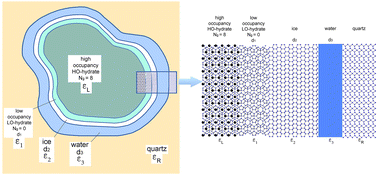
Abstract
Gas hydrates (GHs) in water close to freezing temperatures can be stabilised via the formation of ice layers. In a recent work [Bostrom et al., Astron. Astrophys., A54, 650, 2021], it was found that a surface region with partial gas dilution could be essential for obtaining nano- to micron-sized anomalously stabilizing ice layers. In this paper, it is demonstrated that the Casimir-Lifshitz free energy in multi-layer systems could induce thinner, but more stable, ice layers in cavities than those found for gas hydrates in a large reservoir of cold water. The thickness and stability of such ice layers in a pore filled with cold water could influence the leakage of gas molecules. Additional contributions, e.g. from salt-induced stresses, can also be of importance, and are briefly discussed.
March, 2023 · DOI: 10.1039/d2cp04883c
Materiales Coloidales
Persistent Luminescence Zn2GeO4:Mn2+Nanoparticles Functionalized with Polyacrylic Acid: One-Pot Synthesis and Biosensing Applications
Calderon-Olvera, RM; Arroyo, E; Jankelow, AM; Bashir, R; Valera, E; Ocana, M; Becerro, AIACS Applied Materials & Interfaces, 15 (2023) 20613-20624 DOI: 10.1021/acsami.2c21735

Abstract
Zinc germanate doped with Mn2+ (Zn2GeO4:Mn2+) is known to be a persistent luminescence green phosphor with potential applications in biosensing and bioimaging. Such applications demand nanoparticulated phosphors with a uniform shape and size, good dispersibility in aqueous media, high chemical stability, and surfacefunctionalization. These characteristics could be major bottlenecks and hence limit their practical applications. This work describes a one-pot, microwave-assisted hydrothermal method to synthesize highly uniform Zn2GeO4:Mn2+ nanoparticles (NPs) using polyacrylic acid (PAA) as an additive. A thorough characterization of the NPs showed that the PAA molecules were essential to realizing uniform NPs as they were responsible for the ordered aggregation of their building blocks. In addition, PAA remained attached to the NPs surface, which conferred high colloidal stability to the NPs through electrostatic and steric interactions, and provided carboxylate groups that can act as anchor sites for the eventual conjugation of biomolecules to the surface. In addition, it was demonstrated that the as-synthesized NPs were chemically stable for, at least, 1 week in phosphate buffer saline (pH range = 6.0-7.4). The luminescence properties of Zn2GeO4 NPs doped with different contents of Mn2+ (0.25-3.00 mol %) were evaluated to find the optimum doping level for the highest photoluminescence (2.50% Mn) and the longest persistent luminescence (0.50% Mn). The NPs with the best persistent luminescence properties were photostable for at least 1 week. Finally, taking advantage of such properties and the presence of surface carboxylate groups, the Zn2GeO4:0.50%Mn2+ sample was successfully used to develop a persistent luminescence-based sandwich immunoassay for the autofluorescence-free detection of interleukin-6 in undiluted human serum and undiluted human plasma samples. This study demonstrates that our persistent Mndoped Zn2GeO4 nanophosphors are ideal candidates for biosensing applications.
March, 2023 · DOI: 10.1021/acsami.2c21735
Materiales Ópticos Multifuncionales
Determination of the optical constants of ligand-free organic lead halide perovskite quantum dots
Rubino, A; Lozano, G; Calvo, ME; Miguez, HNanoscale, 15 (2023) 2553-2560 DOI: 10.1039/d2nr05109e
Abstract
Precise knowledge of the optical constants of perovskite lead halide quantum dots (QDs) is required to both understand their interaction with light and to rationally design and optimize the devices based on them. However, their determination from colloidal nanocrystal suspensions, or films made out of them, remains elusive, as a result of the difficulty in disentangling the optical constants of the organic capping ligands and those of the semiconductor itself. In this work, we extract the refractive index and extinction coefficient of ligand-free methylammonium lead iodide (MAPbI(3)) and bromide (MAPbBr(3)) nanocrystals. In order to prevent the use of organic ligands in the preparation, we follow a scaffold assisted synthetic procedure, which yields a composite film of high optical quality that can be independently and precisely characterized and modelled. In this way, the contribution of the guest nanocrystals can be successfully discriminated from that of the host matrix. Using a Kramers-Kronig consistent dispersion model along with an effective medium approximation, it is possible to derive the optical constants of the QDs by fitting the spectral dependence of light transmitted and reflected at different angles and polarizations. Our results indicate a strong dependence of the optical constants on the QD size. Small nanocrystals show remarkably large values of the extinction coefficient compared to their bulk counterparts. This analysis opens the door to the rigorous modelling of solar cells and light-emitting diodes with active layers based on perovskite QDs.
February, 2023 · DOI: 10.1039/d2nr05109e
Materiales Coloidales
Europium doped-double sodium bismuth molybdate nanoparticles as contrast agents for luminescence bioimaging and X-ray computed tomography
Calderon-Olvera, RM; Nunez, NO; Gonzalez-Mancebo, D; Monje-Moreno, JM; Munoz-Rui, MJ; Gomez-Gonzalez, E; Arroyo, E; Torres-Herrero, B; De la Fuente, JM; Ocaña, MInorganic Chemistry Frontiers, 10(11) (2023) 3202 DOI: 10.1039/D2QI02664C
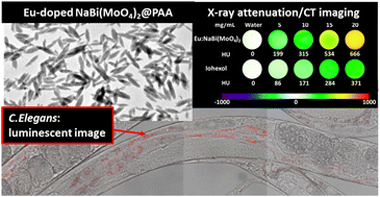
Abstract
A one-pot method for the synthesis of uniform Eu3+-doped NaBi(MoO4)2 nanoparticles with an ellipsoidal shape and tetragonal crystal structure functionalized with polyacrylic acid is reported for the first time in the literature. The method is based on a homogeneous precipitation reaction from solutions in an ethylene glycol/water medium containing appropriate bismuth, sodium, and molybdate precursors and polyacrylic acid. The luminescence properties (excitation and emission spectra and luminescence lifetime) of such nanoparticles are evaluated for different Eu3+ doping levels, finding an intense red emission for all synthesized samples. The X-ray attenuation properties of the nanoparticles have been also analyzed, which were found to be better than those of a commercially computed tomography contrast agent (iohexol). The dispersibility of the nanoparticles in a physiological medium was also analyzed, finding that they could be well dispersed in a 2-N-morpholinoethanesulfonic acid monohydrate medium (pH = 6.5). Finally, the cell viability of such a phosphor has been analyzed using MIA-PaCa-2 cells and its in vivo toxicity has been evaluated using the nematode Caenorhabditis elegans model finding no significant toxicity in both cases up to a nanoparticle concentration of 100 μg mL−1, which is within the range required for most in vivo applications. The developed Eu3+-doped NaBi(MoO4)2 nanoparticles are, therefore, excellent candidates for their use as bimodal probes for luminescence imaging and X-ray computed tomography.
February, 2023 · DOI: 10.1039/D2QI02664C
Materiales Semiconductores para la Sostenibilidad
Non-sticky interactions
Esteso, VNature Physics, 19 (2023) 161-162 DOI: 10.1038/s41567-022-01935-y
Abstract
Quantum mechanical fluctuations of the electromagnetic field in a vacuum between two close together objects result in an attractive force. Now, it has been experimentally shown that by exploiting a similar repulsive interaction, attraction between objects can be modulated simply by tuning temperature.
February, 2023 · DOI: 10.1038/s41567-022-01935-y
Materiales Ópticos Multifuncionales
Collective plasmonic resonances enhance the photoluminescence of rare-earth nanocrystal films processed by ultrafast annealing
Cabello-Olmo, E; Higashino, M; Murai, S; Tanaka, K; Lozano, G; Miguez, HChemical Communications, 59 (2023) 1289-1292 DOI: 10.1039/d2cc04779a

Abstract
Herein, we demonstrate that rapid thermal annealing allows achieving close-to-one photoluminescence quantum yield while preserving the transparency of rare-earth nanocrystal films, which further enables their integration with nanophotonics. The combination with periodic arrays of aluminum nanodisks that support collective plasmonic resonances leads to enhanced directional emission.
January, 2023 · DOI: 10.1039/d2cc04779a
Materiales Ópticos Multifuncionales
Responsive Optical Materials Based on Ligand-Free Perovskite Quantum Dots Embedded in Mesoporous Scaffolds
Romero-Perez, C; Zanetta, A; Fernandez-Delgado, N; Herrera-Collado, M; Hernandez-Saz, J; Molina, SI; Calio, L; Calvo, ME; Miguez, HACS Applied Materials & Interfaces 15 (2023) 1808-1816 DOI: 10.1021/acsami.2c16867
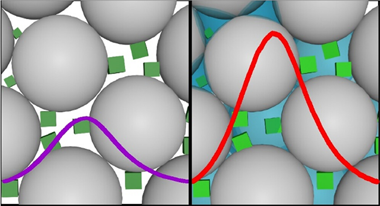
Abstract
Herein we show that dispersing inorganic cesium lead bromide (CsPbBr3) perovskite quantum dots (QDs) in optical quality films, possessing an accessible and controlled pore size distribution, gives rise to fluorescent materials with a controlled and highly sensi t i v e response to ambient changes. A scaffold-based synthesis approach is employed to obtain ligand-free QDs, whose pristine surface endows them with high sensit i v i t y to the presence of different vapors in their vici n i t y . At the same time, the void network of the host offers a means to gradually expose the embedded QDs to such vapors. Under these conditions, the luminescent response of the QDs is mediated by the mesostructure of the matri x , which determines the rate at which vapor molecules will adsorb onto the pore walls and, eventually, condensate, filling the void space. With luminescence quantum yields as high as 60%, scaffold-supported ligand-free perovskite nanocrystals display intense photoemission signals over the whole process, as well as high photo-and chemical stabi l i t y , which allows illuminating them for long periods of time and recovering the original response upon desorption of the condensed phase. The results herein presented open a new route to explore the application of perovskite QD-based materials in sensing.
January, 2023 · DOI: 10.1021/acsami.2c16867
Materiales Ópticos Multifuncionales - Materiales Coloidales
Highly Nonstoichiometric YAG Ceramics with Modified Luminescence Properties
Cao, WW; Becerro, AI; Castaing, V; Fang, X; Florian, P; Fayon, F; Zanghi, D; Veron, E; Zandona, A; Genevois, C; Pitcher, MJ; Allix, MAdvanced Functional Materials DOI: 10.1002/adfm.202213418
Abstract
Y3Al5O12 (YAG) is a widely used phosphor host. Its optical properties are controlled by chemical substitution at its YO8 or AlO6/AlO4 sublattices, with emission wavelengths defined by rare-earth and transition-metal dopants that have been explored extensively. Nonstoichiometric compositions Y3+xAl5-xO12 (x not equal 0) may offer a route to new emission wavelengths by distributing dopants over two or more sublattices simultaneously, producing new local coordination environments for the activator ions. However, YAG typically behaves as a line phase, and such compositions are therefore challenging to synthesize. Here, a series of highly nonstoichiometric Y3+xAl5-xO12 with 0 <= x <= 0.40 is reported, corresponding to <= 20% of the AlO6 sublattice substituted by Y3+, synthesized by advanced melt-quenching techniques. This impacts the up-conversion luminescence of Yb3+/Er3+-doped systems, whose yellow-green emission differs from the red-orange emission of their stoichiometric counterparts. In contrast, the YAG:Ce3+ system has a different structural response to nonstoichiometry and its down-conversion emission is only weakly affected. Analogous highly nonstoichiometric systems should be obtainable for a range of garnet materials, demonstrated here by the synthesis of Gd3.2Al4.8O12 and Gd3.2Ga4.8O12. This opens pathways to property tuning by control of host stoichiometry, and the prospect of improved performance or new applications for garnet-type materials.
January, 2023 · DOI: 10.1002/adfm.202213418
Materiales Coloidales
Carboxylate functionalized NaDy(MoO4)(2) nanoparticles with tunable size and shape as high magnetic field MRI contrast agents
Gomez-Gonzalez, E; Nuñez, NO; Caro, C; Garcia-Martin, ML; Ocaña, MJournal of Colloid and Interface Science, 629 (2023) 310-321 DOI: 10.1016/j.jcis.2022.08.130
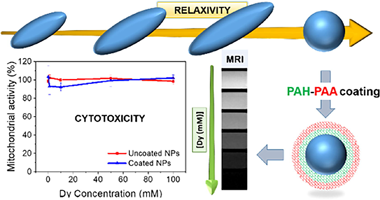
Abstract
Uniform sodium-dysprosium double molybdate (NaDy(MoO4)(2)) nanoparticles having different morphologies (spheres and ellipsoids) and tunable size have been synthesized for the first time in literature. The procedure is based on a homogeneous precipitation process at moderated temperatures (<= 220 ?) from solutions containing appropriated precursors dissolved in ethylene glycol-water mixtures, in the absence (spheres) or the presence (ellipsoids) of tartrate anions. The effects of the morphological characteristics (size and shape) of the nanoparticles on the magnetic relaxivity at high field (9.4 T) have been evaluated finding that the latter magnitude was higher for the spheres than for the ellipsoids, indicating their better suitability as contrast agents for high-field magnetic resonance imaging. Such nanoparticles have been successfully coated with polymers bearing carboxylate functional groups through a layer-by -layer process, which improves the colloidal stability of the nanoparticles in physiological media. It has been also found that the coating layer had no significant effects on the nanoparticles relaxivity and that such coated nanoparticles exhibited a high biocompatibility and a high chemical stability. In summary, we have developed NaDy(MoO4)(2 )based bioprobes which meet the required criteria for their use as contrast agents for high-field magnetic resonance imaging.
January, 2023 · DOI: 10.1016/j.jcis.2022.08.130
2022
2022
Materiales Ópticos Multifuncionales
Nanoantennas Patterned by Colloidal Lithography for Enhanced Nanophosphor Light Emission
Viana, JM; Romero, M; Lozano, G; Míguez, HACS Applied Nano Materials, 5(11) (2022) 16242-16249 DOI: 10.1021/acsanm.2c03258
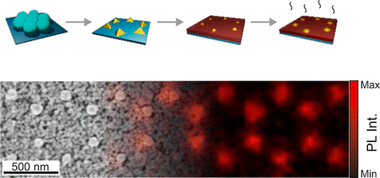
Abstract
Transparent coatings made of rare-earth doped nanocrystals, also known as nanophosphors, feature efficient photoluminescence and excellent thermal and optical stabi l i t y . Herein, we demonstrate that the optical antennas prepared by colloidal lithography render thin nanophosphor films with a brighter emission. In particular, we fabricate gold nanostructures in the proximity of GdVO4:Eu3+ nanophosphors by metal evaporation using a mask made of a monolayer of polymer beads arranged in a triangular lattice. Optical modes supported by the antennas can be controlled by tuning the diameter of the polymer spheres in the colloidal mask, which determines the shape of the gold nanostructure, as confirmed by numerical simulations. Confocal microscopy reveals that metallic antennas induce brighter photoluminescence at specific spatial regions of the nanophosphor film at targeted frequencies as a result of the coupling between gold nanostructures and nanophosphors. Patterning of nanophosphor thin layers with arrays of metallic antennas offers an inexpensive nanophotonic solution to develop bright emitting coatings of interest for color conversion, labeling , or anti-counterfeiting.
November, 2022 · DOI: 10.1021/acsanm.2c03258
Materiales Ópticos Multifuncionales
Enhanced red-UC luminescence through Ce3+ co-doping in NaBiF4:Yb3+/Ho3+(Er3+)/Ce3+ phosphors prepared by ultrafast coprecipitation approach
Giordano, L; Du, H; Castaing, V; Luan, F; Guo, D; Viana, BOptical Materials X, 16 (2022) 100199 DOI: 10.1016/j.omx.2022.100199
Abstract
Series of Yb3+/Ho3+(Er3+)/Ce3+ co-doped NaBiF4 phosphors were synthesized through an ultrafast co-precipitation reaction technique at room temperature. The effect of the Ce3+ ions on the crystal structure and upconversion (UC) luminescence properties of the studied samples were investigated in detail. FTIR and XPS demonstrated the pre-formation of NaBiF4 and the introduction of Yb3+, Ho3+, Er3+ and Ce3+ all as dopants in the host materials. Under 980 nm excitation, NaBiF4:Yb3+,Ho3+(Er3+),Ce3+performed the characteristic emission of the activator ion, and the introduction of Ce3+ did not change the emission wavelengths, only the relative intensities. Due to partial good energy overlap when 2F7/2 Ce3+ manifold is populated, raising Ce3+ ions concentration enhanced the red UC emission versus green UC emission but also lead to significant decrease in the average lifetimes of all monitored emissions for Ho3+ and Er3+. These lifetime decreases are explained by the energy loss in non-radiative pathways after the introduction of Ce3+. In addition, the green to yellow color emission change through addition of Ce3+ was explored in NaBiF4: Yb3+,Ho3+,Ce3+ to propose a novel application in two-level anti-counterfeiting.
October, 2022 · DOI: 10.1016/j.omx.2022.100199
Materiales Coloidales
Outstanding MRI contrast with dysprosium phosphate nanoparticles of tuneable size
Gómez-González, E.; Caro, C.; García-Martín, ML; Becerro, AI; Ocaña, M.Nanoscale, 14 (2022) 11461-11470 DOI: 10.1039/d2nr02630a
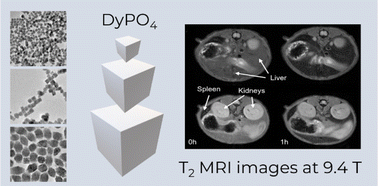
Abstract
The use of high-field magnets for magnetic resonance imaging (MRI) is expected to experience the fastest growth rate during the present decade. Although several CAs for MRI scanners using high magnetic fields have been reported, they are mostly based on fluoride matrices, which are known for their low chemical stability in aqueous suspensions. Chemically stable MRI CAs for high-field magnets are therefore needed to enable the advances in MRI technique. Herein, we synthesized uniform DyPO4 nanoparticles (NPs) with tuneable sizes between 23 and 57 nm using homogeneous precipitation in butanol. The NPs were successfully functionalized with polyacrylic acid (PAA) and showed good colloidal stability in aqueous suspensions. Chemical stability was also assessed in PBS, showing negligible solubility. The effect of particle size on the transversal relaxivity value (r(2)) was further explored at 9.4 T, finding a clear increase in r(2) with particle size. The r(2) value found for the largest NPs was 516 mM(-1) s(-1), which is, to the best of our knowledge, the highest r(2) value ever reported at 9.4 T for any Dy-based nanometric particles in the literature. Finally, the latter NPs were submitted to biosafety studies after polyethylene glycol (PEG) functionalization. Cell morphology, induction of necrotic/late apoptotic cells, and mitochondrial activity were thoroughly analyzed. The results clearly indicated negligible toxicity effects under the assayed conditions. Short- and long-term in vivo pharmacokinetics of the intravenously injected NPs were assessed by dynamic T-2-weighted MRI and quantitative T-2 mapping, revealing faster liver than spleen uptake, while no accumulation was observed in the kidneys. Finally, no histopathological changes were observed in any of the studied organs, including the liver, kidney, spleen, and lung, which provide further evidence of the biocompatibility of DyPO4 NPs and, therefore, their suitability as bioimaging probes.
August, 2022 · DOI: 10.1039/d2nr02630a
Materiales Ópticos Multifuncionales
Effect of Spatial Inhomogeneity on Quantum Trapping
Esteso, V; Carretero-Palacios, S; Miguez, HJournal of Physical Chemistry Letters, 13 (2022) 4513-4519 DOI: 10.1021/acs.jpclett.2c00807
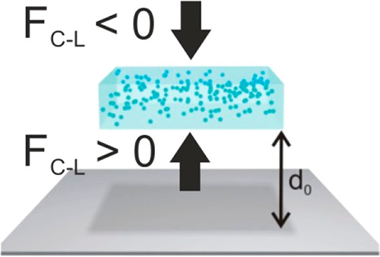
Abstract
An object that is immersed in afluid and approaching a substrate mayfind apotential energy minimum at a certain distance due to the balance between attractive and repulsiveCasimir-Lifshitz forces, a phenomenon referred to as quantum trapping. This equilibriumdepends on the relative values of the dielectric functions of the materials involved. Herein, westudy quantum trapping effects in planar nanocomposite materials and demonstrate that they arestrongly dependent on the characteristics of the spatial inhomogeneity. As a model case, weconsider spherical particles embedded in an otherwise homogeneous material. We propose aneffective medium approximation that accounts for the effect of inclusions andfind that anunprecedented and counterintuitive intense repulsive Casimir-Lifshitz force arises as a result ofthe strong optical scattering and absorption size-dependent resonances caused by their presence. Our results imply that the properanalysis of quantum trapping effects requires comprehensive knowledge and a detailed description of the potential inhomogeneity(caused by imperfections, pores, inclusions, and density variations) present in the materials involved
June, 2022 · DOI: 10.1021/acs.jpclett.2c00807
Materiales Coloidales
Neodymium doped lanthanide fluoride nanoparticles as contrast agents for luminescent bioimaging and X-ray computed tomography
Gonzalez-Mancebo, D; Becerro, AI; Calderon-Olvera, RM; Cantelar, E; Corral, A; Balcerzyk, M; De la Fuente, JM; Ocaña, MBoletin de la Sociedad Española de Ceramica y Vidrio, 61 (2022) 540-549 DOI: 10.1016/j.bsecv.2021.07.004
Abstract
The synthesis of uniform neodymium-doped lanthanum trifluoride nanoparticles with lenticular shape and a mean diameter around 45 nm by using a homogeneous precipitation method is reported. The luminescent properties of the synthesized samples in terms of their emission spectra and emission lifetime are analyzed as a function of the Nd content to find the optimum phosphor and its suitability for luminescent imaging in the second biological window. The X-ray attenuation properties of the optimum phosphor are evaluated to investigate their additional ability as contrast agent for X-ray computed tomography. Finally, the colloidal stability of the obtained nanoparticles in physiological medium and their cytotoxicity are also analyzed to assess their aptness for in vivo bioimaging applications.
May, 2022 · DOI: 10.1016/j.bsecv.2021.07.004
Materiales Ópticos Multifuncionales
Enhanced up-conversion photoluminescence in fluoride-oxyfluoride nanophosphor films by embedding gold nanoparticles
Ngo, TT; Lozano, G; Miguez, HMaterials Advances 3 (2022) 4235-4242 DOI: 10.1039/D2MA00068G
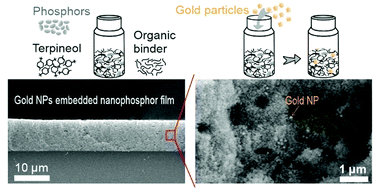
Abstract
Owing to their unique non-linear optical character, lanthanide-based up-converting materials are potentially interesting for a wide variety of fields ranging from biomedicine to light harvesting. However, their poor luminescent efficiency challenges the development of technological applications. In this context, localized surface plasmon resonances (LSPRs) have been demonstrated as a valuable strategy to improve light conversion. Herein, we utilize LSPR induced by gold nanoparticles (NPs) to enhance up-conversion photoluminescence (UCPL) in transparent, i.e. scattering-free, films made of nanophosphors formed by fluoride–oxyfluoride host matrix that feature high thermal stability. Transparency allows excitation by an external source without extinction losses caused by unwanted diffuse reflection. We provide a simple method to embed gold NPs in films made of YF/YOF:Yb3+,Er3+ UC nanophosphors, via preparation of a viscous paste composed of both UC nanophosphors and colloidal gold NPs, reducing complexity in sample fabrication. The dimensions of gold NPs are such that their associated LSPR matches spectrally with the green emission band of the Er3+ doped nanophosphors. In order to demonstrate the benefits of plasmonic nanoparticles for UCPL in nanophosphor films, we provide a careful analysis of the structural properties of the composite thin films along with precise characterization of the impact of the gold NPs on the photophysical properties of UC nanophosphors.
April, 2022 · DOI: 10.1039/D2MA00068G
Reactividad de Sólidos
Highly uniform Y3Al2Ga3O12-based nanophosphors for persistent luminescence bioimaging in the visible and NIR regions
Arroyo, E; Herrero, BT; De la Fuente, JM; Ocaña, M; Becerro, AIInorganic Chemistry Frontiers, 9 (2022) 2454-2461 DOI: 10.1039/d2qi00480a
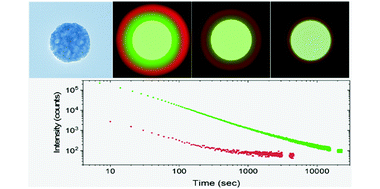
Abstract
In the last few years, persistent phosphors with a garnet crystal structure have attracted a great deal of interest for a plethora of applications ranging from bioimaging to anti-counterfeiting technologies. However, the development of synthesis methods to fabricate uniform garnet-based micro and nanoparticles, that are needed for such applications, is not mature at all. This study reports the synthesis of highly uniform yttrium aluminum gallium garnet nanospheres. The method is based on homogeneous precipitation in a polyol medium followed by silica coating and calcination. The nanoparticles resulting after silica removal were also uniform and were easily functionalized with polyacrylic acid. The colloidal stability of the latter in physiological media and their biocompatibility were analyzed. The luminescence of the particles, doped with Ce3+, Cr3+, and Nd3+, was studied by recording emission and excitation spectra and persistent luminescence decay curves. Due to their uniform morphology, high colloidal stability, absence of toxicity, and persistent emission in the visible and near-infrared regions, the reported nanospheres show great potential as persistent luminescent bioimaging probes. In addition, the synthesis method paves the way for future use of this persistent material in other applications that require the phosphor to be in the form of highly uniform nanoparticles.
April, 2022 · DOI: 10.1039/d2qi00480a
Materiales Ópticos Multifuncionales
Transparent Phosphor Thin Films Based on Rare-Earth-Doped Garnets: Building Blocks for Versatile Persistent Luminescence Materials
Castaing, V; Lozano, G; Míguez, HAdvanced Photonics Research, 3 (2022) 2100367 DOI: 10.1002/adpr.202100367
Abstract
Afterglow properties of persistent phosphors are attracting a great deal of attention in the fields of bioimaging, sensing, labeling, safety, or security. Complex garnet oxides, especially those doped with Ce3+ and Cr3+, are particularly relevant to this end since their persistent luminescence can be tuned through matrix composition and activated by visible light, in contrast to the vast majority of persistent phosphors that require UV excitation. Most extended preparation routes yield micrometer-sized phosphors that display strong light scattering, which limits their versatility and applicability. Herein, nanostructured garnet oxide-based thin films that are transparent and feature persistent luminescence properties are demonstrated. Following a sol–gel route and after high temperature annealing, few hundred nanometre-thick Y3Al2Ga3O12:Ce3+,Cr3+ transparent films showing efficient green emission and afterglow are attained. Gd3Al2Ga3O12:Ce3+,Cr3+ transparent thin films displaying yellow afterglow with distinct persistent kinetics are demonstrated, to prove the generality of the approach herein proposed. Its versatility is further demonstrated by developing layered phosphors with time-dependent chromaticity due to the unique persistent emission color – upon blue light excitation – and kinetics of each layer forming the stack. The results pave an avenue toward nanodevices and multifunctional coatings in which afterglow offers hitherto unexplored properties.
April, 2022 · DOI: 10.1002/adpr.202100367
Materiales Ópticos Multifuncionales
Molecular Interface Engineering via Triazatruxene-Based Moieties/NiOx as Hole-Selective Bilayers in Perovskite Solar Cells for Reliability
Hemasiri, NH; Calio, L; Pegu, M; Kazim, S; Ahmad, SSolar RRL (2022) 2100793 DOI: 10.1002/solr.202100793
Abstract
Interface engineering is an effective approach to decrease nonradiative recombination and the energy barrier at the perovskite/hole transporting layer (HTL) interfaces. To overcome such limitations, an organic semiconductor (DTT-EHDI2) is proposed, which is, composed of dithienothiophene (DTT) as the core and a planar triazatruxene incorporating an alkyl chain as the side group. This is noted to be an effective interfacial layer for inverted planar perovskite solar cells (PSCs). The altered interface effectively minimizes the detrimental charge recombination and tailors the photoinduced charge transfer dynamics at the interface of the inorganic HTL/perovskite. The pi-conjugation in DTT-EHDI2 induces high hole mobility and electrical conductivity via electron-donating properties and strong pi-pi intermolecular interaction. The synergetic approach leads to a substantial performance enhancement in dopant-free DTT-EHDI2-based inverted planar PSCs, achieving 18.15% power conversion efficiency with negligible hysteresis effect. The present approach provides an effective direction of the cost-effective thiophene derivative as an interfacial agent to escalate the optoelectronic performances in photovoltaics.
January, 2022 · DOI: 10.1002/solr.202100793
Materiales Ópticos Multifuncionales
Optoelectronic Devices Based on Scaffold Stabilized Black-Phase CsPbI3 Nanocrystals
Romero-Perez, C; Rubino, A; Calio, L; Calvo, ME; Miguez, HAdvanced Optical Materials (2022) 2102112 DOI: 10.1002/adom.202102112
Abstract
The optoelectronic properties of lead halide perovskites are intimately related to their crystalline phase. For the case of cesium lead iodide (CsPbI3) several polymorphs meet the Goldschmidt tolerance factor, which determines their stability, and form broad band absorber and luminescent phases. However, at room temperature none of them are stable, which prevents their use in optoelectronics. In this work, bare CsPbI3 nanocrystals are synthesized in the sub-10 nm range in the "black", light emitting, crystalline phase, using a pore controlled SiO2 matrix that limits crystal size and confers a certain degree of strain that favors their stability. Quantum confinement effects allow the tuning of the optical properties of the CsPbI3 nanocrystals by means of the crystal size. Their suitability as optoelectronic materials is demonstrated by building scaffold supported CsPbI3 quantum dot based photovoltaic and light emitting devices.
January, 2022 · DOI: 10.1002/adom.202102112
2021
2021
Materiales Coloidales
White, blue, violet, and other colors from Tm3+/Tb3+/Eu3+ co-doped polymorph SrAl2O4 films, deposited by ultrasonic spray pyrolysis technique
Calderon-Olvera, RM; Garcia-Hipolito, M; Alvarez-Fregoso, O; Alvarez-Perez, MA; Baez-Rodriguez, A; Ramos-Brito, F; Garcia-Velasco, AC; Falcony, COpticalls Materials DOI: 10.1016/j.optmat.2021.111737
Abstract
SrAl2O4: Tm3+, SrAl2O4: (Tb3+; Eu3+) and SrAl2O4: (Tb3+; Eu3+; Tm3+) films were deposited by ultrasonic spray pyrolysis (USP) method at 550. C and subsequently heat-treated at 800 degrees C. XRD characterization showed a monoclinic/hexagonal polymorph phase of these films with orthorhombic Sr4Al14O25 as secondary phase. The incorporation of Tm3+ ions in strontium aluminate host lattice generated emissions of blue color for photoluminescence and violet color for cathodoluminescence. The violet emission was associated to the electronic transition from I-1(6) energy level of Tm3+. Photoluminescence of the SrAl2O4: (Tb3+; Eu3+) films resulted in two different colors, white emission was observed when excited with 210 nm and bluish-white emission was achieved by exciting with 275, and 286 nm. When three dopant ions (Tm3+; Tb3+; Eu3+) were incorporated inside strontium aluminate host lattice, it was observed (exciting under 252 nm) white photoluminescence emission (x = 0.3377, y = 0.3294); for excitation wavelengths (lambda(exc)) = 262, 315 and 375 nm, emissions in different shades of blue-green were achieved. Quantum efficiencies between 48 and 57% were obtained.
December, 2021 · DOI: 10.1016/j.optmat.2021.111737
Materiales Ópticos Multifuncionales
Ultrastrong Exciton-Photon Coupling in Broadband Solar Absorbers
Bujalance, C; Esteso, V; Calio, L; Lavarda, G; Torres, T; Feist, J; Garcia-Vidal, FJ; Bottari, G; Miguez, HJournal of Physical Chemistry Letters, 12 (2021) 10706-10712 DOI: 10.1021/acs.jpclett.1c02898
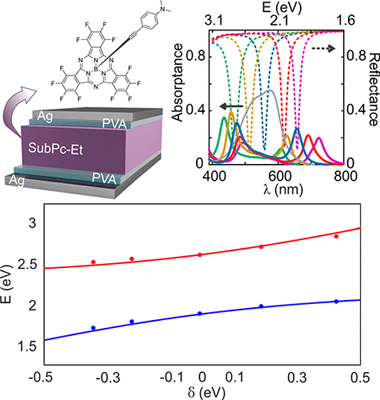
Abstract
The recent development of organic polaritonic solar cells, in which sunlight absorbers and photon modes of a resonator are hybridized as a result of their strong coupling, has revealed the potential this interaction offers to control and enhance the performance of these devices. In this approach, the photovoltaic cell is built in such a way that it also behaves as an optical cavity supporting spectrally well-defined resonances, which match the broad absorption bands of the dyes employed. Herein we focus on the experimental and theoretical analysis of the specific spectral and angular optical absorption characteristics of a broadband light harvester, namely a subphthalocyanine, when operating in the ultrastrong coupling regime. We discuss the implications of having a broad distribution of oscillator strengths and demonstrate that rational design of the layered structure is needed to optimize both the spectral and the angular response of the sunlight harvester dye.
November, 2021 · DOI: 10.1021/acs.jpclett.1c02898
Materiales Coloidales
NaY(MoO4)(2)-based nanoparticles: synthesis, luminescence and photocatalytic properties
Nunez, NO; Gomez-Gonzalez, E; Calderon-Olvera, RM; Becerro, AI; Colon, G; Ocana, MDalton Transactions, 50 (2021) 16539-16547 DOI: 10.1039/d1dt02365a

Abstract
Abstract
We report on a novel synthesis method, which produces NaY(MoO4)(2) nanoparticles having an almost spherical shape and hydrophilic character. The procedure is also suitable for the preparation of NaY(MoO4)(2)-based nanophosphors by doping this host with lanthanide cations (Eu3+, Tb3+ and Dy3+), which, under UV illumination, exhibit intense luminescence whose color is determined by the selected doping cation (red for Eu3+, green for Tb3+ and yellow for Dy3+). The effects of the cations doping level on the luminescent properties are analyzed in terms of emission intensities and luminescent lifetime, to find the optimum phosphors. Finally, the performance of these nanophosphors and that of the undoped system for the photocatalytic degradation of rhodamine B, used as a model compound, is also analyzed.
November, 2021 · DOI: 10.1039/d1dt02365a
Materiales Ópticos Multifuncionales
Nanophotonics for current and future white light-emitting devices
Galisteo-Lopez, JF; Lozano, GJournal of Applied Physics, 130 (2021) 200901 DOI: 10.1063/5.0065825
Abstract
Photonic nanostructures have proven useful to enhance the performance of a wide variety of materials and devices for sensing, catalysis, light harvesting, or light conversion. Herein, we discuss the role of nanophotonics in current and next-generation designs of white light-emitting diodes (LEDs). We discuss recent developments on luminescent materials designed as alternatives to rare earth-doped inorganic microcrystals, i.e., phosphors, for color conversion in LEDs, which has opened the door to the integration of resonant photonic architectures. Nanophotonics enables the devised light-matter interaction with luminescent materials in the nanoscale, which allows providing emitting devices with both enhanced performance and novel functionalities to tackle technological challenges
November, 2021 · DOI: 10.1063/5.0065825
Materiales Coloidales
Si sputtering yield amplification: a study of the collisions cascade and species in the sputtering plasma
Cruz, J; Sangines, S; Soto-Valle; Muhl; Sierra, I; De Lucio-Morales, O; Mitrani, A; Calderon-Olvera, RM; Mendoza-Perez, R; Machorro-Mejia, RJournal of Physics D-Applied Physics, 54 (2021) 375201 DOI: 10.1088/1361-6463/ac0c4e
Abstract
The sputtering yield amplification (SYA) is a phenomenon based on doping a sputtering target with atoms of higher atomic mass. This doping changes the depth and the direction of the collision cascade in the target surface promoting a higher ejection of target atoms. In this work, we present a new way of generating the SYA phenomenon without the need of expensive and complex deposition systems. This was accomplished by increasing the working pressure and adding small pieces of W, as dopant element, on the racetrack of a Si target. The physical phenomena necessary to promote the SYA, for our experimental parameters, were analysed in two different deposition chambers and two sizes of sputtering targets. Based on the collisions in the gas phase, a calculation on the number of W atoms returning to the racetrack area was made, considering the number of atoms deposited on the thin films, to determine their effect on the cascade of collisions. In addition, calculations with the simulation of metal transport code were developed to determine the location on the racetrack zone the returning atoms were redeposited. By using reference samples placed on the racetrack of the Si target, we found that the percentage of SYA depends on the number of dopant atoms redeposited as well as the depth distribution these atoms had in the racetrack surface.
September, 2021 · DOI: 10.1088/1361-6463/ac0c4e
Materiales Ópticos Multifuncionales - Materiales Coloidales
Persistent luminescent nanoparticles: Challenges and opportunities for a shimmering future
Castaing, V.; Arroyo, E.; Becerro, A.I.; Ocaña, M.; Lozano, G.; Míguez, H.Journal of Applied Physics, 130 (2021) 080902 DOI: 10.1063/5.0053283
Abstract
Persistent phosphors are luminescent sources based on crystalline materials doped with rare-earth or transition metal cations able to produce light after the excitation source vanishes. Although known for centuries, these materials gained renewed interest after the discovery of Eu2+,RE3+ co-doped aluminates and silicates in the late 1990s due to their unprecedented afterglow properties. In contrast, persistent nanophosphors have emerged only recently as a nanoscale alternative to their bulk counterparts, offering exciting opportunities of particular relevance for in vivo imaging, optical data storage, or unconventional light generation. However, taking advantage of the avenues opened by nanoscience demands developing new synthetic strategies that allow precise control of the morphology, surface, and defect chemistry of the nanomaterials, along with a profound understanding of the physical mechanisms occurring in the nanoscale. Besides, advanced physicochemical characterization is required to assess persistent luminescence in a quantitative manner, which allows strict comparison among different persistent nanophosphors, aiming to propel their applicability. Herein, we revisit the main phenomena that determine the emission properties of persistent nanoparticles, discuss the most promising preparation and characterization protocols, highlight recent achievements, and elaborate on the challenges ahead.
August, 2021 · DOI: 10.1063/5.0053283
Nanotecnología en Superficies y Plasma - Materiales Ópticos Multifuncionales
One-reactor vacuum and plasma synthesis of transparent conducting oxide nanotubes and nanotrees: from single wire conductivity to ultra-broadband perfect absorbers in the NIR
Castillo-Seoane, J; Gil-Rostra, J; Lopez-Flores, V; Lozano, G; Ferrer, FJ; Espinos, JP; Ostrikov, K; Yubero, F; Gonzalez-Elipe, AR; Barranco, A; Sanchez-Valencia, JR; Borras, ANanoscale, 13 (2021) 13882-13895 DOI: 10.1039/d1nr01937f

Abstract
The eventual exploitation of one-dimensional nanomaterials needs the development of scalable, high yield, homogeneous and environmentally friendly methods capable of meeting the requirements for fabrication of functional nanomaterials with properties on demand. In this article, we demonstrate a vacuum and plasma one-reactor approach for the synthesis of fundamental common elements in solar energy and optoelectronics, i.e. the transparent conducting electrode but in the form of nanotube and nanotree architectures. Although the process is generic and can be used for a variety of TCOs and wide-bandgap semiconductors, we focus herein on indium doped tin oxide (ITO) as the most previously researched in previous applications. This protocol combines widely applied deposition techniques such as thermal evaporation for the formation of organic nanowires serving as 1D and 3D soft templates, deposition of polycrystalline layers by magnetron sputtering, and removal of the templates by simply annealing under mild vacuum conditions. The process variables are tuned to control the stoichiometry, morphology, and alignment of the ITO nanotubes and nanotrees. Four-probe characterization reveals the improved lateral connectivity of the ITO nanotrees and applied on individual nanotubes shows resistivities as low as 3.5 +/- 0.9 x 10(-4) omega cm, a value comparable to that of single-crystalline counterparts. The assessment of diffuse reflectance and transmittance in the UV-Vis range confirms the viability of the supported ITO nanotubes as random optical media working as strong scattering layers. Their further ability to form ITO nanotrees opens a path for practical applications as ultra-broadband absorbers in the NIR. The demonstrated low resistivity and optical properties of these ITO nanostructures open a way for their use in LEDs, IR shields, energy harvesting, nanosensors, and photoelectrochemical applications.
August, 2021 · DOI: 10.1039/d1nr01937f
Materiales Ópticos Multifuncionales
Light-Harvesting Properties of a Subphthalocyanine Solar Absorber Coupled to an Optical Cavity
Esteso, V; Calio, L; Espinos, H; Lavarda, G; Torres, T; Feist, J; Garcia-Vidal, FJ; Bottari, G; Míguez, HSOLAR RRL, (2021) 2100308 DOI: 10.1002/solr.202100308
Abstract
Herein, both from the experimental and theoretical point of view, the optical absorption properties of a subphthalocyanine (SubPc), an organic macrocycle commonly used as a sunlight harvester, coupled to metallic optical cavities are analyzed. How different electronic transitions characteristic of this compound and specifically those that give rise to excitonic (Q band) and charge transfer (CT band) transitions couple to optical cavity modes is investigated. It is observed that whereas the CT band couples weakly to the cavity, the Q band transitions show evidence of hybridization with the photon eigenstates of the resonator, a distinctive trait of the strong coupling regime. As a result of the different coupling regimes of the two electronic transitions, very different spectral and directional light-harvesting features are observed, which for the weakly coupled CT transitions are mainly determined by the highly dispersive cavity modes and for the strongly coupled Q band by the less angle-dependent exciton-polariton bands. Modeling also allows discriminating parasitic from productive absorption in each case, enabling the estimation of the expected losses in a solar cell acting as an optical resonator.
July, 2021 · DOI: 10.1002/solr.202100308
Materiales Ópticos Multifuncionales
Ligand-Free MAPbI(3) Quantum Dot Solar Cells Based on Nanostructured Insulating Matrices
Rubino, A; Calio, L; Calvo, ME; Miguez, HSOLAR RRL (2021) 2100204 DOI: 10.1002/solr.202100204
Abstract
The stability, either chemical or thermal, and performance of colloidal quantum dot (CQD) devices are typically limited by the presence of surface-bonded organic ligands required to stabilize the nanocrystals. In addition, optimization of charge transport implies lengthy ligand exchange processing. Herein, evidence of efficient charge transport through a network of ligand-free perovskite quantum dots (PQDs) embedded in an insulating porous matrix made of monodisperse SiO2 nanoparticles is shown. Methylammonium lead iodide (CH3NH3PbI3 or MAPbI(3)) QDs are prepared in situ by infiltration of precursors within the matrix pores, which act both as nanoreactors for the synthetic reaction and as supporting scaffolds, hence reducing the number of synthetic and postprocessing steps usually required in CQD solar cells. Above a certain nanocrystal load, charge percolation is reached and dot-to-dot transport achieved without compromising quantum confinement effects. Solar cells based on MAPbI(3) QDs prepared in this way present a 9.3% efficiency, the highest reported for a scaffold-supported PQD solar cell, and significantly improved stability under solar illumination with respect to their bulk counterparts. Therefore, adequately designed networks of ligand-free PQDs can be used as both light harvesters and photocarrier conductors, in an alternative configuration to that used in previously developed QD solar cells.
July, 2021 · DOI: 10.1002/solr.202100204
Materiales Ópticos Multifuncionales
The Role of the Atmosphere on the Photophysics of Ligand-Free Lead-Halide Perovskite Nanocrystals
Moran-Pedroso, M; Rubino, A; Calvo, ME; Espinos, JP; Galisteo-Lopez, JF; Miguez, HAdvanced Optical Materials, (2021) 2100605 DOI: 10.1002/adom.202100605
Abstract
Lead halide perovskite (LHP) nanocrystals (NCs) have gained attention over the past decade due to their outstanding optoelectronic properties, making them a suitable material for efficient photovoltaic and light emitting devices. Due to its soft nature, these nanostructures undergo strong structural changes upon irradiation, where these light-induced processes are strongly influenced by the environment. Since most processing routes for LHP NCs are based on colloidal approaches, the role of factors such as stabilizing ligands or solvents is usually hard to disentangle from the interaction of external radiation with the perovskite material. Employing a recently proposed synthetic approach, where ligand-free NCs can be grown within metal-oxide-based insulating nanoporous matrices, it has been feasible to perform a clean study of the effect of the surrounding atmosphere on the photophysical properties of perovskite NCs, avoiding the interference of protective capping layers or solvents. Simultaneous light-induced photo-activation and darkening processes are monitored and disentangled, and their relation with bulk and surface processes, respectively, demonstrated.
June, 2021 · DOI: 10.1002/adom.202100605
Materiales Ópticos Multifuncionales
Self-preserving ice layers on CO2 clathrate particles: Implications for Enceladus, Pluto, and similar ocean worlds
Bostrom, M; Esteso, V; Fiedler, J; Brevik, I; Buhmann, SY; Persson, C; Carretero-Palacios, S; Parsons, DF; Corkey, RWAstronomy & Astrophysics, 650 (2021) A54 DOI: 10.1051/0004-6361/202040181
Abstract
Context. Gas hydrates can be stabilised outside their window of thermodynamic stability by the formation of an ice layer - a phenomenon termed self-preservation. This can lead to a positive buoyancy for clathrate particles containing CO2 that would otherwise sink in the oceans of Enceladus, Pluto, and similar oceanic worlds.Aims. Here we investigate the implications of Lifshitz forces and low occupancy surface regions on type I clathrate structures for their self-preservation through ice layer formation, presenting a plausible model based on multi-layer interactions through dispersion forces.Methods. We used optical data and theoretical models for the dielectric response for water, ice, and gas hydrates with a different occupancy. Taking this together with the thermodynamic Lifshitz free energy, we modelled the energy minima essential for the formation of ice layers at the interface between gas hydrate and liquid water.Results. We predict the growth of an ice layer between 0.01 and 0.2 mu m thick on CO, CH4, and CO2 hydrate surfaces, depending on the presence of surface regions depleted in gas molecules. Effective hydrate particle density is estimated, delimiting a range of particle size and compositions that would be buoyant in different oceans. Over geological time, the deposition of floating hydrate particles could result in the accumulation of kilometre-thick gas hydrate layers above liquid water reservoirs and below the water ice crusts of their respective ocean worlds. On Enceladus, the destabilisation of near-surface hydrate deposits could lead to increased gas pressures that both drive plumes and entrain stabilised hydrate particles. Furthermore, on ocean worlds, such as Enceladus and particularly Pluto, the accumulation of thick CO2 or mixed gas hydrate deposits could insulate its ocean against freezing. In preventing freezing of liquid water reservoirs in ocean worlds, the presence of CO2-containing hydrate layers could enhance the habitability of ocean worlds in our Solar System and on the exoplanets and exomoons beyond.
June, 2021 · DOI: 10.1051/0004-6361/202040181
Materiales Ópticos Multifuncionales - Materiales Coloidales
Highly Versatile Upconverting Oxyfluoride-Based Nanophosphor Films
Ngo, TT; Cabello-Olmo, E; Arroyo, E; Becerro, AI; Ocana, M; Lozano, G; Miguez, HACS Applied Materials & Interfaces, 13 (2021) 30051-30060 DOI: 10.1021/acsami.1c07012

Abstract
Fluoride-based compounds doped with rare-earth cations are the preferred choice of materials to achieve efficient upconversion, of interest for a plethora of applications ranging from bioimaging to energy harvesting. Herein, we demonstrate a simple route to fabricate bright upconverting films that are transparent, self-standing, flexible, and emit different colors. Starting from the solvothermal synthesis of uniform and colloidally stable yttrium fluoride nanoparticles doped with Yb3+ and Er3+, Ho3+, or Tm3+, we find the experimental conditions to process the nanophosphors as optical quality films of controlled thickness between few hundreds of nanometers and several micrometers. A thorough analysis of both structural and photophysical properties of films annealed at different temperatures reveals a tradeoff between the oxidation of the matrix, which transitions through an oxyfluoride crystal phase, and the efficiency of the upconversion photoluminescence process. It represents a significant step forward in the understanding of the fundamental properties of upconverting materials and can be leveraged for the optimization of upconversion systems in general. We prove bright multicolor upconversion photoluminescence in oxyfluoride-based phosphor transparent films upon excitation with a 980 nm laser for both rigid and flexible versions of the layers, being possible to use the latter to coat surfaces of arbitrary shape. Our results pave the way toward the development of upconverting coatings that can be conveniently integrated in applications that demand a large degree of versatility.
June, 2021 · DOI: 10.1021/acsami.1c07012
Tribología y Protección de Superficies - Materiales Ópticos Multifuncionales
High-temperature solar-selective coatings based on Cr(Al)N. Part 1: Microstructure and optical properties of CrNy and Cr1-xAlxNy films prepared by DC/HiPIMS
Rojas, TC; Caro, A; Lozano, G.; Sanchez-Lopez, JCSolar Energy Materials and Solar Cells, 223 (2021) 110951 DOI: 10.1016/j.solmat.2020.110951
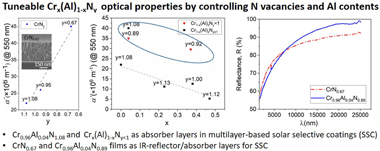
Abstract
In order to explore the potentialities of Cr1-x(Al)xNy materials in multilayer-based solar selective coatings (SSC) for high temperature applications (T > 500 °C), the optical behavior of Cr1-x(Al)xNy films is studied in this work. Two sets of layers (CrNy and Cr1-xAlxNy) were prepared by direct current (DC) and high-power impulse magnetron sputtering (HiPIMS) technology. The deposition parameters: N2 flux, HiPIMS frequency and aluminum sputtering power, were modified to get a wide variety of stoichiometries. The composition, morphology, phases and electronic structure of the films were characterized in depth. The optical behavior was determined by UV–Vis–NIR and FTIR spectroscopies, and the optical constants were obtained from the measured transmittance and reflectance spectra based on appropriate dielectric function models. Our results indicate that small changes in the layer composition influence the optical constants. In particular, a metallic-like behavior was obtained for CrNy layers with N vacancies (CrN0.95 and CrN0.67 films) while a semiconductor-like behavior was observed for CrN1.08. Thus, the CrNy films can be used as effective absorber layer in multilayer-based SSC, and namely, the CrN0.67 film as an IR reflector/absorber layer too. Likewise, the optical properties of Cr1-xAlxNy layers can also be tuned from metallic to semiconductor-like behavior depending on the chemical composition. Indeed, the absorption coefficients of Cr1-xAlxNy films with optimized Al content and N-vacancies are comparable to those reported for state-of-the-art materials such as TiAlN or TiAlCrN. In addition, a Cr0.96Al0.04N0.89 film was found to be a suitable IR reflector/absorber layer.
May, 2021 · DOI: 10.1016/j.solmat.2020.110951
Materiales Ópticos Multifuncionales
Toward Commercialization of Stable Devices: An Overview on Encapsulation of Hybrid Organic-Inorganic Perovskite Solar Cells
Aranda, Clara A.; Calio, Laura; Salado, ManuelCrystals, 11 (2021) 519 DOI: 10.3390/cryst11050519
Abstract
Perovskite solar cells (PSCs) represent a promising technology for energy harvesting due to high power conversion efficiencies up to 26%, easy manufacturing, and convenient deposition techniques, leading to added advantages over other contemporary competitors. In order to promote this technology toward commercialization though, stability issues need to be addressed. Lately, many researchers have explored several techniques to improve the stability of the environmentally-sensitive perovskite solar devices. Challenges posed by environmental factors like moisture, oxygen, temperature, and UV-light exposure, could be overcome by device encapsulation. This review focuses the attention on the different materials, methods, and requirements for suitable encapsulated perovskite solar cells. A depth analysis on the current stability tests is also included, since accurate and reliable testing conditions are needed in order to reduce mismatching involved in reporting the efficiencies of PSC.
May, 2021 · DOI: 10.3390/cryst11050519
Materiales Coloidales
Holmium phosphate nanoparticles as negative contrast agents for high-field magnetic resonance imaging: Synthesis, magnetic relaxivity study and in vivo evaluation
Gomez-Gonzalez, E; Caro, C; Martinez-Gutierrez, D; Garcia-Martin, ML; Ocana, M; Becerro, AIJournal of Colloid and Interface Science, 587 (2021) 131-140 DOI: 10.1016/j.jcis.2020.11.119
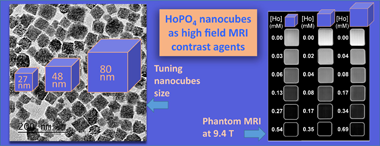
Abstract
The increasing use of high magnetic fields in magnetic resonance imaging (MRI) scanners demands new contrast agents, since those used in low field instruments are not effective at high fields. In this paper, we report the synthesis of a negative MRI contrast agent consisting of HoPO4 nanoparticles (NPs). Three different sizes (27 nm, 48 nm and 80 nm) of cube-shaped NPs were obtained by homogeneous precipitation in polyol medium and then coated with poly(acrylic) acid (PAA) to obtain stable colloidal suspensions of HoPO4@PAA NPs in physiological medium (PBS). The transverse relaxivity (r2) of aqueous suspensions of the resulting NPs was evaluated at both 1.44 T and 9.4 T. A positive correlation between r2 values and field strength as well as between r2 values and particle size at both magnetic field strengths was found although this correlation failed for the biggest NPs at 9.4 T, likely due to certain particles aggregation inside the magnet. The highest r2 value (489.91 mM-1s−1) was found for the 48 nm NPs at 9.4 T. Toxicity studies demonstrated that the latter NPs exhibited low toxicity to living systems. Finally, in vivo studies demonstrated that HoPO4@PAA NPs could be a great platform for next-generation T2-weighted MRI contrast agents at high magnetic field.
April, 2021 · DOI: 10.1016/j.jcis.2020.11.119
Materiales Ópticos Multifuncionales - Materiales Coloidales
Persistent luminescence of transparent ZnGa2O4:Cr3+ thin films from colloidal nanoparticles of tunable size
Arroyo, E; Medran, B; Castaing, V; Lozano, G; Ocana, M; Becerro, AIJournal of Materials Chemistry C, 9 (2021) 4474-4485 DOI: 10.1039/d1tc00258a
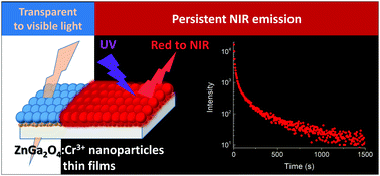
Abstract
We report on the fabrication of ZnGa2O4:Cr3+ transparent thin films and the evaluation, for the first time in the literature, of their persistent red to NIR emission. For this purpose, we have used a simple and economic global strategy based on wet processing methods from colloidal nanospheres with uniform size. A microwave-assisted hydrothermal method was first developed for the synthesis of precursor particles, which allows size tuning from 300 nm to 30 nm through simple modification of the Zn2+ precursor and the Cr3+ content of the starting solutions. ZnGa2O4:Cr3+ transparent thin films over quartz substrates were then easily fabricated by spin coating, and their structural and optical characteristics were analyzed in detail after annealing at high temperature to elucidate the effect of processing temperature and particle size on the properties of the films. Indeed, our results indicate that high temperature annealing does not compromise the transparency of the films but improves their photoluminescence. In addition, the analysis reveals that persistence luminescence in our films is rather independent of the size of the precursor nanoparticles. Due to their transparency and persistent emission properties, films fabricated from colloidal suspensions of ZnGa2O4:Cr3+ nanoparticles show great potential for application in the fields of chemical sensing, information storage, labelling, and anti-counterfeiting technology.
March, 2021 · DOI: 10.1039/d1tc00258a
Materiales Ópticos Multifuncionales
The Complex Interplay of Lead Halide Perovskites with Their Surroundings
Galisteo-Lopez, JF; Calvo, ME; Miguez, HAdvanced Optical Materials, (2021) 2100133 DOI: 10.1002/adom.202100133
Abstract
Photoexcitation of lead halide perovskites induces a restructuration of the material that simultaneously enhances its emission properties and triggers its degradation. These concomitant processes are strongly dependent on the surroundings of the perovskite, both while and after being processed, underlining the relevance the environment and the interfacial design have in the stability and performance of these materials and the devices based on them. This shocking observation reveals that when subjected to external illumination, lead halide perovskites undergo a number of photophysical processes that strongly modify their structure and thus their optoelectronic properties. Such photoinduced instability stems from a defective structure directly linked to the low-temperature and solution-processed fabrication routes generally employed to build perovskite solar cells with efficiencies comparable to state-of-the-art values. On the other hand, these same inexpensive and unsophisticated procedures make this material a promising component in energy conversion devices. Here, an analysis is provided regarding the different impact on the perovskite structure, hence on its optoelectronic performance, that the interaction with its surroundings has, providing specific examples that highlight this interplay, describing the kind of modification it induces, and listing the related effects on the optoelectronic properties that should be accounted for when characterizing them.
March, 2021 · DOI: 10.1002/adom.202100133
Materiales Ópticos Multifuncionales
Impact of Tb4+ and morphology on the thermal evolution of Tb-doped TiO2 nanostructured hollow spheres and nanoparticles
Colomer, MT; Rodriguez, E; Moran-Pedroso, M; Vattier, F; de Andres, AJournal of Alloys and Compounds, 853 (2021) 156973 DOI: 10.1016/j.jallcom.2020.156973
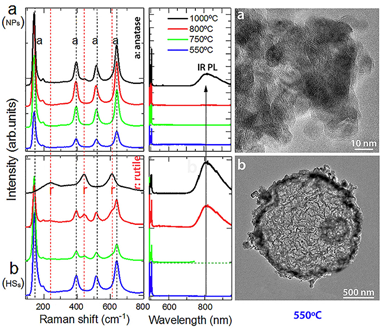
Abstract
Tb-doped TiO2 hollow spheres (HSs) in the range 0.0-2.0 at.% have been synthesized by the first time to the best of our knowledge. The HSs are compared with nanoparticles (NPs) to evaluate the impact of morphology on their physicochemical and photoluminescence (PL) behavior upon increasing calcination temperature. After calcination at 550 degrees C, the particles are anatase with a primary average size of 10.0 +/- 0.2 nm for the NPs and 12.0 +/- 0.2 nm for those that form the micron sized hollow spheres of 1.8 +/- 0.2 mu m diameter and ca. 64 nm shell thickness. The temperature of the anataseerutile transition is found to be strongly dependent on the presence of Tb as well as on morphology. Contrarily to the usual stabilization of anatase when doping with trivalent rare-earth ions, the transition temperature is reduced when doping with Tb. The rutile phase is further favored for the HSs compared to the NPs probably related to the low density of the HSs and/or a more efficient packing density and/or a bigger crystal size of the nanoparticles that form those spheres with respect to the packing and the size of the NPs and/or the crystal size of the nanoparticles of the HSs with respect to the size of the NPs. Only a slight unit-cell volume increase for the anatase structure is observed upon Tb doping, in both the NPs and in the HSs, contrary to the expected increment due to the larger ionic radius of Tb3+ compared to Ti4+. In addition, the intensity of the characteristic f-f Tb3+ emission bands is extremely weak both in the anatase and rutile phases. The transition is accompanied with the emergence of an infrared emission band centered at 810 nm related to the formation of defects during the structural transformation providing deep levels in the gap that partly quench the f-f emissions in the rutile phase. The results are consistent with the presence of Tb in both +3 and +4 valence states. XPS measurements confirmed the presence of Tb3+ as well as of Tb4+ in both HSs and NPs. The large fraction of Tb4+ present in the samples originates the weak f-f emission intensity, an only slight increase of the cell parameters and the destabilization of the anatase phase.
February, 2021 · DOI: 10.1016/j.jallcom.2020.156973
Materiales Ópticos Multifuncionales
Enhanced Directional Light Extraction from Patterned Rare-Earth Phosphor Films
Cabello-Olmo, E; Molet, P; Mihi, A; Lozano, G; Miguez, HAdvanced Optical Materials, 9 (2021) 2001611 DOI: 10.1002/adom.202001611
Abstract
The combination of light‐emitting diodes (LEDs) and rare earth (RE) phosphors as color‐converting layers comprises the basis of solid‐state lighting. Indeed, most LED lamps include a photoluminescent coating made of phosphor material, i.e., crystalline matrix suitably doped with RE elements, to produce white light from a blue or ultraviolet LED chip. Transparent phosphor‐based films constitute starting materials for new refined emitters that allow different photonic designs to be implemented. Among the different photonic strategies typically employed to tune or enhance emission, surface texturing has proved its versatility and feasibility in a wide range of materials and devices. However, most of the nanofabrication techniques cannot be applied to RE phosphors directly because of their chemical stability or because of their cost. The first monolithic patterned structure of down‐shifting nanophosphors with square arrays of nanoholes with different lattice parameters is reported in this study. It is shown that a low‐cost soft‐nanolithography procedure can be applied to red‐emitting nanophosphors (GdVO4:Eu3+ nanocrystals) to tune their emission properties, attaining a twofold directional enhancement of the emitted light at predesigned emission wavelengths in specific directions.
January, 2021 · DOI: 10.1002/adom.202001611
Materiales Ópticos Multifuncionales
Disentangling Electron–Phonon Coupling and Thermal Expansion Effects in the Band Gap Renormalization of Perovskite Nanocrystals
Rubino, A; Francisco-Lóprez, A.; Baker, A.J., Petrozza, A.; Calvo, M.E.; Goñi, A.R.; Míguez, H.Journal of Physical Chemistry Letters, 12 (2021) 569-575 DOI: 10.1021/acs.jpclett.0c03042

Abstract
The complex electron–phonon interaction occurring in bulk lead halide perovskites gives rise to anomalous temperature dependences, like the widening of the electronic band gap as temperature increases. However, possible confinement effects on the electron–phonon coupling in the nanocrystalline version of these materials remain unexplored. Herein, we study the temperature (ranging from 80 K to ambient) and hydrostatic pressure (from atmospheric to 0.6 GPa) dependence of the photoluminescence of ligand-free methylammonium lead triiodide nanocrystals with controlled sizes embedded in a porous silica matrix. This analysis allowed us to disentangle the effects of thermal expansion and electron–phonon interaction. As the crystallite size decreases, the electron–phonon contribution to the gap renormalization gains in importance. We provide a plausible explanation for this observation in terms of quantum confinement effects, showing that neither thermal expansion nor electron–phonon coupling effects may be disregarded when analyzing the temperature dependence of the optoelectronic properties of perovskite lead halide nanocrystals.
January, 2021 · DOI: 10.1021/acs.jpclett.0c03042
Materiales Coloidales
Dysprosium and Holmium Vanadate Nanoprobes as High-Performance Contrast Agents for High-Field Magnetic Resonance and Computed Tomography Imaging
Gomez-Gonzalez, E; Nunez, NO; Caro, C; Garcia-Martin, ML; Fernandez-Afonso, Y; de la Fuente, JM; Balcerzyk, M; Ocana, MInorganic Chemistry, 60 (2021) 152-160 DOI: 10.1021/acs.inorgchem.0c02601

Abstract
We describe a wet chemical method for the synthesis of uniform and well-dispersed dysprosium vanadate (DyVO4) and holmium vanadate (HoVO4) nanoparticles with an almost spherical shape and a mean size of ∼60 nm and their functionalization with poly(acrylic acid). The transverse magnetic relaxivity of both systems at 9.4 T is analyzed on the basis of magnetic susceptibility and magnetization measurements in order to evaluate their potential for application as high-field MRI contrast agents. In addition, the X-ray attenuation properties of these systems are also studied to determine their capabilities as computed tomography contrast agent. Finally, the colloidal stability under physiological pH conditions and the cytotoxicity of the functionalized NPs are also addressed to assess their suitability for bioimaging applications.
January, 2021 · DOI: 10.1021/acs.inorgchem.0c02601
2020
2020
Materiales Ópticos Multifuncionales
Efficient third harmonic generation from FAPbBr(3) perovskite nanocrystals
Rubino, A; Huq, T; Dranczewski, J; Lozano, G; Calvo, ME; Vezzoli, S; Miguez, H; Sapienza, RJournal of Materials Chemistry C, 8 (2020) 15990-15995 DOI: 10.1039/d0tc04790b
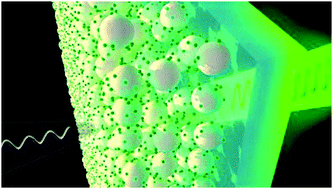
Abstract
The development of versatile nanostructured materials with enhanced nonlinear optical properties is relevant for integrated and energy efficient photonics. In this work, we report third harmonic generation from organic lead halide perovskite nanocrystals, and more specifically from formamidinium lead bromide nanocrystals, ncFAPbBr(3), dispersed in an optically transparent silica film. Efficient third order conversion is attained for excitation in a wide spectral range in the near infrared (1425 nm to 1650 nm). The maximum absolute value of the modulus of the third order nonlinear susceptibility of ncFAPbBr(3), chi((3)NC), is derived from modelling both the linear and nonlinear behaviour of the film and is found to be chi((3)NC) = 1.46 x 10(-19) m(2) V-2 (or 1.04 x 10(-11) esu) at 1560 nm excitation wavelength, which is of the same order as the highest previously reported for purely inorganic lead halide perovskite nanocrystals (3.78 x 10(-11) esu for ncCsPbBr(3)). Comparison with the experimentally determined optical constants demonstrates that maximum nonlinear conversion is attained at the excitonic resonance of the perovskite nanocrystals where the electron density of states is largest. The ease of synthesis, the robustness and the stability provided by the matrix make this material platform attractive for integrated nonlinear devices.
December, 2020 · DOI: 10.1039/d0tc04790b
Materiales Ópticos Multifuncionales
Internal quantum efficiency and time signals from intensity-modulated photocurrent spectra of perovskite solar cells
Riquelme, A; Galvez, FE; Contreras-Bernal, L; Miguez, H; Anta, JAJournal of Applied Physics, 128 (2020) 133103 DOI: 10.1063/5.0013317
Abstract
Intensity Modulated Photocurrent Spectroscopy (IMPS) is a small-perturbation optoelectronic technique that measures the quantum efficiency of a photoelectrochemical device as a function of optical excitation frequency. Metal Halide Perovskites (MHPs) are mixed electronic-ionic semiconductors with an extraordinary complex optoelectronic behavior and a record efficiency surpassing 25%. In this paper, we propose a simplified procedure to analyze IMPS data in MHPs based on the analysis of the internal quantum efficiency and the time signals featuring in the frequency spectra. In this procedure, we look at the change of each signal when optical excitation wavelength, photon flux, and temperature are varied for an archetypical methyl ammonium lead iodide solar cell. We use drift-diffusion modeling and comparison with relatively simpler dye-sensitized solar cells (DSC) with viscous and non-viscous electrolytes to help us to understand the origin of the three signals appearing in MHP cells and the measurement of the internal quantum efficiency.
October, 2020 · DOI: 10.1063/5.0013317
Materiales Coloidales
Design of a nanoprobe for high field magnetic resonance imaging, dual energy X-ray computed tomography and luminescent imaging
Gonzalez-Mancebo, D; Becerro, AI; Corral, A; Garcia-Embid, S; Balcerzyk, M; Garcia-Martin, ML; de la Fuente, JM; Ocana, MJournal of Colloid and Interface Science, 573 (2020) 278-286 DOI: 10.1016/j.jcis.2020.03.101
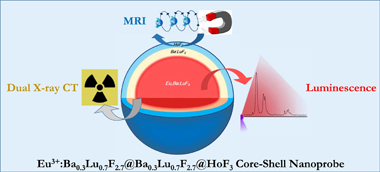
Abstract
The combination of different bioimaging techniques, mainly in the field of oncology, allows circumventing the defects associated with the individual imaging modalities, thus providing a more reliable diagnosis. The development of multimodal endogenous probes that are simultaneously suitable for various imaging modalities, such as magnetic resonance imaging (MRI), X-ray computed tomography (CT) and luminescent imaging (LI) is, therefore, highly recommended. Such probes should operate in the conditions imposed by the newest imaging equipment, such as MRI operating at high magnetic fields and dual-energy CT. They should show, as well, high photoluminescence emission intensity for their use in optical imaging and present good biocompatibility. In this context, we have designed a single nanoprobe, based on a core-shell architecture, composed of a luminescent Eu3+:Ba0.3Lu0.7F2.7 core surrounded by an external HoF3 shell that confers the probe with very high magnetic transverse relaxivity at high field. An intermediate, optically inert Ba0.3Lu0.7F2.7 layer was interposed between the core and the shell to hinder Eu3+-Ho3+ cross-relaxation and avoid luminescence quenching. The presence of Ba and Lu, with different K-edges, allows for good X-ray attenuation at high and low voltages. The core-shell nanoparticles synthesized are good potential candidates as trimodal bioprobes for MRI at high field, dual-energy CT and luminescent imaging.
August, 2020 · DOI: 10.1016/j.jcis.2020.03.101
Materiales Ópticos Multifuncionales
Local Rearrangement of the Iodide Defect Structure Determines the Phase Segregation Effect in Mixed-Halide Perovskites
Tiede, DO; Calvo, ME; Galisteo-Lopez, JF; Miguez, HJournal of Physical Chemistry Letters, 11 (2020) 4911-4916 DOI: 10.1021/acs.jpclett.0c01127
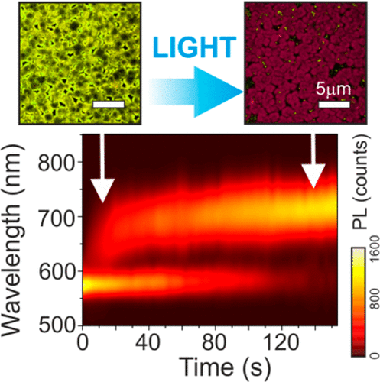
Abstract
Mixed-halide perovskites represent a particularly relevant case within the family of lead-halide perovskites. Beyond their technological relevance for a variety of optoelectronic devices, photoinduced structural changes characteristic of this type of material lead to extreme photophysical changes that are currently the subject of intense debate. Herein we show that the conspicuous photoinduced phase segregation characteristic of these materials is primarily the result of the local and metastable rearrangement of the iodide sublattice. A local photophysical study comprising spectrally resolved laser scanning confocal microscopy is employed to find a correlation between the defect density and the dynamics of photoinduced changes, which extend far from the illuminated region. We observe that iodide-rich regions evolve much faster from highly defective regions. Also, by altering the material composition, we find evidence for the interplay between the iodide-related defect distribution and the intra- and interdomain migration dynamics giving rise to the complexity of this process.
June, 2020 · DOI: 10.1021/acs.jpclett.0c01127
Materiales Ópticos Multifuncionales
Dibenzo-tetraphenyl diindeno perylene as hole transport layer for high-bandgap perovskite solar cells
Pegu, M; Caliò, L; Ahmadpour, M; Rubahn, HG; Kazim, S; Madsen, M; Ahmad, SEmergent Materials, 3 (2020) 109-116 DOI: 10.1007/s42247-020-00098-x
Abstract
Semi-transparent perovskite solar cells have the competitive edge of being employed for building integrated photovoltaics due to their esthetic benefits as light harvesting windows/facades. Perovskites have received considerable attention in recent years as a thin film photovoltaic alternative, that can also be tweaked for its transparency, evolving from potentially high bandgaps that are suited for semi-transparent solar cell fabrication. Due to the existing trade of between the efficiency and transparency of a perovskite solar cell, tuning the band gap can address this by making a bridge between the aforementioned parameters. We report our findings on the use of a wide-bandgap perovskite MAPbBr3, with a rational energetic level hole transport materials based on polycyclic aromatic hydrocarbon molecules that can be a promising alternative class of p-type material. In the present work, DBP (Dibenzo{[f,f′]-4,4′,7,7′-tetraphenyl}diindeno[1,2,3-cd :1′,2′,3′-lm]perylene was evaluated with high bandgap as well as with mixed (FAPbI3)0.85(MAPbBr3)0.15 perovskites for the fabrication of solar cell. DBP-based solar cells yielded competitive power conversion efficiencies as compared with classical HTMs.
May, 2020 · DOI: 10.1007/s42247-020-00098-x
Materiales Ópticos Multifuncionales
Premelting of ice adsorbed on a rock surface
Esteso, V; Palacios, SC; MacDowell, LG; Fiedler, J; Parsons, DF; Spallek, F; Miguez, H; Persson, C; Buhmann, SY; Brevik, I; Bostrom, MPhysical Chemistry Chemical Physics, 22 (2020) 11362-11373 DOI: 10.1039/c9cp06836h
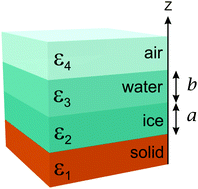
Abstract
Considering ice-premelting on a quartz rock surface (i.e. silica) we calculate the Lifshitz excess pressures in a four layer system with rock-ice-water-air. Our calculations give excess pressures across (1) ice layer, (2) water layer, and (3) ice-water interface for different ice and water layer thicknesses. We analyse equilibrium conditions where the different excess pressures take zero value, stabilized in part by repulsive Lifshitz interactions. In contrast to previous investigations which considered varying thickness of only one layer (ice or water), here we present theory allowing for simultaneous variation of both layer thicknesses. For a given total thickness of ice and water, this allows multiple alternative equilibrium solutions. Consequently the final state of a system will depend on initial conditions and may explain variation in experimental measurements of the thicknesses of water and ice layers.
May, 2020 · DOI: 10.1039/c9cp06836h
Materiales Ópticos Multifuncionales
Monitoring, Modeling, and Optimization of Lead Halide Perovskite Nanocrystal Growth within Porous Matrices
Tiede, DO; Rubino, A; Calvo, ME; Galisteo-Lopez, JF; Miguez, HJournal of Physical Chemistry C, 124 (2020) 8041-8046 DOI: 10.1021/acs.jpcc.0c01750
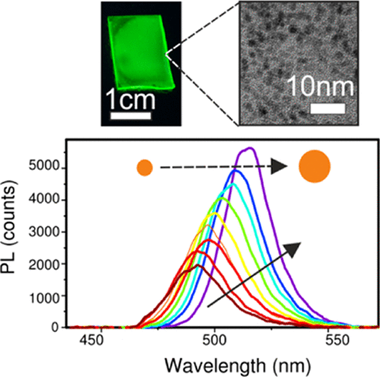
Abstract
The growth of lead halide perovskites within metal-oxide nanoporous films has been recently considered as a means to obtain chemically and photostable ligand-free high-quality nanocrystals (NCs). The growth process, governed by the reactions taking place in nanoreactors dictated by the matrix pore size, has not been explored so far. In this work, we use photoluminescence as a tool to monitor the growth of perovskite NCs within the void network of an optically transparent matrix. We consider the effect of different external factors, such as temperature, light illumination, or precursor concentration, on the growth dynamics, and discuss a possible formation mechanism of the confined perovskite NCs. Based on this analysis, guidelines that could serve to improve the fabrication and optoelectronic quality of this type of NCs are also proposed.
April, 2020 · DOI: 10.1021/acs.jpcc.0c01750
Materiales Ópticos Multifuncionales
Localized surface plasmon effects on the photophysics of perovskite thin films embedding metal nanoparticles
Bayles, A; Carretero-Palacios, S; Calio, L; Lozano, G; Calvo, ME; Miguez, HJournal of Materials Chemistry C, 8 (2020) 916-921 DOI: 10.1039/c9tc05785d

Abstract
Herein we provide direct experimental evidence that proves that the photophysical properties of thin methylammonium lead iodide perovskite films are significantly enhanced by localized surface plasmon resonances (SPRs). Observations are well supported by rigorous calculations that prove that improved light harvesting can be unequivocally attributed to plasmonic scattering and near field reinforcement effects around silver nanoparticles embedded within the semiconductor layer. Adequate design of the localized SPR allows raising the absorptance of a 300 nm thick film at well-defined spectral regions while minimizing the parasitic absorption from the metallic inclusions. Measured enhancements can be as large as 80% at specific wavelengths and 20% when integrated over the whole range at which SPR occurs, in agreement with theoretical estimations. Simultaneously, the characteristic quenching effect that the vicinity of metals has on the photoluminescence of semiconductors is largely compensated for by the combined effect of the enhanced photoexcitation and the higher local density of photon states occurring at SPR frequencies, with a two fold increase of the perovskite photoemission efficiency being measured.
March, 2020 · DOI: 10.1039/c9tc05785d
Materiales Ópticos Multifuncionales
Optical interference effects on the Casimir-Lifshitz force in multilayer structures
Esteso, V; Carretero-Palacios, S; Miguez, HPhysical Review A, 101 (2020) 033815 DOI: 10.1103/PhysRevA.101.033815
Abstract
The Casimir-Lifshitz force F(C-L) between planar objects when one of them is stratified at the nanoscale is herein investigated. Layering results in optical interference effects that give rise to a modification of the optical losses, which, as stated by the fluctuation-dissipation theorem, should affect the Casimir-Lifshitz interaction. On these grounds, we demonstrate that, by nanostructuring the same volume of dielectric materials in diverse multilayer configurations, it is possible to access F(C-L) of attractive or repulsive nature, even getting canceled, at specific separation distances.
March, 2020 · DOI: 10.1103/PhysRevA.101.033815
Materiales Ópticos Multifuncionales
Optical Responses of Localized and Extended Modes in a Mesoporous Layer on Plasmonic Array to Isopropanol Vapor
Murai, S; Cabello-Olmo, E; Kamakura, R; Calvo, ME; Lozano, G; Atsumi, T; Miguez, H; Tanaka, KJournal of Physical Chemistry C, 124 (2020) 5772-5779 DOI: 10.1021/acs.jpcc.9b10999
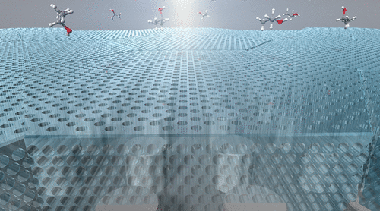
Abstract
Mesoporous silica features open and accessible pores that can intake substances from the outside. The combination of mesoporous silica with plasmonic nanostructures represents an interesting platform for an optical sensor based on the dependence of plasmonic modes on the refractive index of the medium in which metallic nanoparticles are embedded. However, so far only a limited number of plasmonic nanostructures are combined with mesoporous silica, including random dispersion of metallic nanoparticles and flat metallic thin films. In this study, we make a mesoporous silica layer on an aluminum nanocylinder array. Such plasmonic arrangements support both localized surface plasmon resonances (LSPRs) and extended modes which are the result of the hybridization of LSPRs and photonic modes extending into the mesoporous layer. We investigate in situ optical reflectance of this system under controlled pressure of isopropanol vapor. Upon exposure, the capillary condensation in the mesopores results in a gradual spectral shift of the reflectance. Our analysis demonstrates that such shifts depend largely on the nature of the modes; that is, the extended modes show larger shifts compared to localized ones. Our materials represent a useful platform for the field of environmental sensing.
March, 2020 · DOI: 10.1021/acs.jpcc.9b10999
Materiales Ópticos Multifuncionales
Mesoporous Matrices as Hosts for Metal Halide Perovskite Nanocrystals
Rubino, A; Calio, L; Garcia-Bennett, A; Calvo, ME; Miguez, HAdvanced Optical Materials, (2020) 201901868 DOI: 10.1002/adom.201901868
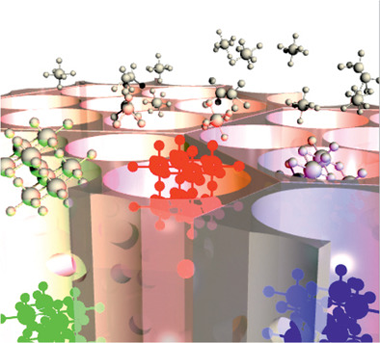
Abstract
Several works have recently demonstrated that perovskite nanocrystals can be controllably formed within a variety of porous matrices employing diverse synthetic strategies. By means of the fine tuning of the pore size distribution, the thickness and composition of the walls, the geometry of the void network and its topology, strict control over the structural and morphological parameters of the hosted semiconductor can be achieved, determining its optical absorption and emission properties. Furthermore, porous hosts provide the guest semiconductor with enhanced stability and versatility in terms of processing, which favors its integration in devices. This article provides a comprehensive review of the different approaches proposed, as well as a discussion on the relevance they may have for the development of nanostructured perovskite-based optoelectronics. A critical assessment of the optical quality of the hybrid perovskite nanomaterials so obtained is presented, as well as an analysis of the fundamental and applied aspects of the nanocrystal-matrix interaction and a projected prospect of their impact in the fields of artificial lighting and renewable energy.
February, 2020 · DOI: 10.1002/adom.201901868
Materiales Ópticos Multifuncionales
Dipole reorientation and local density of optical states influence the emission of light-emitting electrochemical cells
Jimenez-Solano, Alberto; Martinez-Sarti, Laura; Pertegas, Antonio; Lozano, Gabriel; Bolink, Henk J; Miguez, HernanPhysical Chemistry Chemical Physics, 22 (2020) 92-96 DOI: 10.1039/c9cp05505c

Abstract
Herein, we analyze the temporal evolution of the electroluminescence of light-emitting electrochemical cells (LECs), a thin-film light-emitting device, in order to maximize the luminous power radiated by these devices. A careful analysis of the spectral and angular distribution of the emission of LECs fabricated under the same experimental conditions allows describing the dynamics of the spatial region from which LECs emit, i.e. the generation zone, as bias is applied. This effect is mediated by dipole reorientation within such an emissive region and its optical environment, since its spatial drift yields a different interplay between the intrinsic emission of the emitters and the local density of optical states of the system. Our results demonstrate that engineering the optical environment in thin-film light-emitting devices is key to maximize their brightness.
January, 2020 · DOI: 10.1039/c9cp05505c
Materiales Coloidales
Bimodal Nd-Doped LuVO4 Nanoprobes Functionalized with Polyacrilic Acid for X-Ray Computed Tomography and NIR Luminescent Imaging
Nuñez, NO; Cusso, F; Cantelar, E; Martin-Gracia, B; de la Fuente, JM; Corral, A; Balcerzyk, M; Ocaña, MNanomaterials, 10 (2020) 149 DOI: 10.3390/nano10010149
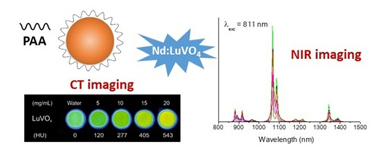
Abstract
Uniform Nd3+-doped LuVO4 nanophosphors have been synthesized for the first time in literature by using a poliol-based method at 120 degrees C from Nd3+ and vanadate precursors. After optimizing the Nd doping level, these phosphors present intense luminescence in the near-infrared biological windows. The X-ray attenuation capacity of the optimum nanophosphor has been found to be higher than that of a commercial X-ray computed tomography contrast agent. After surface coating with polyacrylic acid, such nanoparticles present high colloidal stability in physiological pH medium and high cell viability. Because of these properties, the developed Nd3+-doped LuVO4 nanoparticles have potential applications as a bimodal probe for NIR luminescent bioimaging and X-ray computed tomography.
January, 2020 · DOI: 10.3390/nano10010149
Materiales Ópticos Multifuncionales
Finite Size Effects on Light Propagation throughout Random Media: Relation between Optical Properties and Scattering Event Statistics
Miranda-Munoz, JM; Esteso, V; Jimenez-Solano, A; Lozano, G; Miguez, HAdvanced Optical Materials, 8 (2020) 1901196 DOI: 10.1002/adom.201901196

Abstract
This work introduces a thorough analysis of light transport in thin optically disordered media. The diffusive properties of a turbid material are generally dictated by the transport mean free path, lt. For depths larger than this characteristic length, light propagation can be considered fully randomized. There is however a range of thicknesses for which light becomes only partly randomized, as it only undergoes a single or very few scattering events. The effects of such finitude are experimentally and theoretically studied on the optical properties of the material, such as the angular distribution of scattered light. Simulations provide insight into the phenomena that occur within the optically disordered slab, like the number of scattering events that photons undergo during propagation throughout the material, as a function of the built‐in wavelength dependent scattering mean free path, lsc. This approach provides fundamental information about photon transport in finite optically random media, which can be put into practice to design diffusers with specific requirements in terms of the spectral and angular properties of the scattered light.
January, 2020 · DOI: 10.1002/adom.201901196
2019
2019
Materiales Coloidales
Encapsulation of Upconversion Nanoparticles in Periodic Mesoporous Organosilicas
Rahmani, S; Jimenez, CM; Aggad, D; Gonzalez-Mancebo, D; Ocana, M; Ali, LMA; Nguyen, C; Nieto, AIB; Francolon, N; Oliveiro, E; Boyer, D; Mahiou, R; Raehm, L; Gary-Bobo, M; Durand, JO; Charnay, CMolecules, 24 (2019) 22 DOI: 10.3390/molecules24224054
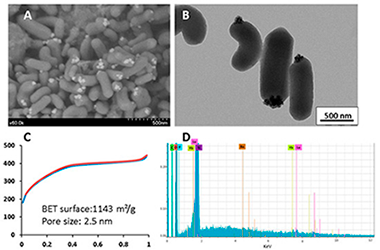
Abstract
(1) Background: Nanomedicine has recently emerged as a promising field, particularly for cancer theranostics. In this context, nanoparticles designed for imaging and therapeutic applications are of interest. We, therefore, studied the encapsulation of upconverting nanoparticles in mesoporous organosilica nanoparticles. Indeed, mesoporous organosilica nanoparticles have been shown to be very efficient for drug delivery, and upconverting nanoparticles are interesting for near-infrared and X-ray computed tomography imaging, depending on the matrix used. (2) Methods: Two different upconverting-based nanoparticles were synthesized with Yb3+-Er3+ as the upconverting system and NaYF4 or BaLuF5 as the matrix. The encapsulation of these nanoparticles was studied through the sol-gel procedure with bis(triethoxysilyl)ethylene and bis(triethoxysilyl)ethane in the presence of CTAB. (3) Results: with bis(triethoxysilyl)ethylene, BaLuF5: Yb3+-Er3+, nanoparticles were not encapsulated, but anchored on the surface of the obtained mesoporous nanorods BaLuF5: Yb3+-Er3+@Ethylene. With bis(triethoxysilyl)ethane, BaLuF5: Yb3+-Er3+ and NaYF4: Yb3+-Er(3+)nanoparticles were encapsulated in the mesoporous cubic structure leading to BaLuF5: Yb3+-Er3+@Ethane and NaYF4: Yb3+-Er3+@Ethane, respectively. (4) Conclusions: upconversion nanoparticles were located on the surface of mesoporous nanorods obtained by hydrolysis polycondensation of bis(triethoxysilyl)ethylene, whereas encapsulation occurred with bis(triethoxysilyl)ethane. The later nanoparticles NaYF4: Yb3+-Er3+@Ethane or BaLuF5: Yb3+-Er3+@Ethane were promising for applications with cancer cell imaging or X-ray-computed tomography respectively.
November, 2019 · DOI: 10.3390/molecules24224054
Materiales Coloidales
Monodisperse Gold Cuboctahedral Nanocrystals Directly Synthesized in Reverse Micelles: Preparation, Colloidal Dispersion in Organic Solvents and Water, Reversible Self-Assembly and Plasmonic Properties
Luna, C; Castaneda-Rodriguez, D; Barriga-Castro, ED; Nunez, NO; Mendoza-Resendez, RLangmuir, 34 (2019) 14291-14299 DOI: 10.1021/acs.langmuir.9b02374
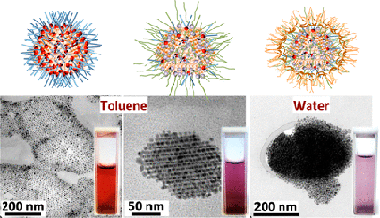
Abstract
The synthesis of organic-solvent-dispersible gold nanoparticles in reverse micelles of didodecyldimethylammonium bromide (DDAB) is revisited in the present investigation. Some parameters of synthesis, specifically the reaction volume and the concentration of the reducing agent, were slightly modified obtaining directly monodisperse gold nanocrystals (AuNCs) without the need to use additional active surfactants or additional treatments such as digestive ripening. Interestingly, most of the obtained AuNCs display the same exposed crystalline faces composed of six bounding facets (four {111} faces and two {002} faces), corresponding to single-crystalline face-centered cubic nanoparticles with a cuboctahedron shape. When these AuNCs are subsequently functionalized with 1-decanethiol (C10H21SH) or 1-dodecanethiol (C12H25SH), they don’t experience significant changes in their size or crystalline texture, however, they self-aggregate directly in the suspension at room temperature into faceted supramolecular structures and exhibit collective plasmonic excitations. Such self-organization is reversible under heating treatments allowing the observation of the influence of the AuNCs aggregation state on their plasmonic properties. Fourier transform infrared spectroscopy reveals that thiols only replace partially the DDAB molecules, and thus, DDAB molecules remain present in the thiol-capped AuNCs. To turn the thiol-capped nanocrystals into water-dispersible nanocrystals and extend their technological potential, they are stabilized with poloxamer 407 obtaining highly stable purple colloids in water.
November, 2019 · DOI: 10.1021/acs.langmuir.9b02374
Materiales Ópticos Multifuncionales
Spatially Resolved Analysis of Defect Annihilation and Recovery Dynamics in Metal Halide Perovskite Single Crystals
Galisteo-Lopez, JF; Calvo, ME; Miguez, HACS Applied Energy Materials, 2 (2019) 6967-6972 DOI: 10.1021/acsaem.9b01335
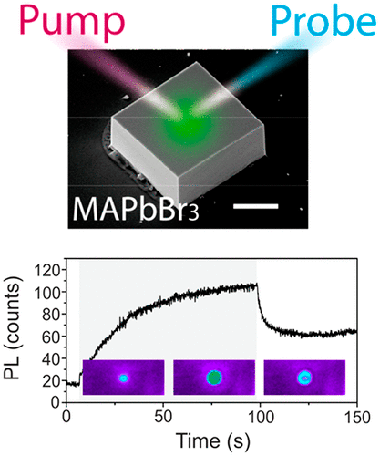
Abstract
The spectacular advances in efficiency of optoelectronic devices based on lead-halide perovskites have been accompanied by detailed structural and optical studies regarding the instability presented by these materials, which constitute their main bottleneck for commercialization. Following a pump and probe scheme in a laser scanning confocal microscope, we resolve the photoinduced emission activation/deactivation dynamics in CH3NH3PbBr3 single crystals with millisecond and sub-micrometer resolution. This is complemented with a study of spectral variations and interpreted in the framework of light-induced ion migration and associated defect passivation. Our results point to the presence of photoinduced structural changes accompanying the migration of ions.
October, 2019 · DOI: 10.1021/acsaem.9b01335
Materiales Coloidales
From structure to luminescence investigation of oxyfluoride transparent glasses and glass-ceramics doped with Eu3+/Dy3+ ions
Walas, M; Lisowska, M; Lewandowski, T; Becerro, AI; Lapinski, M; Synak, A; Sadowski, W; Koscielska, BJournal of Alloys and Compounds, 896 (2019) 1410-1418 DOI: 10.1016/j.jallcom.2019.07.017
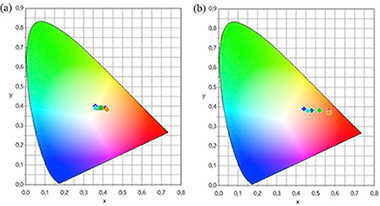
Abstract
Glasses and glass-ceramics with nominal composition 73 TeO2- 4BaO-3Bi(2)O(3)-18SrF(2)-2RE(2)O(3) (where RE = Eu, Dy) have been synthesized by conventional melt-quenching technique and subsequent heat treatment at 370 degrees C for 24 h in air atmosphere. Various Eu3+ to Dy3+ molar ratio have been applied to investigate luminescence properties in both glass and glass-ceramic matrices. Especially, white light emission through simultaneous excitation of Eu3+ and Dy3+ has been studied in detail. Influence of crystalline SrF2 phase on luminescence kinetics has been determined by luminescence decay time measurements. Presence of crystalline SrF2 phase has been confirmed by X-ray diffraction technique XRD and transmission electron microscopy TEM. X-ray photoelectron spectroscopy XPS and Fourier-transform infrared spectroscopy FTIR have been applied to get further insight into structural properties of glass and glass-ceramic materials. Color tunable white light emission has been obtained using UV excitation. Influence of the SrF2 crystallization on luminescence properties of prepared materials have been described in detail. Moreover, luminescence properties and especially emission color dependence on the Eu3+ to Dy3+ molar ratio have been exhaustively studied. Color-tunable white light emission has been observed as a result of simultaneous radiative transition of both, Eu3+ and Dy3+ ions when applying UV excitation. Judd - Ofelt and other optical parameters have been calculated based on luminescence emission spectra. Achieved results confirm that tellurite glass-ceramics containing SrF2 nanocrystals are good hosts for RE3+ ions and they can be considered as new phosphors for white light emitting diodes WLEDs.
October, 2019 · DOI: 10.1016/j.jallcom.2019.07.017
Materiales Coloidales - Materiales Ópticos Multifuncionales
Synthesis, functionalization and properties of uniform europium-doped sodium lanthanum tungstate and molybdate (NaLa(XO4)(2), X = Mo,W) probes for luminescent and X-ray computed tomography bioimaging
Laguna, M; Nunez, NO; Becerro, AI; Lozano, G; Moros, M; de la Fuente, JM; Corral, A; Balcerzyk, M; Ocana, MJournal of Colloid and Interface Science, 554 (2019) 520-530 DOI: 10.1016/j.jcis.2019.07.031
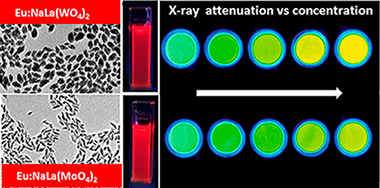
Abstract
A one-pot simple procedure for the synthesis of uniform, ellipsoidal Eu3+-doped sodium lanthanum tungstate and molybdate (NaLa(XO4)(2), X = W, Mo) nanophosphors, functionalized with carboxylate groups, is described. The method is based on a homogeneous precipitation process at 120 degrees C from appropriate Na+ Ln(3+) and tungstate or molybdate precursors dissolved in ethylene glycol/water mixtures containing poly acrylic acid. A comparative study of the luminescent properties of both luminescent materials as a function of the Eu3+ doping level has been performed to find the optimum nanophosphor, whose efficiency as X-ray computed tomography contrast agent is also evaluated and compared with that of a commercial probe. Finally, the cell viability and colloidal stability in physiological pH medium of the optimum samples have also been studied to assess their suitability for biomedical applications.
October, 2019 · DOI: 10.1016/j.jcis.2019.07.031
Materiales Ópticos Multifuncionales
Casimir-Lifshitz Force Based Optical Resonators
Esteso, V; Carretero-Palacios, S; Miguez, HJournal of Physical Chemistry Letters, 10 (2019) 5856-5860 DOI: 10.1021/acs.jpclett.9b02030
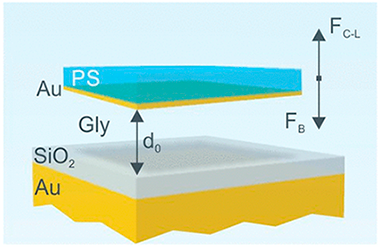
Abstract
We theoretically investigate the building of optical resonators based on the levitation properties of thin films subjected to strong repulsive Casimir-Lifshitz forces when immersed in an adequate medium and confronted with a planar substrate. We propose a design in which cavities supporting high Q-factor optical modes at visible frequencies can be achieved by means of combining commonly found materials, such as silicon oxide, polystyrene or gold, with glycerol as a mediating medium. We use the balance between flotation and repulsive Casimir-Lifshitz forces in the system to accurately tune the optical cavity thickness and hence its modes. The effects of other forces, such as electrostatic, that may come into play are also considered. Our results constitute a proof of concept that may open the route to the design of photonic architectures in environments in which dispersion forces play a substantial role and could be of particular relevance for devising novel microfluidic optical resonators.
October, 2019 · DOI: 10.1021/acs.jpclett.9b02030
Materiales Coloidales
Luminescence and X-ray Absorption Properties of Uniform Eu3+:(H3O)Lu3F10 Nanoprobes
Gonzalez-Mancebo, D; Becerro, AI; Corral, A; Balcerzyk, M; Ocana, MNanomaterials, 9 (2019) 1153 DOI: 10.3390/nano9081153

Abstract
Due to the high atomic number of lutetium and the low phonon energy of the fluoride matrix, Lu-based fluoride nanoparticles doped with active lanthanide ions are potential candidates as bioprobes in both X-ray computed tomography and luminescent imaging. This paper shows a method for the fabrication of uniform, water-dispersible Eu3+:(H3O)Lu3F10 nanoparticles doped with different Eu contents. Their luminescent properties were studied by means of excitation and emission spectra as well as decay curves. The X-ray attenuation capacity of the phosphor showing the highest emission intensity was subsequently analyzed and compared with a commercial contrast agent. The results indicated that the 10% Eu3+-doped (H3O)Lu3F10 nanoparticles fabricated with the proposed polyol-based method are good candidates to be used as dual probes for luminescent imaging and X-ray computed tomography.
August, 2019 · DOI: 10.3390/nano9081153
Materiales Ópticos Multifuncionales
Tamm Plasmons Directionally Enhance Rare-Earth Nanophosphor Emission
Geng, DL; Cabello-Olmo, E; Lozano, G; Miguez, HACS Photonics, 6 (2019) 634-641 DOI: 10.1021/acsphotonics.8b01407
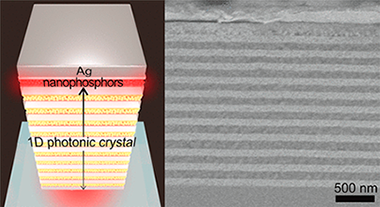
Abstract
Rare-earth-based phosphors are the materials on which current solid-state lighting technology is built. However, their large crystal size impedes the tuning, optimization, or manipulation of emitted light that can be achieved by their integration in nanophotonic architectures. Herein we demonstrate a hybrid plasmonic-photonic architecture capable of both channeling in a specific direction and enhancing by eight times the emission radiated by a macroscopically wide layer of nanophosphors. In order to do so, a slab of rare-earth-based nanocrystals is inserted between a dielectric multilayer and a metal film, following a rational design that optimizes the coupling of nanophosphor emission to collective modes sustained by the metal-dielectric system. Our approach is advantageous for the optimization of solid-state lighting systems.
March, 2019 · DOI: 10.1021/acsphotonics.8b01407
Materiales Ópticos Multifuncionales
Trapping of Gas Bubbles in Water at a Finite Distance below a Water-Solid Interface
Esteso, V; Carretero-Palacios, S; Thiyam, P; Miguez, H; Parsons, DF; Brevik, I; Bostrom, MLangmuir, 35 (2019) 4218-4223 DOI: 10.1021/acs.langmuir.8b04176
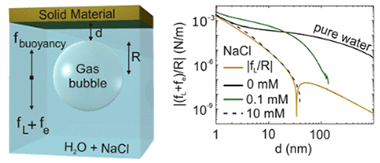
Abstract
Gas bubbles in a water-filled cavity move upward because of buoyancy. Near the roof, additional forces come into play, such as Lifshitz, double layer, and hydrodynamic forces. Below uncharged metallic surfaces, repulsive Lifshitz forces combined with buoyancy forces provide a way to trap micrometer-sized bubbles. We demonstrate how bubbles of this size can be stably trapped at experimentally accessible distances, the distances being tunable with the surface material. By contrast, large bubbles (>= 100 mu m) are usually pushed toward the roof by buoyancy forces and adhere to the surface. Gas bubbles with radii ranging from 1 to 10 mu m can be trapped at equilibrium distances from 190 to 35 nm. As a model for rock, sand grains, and biosurfaces, we consider dielectric materials such as silica and polystyrene, whereas aluminium, gold, and silver are the examples of metal surfaces. Finally, we demonstrate that the presence of surface charges further strengthens the trapping by inducing ion adsorption forces.
March, 2019 · DOI: 10.1021/acs.langmuir.8b04176
Materiales Ópticos Multifuncionales
Mechanism of Photoluminescence Intermittency in Organic-Inorganic Perovskite Nanocrystals
Galisteo-Lopez, JF; Calvo, ME; Rojas, TC; Miguez, HACS Applied Materials & Interfaces, 11 (4) (2019) 6344-6349 DOI: 10.1021/acsami.8b17122
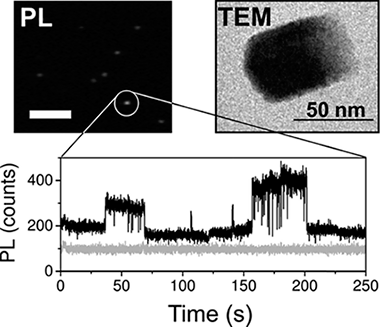
Abstract
Lead halide perovskite nanocrystals have demonstrated their potential as active materials for optoelectronic applications over the past few years. Nevertheless, one issue that hampers their applicability has to do with the observation of photoluminescence intermittency, commonly referred to as "blinking", as in their inorganic counterparts. Such behavior, reported for structures well above the quantum confinement regime, has been discussed to be strongly related to the presence of charge carrier traps. In this work, we analyze the characteristics of this intermittency and explore the dependence on the surrounding atmosphere, showing evidence for the critical role played by the presence of oxygen. We discuss a possible mechanism in which a constant creation/annihilation of halide-related carrier traps takes place under light irradiation, with the dominant rate being determined by the atmosphere.
February, 2019 · DOI: 10.1021/acsami.8b17122
Materiales Ópticos Multifuncionales
Highly Efficient Transparent Nanophosphor Films for Tunable White-Light-Emitting Layered Coatings
Geng, DL; Lozano, G; Miguez, HACS Applied Materials & Interfaces, 11 (4) (2019) 4219-4225 DOI: 10.1021/acsami.8b17368
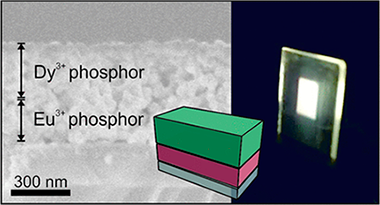
Abstract
Bright luminescence in rare-earth (RE) nanocrystals, the so-called nanophosphors, is generally achieved by choosing a host that enables an effective excitation of the RE activator through charge or energy transfer. Although tungstate, molybdate, or vanadate compounds provide the aforementioned transfer, a comparative analysis of the efficiency of such emitters remains elusive. Herein, we perform a combined structural and optical analysis, which reveals that the tetragonal GdVO4 matrix gives rise to the highest efficiency among the different transparent nanophosphor films compared. Then, we demonstrate that by a sequential stacking of optical quality layers made of Eu3+- and Dy3+-doped nanocrystals, it is possible to attain highly transparent white-light-emitting coatings of tunable shade with photoluminescence quantum yields above 35%. Layering provides a precise dynamic tuning of the chromaticity based on the photoexcitation wavelength dependence of the emission of the nanophosphor ensemble without altering the chemical composition of the emitters or degrading their efficiency. The total extinction of the incoming radiation along with the high quantum yields achieved makes these thin-layered phosphors one of the most efficient transparent white converter coatings ever developed.
January, 2019 · DOI: 10.1021/acsami.8b17368
Materiales Coloidales
Biocompatibility assessment of up-and down-converting nanoparticles: implications of interferences with in vitro assays
Pem, Barbara; Gonzalez-Mancebo, Daniel; Moros, Maria; Ocana, Manuel; Becerro, Ana Isabel; Pavicic, Ivan; Selmani, Atida; Babic, Michal; Horak, Daniel; Vinkovic Vrcek, IvanaMethods and Applications in Fluorescence, 7 (2019) 014001 DOI: 10.1088/2050-6120/aae9c8
Abstract
The safety assessment of nanoparticles (NPs) is crucial during their design and development for biomedicine. One of the prerequisite steps during this evaluation is in vitro testing that employs cell-based assays not always validated and well-adapted for NPs. Interferences with in vitro assays may arise due to the nano-related optical, oxidative, fluorescent, surface and catalytic properties of NPs. Thus, proper validation of each assay system has to be performed for each NP type. This study aimed to evaluate the applicability of the most common in vitro cytotoxicity assays for the safety assessment of up- and down-converting lanthanide-doped NPs. Conventional cell viability tests and fluorescence-based assays for oxidative stress response were selected to determine the biological effects of up- and down-converting NPs to human brain cells. Comparison with known silver and iron oxide NPs was made for verification purposes. Both the plate reader and flow cytometric measurements were examined. The obtained results indicated that both types of Ln-doped NPs interfered to a much lesser extent than metallic NPs. In addition, the great potential of both up- and down-converting NPs for biomedicine was manifested due to their biocompatibility and low toxicity.
January, 2019 · DOI: 10.1088/2050-6120/aae9c8
Materiales Coloidales
Enhancing Luminescence and X-ray Absorption Capacity of Eu3+:LaF3 Nanoparticles by Bi3+ Codoping
Mancebo, DG; Becerro, AI; Corral, A; Moros, M; Balcerzyk, M; de la Fuente, JM; Ocana, MACS Omega, 4 (2019) 765-774 DOI: 10.1021/acsomega.8b03160

Abstract
Bi3+ codoping has been proposed in this work with a twofold objective, namely, enhancing the luminescence emission of Eu3+:LaF3 nanoparticles (NPs) and increasing their X-ray attenuation capacity, with the purpose of obtaining a bimodal bioprobe for luminescence bioimaging and X-ray computed tomography. The synthesis method, reported here for the first time for LaF3 particles, allowed obtaining uniform, nonaggregated NPs using a homogeneous precipitation in polyol medium at room temperature in just 2 h. The simplicity of the synthesis method allows the large-scale production of NPs. LaF3 NPs with different Eu3+ contents were first synthesized to find the critical Eu3+ concentration, producing the highest emission intensity. This concentration was subsequently used to fabricate Bi3+-Eu3+-codoped LaF3 NPs using the same method. The emission intensity of the codoped NPs increased in more than one order of magnitude, thanks to the possibility of excitation through the Bi3+. Eu3+ energy-transfer band. The luminescence properties of the codoped NPs were analyzed in detail to find the mechanism responsible for the emission enhancement. Finally, it was demonstrated that the high atomic number of Bi3+, higher than that of lanthanides, was an added value of the material because it increased its X-ray attenuation capacity. In summary, the LaF3 NPs codoped with Eu3+ and Bi3+ presented in this work are promising candidates as a bimodal bioprobe for luminescence bioimaging and X-ray computed tomography.
January, 2019 · DOI: 10.1021/acsomega.8b03160
Materiales Ópticos Multifuncionales
Flexible nanophosphor films doped with Mie resonators for enhanced out-coupling of the emission
Miranda-Munoz, JM; Geng, DL; Calvo, ME; Lozano, G; Miguez, HJournal of Materials Chemistry C, 7 (2019) 267-274 DOI:
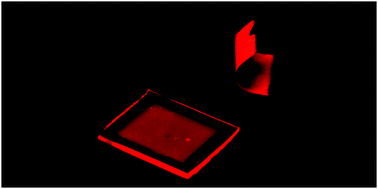
Abstract
Herein, we present a general method to prepare self-standing flexible photoluminescent coatings of controlled opacity for integration into light-emitting diodes (LEDs) employing cost-effective solution-processing methods. From colloidal suspensions of nano-sized phosphors, we fabricate light-emitting transparent films that can be doped with spherical scatterers, which act as Mie resonators that trigger a controlled photoluminescence enhancement, evidenced by the reduction of the guided light along the layer. This results in an enhanced emission compared to that extracted from a bare phosphor layer. We show not only that emission is visible under ultraviolet-LED illumination for both rigid and flexible versions of the coatings, but we also prove the feasibility of the integration of these flexible conversion layers into such devices. We believe these results can contribute to develop more efficient and cost-effective illumination sources by providing efficient and easy-to-handle conversion layers susceptible to excitation by LEDs emitting at wavelengths in the near UV region.
January, 2019 · DOI:
2018
2018
Materiales Ópticos Multifuncionales
Improving the Bulk Emission Properties of CH3NH3PbBr3 by Modifying the Halide-Related Defect Structure
Tiede, David O.; Calvo, Mauricio E.; Galisteo-Lopez, Juan F.; Miguez, HernanJournal of Physical Chemistry C, 122 (2018) 27250-27255 DOI: 10.1021/acs.jpcc.8b09315 DEC 6 2018
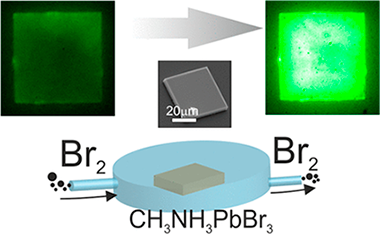
Abstract
The peculiar defect chemistry of hybrid organic–inorganic lead halide perovskites is believed to be partially responsible for the outstanding performance of this solution-processed material in optoelectronic devices. While most effort has been put on the management of halide defects (the ones presenting the highest mobility) for CH3NH3PbI3, its bromide counterpart has not been so widely studied. Although the former is the material of choice for photovoltaics, the latter is present in most light-emitting applications. Here, we report how the exposure of CH3NH3PbBr3 single crystals to a bromine atmosphere strongly affects its emission properties. Such improvement takes place in the absence of apparent signs of degradation and remains for tens of hours. We propose an explanation based on the defect structure for this material where bromine-related defects can act as deep or shallow traps. These results are of relevance for a material expected to be present in a new generation of solution-processed light-emitting devices.
December, 2018 · DOI: 10.1021/acs.jpcc.8b09315 DEC 6 2018
Materiales Coloidales - Materiales Ópticos Multifuncionales - Materiales y Procesos Catalíticos de Interés Ambiental y Energético
Revealing the substitution mechanism in Eu3+:CaMoO4 and Eu3+,Na+:CaMoO4 phosphors
Becerro, AI; Allix, M; Laguna, M; Gonzalez-Mancebo, D; Genevois, C; Caballero, A; Lozano, G; Nunez, NO; Ocana, MJournal of Materials Chemistry C, 6 (2018) 47 DOI: 10.1039/c8tc04595j

Abstract
Eu3+-Doped calcium molybdate is an excellent phosphor for lighting and display devices due to the very intense pure red emission after UV excitation. It has been reported in the literature that the CaMoO4 unit cell volume expands after Eu3+ doping, in spite of the smaller Eu3+ ionic radius compared with Ca2+. Likewise, several studies found that the emission intensity of the phosphor could be improved by codoping with alkaline ions like Li+, Na+ or K+. None of these studies correlated the apparent volume expansion and luminescence enhancement with the crystal structural details. This paper analyses the aliovalent substitution mechanism and crystal structure of Eu3+:CaMoO4 and Eu3+,Na+:CaMoO4 phosphors using complementary techniques like Raman spectroscopy, EXAFS and SPD. We found that the substitution mechanism was different for both systems, with Ca site vacancies forming in the Eu3+:CaMoO4 phosphors and leading to Ca1-3xEu2xxMoO4 compositions, while the Eu3+,Na+:CaMoO4 phosphors formed Ca1-2xEuxNaxMoO4. SPD showed that the cell volume expansion observed with increasing Eu3+ content is related to the increase of the Mo-O bond distance due to the higher electronegativity of Eu3+ compared with Ca2+. Finally, it was shown that the luminescence properties, i.e. lifetime values and quantum yields (the latter reported here for the first time), do not depend on the presence of monovalent ions in the crystal structure but, exclusively, on the Eu3+ content of the phosphor. The integral and detailed analysis of the materials presented in this paper, ranging from crystal structure to luminescent properties including elemental composition, allows a full picture of the structure-property relationships that had never been addressed before for CaMoO4-based phopshors.
December, 2018 · DOI: 10.1039/c8tc04595j
Materiales Ópticos Multifuncionales
High voltage vacuum-deposited CH3NH3PbI3–CH3NH3PbI3 tandem solar cells
Avila, J; Momblona, C; Boix, P; Sessolo, M; Anaya, M; Lozano, G; Vandewal, K; Miguez, H; Bolink, HJEnergy & Environmental Science, 11 (2018) 3292-3297 DOI: 10.1039/c8ee01936c

Abstract
The recent success of perovskite solar cells is based on two solid pillars: the rapid progress of their power conversion efficiency and their flexibility in terms of optoelectrical properties and processing methods. That versatility makes these devices ideal candidates for multi-junction photovoltaics. We report an optically optimized double junction CH3NH3PbI3-CH3NH3PbI3 tandem solar cell where the matched short-circuit current is maximized while parasitic absorption is minimized. The use of an additive vacuum-deposition protocol allows us to reproduce calculated stack designs, which comprise several charge selective materials that ensure appropriate band alignment and charge recombination. This rationalized configuration yields an unprecedented open circuit voltage of 2.30 V. Furthermore, this tandem solar cell features efficiencies larger than 18%, higher than those of the individual sub-cells. Low photo-current values allow reducing the losses associated to the series resistance of transparent contacts, which opens the door to the realization of efficient large area modules.
November, 2018 · DOI: 10.1039/c8ee01936c
Materiales Ópticos Multifuncionales
Highly Efficient and Environmentally Stable Flexible Color Converters Based on Confined CH3NH3PbBr3 Nanocrystals
Rubino, A; Anaya, M; Galisteo-Lopez, JF; Rojas, TC; Calvo, ME; Miguez, HACS Applied Materials & Interfaces, 10 (2018) 38334-38340 DOI: 10.1021/acsami.8b11706
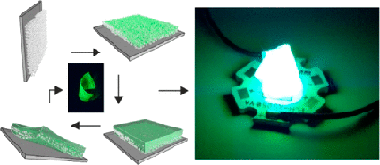
Abstract
In this work, we demonstrate a synthetic route to attain methylammonium lead bromide (CH3NH3PbBr3) perovskite nanocrystals (nc-MAPbBr(3), 1.5 nm < size < 3 nm) and provide them with functionality as highly efficient flexible, transparent, environmentally stable, and adaptable color converting films. We use nanoparticle metal oxide (MOx) thin films as porous scaffolds of controlled nanopores size distribution to synthesize nc-MAPbBr(3) through the infiltration of perovskite liquid precursors. We find that the control over the reaction volume imposed by the nanoporous scaffold gives rise to a strict control of the nanocrystal size, which allows us to observe well-defined quantum confinement effects on the photo-emission, being the luminescence maximum tunable with precision between lambda = 530 nm (green) and lambda = 490 nm (blue). This hybrid nc-MAPbBr(3)/MOx structure presents high mechanical stability and permits subsequent infiltration with an elastomer to achieve a self-standing flexible film, which not only maintains the photo-emission efficiency of the nc-MAPbBr(3) unaltered but also prevents their environmental degradation. Applications as adaptable color-converting layers for light-emitting devices are envisaged and demonstrated.
November, 2018 · DOI: 10.1021/acsami.8b11706
Materiales Ópticos Multifuncionales
Absorption enhancement in methylammonium lead iodide perovskite solar cells with embedded arrays of dielectric particles
Jimenez-Solano, A; Carretero-Palacios, S; Miguez, HOptics Express, 26 (2018) A865-A878 DOI: 10.1364/OE.26.00A865
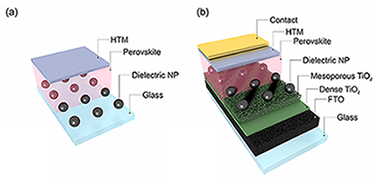
Abstract
In the field of hybrid organic-inorganic perovskite based photovoltaics, there is a growing interest in the exploration of novel and smarter ways to improve the cells light harvesting efficiency at targeted wavelength ranges within the minimum volume possible, as well as in the development of colored and/or semitransparent devices that could pave the way both to their architectonic integration and to their use in the flowering field of tandem solar cells. The work herein presented targets these different goals by means of the theoretical optimization of the optical design of standard opaque and semitransparent perovskite solar cells. In order to do so, we focus on the effect of harmless, compatible and commercially available dielectric inclusions within the absorbing material, methylammonium lead iodide (MAPI). Following a gradual and systematic process of analysis, we are capable of identifying the appearance of collective and hybrid (both localized and ex tended) photonic resonances which allow to significantly improve light harvesting and thus the overall efficiency of the standard device by above 10% with respect to the reference value while keeping the semiconductor film thickness to a minimum. We believe our results will be particularly relevant in the promising field of perovskite solar cell based tandem photovoltaic devices, which has posed new challenges to the solar energy community in order to maximize the performance of semitransparent cells, but also for applications focusing on architectonic integration.
September, 2018 · DOI: 10.1364/OE.26.00A865
Materiales Ópticos Multifuncionales
The Role of Metal Halide Perovskites in Next-Generation Lighting Devices
Lozano, G.Journal of Physical Chemistry Letters, 9 (2018) 3987-3997 DOI: 10.1021/acs.jpclett.8b01417
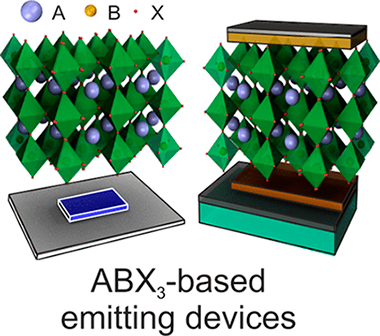
Abstract
The development of smart illumination sources represents a central challenge for current technology. In this context, the quest for novel materials that enable efficient light generation is essential. Metal halide compounds with perovskite crystalline structure (ABX(3)) have gained tremendous interest in the last five years since they come as easy-to-prepare high performance semiconductors. Perovskite absorbers are driving the power-conversion-efficiencies of thin film photovoltaics to unprecedented values. Nowadays, mixed-cation, mixed-halide lead perovskite solar cells reach efficiencies consistently over 20% and promise to get close to 30% in multijunction devices when combined with silicon cells at no surcharge. Nonetheless, perovskites' fame extends further since extensive research on these novel semiconductors has also revealed their brightest side. Soon after their irruption in the photovoltaic scenario, demonstration of efficient color tunable-with high color purity-perovskite emitters has opened new avenues for light generation applications that are timely to discuss herein.
July, 2018 · DOI: 10.1021/acs.jpclett.8b01417
Materiales Coloidales
Structural, optical and X-ray attenuation properties of Tb3+: BaxCe1-xF3-x (x=0.18-0.48) nanospheres synthesized in polyol medium
Gonzalez-Mancebo, D; Becerro, AI; Genevois, C; Allix, M; Corral, A; Parrado-Gallego, A; Ocana, MDalton Transactions, 47 (2018) 8382-8391 DOI: 10.1039/c8dt01202d
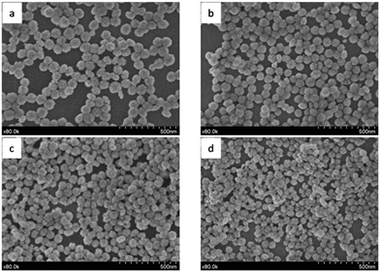
Abstract
Uniform Ba0.18Ce0.82F2.82 nanospheres have been obtained after aging a solution of barium and cerium nitrates and sodium tetrafluoroborate in a mixture of ethylene glycol and water at 120 degrees C for 20 hours. The diameter of the spheres could be tailored from 65 nm to 80 nm by varying the NaBF4 concentration while maintaining their colloidal stability in aqueous suspension. Increasing the aging temperature led to a phase transformation from hexagonal to cubic symmetry and to a concomitant increase of the Ba/Ce ratio, which reached a value close to the nominal one (50/50) at 240 degrees C. The same method was successful in obtaining Tb3+-doped nanospheres with homogeneous cation distribution and the same morphological features as the undoped material. An intense green emission was observed after the excitation of the Tb3+-doped samples through the Ce3+-Tb3+ energy transfer (ET) band. The ET efficiency increased with increasing Tb content, the maximum emission being observed for the 10% Tb-doped nanospheres. Aqueous suspensions of the latter sample showed excellent X-ray attenuation values that were superior to those of an iodine-based clinically approved contrast agent. Their fluorescence and X-ray attenuation properties make this material a potential dual bioprobe for luminescence bioimaging and X-ray computed tomography.
July, 2018 · DOI: 10.1039/c8dt01202d
Materiales Ópticos Multifuncionales
Photonic structuring improves the colour purity of rare-earth nanophosphors
Geng, DL; Cabello-Olmo, E; Lozano, G; Miguez, HMaterials Horizons, 5 (2018) 661-667 DOI: 10.1039/c8mh00123e
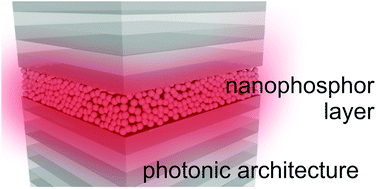
Abstract
Nanophosphor integration in an optical cavity allows unprecedented control over both the chromaticity and the directionality of the emitted light, without modifying the chemical composition of the emitters or compromising their efficiency. Our approach opens a route towards the development of nanoscale photonics based solid state lighting.
July, 2018 · DOI: 10.1039/c8mh00123e
Materiales Ópticos Multifuncionales - Nanotecnología en Superficies y Plasma
Origin of Light-Induced Photophysical Effects in Organic Metal Halide Perovskites in the Presence of Oxygen
Anaya, M; Galisteo-Lopez, JF; Calvo, ME; Espinos, JP; Miguez, HJournal of Physical Chemistry Letters, 9 (2018) 3891-3896 DOI: 10.1021/acs.jpclett.8b01830
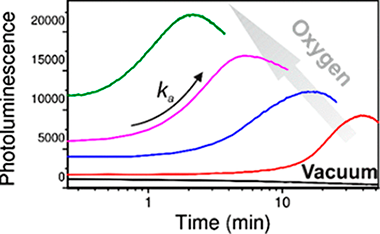
Abstract
Herein we present a combined study of the evolution of both the photoluminescence (PL) and the surface chemical structure of organic metal halide perovskites as the environmental oxygen pressure rises from ultrahigh vacuum up to a few thousandths of an atmosphere. Analyzing the changes occurring at the semiconductor surface upon photoexcitation under a controlled oxygen atmosphere in an X-ray photoelectron spectroscopy (XPS) chamber, we can rationalize the rich variety of photophysical phenomena observed and provide a plausible explanation for light-induced ion migration, one of the most conspicuous and debated concomitant effects detected during photoexcitation. We find direct evidence of the formation of a superficial layer of negatively charged oxygen species capable of repelling the halide anions away from the surface and toward the bulk. The reported PL transient dynamics, the partial recovery of the initial state when photoexcitation stops, and the eventual degradation after intense exposure times can thus be rationalized.
July, 2018 · DOI: 10.1021/acs.jpclett.8b01830
Tribología y Protección de Superficies - Materiales Coloidales
Room temperature synthesis of water-dispersible Ln(3+):CeF3 (Ln = Nd, Tb) nanoparticles with different morphology as bimodal probes for fluorescence and CT imaging
Gonzalez-Mancebo, D; Becerro, AI; Rojas, TC; Olivencia, A; Corral, A; Balcerzyk, M; Cantelar, E; Cusso, F; Ocana, MJournal of Colloid and Interface Science, 520 (2018) 134-144 DOI: 10.1016/j.jcis.2018.03.007
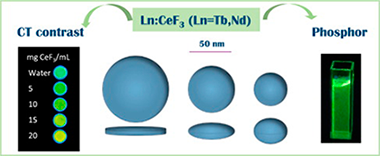
Abstract
The singular properties of lanthanide-based inorganic nanoparticles (NPs) has raised the attention of the scientific community in biotechnological applications. In particular, those systems with two or more functionalities are especially interesting. In this work, an effective and commercially attractive procedure has been developed that renders uniform, water-dispersible Ln(3+):CeF3 (Ln = Tb, Nd) NPs with different shapes and size. The method consists of the homogeneous precipitation, in a mixture of polyol and water, of cations and anions using precursors that allow the controlled release of the latter. The advantages of the reported method are related to the absence of surfactants, dispersing agents or corrosive precursors as well as to the room temperature of the process. The obtained Tb:CeF3 NPs produce an intense emission after excitation through the Ce-Tb energy transfer band located in the UV spectral region, thus being potentially useful as phosphors for in-vitro imaging purposes. On the other hand, the synthesized Nd:CeF3 NPs are good candidates for in-vivo imaging because their excitation and emission wavelengths lie in the biological windows. Finally, the excellent X-ray attenuation efficacy of the Nd:CeF(3)NPs is shown, which confers double functionality to this material as both luminescence bioprobe and contrast agent for X-ray computed-tomography.
June, 2018 · DOI: 10.1016/j.jcis.2018.03.007
Materiales Ópticos Multifuncionales
Unexpected Optical Blue Shift in Large Colloidal Quantum Dots by Anionic Migration and Exchange
Acebron, M; Galisteo-Lopez, JF; Lopez, C; Herrera, FC; Mizrahi, M; Requejo, FG; Palomares, FJ; Juarez, BHJournal of Physical Chemistry Letters, 9 (2018) 3124-3130 DOI: 10.1021/acs.jpclett.8b00741

Abstract
Compositional changes taking place during the synthesis of alloyed CdSeZnS nanocrystals (NCs) allow shifting of the optical features to higher energy as the NCs grow. Under certain synthetic conditions, the effect of those changes on the surface/interface chemistry competes with and dominates over the conventional quantum confinement effect in growing NCs. These changes, identified by means of complementary advanced spectroscopic techniques such as XPS (X-ray photoelectron spectroscopy) and XAS (X-ray absorption spectroscopy), are understood in the frame of an ion migration and exchange mechanism taking place during the synthesis. Control over the synthetic routes during NC growth represents an alternative tool to tune the optical properties of colloidal quantum dots, broadening the versatility of the wet chemical methods.
June, 2018 · DOI: 10.1021/acs.jpclett.8b00741
Materiales Ópticos Multifuncionales
Absorption and Emission of Light in Optoelectronic Nanomaterials: The Role of the Local Optical Environment
Jimenez-Solano, Alberto; Galisteo-Lopez, Juan F.; Miguez, HernanJournal of Physical Chemistry Letters, 9 (2018) 2077-2084 DOI: 10.1021/acs.jpclett.8b00848
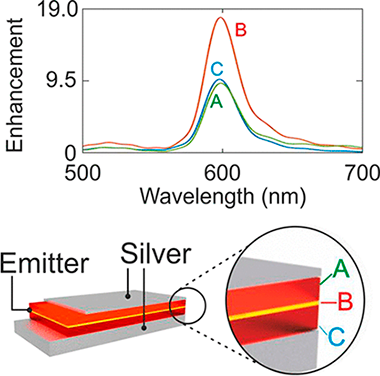
Abstract
Tailoring the interaction of electromagnetic radiation with matter is central to the development of optoelectronic devices. This becomes particularly relevant for a new generation of devices offering the possibility of solution processing with competitive efficiencies as well as new functionalities. These devices, containing novel materials such as inorganic colloidal quantum dots or hybrid organic-inorganic lead halide perovskites, commonly demand thin (tens of nanometers) active layers in order to perform optimally and thus maximizing the way electromagnetic radiation interacts with these layers is essential. In this Perspective, we discuss the relevance of tailoring the optical environment of the active layer in an optoelectronic device and illustrate it with two real-world systems comprising photovoltaic cells and light emitting devices.
April, 2018 · DOI: 10.1021/acs.jpclett.8b00848
Materiales Coloidales
Photoluminescence quenching of dye molecules near a resonant silicon nanoparticle
Zyuzin, MV; Baranov, DG; Escudero, A; Chakraborty, I; Tsypkin, A; Ushakova, EV; Kraus, F; Parak, WJ; Makarov, SVScientific Reports, 8 (2018) art. 6107 DOI: 10.1038/s41598-018-24492-y
Abstract
Luminescent molecules attached to resonant colloidal particles are an important tool to study light-matter interaction. A traditional approach to enhance the photoluminescence intensity of the luminescent molecules in such conjugates is to incorporate spacer-coated plasmonic nanoantennas, where the spacer prevents intense non-radiative decay of the luminescent molecules. Here, we explore the capabilities of an alternative platform for photoluminescence enhancement, which is based on low-loss Mie-resonant colloidal silicon particles. We demonstrate that resonant silicon particles of spherical shape are more efficient for photoluminescence enhancement than their plasmonic counterparts in spacer-free configuration. Our theoretical calculations show that significant enhancement originates from larger quantum yields supported by silicon particles and their resonant features. Our results prove the potential of high-index dielectric particles for spacer-free enhancement of photoluminescence, which potentially could be a future platform for bioimaging and nanolasers.
April, 2018 · DOI: 10.1038/s41598-018-24492-y
Materiales Coloidales
Synthesis and optical properties of environmentally benign and highly uniform NaCe(MoO4)(2) based yellow nanopigments
Laguna, M; Nuñez, NO; Fernandez, M; Ocaña, MJournal of Alloys and Compounds, 739 (2018) 542-548 DOI: 10.1016/j.jallcom.2017.12.158
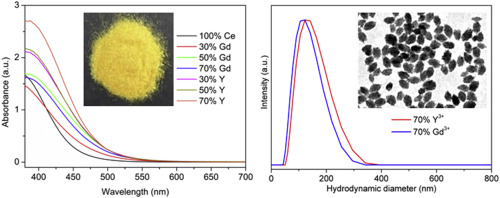
Abstract
A method for the synthesis of uniform and aggregation free NaCeMoO4 based nanospheroids with tunable size is reported. The procedure is based on a precipitation reaction at 120 degrees C for 20 h from solutions containing Na2MoO4, sodium citrate and Ce(NO3)(3) and different amounts of Y(NO3)(3) or Gd(NO3)(3). The role played by the later compounds on the formation of the particles and their morphological and structural characteristics is analyzed through the analysis of the mechanism of particle formation. The chromaticity coordinates of the obtained samples are also evaluated showing that the here reported nanoparticles constitute an ecofriendly alternative to more toxic commercial yellow pigments. The synthesized nanoparticles are also free of aggregation in water suspensions and might be suitable for injet-printing technologies.
March, 2018 · DOI: 10.1016/j.jallcom.2017.12.158
Materiales Coloidales
Laterally and Temporally Controlled Intracellular Staining by Light-Triggered Release of Encapsulated Fluorescent Markers
Kantner, K; Rejman, J; Kraft, KVL; Soliman, MG; Zyuzin, MV; Escudero, A; del Pino, P; Parak, WJChemistry-A European Journal, 24 (2018) 2098-2102 DOI: 10.1002/chem.201706135
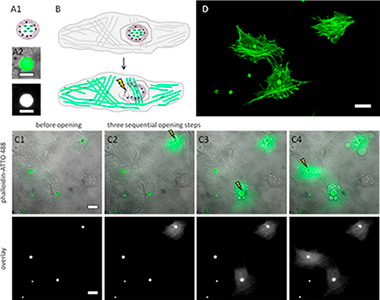
Abstract
Fluorescent molecular markers were encapsulated. The capsules were additionally modified with plasmonic nanoparticles. The encapsulated markers were endocytosed by cells. Upon light stimulation the plasmonic nanoparticles generated heat, which opened the encapsulation and transiently perforated the endosomal/lysosomal membrane surrounding the capsule, thus allowing for release of the marker into the cytosol. Fluorescence labeling of different intracellular compartments was demonstrated in this way. Most important, the cells do not need to be fixed and perforated, as the molecular markers are introduced into cells by endocytosis and subsequent light-induced release. Thus this technique allows for intracellular fluorescence labeling of living cells.
February, 2018 · DOI: 10.1002/chem.201706135
Materiales Ópticos Multifuncionales
Flexible and Adaptable Light-Emitting Coatings for Arbitrary Metal Surfaces based on Optical Tamm Mode Coupling
Jiménez-Solano, A.; Galisteo-López, J.; Míguez, H.Advanced Optical Materials, 6 (2018) 1700560 DOI: 10.1002/adom.201700560
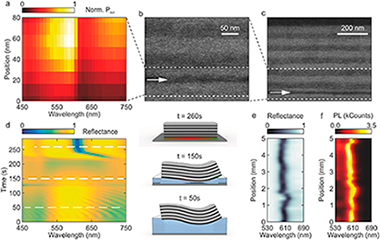
Abstract
This study demonstrates a design that maximizes the power radiated into free space from a monolayer of nanoemitters embedded in a flexible distributed Bragg reflector conformably attached to a metal surface. This is achieved by positioning the light source at the precise depth within the multilayer for which optical Tamm states provide enhanced quantum yield and outcoupling efficiency, which are combined to optimize the luminous power radiated by the surface of the ensemble. This approach, based on the adhesion of flexible multilayer stacks onto metal surfaces with an arbitrary curvature, is versatile and permits the realization of spectrally narrow monodirectional or self-focusing light-emitting surfaces.
January, 2018 · DOI: 10.1002/adom.201700560
2017
2017
Materiales Coloidales
Local Disorder and Tunable Luminescence in Sr1–x/2Al2–xSixO4 (0.2 ≤ x ≤ 0.5) Transparent Ceramics
Fernandez-Carrion, AJ; Al Saghir, K; Veron, E; Becerro, AI; Porcher, F; Wisniewsld, W; Matzen, G; Fayon, F; Allix, MInorganic Chemistry, 56 (2017) 14446-14458 DOI: 10.1021/acs.inorgchem.7b01881
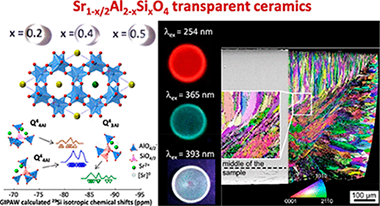
Abstract
Eu-doped Sr1–x/2Al2–xSixO4 (x = 0.2, 0.4, and 0.5) transparent ceramics have been synthesized by full and congruent crystallization from glasses prepared by aerodynamic levitation and laser-heating method. Structural refinements from synchrotron and neutron powder diffraction data show that the ceramics adopt a 1 × 1 × 2 superstructure compared to the SrAl2O4 hexagonal polymorph. While the observed superstructure reflections indicate a long-range ordering of the Sr vacancies in the structure, 29Si and 27Al solid-state NMR measurements associated with DFT computations reveal a significant degree of disorder in the fully polymerized tetrahedral network. This is evidenced through the presence of Si–O–Si bonds, as well as Si(OAl)4 units at remote distances of the Sr vacancies and Al(OAl)4 units in the close vicinity of Sr vacancies departing from local charge compensation in the network. The transparent ceramics can be doped by europium to induce light emission arising from the volume under UV excitation. Luminescence measurements then reveal the coexistence of Eu2+ and Eu3+ in the samples, thereby allowing tuning the emission color depending on the excitation wavelength and suggesting possible applications such as solid state lighting.
December, 2017 · DOI: 10.1021/acs.inorgchem.7b01881
Materiales Coloidales
Microemulsion-Mediated Synthesis and Properties of Uniform Ln:CaWO4 (Ln = Eu, Dy) Nanophosphors with Multicolor Luminescence for Optical and CT Imaging
Laguna, M; Nuñez, NO; Garcia, FJ; Corral, A; Parrado-Gallego, A; Balcerzyk, M; Becerro, AI; Ocaña, MEuropean Journal of Inorganic Chemistry, 44 (2017) 5158-5168 DOI: 10.1002/ejic.201700650

Abstract
A new room-temperature method has been developed that yields, for the first time in the literature, uniform and well-dispersed CaWO4 nanospindles. This method is based on the use of microemulsions consisting of aqueous solutions of Ca2+ and WO42- precursors, cyclohexane as the organic medium, Triton X-100 as the surfactant, and n-octanol as the cosurfactant. We show that the formation of uniform nanospindles requires a restrictive set of experimental conditions. These particles crystallize into the tetragonal CaWO4 phase and emit blue-green luminescence when excited by UV radiation. The reported method is also useful for doping the CaWO4 spindles with Eu3+ or Dy3+ cations, resulting in multicolor emissions (red for Eu3+; white for Dy3+). The luminescence is much stronger when excited through a WO42--Ln(3+) (Ln = Eu or Dy) energy-transfer band than through the f-f transition bands of the Ln(3+) cations. Interestingly, because of the white luminescence associated with the Dy:CaWO4 nanophosphor, it might be useful for LED technologies. Luminescence dynamics and energy-transfer efficiency have been analyzed to determine the optimum phosphors. Finally, the Eu-doped CaWO4 nanospindles also showed excellent X-ray attenuation efficacy, which confers double functionality to this material as both a luminescence bioprobe and as a contrasting agent for X-ray computed-tomography.
December, 2017 · DOI: 10.1002/ejic.201700650
Materiales Ópticos Multifuncionales
Fluorescent Humidity Sensors Based on Photonic Resonators
Szendrei, K; Jimenez-Solano, A; Lozano, G; Lotsch, BV; Miguez, HAdvanced Optical Materials, 5 (2017) 1700663 DOI: 10.1002/adom.201700663
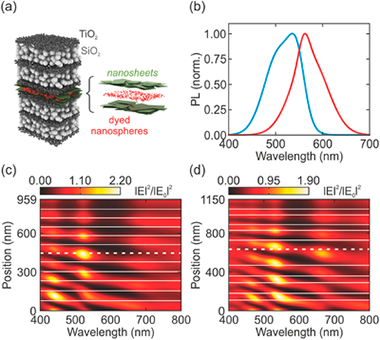
Abstract
Among the different approaches to humidity sensing available, those based on fluorescent signals are gathering a great deal of attention due to their fast response and versatility of detection and design. So far, all proposals have focused on the use of luminescent probes whose emission is either triggered or inhibited by the presence of water that reacts or alters their chemical environment, hence inducing the signal change. Here, a novel concept in fluorescent humidity sensing based on combining stimuli-responsive photonic resonators with molecular fluorescent probes is introduced. The resonator is assembled from humidity-swellable antimony phosphate nanosheets embedding a planar light-emitting probe, whose emission is dramatically modified by the changes that ambient humidity causes in its photonic environment. Guided by "in silico" optical design of the resonator architecture and subsequent experimental realization, two embodiments of fluorescent photonic humidity sensors featuring turn-on and turn-off detection schemes are presented. The interplay between the luminescent properties of an emitter and its photonic environment implies a fundamental advantage as the emitters are not chemically altered during the detection process. At the same time, it paves the way toward a new generation of photonic humidity sensors which can conveniently be interfaced with common fluorescence detection schemes.
December, 2017 · DOI: 10.1002/adom.201700663
Tribología y Protección de Superficies - Materiales Coloidales
HoF3 and DyF3 Nanoparticles as Contrast Agents for High-Field Magnetic Resonance Imaging
Gonzalez-Mancebo, Daniel; Becerro, Ana I.; Rojas, T. Cristina; Garcia-Martin, Maria L.; de la Fuente, Jesus M.; Ocana, ManuelParticle & particle systems characterization, 34 (2017) art. 1700116 DOI: 10.1002/ppsc.201700116

Abstract
Clinical contrast agents (CAs) currently used in magnetic resonance imaging (MRI) at low fields are less effective at high magnetic fields. The development of new CAs is mandatory to improve diagnostic capabilities of the new generation of high field MRI scanners. The purpose of this study is to synthesize uniform, water dispersible LnF3 (Ln = Ho, Dy) nanoparticles (NPs) and to evaluate their relaxivity at high magnetic field (9.4 T) as a function of size and composition. Two different types of HoF3 NPs are obtained by homogeneous precipitation in ethylene glycol at 120 °C. The use of holmium acetate as holmium precursor leads to rhombus-like nanoparticles, while smaller, ellipsoid-like nanoparticles are obtained when nitrate is used as the holmium salt. To explain this behavior, the mechanism of formation of both kinds of particles is analyzed in detail. Likewise, rhombus-like DyF3 nanoparticles are prepared following the same method as for the rhombus-like HoF3 nanoparticles. We have found, to the best of knowledge, the highest transverse relaxivity values at 9.4 T described in the literature for this kind of CAs. Finally, the LnF3 NPs have shown negligible cytotoxicity for C6 rat glioma cells for concentrations up to 0.1 mg mL−1.
October, 2017 · DOI: 10.1002/ppsc.201700116
Materiales Ópticos Multifuncionales
Facile Synthesis of Hybrid Organic–Inorganic Perovskite Microcubes of Optical Quality Using Polar Antisolvents
Li, Yuelong; Galisteo-Lopez, Juan F.; Calvo, Mauricio E.; Miguez, HernanACS Applied Materials & Interfaces, 9 (2017) 35505-35510 DOI: 10.1021/acsami.7b08431

Abstract
Herein, we demonstrate a synthetic approach producing highly crystalline methylammonium lead bromide perovskite (MAPbBr3) microcubes at room temperature by injecting a perovskite precursor solution into an environmentally friendly antisolvent (isopropyl alcohol). Confirmed by X-ray and electron diffraction, as well as electron microscopy, these MAPbBr3 microcubes are single crystals and have perfect cubic structure, with sizes varying between 1 and 15 μm depending on the synthesis conditions. The stoichiometry of the MAPbBr3 crystal is proven by energy-dispersive X-ray analysis. Finally, optical analysis carried out by means of laser scanning confocal microscopy evidences how the crystalline quality of the microcubes translates into a homogeneous photoluminescence throughout the cube volume.
October, 2017 · DOI: 10.1021/acsami.7b08431
Materiales Ópticos Multifuncionales
Materials chemistry approaches to the control of the optical features of perovskite solar cells
Calvo, Mauricio E.Journal of Materials Chemistry A, 5 (2017) 20561-20578 DOI: 10.1039/c7ta05666d
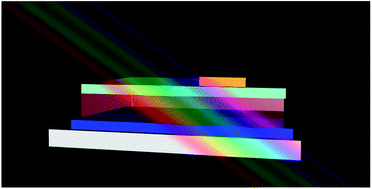
Abstract
Perovskite solar cells have revolutionized the field of photovoltaics. Apart from their impressive photo-conversion efficiencies, the ease of their fabrication – principally when carried out by solution processing – has permitted addition of new functionalities to the photovoltaic cell. Some of these features are related to the optical properties. In this review, the different materials chemistry approaches that allow controlling the spectral absorption of ABX3 perovskite layers and the changes that they produce in the visual aspect of the solar cell will be covered. These modifications can be done either by playing with the composition of the precursors or by integrating different types of nanostructures. Spectral bandgap tuning, semitransparency, color and enhancement of light absorption are examples of how these modifications operate in the core of ABX3 perovskite solar cells. These optical features bring benefits in terms of photo-conversion efficiencies or else in the aesthetical integration of perovskite solar cells with architectonic elements for building integrated photovoltaics. Additionally, surface passivation approaches are covered to show its effect over the photo-conversion efficiency and stability of the cell.
October, 2017 · DOI: 10.1039/c7ta05666d
Materiales Coloidales
Rare earth based nanostructured materials: synthesis, functionalization, properties and bioimaging and biosensing applications
Escudero, Alberto; Becerro, Ana I.; Carrillo-Carrion, Carolina; Nunez, Nuria O.; Zyuzin, Mikhail V.; Laguna, Mariano; Gonzalez-Mancebo, Daniel; Ocana, Manuel; Parak, Wolfgang J.Nanophotonics, 6 (2017) 881-921 DOI: 10.1515/nanoph-2017-0007
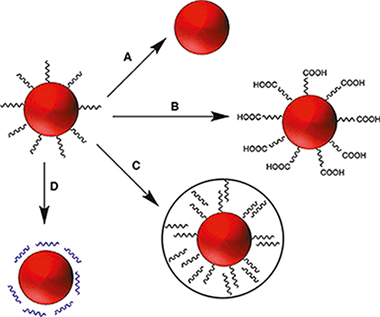
Abstract
Rare earth based nanostructures constitute a type of functional materials widely used and studied in the recent literature. The purpose of this review is to provide a general and comprehensive overview of the current state of the art, with special focus on the commonly employed synthesis methods and functionalization strategies of rare earth based nanoparticles and on their different bioimaging and biosensing applications. The luminescent (including downconversion, upconversion and permanent luminescence) and magnetic properties of rare earth based nanoparticles, as well as their ability to absorb X-rays, will also be explained and connected with their luminescent, magnetic resonance and X-ray computed tomography bioimaging applications, respectively. This review is not only restricted to nanoparticles, and recent advances reported for in other nanostructures containing rare earths, such as metal organic frameworks and lanthanide complexes conjugated with biological structures, will also be commented on.
September, 2017 · DOI: 10.1515/nanoph-2017-0007
Materiales Coloidales
Europium-doped NaGd(WO4)(2) nanophosphors: synthesis, luminescence and their coating with fluorescein for pH sensing
Laguna, M; Escudero, A; Nuñez, NO; Becerro, AI; Ocaña, MDalton Transactions, 46 (2017) 11575-11583 DOI: 10.1039/c7dt01986f
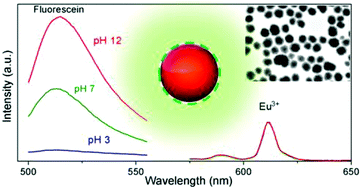
Abstract
Uniform Eu-doped NaGd(WO4)(2) nanophosphors with a spherical shape have been synthesized for the first time by using a wet chemistry method based on a homogeneous precipitation process at low temperature (120 degrees C) in ethylene glycol/water mixtures. The obtained nanoparticles crystallized into the tetragonal structure and presented polycrystalline character. The europium content in such phosphors has been optimized through the analysis of the luminescence dynamics (lifetime measurements). By coating the Eu3+-doped wolframate based nanoparticles with fluorescein through a layer-by-layer (LbL) approach, a wide range (4-10) ratiometric pH-sensitive sensor has been developed, which uses the pH insensitive emission of Eu3+ as a reference.
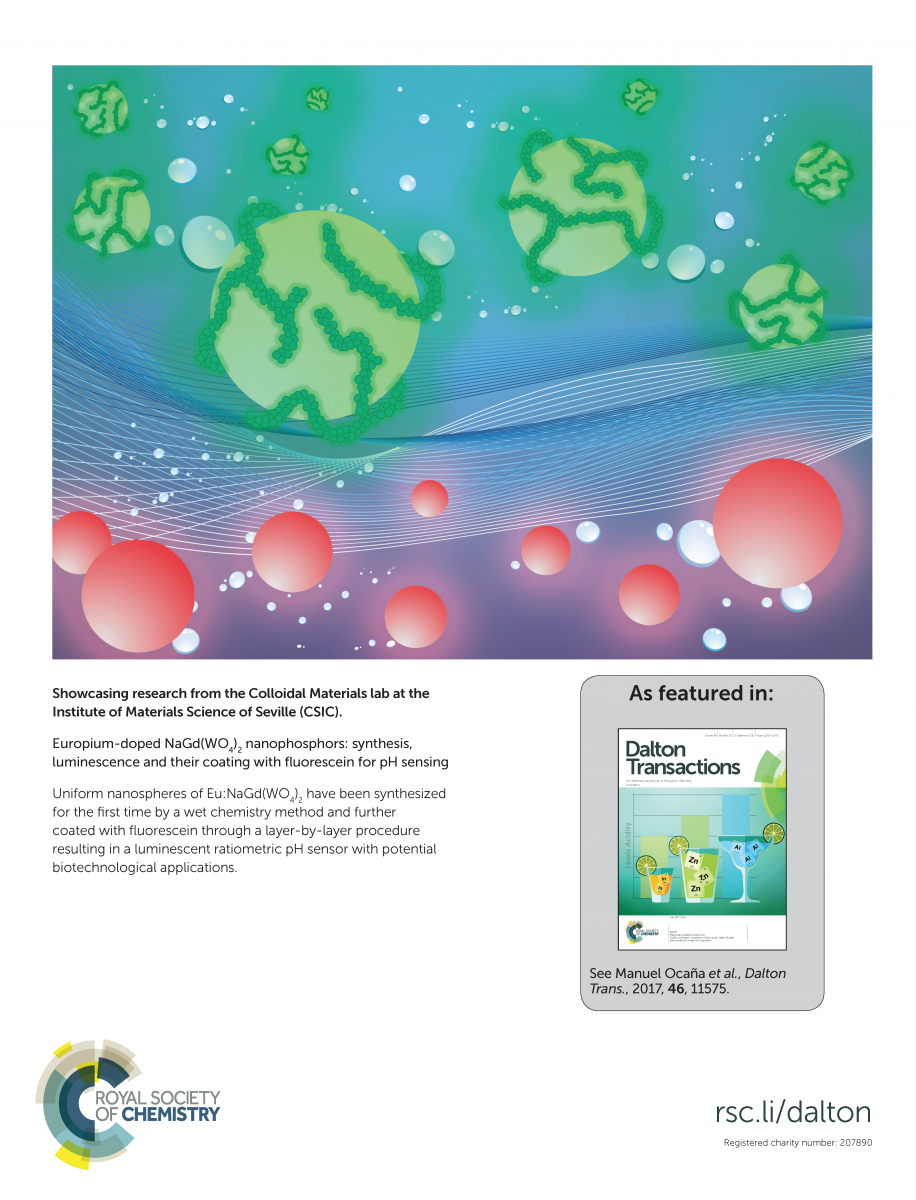
September, 2017 · DOI: 10.1039/c7dt01986f
Materiales Coloidales
Crystal structure, NIR luminescence and X-ray computed tomography of Nd3+:Ba0.3Lu0.7F2.7 nanospheres
Gonzalez-Mancebo, D; Becerro, AI; Cantelar, E; Cusso, F; Briat, A; Boyer, D; Ocana, MDalton Transactions, 46 (2017) 6580-6587 DOI: 10.1039/c7dt00453b

Abstract
Uniform, hydrophilic 50 nm diameter Nd3+-doped Ba0.3Lu0.7F2.7 nanospheres are synthesized at 120 degrees C using a singular one-pot method based on the use of ethylene glycol as solvent, in the absence of any additive. The composition and crystal structure of the undoped material are analyzed in detail using ICP and XRD, which reveals a BaF2 cubic crystal structure that is able to incorporate 70 mol% of Lu ions. This finding contrasts with the reported phase diagram of the system, where the maximum solubility is around 30 mol% Lu. XRD proves as well that the Ba0.3Lu0.7F2.7 structure is able to incorporate Nd3+ ions up to, at least 10 mol%, without altering the uniform particles morphology. The Nd-doped particles exhibit near-infrared luminescence when excited at 810 nm. The maximum emission intensity with the minimum concentration quenching effect is obtained at 1.5% Nd doping level. X-ray computed tomography experiments are carried out on powder samples of the latter composition. The sample significantly absorbs X-ray photons, thus demonstrating that the Nd3+-doped Ba0.3Lu0.7F2.7 nanospheres are good candidates as contrast agents in computed tomography.
August, 2017 · DOI: 10.1039/c7dt00453b
Materiales Ópticos Multifuncionales - Materiales Coloidales
Photonic Tuning of the Emission Color of Nanophosphor Films Processed at High Temperature
Geng, Dongling; Lozano, Gabriel; Calvo, Mauricio E.; Nunez, Nuria O.; Becerro, Ana I.; Ocana, Manuel; Miguez, HernanAdvanced Optical Materials, 5 (2017) art. 1700099 DOI: 10.1002/adom.201700099
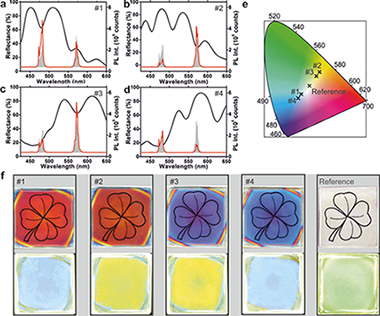
Abstract
Photonics offers new possibilities to tailor the photoluminescence process in phosphor-converted light emitting diodes. Herein, it is demonstrated that the emission color of thin layers of rare-earth doped nanocrystals can be strongly modulated in tunable spectral ranges using optical resonators specifically designed to this end. GdVO4:Dy3+ nanoparticles of controlled size and shape are synthesized using a solvothermal method with which highly transparent nanophosphor thin films are prepared. This paper designs and fabricates optical multilayers, which are transparent in the UV and resonant at the frequencies where the Dy3+ ions emit, to prove that the color coordinates of this emitter can be tuned from green to blue or yellow with unprecedented precision. Key to the achievement herein reported is the careful analysis of the structural and optical properties of thin nanophosphor layers with the processing temperature in order to achieve efficient photoluminescence while preserving the transparency of the film. The results open a new path for fundamental and applied research in solid-state lighting in which photonic nanostructures allow controlling the emission properties of state-of-the-art materials without altering their structure or chemical composition.
July, 2017 · DOI: 10.1002/adom.201700099
Materiales Ópticos Multifuncionales
Design and Realization of a Novel Optically Disordered Material: A Demonstration of a Mie Glass
Miranda-Munoz, Jose M.; Lozano, Gabriel; Miguez, HernanAdvanced Optical Materials, 5 (2017) art. 1700025 DOI: 10.1002/adom.201700025
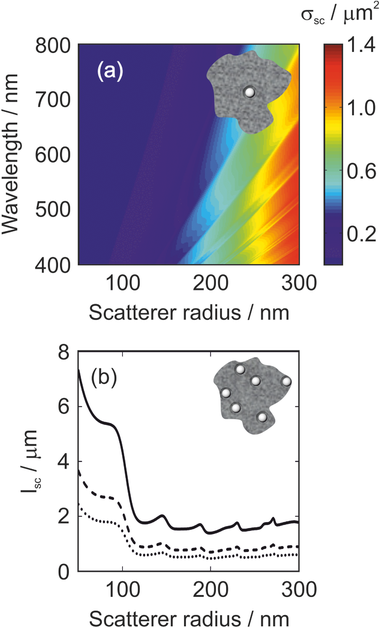
Abstract
Herein, a diffusive material presenting optical disorder is introduced, which represents an example of a Mie glass. Comprising spherical crystalline TiO2 nanoparticles randomly dispersed in a mesoporous TiO2 matrix, it is proved that the scattering of light in this inhomogeneous solid can be predicted in an unprecedented manner from single-particle considerations employing Mie theory. To that aim, a study of the dependence of the key parameters employed is performed to describe light propagation in random media, i.e., the scattering mean free path and the transport mean free path, as a function of the size and concentration of the spherical inclusions based on a comparison between experimental results and analytical calculations. It is also demonstrated that Mie glasses enable enhanced fluorescence intensity due to a combined absorptance enhancement of the excitation light combined with an improved outcoupling of the emitted light. The method offers the possibility to perform a deterministic design for the realization of a light diffuser with tailor-made scattering properties.
May, 2017 · DOI: 10.1002/adom.201700025
Tribología y Protección de Superficies - Materiales Ópticos Multifuncionales
Strong Quantum Confinement and Fast Photoemission Activation in CH3NH3PbI3 Perovskite Nanocrystals Grown within Periodically Mesostructured Films
Miguel Anaya; Andrea Rubino; Teresa Cristina Rojas; Juan Francisco Galisteo-López; Mauricio Ernesto Calvo; Hernán MíguezAdvanced Optical Materials, 5 (2017) 1601087 DOI: 10.1002/adom.201601087
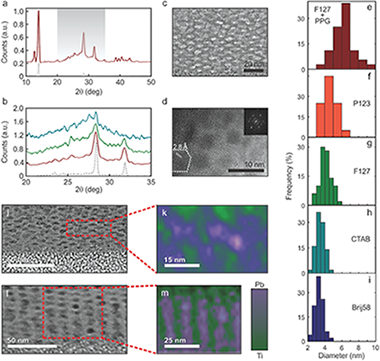
Abstract
In this Communication, a synthetic route is demonstrated to obtain stabilized MAPbI3 nanocrystals embedded in thin metal oxide films that display well-defined and adjustable quantum confinement effects over a wide range of 0.34 eV. Mesostructured TiO2 and SiO2 films displaying an ordered 3D pore network are prepared by evaporation-induced self-assembly of a series of organic supramolecular templates in the presence of metal oxide precursors. The pores in the inorganic films obtained after thermal annealing are then used as nanoreactors to synthesize MAPbI3crystallites with narrow size distribution and average radius comprised between 1 and 4 nm, depending on the template of choice. Both the static and dynamic photoemission properties of the ensemble display features distinctive of the regime of strong quantum confinement. Photoemission maps demonstrate that the spectral and intensity properties of the luminescence extracted from the perovskite quantum dot loaded films are homogeneous over squared centimeters areas. At variance with their bulk counterparts, constant emission intensity is reached in time scales at least four orders of magnitude shorter.
March, 2017 · DOI: 10.1002/adom.201601087
Materiales Coloidales
Morphology control of uniform CaMoO4 microarchitectures and development of white light emitting phosphors by Ln doping (Ln = Dy3+, Eu3+)
Laguna, Mariano; Nuñez, Nuria O.; Becerro, Ana I.; Ocaña, ManuelCrystengcomm, 19 (2017) 1590-1600 DOI: 10.1039/c6ce02611g

Abstract
A very simple synthesis procedure based on precipitation reactions at moderate temperature (120 degrees C) from solutions containing calcium nitrate and sodium molybdate, using mixed solvents (polyols and water) has been developed, which produces uniform tetragonal CaMoO4 microarchitectures with different morphologies (peanuts, cocoons, spindles and spheres) composed of self-assembled entities. The morphology and crystal size of such assemblies could be tuned by a simple change of the nature of the components of the solvent mixture or their volumetric ratio in such a mixture. All particles presented similar excitation and emission spectra arising from a charge transfer process within the MoO4 2-groups. The emitted light presented a bluish-green color and its intensity was higher for the spindle-type particles. This synthesis procedure was also suitable for doping peanut-like CaMoO4 architectures with Eu3+ or Dy3+ cations up to a 1% molar ratio (Ln/Ln + Ca), without altering their morphology or crystalline structure. The so prepared phosphors emitted an intense red (Eu-doped) or greenish (Dy-doped) light when excited through the MoO42- group excitation band, indicating the presence of an energy transfer process from such groups to the Ln(3+) cations. Finally, a white light emitting phosphor with chromaticity coordinates x = 0.335 and y = 0.365 and a correlated color temperature of 5407 K was developed by codoping peanut-type CaMoO4 particles with suitable amounts of Dy3+ (0.35%) and Eu3+ (0.15%) cations, which could find applications in white light emitting diodes.
March, 2017 · DOI: 10.1039/c6ce02611g
Materiales Coloidales
Diverse Applications of Nanomedicine
Pelaz, Beatriz; Alexiou, Christoph; Alvarez -Puebla, Ramon A.; Alves, Frauke; Andrews, Anne M.; Ashraf, Sumaira; Balogh, Lajos P.; Ballerini, Laura; Bestetti, Alessandra; Brendel, Cornelia; Bosi, Susanna; Carril, Monica; Chan, Warren C. W.; Chen, ChunyingACS Nano, 11 (2017) 2312-2381 DOI: 10.1021/acsnano.6b06040

Abstract
The design and use of materials in the nanoscale size range for addressing medical and health-related issues continues to receive increasing interest. Research in nanomedicine spans a multitude of areas, including drug delivery, vaccine development, antibacterial, diagnosis and imaging tools, wearable devices, implants, high-throughput screening platforms, etc. using biological, nonbiological, biomimetic, or hybrid materials. Many of these developments are starting to be translated into viable clinical products. Here, we provide an overview of recent developments in nanomedicine and highlight the current challenges and upcoming opportunities for the field and translation to the clinic.
March, 2017 · DOI: 10.1021/acsnano.6b06040
Materiales Ópticos Multifuncionales
Aperiodic Metal-Dielectric Multilayers as Highly Efficient Sunlight Reflectors
Alberto Jiménez-Solano; Miguel Anaya; Mauricio E. Calvo; Mercedes Alcon-Camas; Carlos Alcañiz; Elena Guillén; Noelia Martínez; Manuel Gallas; Thomas Preussner; Ramón Escobar-Galindo; Hernán MíguezAdvanced Optical Materials, 5 (2017) 1600833 DOI: 10.1002/adom.201600833
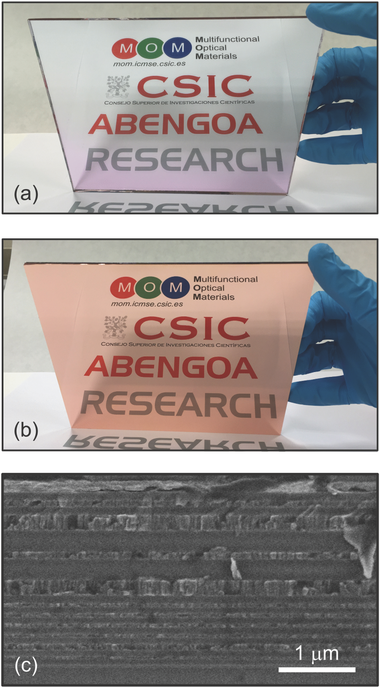
Abstract
The optimum reflection of the solar spectrum at well-defined incident directions as well as its durability in time are, both, fundamental requirements of the optics of thermosolar and photovoltaic energy conversion systems. The stringent high performance needed for these applications implies that, almost exclusively, second face mirrors based on silver are employed for this purpose. Herein, the possibility to develop solar mirrors using other metals, such as copper and aluminum, is theoretically and experimentally analyzed. It is found that reflectors based on these inexpensive metals are capable of reflecting the full solar spectrum with efficiencies comparable to that of silver-based reflectors. The designs herein proposed are based on aperiodic metal-dielectric multilayers whose optimized configuration is chosen employing a code based on a genetic algorithm that allows selecting the best one among 108 tested reflectors. The use of metals with wider spectral absorption bands is compensated by the use of multilayered designs in which metal absorption is almost suppressed, as the analysis of the electric field intensity distribution demonstrates. The feasibility of the proposed mirrors is demonstrated by their actual fabrication by large area deposition techniques amenable for mass production.
March, 2017 · DOI: 10.1002/adom.201600833
Materiales Coloidales
Comprehensive and Systematic Analysis of the Immunocompatibility of Polyelectrolyte Capsules
Zyuzin, MV; Diez, P; Goldsmith, M; Carregal-Romero, S; Teodosio, C; Rejman, J; Feliu, N; Escudero, A; Almendral, MJ; Linne, U; Peer, D; Fuentes, M; Parak, WJBioconjugate Chemistry, 28 (2017) 556-564 DOI: 10.1021/acs.bioconjchem.6b00657
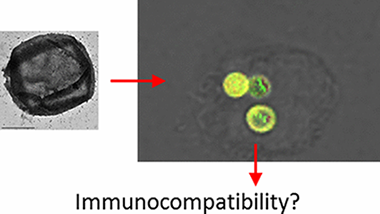
Abstract
The immunocompability of polyelectrolyte capsules synthesized by layer-by-layer deposition has been investigated. Capsules of different architecture and composed of either non-degradable or biodegradable polymers, with either positively or negatively charged outer surface, and with micrometer size, have been used, and the capsule uptake by different cell lines has been studied and quantified. Immunocompatibility studies were performed with peripheral blood mononuclear cells (PBMCs). Data demonstrate that incubation with capsules, at concentrations relevant for practical applications, did not result in a reduced viability of cells, as it did not show an increased apoptosis. Presence of capsules also did not result in an increased expression of TNF-α, as detected with antibody staining, as well as at mRNA level. It also did not result in increased expression of IL-6, as detected at mRNA level. These results indicate that the polyelectrolyte capsules used in this study are immunocompatible.
February, 2017 · DOI: 10.1021/acs.bioconjchem.6b00657
Materiales Ópticos Multifuncionales
Electron injection and scaffold effects in perovskite solar cells
M. Anaya, W. Zhang, B. Clasen Hames, Y. Li, F. Fabregat-Santiago, M.E. Calvo, H.J. Snaith, H. Míguez, I. Mora-SeróJournal of Materials Chemistry C, 5 (2017) 634-644 DOI: 10.1039/C6TC04639H

Abstract
In spite of the impressive efficiencies reported for perovskite solar cells (PSCs), key aspects of their working principles, such as electron injection at the contacts or the suitability of the utilization of a specific scaffold layer, are not yet fully understood. Increasingly complex scaffolds attained by the sequential deposition of TiO2 and SiO2 mesoporous layers onto transparent conducting substrates are used to perform a systematic characterization of both the injection process at the electron selective contact and the scaffold effect in PSCs. By forcing multiple electron injection processes at a controlled sequence of perovskite–TiO2 interfaces before extraction, interfacial injection effects are magnified and hence characterized in detail. An anomalous injection behavior is observed, the fingerprint of which is the presence of significant inductive loops in the impedance spectra with a magnitude that correlates with the number of interfaces in the scaffold. Analysis of the resistive and capacitive behavior of the impedance spectra indicates that the scaffolds could hinder ion migration, with positive consequences such as lowering the recombination rate and implications for the current–potential curve hysteresis. Our results suggest that an appropriate balance between these advantageous effects and the unavoidable charge transport resistive losses introduced by the scaffolds will help in the optimization of PSC performance.
January, 2017 · DOI: 10.1039/C6TC04639H
Materiales Coloidales
Luminescent Eu-doped GdVO4 nanocrystals as optical markers for anti-counterfeiting purposes
Moretti, E; Pizzol, G; Fantin, M; Enrichi, F; Scopece, P; Ocana, M; Polizzi, SChemical Papers, 71 (2017) 149-159 DOI: 10.1007/s11696-016-0081-8
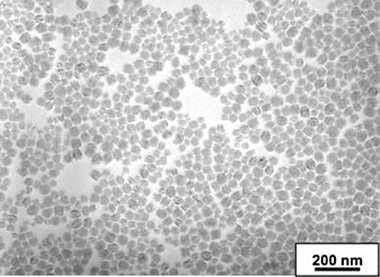
Abstract
Luminescent Eu: GdVO4 nanoparticles, with an average size of 60 nm, were deposited first on monocrystalline silicon wafers, then on four different natural stone materials, by a spray-coating technique and a silica layer was subsequently deposited by atmospheric pressure plasma jet to protect the luminescent layer and improve its adhesion to the substrate. The luminescent films were characterized by photoluminescence excitation and emission, while the surface morphology was examined by FEGSEM microscopy and spectroscopic ellipsometry to determine the coating thickness. The optical appearance of the coatings was also evaluated by colorimetric measurements and the efficacy of the fixing action of the silica layer was estimated by PL measurements performed before and after a Scotch TM tape peeling test. The proposed methodology, easily applied on the surface of stone supports, has led to the realization of a luminescent film displaying good mechanical properties, transparent and undetectable in the presence of visible light, but easily activated by UV light source, indicating that the Eu: GdVO4 nanophosphors could be used as luminescent nanotags for a reliable anti-counterfeiting technology.
January, 2017 · DOI: 10.1007/s11696-016-0081-8
2016
2016
Materiales Ópticos Multifuncionales
Three-Dimensional Optical Tomography and Correlated Elemental Analysis of Hybrid Perovskite Microstructures: An Insight into Defect-Related Lattice Distortion and Photoinduced Ion Migration
Galisteo-Lopez, JF; Li, YL; Miguez, HJournal of Physical Chemistry Letters, 7 (2016) 5227-5234 DOI: 10.1021/acsjpclett.6b02456
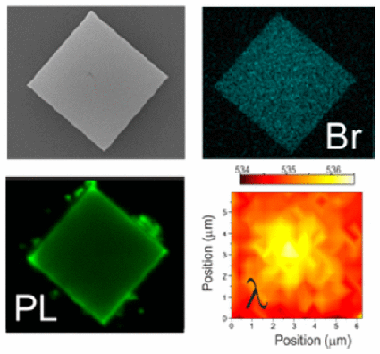
Abstract
Organic lead halide perovskites have recently been proposed for applications in light-emitting devices of different sorts. More specifically, regular crystalline microstructures constitute an efficient light source and fulfill the geometrical requirements to act as resonators, giving rise to waveguiding and optical amplification. Herein we show three-dimensional laser scanning confocal tomography studies of different types of methylammonium lead bromide microstructures which have allowed us to dissect their photoemission properties with a precision of 0.036 mu m(3). This analysis shows that their spectral emission presents strong spatial variations which can be attributed to defect-related lattice distortions. It is also largely enhanced under light exposure, which triggers the migration of halide ions away from illuminated regions, eventually leading to a strongly anisotropic degradation. Our work points to the need for performing an optical quality test of individual crystallites prior to their use in optoelectronics devices and provides a means to do so.
December, 2016 · DOI: 10.1021/acsjpclett.6b02456
Materiales Coloidales
Multifunctional Eu-doped NaGd(MoO4)(2) nanoparticles functionalized with poly(L-lysine) for optical and MRI imaging
M. Laguna; N.O. Nuñez; V. Rodríguez; E. Cantelar, G. Stepien, M.L. García, J.M. de la Fuente; M. OcañaDalton Transactions, 45 (2016) 16354-16365 DOI: 10.1039/c6dt02663j
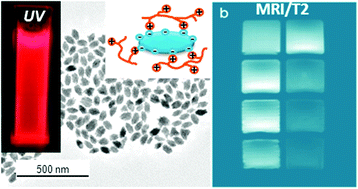
Abstract
A method for the synthesis of non-aggregated and highly uniform Eu3+ doped NaGd(MoO4)(2) nanoparticles is reported for the first time. The obtained particles present tetragonal structure, ellipsoidal shape and their size can be varied by adjusting the experimental synthesis parameters. These nanoparticles, which were coated with citrate anions and functionalised with PLL, have also been developed in order to improve their colloidal stability in physiological medium (2-(N-morpholino) ethanesulfonic acid, MES). A study of the luminescent dynamics of the samples as a function of the Eu doping level has been conducted in order to find the optimum nanophosphors, whose magnetic relaxivity and cell viability have also been evaluated for the first time for this system, in order to assess their suitability as multifunctional probes for optical (in vitro) and magnetic bioimaging applications.
November, 2016 · DOI: 10.1039/c6dt02663j
Materiales Coloidales
Optical sensing by integration of analyte-sensitive fluorophore to particles
Carrillo-Carrion, C; Escudero, A; Parak, WJTrAC Trends in Analytical Chemistry, 84 (2016) 84-85 DOI: 10.1016/j.trac.2016.05.001
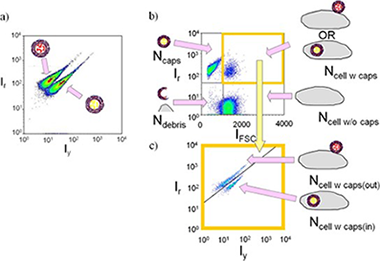
Abstract
Analyte-sensitive fluorophores are a common tool in analytical chemistry. In case they are conjugated to the surface of colloidal nanoparticles new or improved applications are possible. An overview of the potential of such fluorophore-particle conjugates is given by means of several examples. First, using pH-sensitive fluorophores attached to particles are a helpful tool for investigating particle uptake by cells, as they can indicate whether particles are in the neutral slightly alkaline extracellular medium, or in acidic intracellular vesicles after endocytosis. Second, relating to lifetime-based methodologies, the fluorescence resonance energy transfer between fluorophores attached to quantum dots leads to longer lifetimes, improving their performance and expanding the possibilities of methods, such as lifetime imaging for in vivo applications. It also can be exploited for multiplexing approaches, in which the effective lifetime of the fluorophores can be tuned, allowing thus for the detection of several analytes based on temporal discrimination. Attention is focused to these three areas of application, because they are among the most reported in recent literature, and therefore of particular interest.
November, 2016 · DOI: 10.1016/j.trac.2016.05.001
Materiales Coloidales
Quantitative uptake of colloidal particles by cell cultures
Feliu, N; Huhn, J; Zyuzin, MV; Ashraf, S; Valdeperez, D; Masood, A; Said, AH; Escudero, A; Pelaz, B; Gonzalez, E; Duarte, MAC; Roy, S; Chakraborty, I; Lim, ML; Sjoqvist, S; Jungebluth, P; Parak, WJScience of the Total Environment, 568 (2016) 819-828 DOI: 10.1016/j.scitotenv.2016.05.213

Abstract
The use of nanotechnologies involving nano-and microparticles has increased tremendously in the recent past. There are various beneficial characteristics that make particles attractive for a wide range of technologies. However, colloidal particles on the other hand can potentially be harmful for humans and environment. Today, complete understanding of the interaction of colloidal particles with biological systems still remains a challenge. Indeed, their uptake, effects, and final cell cycle including their life span fate and degradation in biological systems are not fully understood. This is mainly due to the complexity of multiple parameters which need to be taken in consideration to perform the nanosafety research. Therefore, we will provide an overview of the common denominators and ideas to achieve universal metrics to assess their safety. The review discusses aspects including how biological media could change the physicochemical properties of colloids, how colloids are endocytosed by cells, how to distinguish between internalized versus membrane-attached colloids, possible correlation of cellular uptake of colloids with their physicochemical properties, and how the colloidal stability of colloids may vary upon cell internalization. In conclusion three main statements are given. First, in typically exposure scenarios only part of the colloids associated with cells are internalized while a significant part remain outside cells attached to their membrane. For quantitative uptake studies false positive counts in the form of only adherent but not internalized colloids have to be avoided. pH sensitive fluorophores attached to the colloids, which can discriminate between acidic endosomal/lysosomal and neutral extracellular environment around colloids offer a possible solution. Second, the metrics selected for uptake studies is of utmost importance. Counting the internalized colloids by number or by volume may lead to significantly different results. Third, colloids may change their physicochemical properties along their life cycle, and appropriate characterization is required during the different stages.
October, 2016 · DOI: 10.1016/j.scitotenv.2016.05.213
Materiales Coloidales
Microstructural, spectroscopic, and antibacterial properties of silver-based hybrid nanostructures biosynthesized using extracts of coriander leaves and seeds
Luna, C; Barriga-Castro, ED; Gomez-Trevino, A; Nuñez, NO; Mendoza-Resendez, RInternational Journal of Nanomedicine, 11 (2016) 4787-4798 DOI: 10.2147/IJN.S105166
Abstract
Coriander leaves and seeds have been highly appreciated since ancient times, not only due to their pleasant flavors but also due to their inhibitory activity on food degradation and their beneficial properties for health, both ascribed to their strong antioxidant activity. Recently, it has been shown that coriander leaf extracts can mediate the synthesis of metallic nanoparticles through oxidation/reduction reactions. In the present study, extracts of coriander leaves and seeds have been used as reaction media for the wet chemical synthesis of ultrafine silver nanoparticles and nanoparticle clusters, with urchin-and tree-like shapes, coated by biomolecules (mainly, proteins and polyphenols). In this greener route of nanostructure preparation, the active biocompounds of coriander simultaneously play the roles of reducing and stabilizing agents. The morphological and microstructural studies of the resulting biosynthesized silver nanostructures revealed that the nanostructures prepared with a small concentration of the precursor Ag salt (AgNO3 =5 mM) exhibit an ultrafine size and a narrow size distribution, whereas particles synthesized with high concentrations of the precursor Ag salt (AgNO3 =0.5 M) are polydisperse and formation of supramolecular structures occurs. Fourier transform infrared and Raman spectroscopy studies indicated that the bioreduction of the Ag- ions takes place through their interactions with free amines, carboxylate ions, and hydroxyl groups. As a consequence of such interactions, residues of proteins and polyphenols cap the biosynthesized Ag nanoparticles providing them a hybrid core/shell structure. In addition, these biosynthesized Ag nanomaterials exhibited size-dependent plasmon extinction bands and enhanced bactericidal activities against both Gram-positive and Gram-negative bacteria, displaying minimal inhibitory Ag concentrations lower than typical values reported in the literature for Ag nanoparticles, probably due to the synergy of the bactericidal activities of the Ag nanoparticle cores and their capping ligands.
September, 2016 · DOI: 10.2147/IJN.S105166
Materiales Coloidales
Confinement and surface effects on the physical properties of rhombohedral-shape hematite (alpha-Fe2O3) nanocrystals
Luna, C; Cuan-Guerra, AD; Barriga-Castro, ED; Nunez, NO; Mendoza-Resendez, RMaterials Research Bulletin, 80 (2016) 44-52 DOI: 10.1016/j.materresbull.2016.03.029
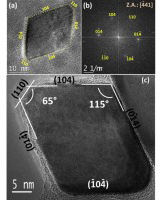
Abstract
Morphological, microstructural and vibrational properties of hematite (alpha-Fe2O3) nanocrystals with a rhombohedral shape and rounded edges, obtained by forced hydrolysis of iron(III) solutions under a fast nucleation, have been investigated in detail as a function of aging time. These studies allowed us to propose a detailed formation mechanism and revealed that these nanocrystals are composed of four {104} side facets, two {110} faces at the edges of the long diagonal of the nanocrystals and two {-441} facets as the top and bottom faces. Also, the presence of nanoscopic pores and fissures was evidenced. The vibrational bands of such nanocrystals were shifted to lower frequencies in comparison with bulk hematite ones as the nanocrystal size was reduced due to phonon confinement effects. Also, the indirect and direct transition band gaps displayed interesting dependences on the aging time arising from quantum confinementand surface effects
August, 2016 · DOI: 10.1016/j.materresbull.2016.03.029
Materiales Ópticos Multifuncionales
Cellular Viscosity in Prokaryotes and Thermal Stability of Low Molecular Weight Biomolecules
Cuecas, A; Cruces, J; Galisteo-Lopez, JF; Peng, XJ; Gonzalez, JMBiophysical Journal, 111 (2016) 875–882 DOI: 10.1016/j.bpj.2016.07.024
Abstract
Some low molecular weight biomolecules, i.e., NAD(P)H, are unstable at high temperatures. The use of these biomolecules by thermophilic microorganisms has been scarcely analyzed. Herein, NADH stability has been studied at different temperatures and viscosities. NADH decay increased at increasing temperatures. At increasing viscosities, NADH decay rates decreased. Thus, maintaining relatively high cellular viscosity in cells could result in increased stability of low molecular weight biomolecules (i.e., NADH) at high temperatures, unlike what was previously deduced from studies in diluted water solutions. Cellular viscosity was determined using a fluorescent molecular rotor in various prokaryotes covering the range from 10 to 100°C. Some mesophiles showed the capability of changing cellular viscosity depending on growth temperature. Thermophiles and extreme thermophiles presented a relatively high cellular viscosity, suggesting this strategy as a reasonable mechanism to thrive under these high temperatures. Results substantiate the capability of thermophiles and extreme thermophiles (growth range 50–80°C) to stabilize and use generally considered unstable, universal low molecular weight biomolecules. In addition, this study represents a first report, to our knowledge, on cellular viscosity measurements in prokaryotes and it shows the dependency of prokaryotic cellular viscosity on species and growth temperature.
August, 2016 · DOI: 10.1016/j.bpj.2016.07.024
Materiales Coloidales
Luminescent Rare-earth-based Nanoparticles: A Summarized Overview of their Synthesis, Functionalization, and Applications
Escudero, A; Carrillo-Carrion, C; Zyuzin, MV; Parak, WJTopics in current chemistry, 374 (2016) Article number 48 DOI: 10.1007/s41061-016-0049-8
Abstract
Rare-earth-based nanoparticles are currently attracting wide research interest in material science, physics, chemistry, medicine, and biology due to their optical properties, their stability, and novel applications. We present in this review a summarized overview of the general and recent developments in their synthesis and functionalization. Their luminescent properties are also discussed, including the latest advances in the enhancement of their emission luminescence. Some of their more relevant and novel biomedical, analytical, and optoelectronic applications are also commented on.
August, 2016 · DOI: 10.1007/s41061-016-0049-8
Materiales Ópticos Multifuncionales
Modified emission of extended light emitting layers by selective coupling to collective lattice resonances
Ramezani, Mohammad; Lozano, Gabriel; Verschuuren, Marc A.; Gomez-Rivas, JaimePhysical Review B, 94 (2016) 12 DOI: 10.1103/PhysRevB.94.125406

Abstract
We demonstrate that the coupling between light emitters in extended polymer layers and modes supported by arrays of plasmonic particles can be selectively enhanced by accurate positioning of the emitters in regions where the electric field intensity of a given mode is maximized. The enhancement, which we measure to reach up to 70%, is due to the improved spatial overlap and coupling between the optical mode and emitters. This improvement of the coupling leads to a modification of the emission spectrum and the luminous efficacy of the sample.
August, 2016 · DOI: 10.1103/PhysRevB.94.125406
Materiales Ópticos Multifuncionales
Optical analysis of CH3NH3SnxPb1−xI3 absorbers: a roadmap for perovskite-on-perovskite tandem solar cells
Anaya, M.; Correa-Baena, J.P.; Lozano, G.; Saliba, M.; Anguita, P.; Roose, B.; Abate, A.; Steiner, U.; Gratzel, M.; Calvo, M.E.; Hagfeldt, A.; Míguez, H.Journal lf Materials Chemistry A, 4 (2016) 11214-11221 DOI: 10.1039/C6TA04840D
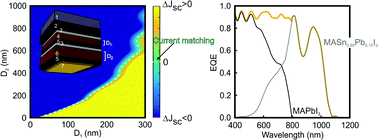
Abstract
Organic–inorganic perovskite structures in which lead is substituted by tin are exceptional candidates for broadband light absorption. Herein we present a thorough analysis of the optical properties of CH3NH3SnxPb1−xI3 films, providing the field with definitive insights about the possibilities of these materials for perovskite solar cells of superior efficiency. We report a user's guide based on the first set of optical constants obtained for a series of tin/lead perovskite films, which was only possible to measure due to the preparation of optical quality thin layers. According to the Shockley–Queisser theory, CH3NH3xPb1−xI3 compounds promise a substantial enhancement of both short circuit photocurrent and power conversion efficiency in single junction solar cells. Moreover, we propose a novel tandem architecture design in which both top and bottom cells are made of perovskite absorbers. Our calculations indicate that such perovskite-on-perovskite tandem devices could reach efficiencies over 35%. Our analysis serves to establish the first roadmap for this type of cells based on actual optical characterization data. We foresee that this study will encourage the research on novel near-infrared perovskite materials for photovoltaic applications, which may have implications in the rapidly emerging field of tandem devices.
August, 2016 · DOI: 10.1039/C6TA04840D
Materiales Ópticos Multifuncionales
Unbroken Perovskite: Interplay of Morphology, Electro-optical Properties, and Ionic Movement
Correa-Baena, JP; Anaya, M; Lozano, G; Tress, W; Domanski, K; Saliba, M; Matsui, T; Jacobsson, TJ; Calvo, ME; Abate, A; Gratzel, M; Miguez, H; Hagfeldt, AAdvanced Materials, 28 (2016) 5031-5037 DOI: 10.1002/adma.201600624
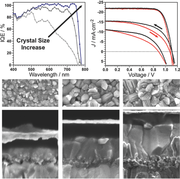
Abstract
Hybrid organic-inorganic perovskite materials have risen up as leading components for light-harvesting applications. However, to date many questions are still open concerning the operation of perovskite solar cells (PSCs). A systematic analysis of the interplay among structural features, optoelectronic performance, and ionic movement behavior for FA(0.83)MA(0.17)Pb(I0.83Br0.17)(3) PSCs is presented, which yield high power conversion efficiencies up to 20.8%.
July, 2016 · DOI: 10.1002/adma.201600624
Materiales Coloidales
Synthesis and functionalization of monodisperse near-ultraviolet and visible excitable multifunctional Eu3+, Bi3+:REVO4 nanophosphors for bioimaging and biosensing applications
Escudero, Alberto; Carrillo-Carrion, Carolina; Zyuzin, Mikhail V.; Ashraf, Sumaira; Hartmann, Raimo; Nunez, Nuria O.; Ocana, Manuel; Parak, Wolfgang J.Nanoscale, 8 (2016) 12221-12236 DOI: 10.1039/C6NR03369E
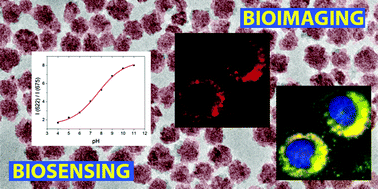
Abstract
Near-ultraviolet and visible excitable Eu- and Bi-doped NPs based on rare earth vanadates (REVO4, RE = Y, Gd) have been synthesized by a facile route from appropriate RE precursors, europium and bismuth nitrate, and sodium orthovanadate, by homogeneous precipitation in an ethylene glycol/water mixture at 120 °C. The NPs can be functionalized either by a one-pot synthesis with polyacrylic acid (PAA) or by a Layer-by-Layer approach with poly(allylamine hydrochloride) (PAH) and PAA. In the first case, the particle size can also be tuned by adjusting the amount of PAA. The Eu- Bi-doped REVO4 based nanophosphors show the typical red luminescence of Eu(III), which can be excited through an energy transfer process from the vanadate anions, resulting in a much higher luminescence intensity in comparison to the direct excitation of the europium cations. The incorporation of Bi into the REVO4 structure shifts the original absorption band of the vanadate anions towards longer wavelengths, giving rise to nanophosphors with an excitation maximum at 342 nm, which can also be excited in the visible range. The suitability of such nanophosphors for bioimaging and biosensing applications, as well as their colloidal stability in different buffer media of biological interest, their cytotoxicity, their degradability at low pH, and their uptake by HeLa cells have been evaluated. Their suitability for bioimaging and biosensing applications is also demonstrated.
June, 2016 · DOI: 10.1039/C6NR03369E
Materiales Ópticos Multifuncionales
Plasmonic Nanoparticles as Light-Harvesting Enhancers in Perovskite Solar Cells: A User’s Guide
Carretero-Palacios, S.; Jiménez-Solano, A.; Míguez, H.ACS Energy Letters, 1 (2016) 323-331 DOI: 10.1021/acsenergylett.6b00138

Abstract
In this Perspective we discuss the implications of employing metal particles of different shape, size, and composition as absorption enhancers in methylammonium lead iodide perovskite solar cells, with the aim of establishing some guidelines for the future development of plasmonic resonance-based photovoltaic devices. Hybrid perovskites present an extraordinarily high absorption coefficient which, as we show here, makes it difficult to extrapolate concepts and designs that are applied to other solution-processed photovoltaic materials. In addition, the variability of the optical constants attained from perovskite films of seemingly similar composition further complicates the analysis. We demonstrate that, by means of rigorous design, it is possible to provide a realistic prediction of the magnitude of the absorption enhancement that can be reached for perovskite films embedding metal particles. On the basis of this, we foresee that localized surface plasmon effects will provide a means to attain highly efficient perovskite solar cells using films that are thinner than those usually employed, hence facilitating collection of photocarriers and significantly reducing the amount of potentially toxic lead present in the device.
June, 2016 · DOI: 10.1021/acsenergylett.6b00138
Materiales Ópticos Multifuncionales
Metallic nanostructures for efficient LED lighting
Lozano, G; Rodriguez, SRK; Verschuuren, MA; Rivas, JGLight: Science and Applications, 5 (2016) e16080 DOI: 10.1038/lsa.2016.80
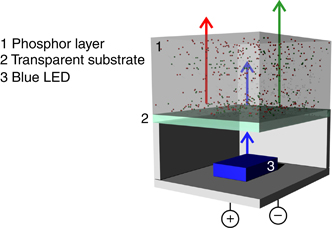
Abstract
Light-emitting diodes (LEDs) are driving a shift toward energy-efficient illumination. Nonetheless, modifying the emission intensities, colors and directionalities of LEDs in specific ways remains a challenge often tackled by incorporating secondary optical components. Metallic nanostructures supporting plasmonic resonances are an interesting alternative to this approach due to their strong light-matter interaction, which facilitates control over light emission without requiring external secondary optical components. This review discusses new methods that enhance the efficiencies of LEDs using nanostructured metals. This is an emerging field that incorporates physics, materials science, device technology and industry. First, we provide a general overview of state-of-the-art LED lighting, discussing the main characteristics required of both quantum wells and color converters to efficiently generate white light. Then, we discuss the main challenges in this field as well as the potential of metallic nanostructures to circumvent them. We review several of the most relevant demonstrations of LEDs in combination with metallic nanostructures, which have resulted in light-emitting devices with improved performance. We also highlight a few recent studies in applied plasmonics that, although exploratory and eminently fundamental, may lead to new solutions in illumination.
June, 2016 · DOI: 10.1038/lsa.2016.80
Materiales Ópticos Multifuncionales
Solution processed high refractive index contrast distributed Bragg reflectors
Anaya, M; Rubino, A; Calvo, ME; Miguez, HJournal of Materials Chemistry C, 4 (2016) 4532-4537 DOI: 10.1039/C6TC00663A

Abstract
We have developed a method to alternate porous and dense dielectric films in order to build high refractive index contrast distributed Bragg reflectors (DBRs) capable of reflecting very efficiently in a targeted spectral range employing a small number of layers in the stack. Porous layers made of SiO2 nanoparticles and compact sol–gel processed TiO2 layers are sequentially deposited. The key to the preservation of porosity of every other layer during the deposition process is the use of a sacrificial layer of polystyrene that prevents the infiltration of the interstitial voids between nanoparticles with the homogeneous solution of TiO2 precursors. Our approach allows preparing a series of DBRs operating along the whole visible spectral range. Reflectance values as high as 90% are achieved from only seven layers. The particular distribution of porosity along one direction gives rise to an interesting interplay between the optical properties of the system and the vapor pressure in the surrounding atmosphere, which we foresee could be put into practice in gas sensing devices.
May, 2016 · DOI: 10.1039/C6TC00663A
Materiales Ópticos Multifuncionales
A panchromatic modification of the light absorption spectra of metal-organic frameworks
Otal, E. H.; Kim, M. L.; Calvo, M. E.; Karvonen, L.; Fabregas, I. O.; Sierra, C. A.; Hinestroza, J. P.Chemical Communications, 52 (2016) 6665-6668 DOI: 10.1039/c6cc02319c
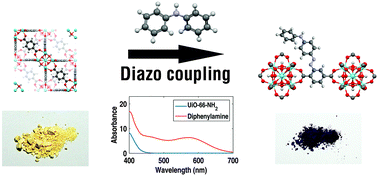
Abstract
The optical absorption of UiO-66–NH2 MOF was red-shifted using a diazo-coupling reaction. The modifications performed with naphthols and aniline yielded reddish samples, and the modifications with diphenylaniline yielded dark violet ones. The photocatalytic activity of these modified MOFs was assessed for methylene blue degradation, showing a good performance relative to traditional TiO2. The degradation performance was found to correlate with the red shift of the absorption edge. These findings suggest potential applications of these materials in photocatalysis and in dye sensitized solar cells.
May, 2016 · DOI: 10.1039/c6cc02319c
Materiales Ópticos Multifuncionales
Effect of temperature variations on equilibrium distances in levitating parallel dielectric plates interacting through Casimir forces
Esteso, V; Carretero-Palacios, S; Miguez, HJournal of Applied Physics, 119 (2016) 144301 DOI: 10.1063/1.4945428
Abstract
We study at thermal equilibrium the effect of temperature deviations around room temperature on the equilibrium distance (d(eq)) at which thin films made of Teflon, silica, or polystyrene immersed in glycerol levitate over a silicon substrate due to the balance of Casimir, gravity, and buoyancy forces. We find that the equilibrium nature (stable or unstable) of d(eq) is preserved under temperature changes, and provide simple rules to predict whether the new equilibrium position will occur closer to or further from the substrate at the new temperature. These rules depend on the static permittivities of all materials comprised in the system (epsilon((m))(0)) and the equilibrium nature of d(eq). Our designed dielectric configuration is excellent for experimental observation of thermal effects on the Casimir force indirectly detected through the tunable equilibrium distances (with slab thickness and material properties) in levitation mode.
April, 2016 · DOI: 10.1063/1.4945428
Materiales Coloidales
Transparent polycrystalline SrREGa3O7 melilite ceramics: potential phosphors for tuneable solid state lighting
Boyer, M; Carrion, AJF; Ory, S; Becerro, AI; Villette, S; Eliseeva, SV; Petoud, S; Aballea, P; Matzen, G; Allix, MJournal of Materials Chemistry C, 15 (2016) 3238-3247 DOI: 10.1039/C6TC00633G
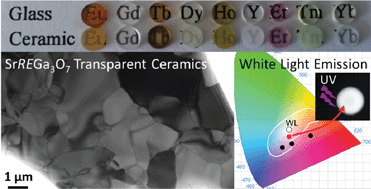
Abstract
Full and congruent crystallization from glass is applied to the SrREGa3O7 melilite family (RE = Eu, Gd, Tb, Dy, Ho, Er, Tm, Yb and Y). This innovative process enables the synthesis of polycrystalline ceramics exhibiting high transparency both in the visible and near infrared regions, despite tetragonal crystal structures and micrometer scale grain sizes. Moreover, glass crystallization provides an original route to synthesize new crystalline phases which are not accessible via a classic solid state reaction, as demonstrated for SrYbGa3O7 and SrTmGa3O7. To illustrate the potential optical applications of such materials, SrGdGa3O7 transparent polycrystalline ceramics are doped with Dy3+ or Tb3+/Eu3+ in order to generate white light emission under UV excitation. It is foreseen that such transparent melilite ceramic phosphors, prepared via a cost-effective process, can be successfully used in solid state lighting devices of considerable technological interest.
April, 2016 · DOI: 10.1039/C6TC00633G
Materiales Ópticos Multifuncionales
High-Throughput Fabrication of Resonant Metamaterials with Ultrasmall Coaxial Apertures via Atomic Layer Lithography
Yoo, D; Nguyen, NC; Martin-Moreno, L; Mohr, DA; Carretero-Palacios, S; Shaver, J; Peraire, J; Ebbesen, TW; Oh, SHNano Letters, 16 (2016) 2040-2046 DOI: 10.1021/acs.nanolett.6b00024
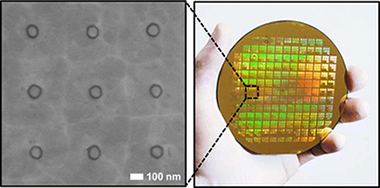
Abstract
We combine atomic layer lithography and glancing angle ion polishing to create wafer-scale metamaterials composed of dense arrays of ultrasmall coaxial nanocavities in gold films. This new fabrication scheme makes it possible to shrink the diameter and increase the packing density of 2 nm-gap coaxial resonators, an extreme subwavelength structure first manufactured via atomic layer lithography, both by a factor of 100 with respect to previous studies. We demonstrate that the nonpropagating zeroth-order Fabry-Perot mode, which possesses slow light-like properties at the cutoff resonance, traps infrared light inside 2 nm gaps (gap volume similar to lambda(3)/10(6)). Notably, the annular gaps cover only 3% or less of the metal surface, while open-area normalized transmission is as high as 1700% at the epsilon-near-zero (ENZ) condition. The resulting energy accumulation alongside extraordinary optical transmission can benefit applications in nonlinear optics, optical trapping, and surface-enhanced spectroscopies. Furthermore, because the resonance wavelength is independent of the cavity length and dramatically red shifts as the gap size is reduced, large-area arrays can be constructed with lambda(resonance) >> period, making this fabrication method ideal for manufacturing resonant metamaterials.
March, 2016 · DOI: 10.1021/acs.nanolett.6b00024
Materiales Ópticos Multifuncionales
Integration of Photonic Crystals into Flexible Dye Solar Cells: A Route toward Bendable and Adaptable Optoelectronic Devices Displaying Structural Color and Enhanced Efficiency
Li, YL; Calvo, ME; Miguez, HAdvanced Optical Materials, 4 (2016) 464-471 DOI: 10.1002/adom.201500547
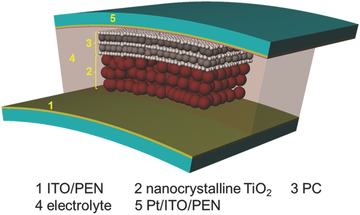
Abstract
Herein is presented what is believed to be the first example of integration of photonic structures in a flexible optoelectronic device. The resulting devices may be designed to display any color in the visible range and, simultaneously, present enhanced power conversion efficiency as a consequence of the increased light harvesting caused by the colored back reflection. The achievement results from the incorporation of nanoparticle-based multilayers with photonic crystal properties that are modified to be compatible with the chemical and physical processing of flexible nanocrystalline titania electrodes of dye solar cells. The photovoltaic performance of these colored flexible cells remains unaltered after one hundred bending cycles, thus showing the high-mechanical stability of the ensemble. These devices reunite most characteristics required for building integration or for the construction of solar window panes, such as light weight, stability upon bending, adaptability, and color. This work may trigger promising applications of these highly adaptable and versatile photonic crystals in other flexible devices.
March, 2016 · DOI: 10.1002/adom.201500547
Materiales Ópticos Multifuncionales
Photophysical Analysis of the Formation of Organic–Inorganic Trihalide Perovskite Films: Identification and Characterization of Crystal Nucleation and Growth
Anaya, M; Galisteo-Lopez, JF; Calvo, ME; Lopez, C; Miguez, HJournal of Physical Chemistry C, 120 (2016) 3071-3076 DOI: 10.1021/acs.jpcc.6b00398
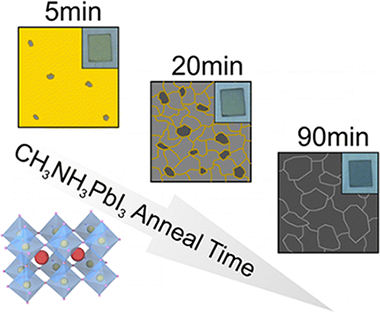
Abstract
In this work we demonstrate that the different processes occurring during hybrid organic–inorganic lead iodide perovskite film formation can be identified and analyzed by a combined in situ analysis of their photophysical and structural properties. Our observations indicate that this approach permits unambiguously identifying the crystal nucleation and growth regimes that lead to the final material having a cubic crystallographic phase, which stabilizes to the well-known tetragonal phase upon cooling to room temperature. Strong correlation between the dynamic and static photoemission results and the temperature-dependent X-ray diffraction data allows us to provide a description and to establish an approximate time scale for each one of the stages and their evolution. The combined characterization approach herein explored yields key information about the kinetics of the process, such as the link between the evolution of the defect density during film formation, revealed by a fluctuating photoluminescence quantum yield, and the gradual changes observed in the PbI2-related precursor structure.
February, 2016 · DOI: 10.1021/acs.jpcc.6b00398
Materiales Ópticos Multifuncionales
Maximized performance of dye solar cells on plastic: a combined theoretical and experimental optimization approach
Li, Yuelong; Carretero-Palacios, Sol; Yoo, Kicheon; Kim, Jong Hak; Jimenez-Solano, Alberto; Lee, Chul-Ho; Miguez, Hernan; Ko, Min JaeEnergy & Environmental Science, 9 (2016) 2061-2071 DOI: 10.1039/C6EE00424E
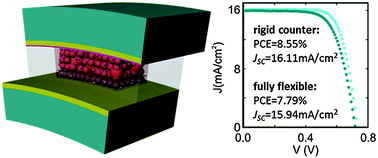
Abstract
We demonstrate that a combined optimization approach based on the sequential alternation of theoretical analysis and experimental realization gives rise to plastic supported dye solar cells for which both light harvesting efficiency and electron collection are maximized. Rationalized configurations with optimized light trapping and charge extraction are realized to achieve photoanodes on plastic prepared at low temperature, showing a power conversion efficiency of 8.55% and a short circuit photocurrent of 16.11 mA cm−2, unprecedented for plastic based dye solar cell devices. Furthermore, the corresponding fully flexible designs present stable mechanical properties after several bending cycles, displaying 7.79% power conversion efficiency, an average broadband internal quantum efficiency above 90%, and a short circuit photocurrent of 15.94 mA cm−2, which is the largest reported value for bendable cells of this sort to date.
February, 2016 · DOI: 10.1039/C6EE00424E
Materiales Coloidales
Ligand-Free Synthesis of Tunable Size Ln:BaGdF5 (Ln = Eu3+ and Nd3+) Nanoparticles: Luminescence, Magnetic Properties, and Biocompatibility
Becerro, AI; Gonzalez-Mancebo, D; Cantelar, E; Cusso, F; Stepien, G; de la Fuente, JM; Ocana, MLangmuir, 32 (2016) 411-420 DOI: 10.1021/acs.langmuir.5b03837
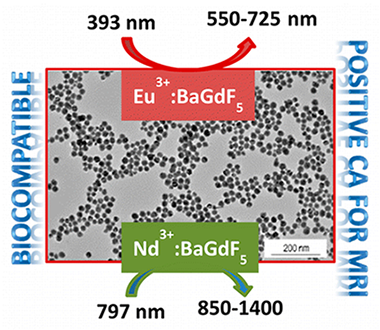
Abstract
Bifunctional and highly uniform Ln:BaGdF5 (Ln = Eu3+ and Nd3+) nanoparticles have been successfully synthesized using a solvothermal method consisting of the aging at 120 degrees C of a glycerol solution containing the corresponding Lanthanide acetylacetonates and butylmethylimidazolium tetrafluoroborate. The absence of any surfactant in the synthesis process rendered hydrophilic nanospheres (with tunable diameter from 45 nm 85 nm, depending on the cations concentration of the starting solution) which are suitable for bioapplications. The particles are bifunctional because they showed both optical and magnetic properties due to the presence of the optically active lanthanides (Eu3+ in the visible and Nd3+ in the NIR regions of the electromagnetic spectrum) and the paramagnetic gadolinium ion, respectively. The luminescence decay curves of the nanospheres doped with different amounts of Eu3+ and Nd3+ have been recorded in order to determine the optimum dopant concentration in each case, which turned out to be 5% Eu3+ and 0.5% Nd3+. Likewise, proton relaxation times were measured at 1.5 T in water suspensions of the optimum particles found in the luminescence study. The values obtained suggested that both kinds of particles could be used as positive contrast agents for MRI. Finally, it was demonstrated that both the 5% Eu3+ and 0.5% Nd3+-doped BaGdF5 nanospheres showed negligible cytotoxicity for VERO cells for concentrations up to 0.25 mg mL(-1).
January, 2016 · DOI: 10.1021/acs.langmuir.5b03837
Materiales Ópticos Multifuncionales
Efficient bifacial dye-sensitized solar cells through disorder by design
Miranda-Munoz, JM; Carretero-Palacios, S; Jimenez-Solano, A; Li, YL; Lozano, G; Miguez, HJournal of Materials Chemistry A, 4 (2016) 1953-1961 DOI: 10.1039/C5TA10091G
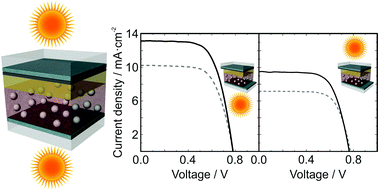
Abstract
Herein we realize an optical design that optimizes the performance of bifacial solar cells without modifying any of the usually employed components. In order to do so, dielectric scatterers of controlled size and shape have been successfully integrated in the working electrodes of dye-sensitized solar cells (DSSCs), resulting in bifacial devices of outstanding performance. Power conversion efficiencies (PCEs) as high as 6.7% and 5.4% have been attained under front and rear illumination, respectively, which represent a 25% and a 33% PCE enhancement with respect to an 8 μm-thick standard solar cell electrode using platinum as the catalytic material. The remarkable bifacial character of our approach is demonstrated by the high rear/front efficiency ratio attained, around 80%, which is among the largest reported for this sort of device. The proposed optimized design is based on a Monte Carlo approach in which the multiple scattering of light within the cell is fully accounted for. We identified that the spherical shape of the scatterers is the key parameter controlling the angular distribution of the scattering, the most efficient devices being those in which the inclusions provide a narrow forward-oriented angular distribution of the scattered light.
January, 2016 · DOI: 10.1039/C5TA10091G
Materiales Coloidales
Gold-Based Nanomaterials for Applications in Nanomedicine
Ashraf, S; Pelaz, B; del Pino, P; Carril, M; Escudero, A; Parak, WJ; Soliman, MG; Zhang, Q; Carrillo-Carrion, CLight-Responsive Nanostructured Systems for Applications in Nanomedicine, 370 (2016) 169-202 DOI: http://link.springer.com/chapter/10.1007%2F978-3-319-22942-3_6

Abstract
In this review, an overview of the current state-of-the-art of gold-based nanomaterials (Au NPs) in medical applications is given. The unique properties of Au NPs, such as their tunable size, shape, and surface characteristics, optical properties, biocompatibility, low cytotoxicity, high stability, and multifunctionality potential, among others, make them highly attractive in many aspects of medicine. First, the preparation methods for various Au NPs including functionalization strategies for selective targeting are summarized. Second, recent progresses on their applications, ranging from the diagnostics to therapeutics are highlighted. Finally, the rapidly growing and promising field of gold-based theranostic nano-platforms is discussed. Considering the great body of existing information and the high speed of its renewal, we chose in this review to generalize the data that have been accumulated during the past few years for the most promising directions in the use of Au NPs in current medical research.
January, 2016 · DOI: http://link.springer.com/chapter/10.1007%2F978-3-319-22942-3_6
Materiales Coloidales
Deposition of silica protected luminescent layers of Eu:GdVO4 nanoparticles assisted by atmospheric pressure plasma jet
Moretti, E; Pizzol, G; Fantin, M; Enrichi, F; Scopece, P; Nunez, NO; Ocana, M; Benedetti, A; Polizzi, SThin Solid Films, 598 (2016) 88-94 DOI: 10.1016/j.tsf.2015.11.061
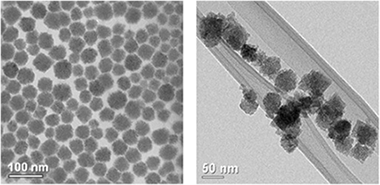
Abstract
Eu:GdVO4 nanophosphors with an average size of 60 nm, synthesized by a facile solvothermal method, were deposited on monocrystalline silicon wafers by a spray-coating technique with artworks anti-counterfeiting applications in mind. Atmospheric pressure plasma jet (APPJ) was used to deposit a silica-based layer on top of the nanometric luminescent layer, in order to improve its adhesion to the substrate and to protect it from the environment. The nanophosphors were characterized by X-ray diffraction (XRD) and transmission electron microscopy (TEM). Coating composition was investigated by Fourier transform infrared spectroscopy (FT-IR) and its morphology was characterized by scanning electron microscopy (FEG-SEM). The film thickness was evaluated by means of ellipsometry and adhesion was estimated by a peeling test. Luminescent properties of the nanophosphors deposited and fixed on silicon wafers were also measured. The whole layer resulted well-adhered to the silicon substrate, transparent and undetectable in the presence of visible light, but easily activated by UV light source.
January, 2016 · DOI: 10.1016/j.tsf.2015.11.061
2015
2015
Materiales Ópticos Multifuncionales
Design and realization of transparent solar modules based on luminescent solar concentrators integrating nanostructured photonic crystals
Jimenez-Solano, A; Delgado-Sanchez, JM; Calvo, ME; Miranda-Munoz, JM; Lozano, G; Sancho, D; Sanchez-Cortezon, E; Miguez, HProgress in Photovoltaics, 23 (2015) 1785-1792 DOI: 10.1002/pip.2621

Abstract
Herein, we present a prototype of a photovoltaic module that combines a luminescent solar concentrator integrating one-dimensional photonic crystals and in-plane CuInGaSe2 (CIGS) solar cells. Highly uniform and wide-area nanostructured multilayers with photonic crystal properties were deposited by a cost-efficient and scalable liquid processing amenable to large-scale fabrication. Their role is to both maximize light absorption in the targeted spectral range, determined by the fluorophore employed, and minimize losses caused by emission at angles within the escape cone of the planar concentrator. From a structural perspective, the porous nature of the layers facilitates the integration with the thermoplastic polymers typically used to encapsulate and seal these modules. Judicious design of the module geometry, as well as of the optical properties of the dielectric mirrors employed, allows optimizing light guiding and hence photovoltaic performance while preserving a great deal of transparency. Optimized in-plane designs like the one herein proposed are of relevance for building integrated photovoltaics, as ease of fabrication, long-term stability and improved performance are simultaneously achieved.
December, 2015 · DOI: 10.1002/pip.2621
Materiales Ópticos Multifuncionales
Adaptable Ultraviolet Reflecting Polymeric Multilayer Coatings of High Refractive Index Contrast
Smirnov, JRC; Ito, M; Calvo, ME; Lopez-Lopez, C; Jimenez-Solano, A; Galisteo-Lopez, JF; Zavala-Rivera, P; Tanaka, K; Sivaniah, E; Miguez, HAdvanced Optical Materials, 3 (2015) 1633-1639 DOI: 10.1002/adom.201500209
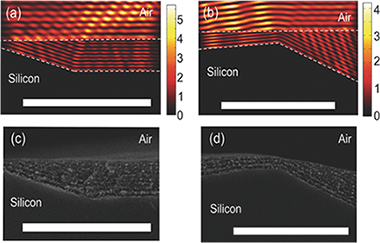
Abstract
A synthetic route is demonstrated to build purely polymeric nanostructured multilayer coatings, adaptable to arbitrary surfaces, and capable of efficiently blocking by reflection a targeted and tunable ultraviolet (UV) range. Reflection properties are determined by optical interference between UV light beams reflected at the interfaces between polystyrene layers of different porosity and hence refractive index. As no dopant absorber intervenes in the shielding effect, polymer degradation effects are prevented. Alternated porosity results from the modulation of photochemical effects at the few tens of nanometers length scale, combined with the collective osmotic shock induced during the processing of the precursor diblock copolymer film. Experimental evidence of the application of this method to coat rough surfaces with smooth and conformal UV protecting films is provided.
November, 2015 · DOI: 10.1002/adom.201500209
Nanotecnología en Superficies y Plasma - Materiales Ópticos Multifuncionales
Single-step fabrication process of 1-D photonic crystals coupled to nanocolumnar TiO2 layers to improve DSC efficiency
Gonzalez-Garcia, L; Colodrero, S; Miguez, H; Gonzalez-Elipe, AROptics Express, 23 (2015) A1642-A1650 DOI: 10.1364/OE.23.0A1642

Abstract
The present work proposes the use of a TiO2 electrode coupled to a one-dimensional photonic crystal (1DPC), all formed by the sequential deposition of nanocolumnar thin films by physical vapor oblique angle deposition (PV-OAD), to enhance the optical and electrical performance of DSCs while transparency is preserved. We demonstrate that this approach allows building an architecture combining a non-dispersive 3 µm of TiO2 electrode and 1 µm TiO2-SiO2 1DPC, both columnar, in a single-step process. The incorporation of the photonic structure is responsible for a rise of 30% in photovoltaic efficiency, as compared with a transparent cell with a single TiO2 electrode. Detailed analysis of the spectral dependence of the photocurrent demonstrates that the 1DPC improves light harvesting efficiency by both back reflection and optical cavity modes confinement within the TiO2 films, thus increasing the overall performance of the cell.
November, 2015 · DOI: 10.1364/OE.23.0A1642
Materiales Nanoestructurados y Microestructura - Materiales Ópticos Multifuncionales
Full solution processed mesostructured optical resonators integrating colloidal semiconductor quantum dots
Calvo, ME; Hidalgo, N; Schierholz, R; Kovacs, A; Fernandez, A; Bellino, MG; Soler-Illia, GJAA; Miguez, HNanoscale, 7 (2015) 16583-16589 DOI: 10.1039/C5NR03977K
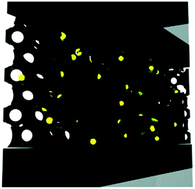
Abstract
Herein we show a solution based synthetic pathway to obtain a resonant optical cavity with embedded colloidal semiconductor quantum dots (CSQDs). The optical cavity pore network, surrounded by two dense Bragg mirrors, was designed ad hoc to selectively host the quantum dots, while uncontrolled infiltration of those in the rest of the layered structure was prevented. Coupling between the optical resonant modes of the host and the natural emission of the embedded nanoparticles gives rise to the fine tuning of the luminescence spectrum extracted from the ensemble. Our approach overcomes, without the need for an encapsulating agent and exclusively by solution processing, the difficulties that arise from the low thermal and chemical stability of the CSQDs. It opens the route to achieving precise control over their location and hence over the spectral properties of light emitted by these widely employed nanomaterials. Furthermore, as the porosity of the cavity is preserved after infiltration, the system remains responsive to environmental changes, which provides an added value to the proposed structure.
October, 2015 · DOI: 10.1039/C5NR03977K
Materiales Ópticos Multifuncionales
Synergistic strategies for the preparation of highly efficient dye-sensitized solar cells on plastic substrates: combination of chemical and physical sintering
Li, Y; Yoo, K; Lee, DK; Kim, JY; Son, HJ; Kim, JH; Lee, CH; Miguez, H; Ko, MJRSC Advances, 5 (2015) 76795-76803 DOI: 10.1039/C5RA10290A

Abstract
Preparation of well-interconnected TiO2 electrodes at low temperature is critical for the fabrication of highly efficient dye-sensitized solar cells (DSCs) on plastic substrates. Herein we explore a synergistic approach using a combination of chemical and physical sintering. We formulate a binder-free TiO2 paste based on “nanoglue” as the chemical sintering agent, and use it to construct a photoelectrode on plastic by low-temperature physical compression to further improve the connectivity of TiO2 films. We systematically investigated the factors affecting the photovoltaic performance and found the conditions to achieve electron diffusion lengths as long as 25 μm and charge collection efficiencies as high as 95%, as electrochemical impedance spectroscopy measurements indicate. We apply this approach to obtain a DSC deposited on plastic displaying 6.4% power conversion efficiency based on commercial P25 titania particles.
October, 2015 · DOI: 10.1039/C5RA10290A
Materiales Coloidales
Uniform Poly(acrylic acid)-Functionalized Lanthanide-Doped LaVO4 Nanophosphors with High Colloidal Stability and Biocompatibility
Nunez, NO; Zambrano, P; Garcia-Sevillano, J; Cantelar, E; Rivera-Fernandez, S; de la Fuente, JM; Ocana, MEuropean Journal of Inorganic Chemistry, 27 (2015) 4546-4554 DOI: 10.1002/ejic.201500265
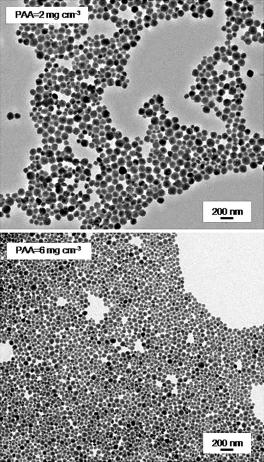
Abstract
Ln-doped (Ln = Eu or Nd) LaVO4 nanoparticles functionalized with poly(acrylic acid) (PAA) were prepared from lanthanide and vanadate precursors in the presence of PAA by a simple one-pot method that consists of a homogeneous precipitation reaction in ethylene glycol/water at a moderate temperature (120 degrees C). The size of the nanoparticles could be modified in the 40-70 nm range by adjusting the amount of PAA added. The effects of the Eu and Nd contents of these nanomaterials on theirs optical properties (emission intensity and lifetime) were also analyzed to find the optimum nanophosphors. Finally, the nanoparticles showed negligible cytotoxicity for Vero cells at concentrations up to 0.05 mgmL(-1) and a high colloidal stability in physiological buffer solutions; therefore, they satisfy the most important requirements for in vitro biotechnological applications.
September, 2015 · DOI: 10.1002/ejic.201500265
Materiales Ópticos Multifuncionales
Biocompatible Films with Tailored Spectral Response for Prevention of DNA Damage in Skin Cells
Nunez-Lozano, R; Pimentel, B; Castro-Smirnov, JR; Calvo, ME; Miguez, H; de la Cueva-Mendez, GAdvanced Healthcare Materials, 4 (2015) 1944-1948 DOI: 10.1002/adhm.201500223
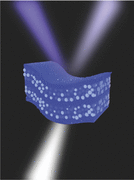
Abstract
A hybrid nanostructured organic–inorganic biocompatible film capable of efficiently blocking a preselected range of ultraviolet light is designed to match the genotoxic action spectrum of human epithelial cells. This stack protects cultured human skin cells from UV-induced DNA lesions. As the shielding mechanism relies exclusively on reflection, the secondary effects due to absorption harmful radiation are prevented
September, 2015 · DOI: 10.1002/adhm.201500223
Materiales Coloidales
BaGa4O7, a new A3BC10O20 crystalline phase: synthesis, structural determination and luminescence properties
Boyer, Marina; Veron, Emmanuel; Becerro, Ana Isabel; Porcher, Florence; Suchomel, Matthew R.; Matzen, Guy; Allix, MathieuCrystEngComm, 17 (2015) 6127-6135 DOI: 10.1039/C5CE01101A

Abstract
The synthesis, structural determination and luminescence properties of a new barium gallate, BaGa4O7, are reported. This crystalline material can uniquely be obtained by direct cooling from the molten state. The crystallographic structure was determined using a combination of electron, synchrotron and neutron powder diffraction data. BaGa4O7 crystallizes in the monoclinic I2/mspace group with a = 15.0688(1) Å, b = 11.7091(1) Å, c = 5.1429(2) Å and β = 91.0452(2)° and can be described as an original member of the A3BC10O20 family. Atypical for this A3BC10O20structural framework, BaGa4O7 is found to contain exclusively divalent and trivalent cations. In order to maintain overall electroneutrality, disordered defect-type partial substitution of gallium and oxygen ions on barium sites occurs within the pentagonal channels of BaGa4O7. Thanks to the flexibility of this structural framework, BaGa4O7 can be heavily doped with europium and thus is shown to exhibit strong orange-red luminescence emission at 618 nm under 393 nm excitation.
August, 2015 · DOI: 10.1039/C5CE01101A
Materiales Ópticos Multifuncionales
Absorption Enhancement in Organic-Inorganic Halide Perovskite Films with Embedded Plasmonic Gold Nanoparticles
Carretero-Palacios, S; Calvo, ME; Miguez, HJournal of Physical Chemistry C, 119 (2015) 18635-18640 DOI: 10.1021/acs.jpcc.5b06473

Abstract
We report on the numerical analysis of solar absorption enhancement in organic-inorganic halide perovskite films embedding plasmonic gold nanoparticles. The effect of particle size and concentration is analyzed in realistic systems in which random particle location within the perovskite film and the eventual formation of dimers are also taken into account. We find a maximum integrated solar absorption enhancement of similar to 10% in perovskite films of 200 nm thickness and similar to 6% in 300 nm films, with spheres of radii 60 and 90 nm, respectively, in volume concentrations of around 10% in both cases. We show that the presence of dimers boosts the absorption enhancement up to,similar to 12% in the thinnest films considered. Absorption reinforcement arises from a double contribution of plasmonic near-field and scattering effects, whose respective weight can be discriminated and evaluated from the simulations.
August, 2015 · DOI: 10.1021/acs.jpcc.5b06473
Materiales Ópticos Multifuncionales
Environmental Effects on the Photophysics of Organic-Inorganic Halide Perovskites
Galisteo-Lopez, JF; Anaya, M; Calvo, ME; Miguez, HJournal of Physical Chemistry Letters, 6 (2015) 2200-2205 DOI: 10.1021/acs.jpclett.5b00785
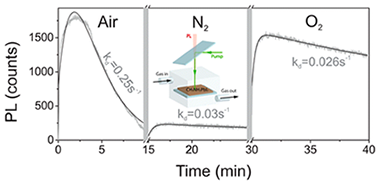
Abstract
The photophysical properties of films of organic-inorganic lead halide perovskites under different ambient conditions are herein reported. We demonstrate that their luminescent properties are determined by the interplay between photoinduced activation and darkening processes, which strongly depend on the atmosphere surrounding the samples. We have isolated oxygen and moisture as the key elements in each process, activation and darkening, both of which involve the interaction with photogenerated carriers. These findings show that environmental factors play a key role in the performance of lead halide perovskites as efficient luminescent materials.
June, 2015 · DOI: 10.1021/acs.jpclett.5b00785
Materiales Ópticos Multifuncionales
Fine Tuning the Emission Properties of Nanoemitters in Multilayered Structures by Deterministic Control of their Local Photonic Environment
Alberto Jiménez-Solano, Juan Francisco Galisteo-López and Hernán MíguezSmall, 11 (2015) 2727-2732 DOI: 10.1002/smll.201402898
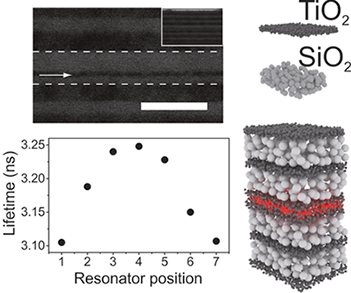
Abstract
Deterministic control on the dynamics of organic nanoemitters is achieved through precise control of its photonic environment. Resonators are fabricated by a combination of spin- and dip-coating techniques, which allows placement of the emitters at different positions within the sample, thus acting as a probe of the local density of states.
June, 2015 · DOI: 10.1002/smll.201402898
Materiales Coloidales
Biosynthesis of silver fine particles and particles decorated with nanoparticles using the extract of Illicium verum (star anise) seeds
Luna, Carlos; Chavez, V. H. G.; Diaz Barriga-Castro, Enrique; Nunez, Nuria O.; Mendoza-Resendez, RaquelSpectrochimica Acta Part A-Molecular and Biomolecular Spectroscopy, 141 (2015) 43-50 DOI: 10.1016/j.saa.2014.12.076
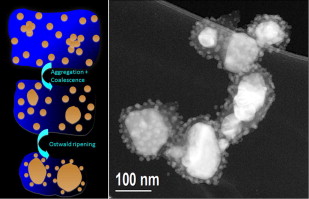
Abstract
Given the upsurge of new technologies based on nanomaterials, the development of sustainable methods to obtain functional nanostructures has become an imperative task. In this matter, several recent researches have shown that the biodegradable natural antioxidants of several plant extracts can be used simultaneously as reducing and stabilizing agents in the wet chemical synthesis of metallic nanoparticles, opening new opportunities to design greener synthesis. However, the challenge of these new techniques is to produce stable colloidal nanoparticles with controlled particle uniformity, size, shape and aggregation state, in similar manner than the well-established synthetic methods. In the present work, colloidal metallic silver nanoparticles have been synthesized using silver nitrate and extracts of Illicium verum (star anise) seeds at room temperature in a facile one-step procedure. The resulting products were colloidal suspensions of two populations of silver nanoparticles, one of them with particle sizes of few nanometers and the other with particles of tens of nm. Strikingly, the variation of the AgNO3/extract weight ratio in the reaction medium yielded to the variation of the spatial distribution of the nanoparticles: high AgNO3/extract concentration ratios yielded to randomly dispersed particles, whereas for lower AgNO3/extract ratios, the biggest particles appeared coated with the finest nanoparticles.-This biosynthesized colloidal system, with controlled particle aggregation states, presents plasmonic and SERS properties with potential applications in molecular sensors and nanophotonic devices.
April, 2015 · DOI: 10.1016/j.saa.2014.12.076
Materiales Ópticos Multifuncionales
An Optically Controlled Microscale Elevator Using Plasmonic Janus Particles
Nedev, S; Carretero-Palacios, S; Kuhler, P; Lohmuller, T; Urban, AS; Anderson, LJE; Feldmann, JACS Photonics, 2 (2015) 491-496 DOI: 10.1021/ph500371z
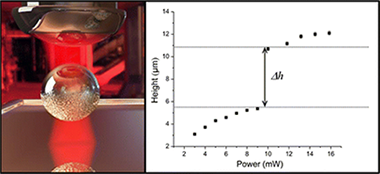
Abstract
In this article, we report how Janus particles, composed of a silica sphere with a gold half-shell, can be not only stably trapped by optical tweezers but also displaced controllably along the axis of the laser beam through a complex interplay between optical and thermal forces. Scattering forces orient the asymmetric particle, while strong absorption on the metal side induces a thermal gradient, resulting in particle motion. An increase in the laser power leads to an upward motion of the particle, while a decrease leads to a downward motion. We study this reversible axial displacement, including a hysteretic jump in the particle position that is a result of the complex pattern of a tightly focused laser beam structure above the focal plane. As a first application we simultaneously trap a spherical gold nanoparticle and show that we can control the distance between the two particles inside the trap. This photonic micron-scale “elevator” is a promising tool for thermal force studies, remote sensing, and optical and thermal micromanipulation experiments.
April, 2015 · DOI: 10.1021/ph500371z
Materiales Coloidales
Up-conversion in Er3+/Yb3+ co-doped LaPO4 submicron-sized spheres
Garcia-Sevillano, J.; Cantelar, E.; Cusso, F.; Ocana, M.Optical Materials, 41 (2015) 104-107 DOI: 10.1016/j.optmat.2014.10.022
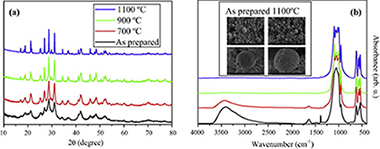
Abstract
Er3+/Yb3+ co-doped materials have been extensively used for imaging in biomedical applications using either visible up-converted (UC) or near-infrared (NIR) emissions. The UC spectrum is composed mainly by two Erbium emissions in the green (2H11/2:4S3/2 → 4I15/2) and red (4F9/2 → 4I15/2) spectral range, while the NIR spectrum includes Er3+ (λ ∼ 1.5 μm, 4I13/2 → 4I15/2) and Er3+/Yb3+ (λ ∼ 980 nm, 2F5/2 → 2F7/2(Yb3+):4I11/2 → 4I15/2 (Er3+)) transitions; which relative intensities are dependent on several physical parameters. In the present work, we present the preparation and optical characterization of Er3+/Yb3+ co-doped LaPO4 submicron-sized spheres. The luminescence (CW and pulsed) characteristics, after different post-annealing treatments, are studied. It is found that such treatments strongly increment the emission efficiency, possibly due to the suppression of residual impurities. After calcination at 1100 °C the material behaves as an excellent UC and NIR–NIR wavelength converter.
March, 2015 · DOI: 10.1016/j.optmat.2014.10.022
Materiales Ópticos Multifuncionales
Nanolevitation Phenomena in Real Plane-Parallel Systems Due to the Balance between Casimir and Gravity Forces
Esteso, V; Carretero-Palacios, S; Miguez, HJournal of Physical Chemistry C, 119 (2015) 5663-5670 DOI: 10.1021/jp511851z

Abstract
We report on the theoretical analysis of equilibrium distances in real plane-parallel systems under the influence of Casimir and gravity forces at thermal equilibrium. Due to the balance between these forces, thin films of Teflon, silica, or polystyrene in a single-layer configuration and immersed in glycerol stand over a silicon substrate at certain stable or unstable positions depending on the material and the slab thickness. Hybrid systems containing silica and polystyrene, materials which display Casimir forces and equilibrium distances of opposite nature when considered individually, are analyzed in either bilayer arrangements or as composite systems made of a homogeneous matrix with small inclusions inside. For each configuration, equilibrium distances and their stability can be adjusted by fine-tuning of the volume occupied by each material. We find the specific conditions under which nanolevitation of realistic films should be observed. Our results indicate that thin films of real materials in plane-parallel configurations can be used to control suspension or stiction phenomena at the nanoscale.
March, 2015 · DOI: 10.1021/jp511851z
Materiales Ópticos Multifuncionales
Highly Efficient Perovskite Solar Cells with Tunable Structural Color
W. Zhang, M. Anaya, G. Lozano, M.E. Calvo, M.B. Johnston, H. Míguez, H.J. SnaithNano Letters, 15 (2015) 1698-1702 DOI: 10.1021/nl504349z
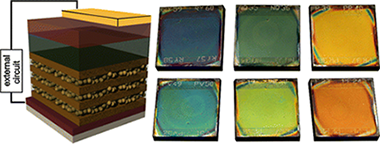
Abstract
The performance of perovskite solar cells has been progressing over the past few years and efficiency is likely to continue to increase. However, a negative aspect for the integration of perovskite solar cells in the built environment is that the color gamut available in these materials is very limited and does not cover the green-to-blue region of the visible spectrum, which has been a big selling point for organic photovoltaics. Here, we integrate a porous photonic crystal (PC) scaffold within the photoactive layer of an opaque perovskite solar cell following a bottom-up approach employing inexpensive and scalable liquid processing techniques. The photovoltaic devices presented herein show high efficiency with tunable color across the visible spectrum. This now imbues the perovskite solar cells with highly desirable properties for cladding in the built environment and encourages design of sustainable colorful buildings and iridescent electric vehicles as future power generation sources.
March, 2015 · DOI: 10.1021/nl504349z
Materiales Ópticos Multifuncionales
Sunlight Absorption Engineering for Thermophotovoltaics: Contributions from the Optical Design
Miguez, HChemSusChem, 8 (2015) 786-788 DOI: 10.1002/cssc.201403361
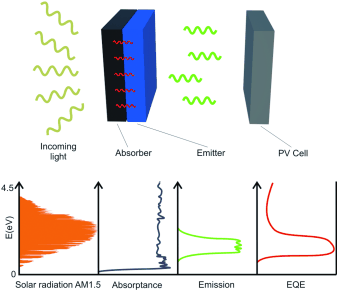
Abstract
Nowadays, solar thermophotovoltaic systems constitute a platform in which sophisticated optical material designs are put into practice with the aim of achieving the long sought after dream of developing an efficient energy conversion device based on this concept. Recent advances demonstrate that higher efficiencies are at reach using photonic nanostructures amenable to mass production and scale-up.
March, 2015 · DOI: 10.1002/cssc.201403361
Materiales Ópticos Multifuncionales - Nanotecnología en Superficies y Plasma
Flexible Distributed Bragg Reflectors from Nanocolumnar Templates
Calvo, ME; Gonzalez-Garcia, L; Parra-Barranco, J; Barranco, A; Jimenez-Solano, A; Gonzalez-Elipe, AR; Miguez, HAdvanced Optical Materials, 3 (2015) 171-175 DOI: 10.1002/adom.201400338

Abstract
A flexible distributed Bragg reflector is made by the infiltration of a nanocolumnar array with polydimethyl siloxane oligomers. The high optical reflectance displayed by the final material is a direct consequence of the high refractive index contrast of the columnar layers whereas the structural stability is due to the polymer properties.
February, 2015 · DOI: 10.1002/adom.201400338
Materiales Coloidales
Quick synthesis, functionalization and properties of uniform, luminescent LuPO4-based nanoparticles
Becerro, AI; Ocana, MRSC Advances, 44 (2015) 34517-34524 DOI: 10.1039/C5RA05305F
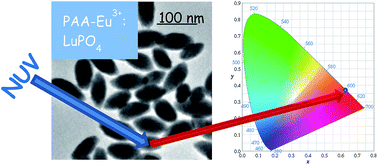
Abstract
The aim of this study was to find a surfactant-free method for the synthesis of uniform Eu:LuPO4nanophosphors which are able to form stable colloidal suspensions in aqueous media. Uniform, ovoid Eu-doped LuPO4 fluorescent nanoparticles were obtained after aging for 30 minutes at 180 °C a butylene glycol solution containing, exclusively, lutetium acetate, europium acetate and H3PO4. XRD and digital diffraction patterns of HRTEM images suggested that the particles were single crystalline in nature with the c-axis of the unit cell parallel to the long particle axis. The luminescence study revealed that the optimum doping level was 5 molar%. The latter particles (85 nm × 40 nm dimensions) were functionalized with polyacrylic acid and their colloidal stability in two different biological buffers was demonstrated to persist for at least 15 days.
January, 2015 · DOI: 10.1039/C5RA05305F
Materiales Coloidales
Template-free synthesis and luminescent properties of hollow Ln:YOF (Ln = Eu or Er plus Yb) microspheres
Martinez-Castro, E; Garcia-Sevillano, J; Cusso, F; Ocana, MJournal of Alloys and Compounds, 619 (2015) 44-51 DOI: 10.1016/j.jallcom.2014.09.023
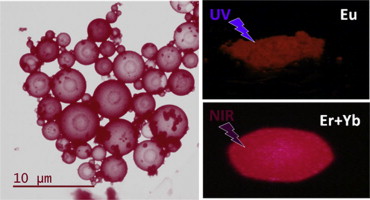
Abstract
A method for the synthesis of hollow lanthanide doped yttrium oxyfluoride (YOF) spheres in the micrometer size range with cubic structure based on the pyrolysis at 600 degrees C of liquid aerosols generated from aqueous solutions containing the corresponding rare earth chlorides and trifluoroacetic acid has been developed. This procedure, which has been used for the first time for the synthesis of YFO based materials, is simpler and advantageous when compared with other methods usually employed for the production of hollow spheres since it does not require the use of sacrificial templates. In addition, it is continuous, which is desirable because of practical reasons. The procedure is also suitable for doping the YOF spheres with europium cations resulting in down converting red phosphors when activated with UV light, or for co-doping with both Er3+ and Yb3+ giving rise to up-converting phosphors, which emit intense red light under near infrared (NIR) irradiation. Because of their optical properties and hollow architecture, the developed materials may find applications in optoelectronic devices and biotechnology.
January, 2015 · DOI: 10.1016/j.jallcom.2014.09.023
Materiales Ópticos Multifuncionales
Optical Description of Mesostructured Organic-Inorganic Halide Perovskite Solar Cells
Anaya, M; Lozano, G; Calvo, ME; Zhang, W; Johnston, MB; Snaith, HJ; Miguez, HJournal of Physical Chemistry Letters, 6 (2015) 48-53 DOI: 10.1021/jz502351s
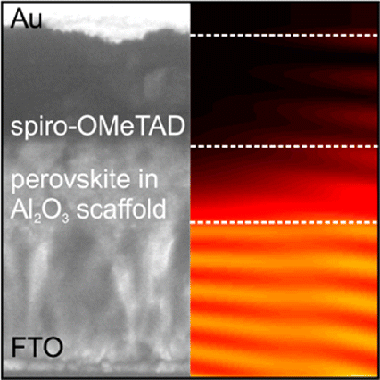
Abstract
Herein we describe both theoretically and experimentally the optical response of solution-processed organic–inorganic halide perovskite solar cells based on mesostructured scaffolds. We develop a rigorous theoretical model using a method based on the propagation of waves in layered media, which allows visualizing the way in which light is spatially distributed across the device and serves to quantify the fraction of light absorbed by each medium comprising the cell. The discrimination between productive and parasitic absorption yields an accurate determination of the internal quantum efficiency. State-of-the-art devices integrating mesoporous scaffolds infiltrated with perovskite are manufactured and characterized to support the calculations. This combined experimental and theoretical analysis provides a rational understanding of the optical behavior of perovskite cells and can be beneficial for the judicious design of devices with improved performance. Notably, our model justifies the presence of a solid perovskite capping layer in all of the highest efficiency perovskite solar cells based on thinner mesoporous scaffolds.
January, 2015 · DOI: 10.1021/jz502351s
2014
2014
Materiales Coloidales
One-Step Synthesis and Polyacrylic Acid Functionalization of Multifunctional Europium-Doped NaGdF4 Nanoparticles with Selected Size for Optical and MRI Imaging
Nunez, NO; Garcia, M; Garcia-Sevillano, J; Rivera-Fernandez, S; de la Fuente, JM; Ocana, MEuropean Journal of Inorganic Chemistry, 35 (2014) 6075-6084 DOI: 10.1002/ejic.201402690
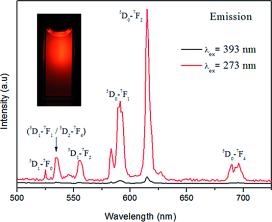
Abstract
Multifunctional Eu:NaGdF4 nanospheres functionalized with polyacrylic acid (PAA) polymer have been prepared for the first time by a simple one-pot method that consists of a homogeneous precipitation reaction at 120 °C. The size of the nanospheres, which were polycrystalline and crystallized into a hexagonal structure, could be altered in the 60–95 nm range by adjusting the amount of polyacrylic acid added. The effects of Eu content and particle size of these nanomaterials on their optical properties (emission intensity and lifetime) as well as on their relaxivity (r1 and r2) values were also analyzed to find the optimum system for optical bioimaging and as a positive contrast agent for magnetic resonance imaging (MRI) applications. Finally, such optimum nanoparticles showed negligible cytotoxicity for Vero cells for concentrations up to 0.5 mg mL–1 and a high colloidal stability in 2-morpholinoethanesulfonic acid solutions, thereby satisfying the most important requirements for their use in biotechnological applications.
December, 2014 · DOI: 10.1002/ejic.201402690
Materiales Coloidales
Morphological and structural behavior of TiO2 nanoparticles in the presence of WO3: crystallization of the oxide composite system
Kubacka, A; Iglesias-Juez, A; di Michiel, M; Becerro, AI; Fernandez-Garcia, MPhysical Chemistry Chemical Physics, 16 (2014) 19540-19549 DOI: 10.1039/c4cp02181a

Abstract
Composite TiO2-WO3 oxide materials were prepared by a single pot microemulsion method and studied during calcination treatments under dry air in order to analyze the influence of tungsten on the behavior of the dominant titania component. To this end, the surface and bulk morphological and structural evolution of the solid precursors was studied using X-ray diffraction and infrared spectroscopy. In the calcination process, differences in the dominant titania component behavior appeared as a function of the W/Ti atomic ratio of the precursor. First, the crystallization of the anatase phase is affected by tungsten through an effect on the primary particle size growth. Furthermore, such an effect also influences the anatase to rutile phase transformation. The study provides evidence that the W-Ti interaction develops differently for a low/high W/Ti atomic ratio below/above 0.25 affecting fundamentally the above-mentioned anatase primary particle size growth process and the subsequent formation of the rutile phase and showing that addition of tungsten provides a way to control morphology and phase behavior in anatase-based oxide complex materials.
September, 2014 · DOI: 10.1039/c4cp02181a
Materiales Ópticos Multifuncionales
Multidirectional Light-Harvesting Enhancement in Dye Solar Cells by Surface Patterning
Lopez-Lopez, C; Colodrero, S; Jimenez-Solano, A; Lozano, G; Ortiz, R; Calvo, ME; Miguez, HAdvanced Optical Materials, 2 (2014) 879-884 DOI: 10.1002/adom.201400160
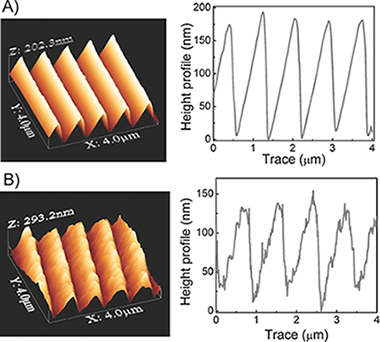
Abstract
One dimensional gratings patterned on the surface of nanocrystalline titania electrodes are used as a light harvesting strategy to improve the overall performance of dye solar cells under both frontal and rear illumination conditions. A soft-lithography-based micromoulding approach is employed to replicate a periodic surface relief pattern onto the surface of the electrode, which is later sensitized with a dye. As the patterned surface acts as an optical grating both in reflection and transmission modes, its effect is to increase the light path of diffracted beams within the absorbing layer when it is irradiated either from the electrode or the counter electrode for a broad range of angles of incidence on each surface. Full optical and photovoltaic characterization demonstrates not only the optical quality of the patterned surfaces but also the multidirectional character of the enhancement of light harvesting and conversion efficiency. The approach herein presented thus permits to preserve the operation of the cell when irradiated from its two faces while increasing its overall power conversion efficiency. This feature is a key advantage over other light harvesting efficiency enhancing methods, such as the deposition of a back diffuse scattering layer, in which the performance of the cell under illumination from one of its sides is enlarged at the expense of reducing the output under reverse irradiation conditions.
September, 2014 · DOI: 10.1002/adom.201400160
Materiales Ópticos Multifuncionales
Tailor-made directional emission in nanoimprinted plasmonic-based light-emitting devices
Lozano, G; Grzela, G; Verschuuren, MA; Ramezani, M; Rivas, JGNanoscale, 6 (2014) 9223-9229 DOI: 10.1039/c4nr01391c
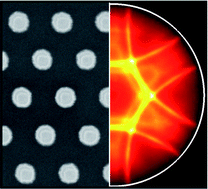
Abstract
We demonstrate an enhanced and tailor-made directional emission of light-emitting devices using nanoimprinted hexagonal arrays of aluminum nanoparticles. Fourier microscopy reveals that the, luminescence of the device is not only determined by the material properties of the organic dye molecules but is also strongly influenced by the coherent scattering resulting from periodically arranged metal nanoparticles. Emitters can couple to lattice-induced hybrid plasmonic-photonic modes sustained by plasmonic arrays. Such modes enhance the spatial coherence of an emitting layer, allowing the efficient beaming of the emission along narrow angular and spectral ranges. We show that tailoring the separation of the nanoparticles in the array yields an accurate angular distribution of the emission. This combination of large-area metal nanostructures fabricated by nanoimprint lithography and light-emitting devices is beneficial for the design and optimization of solid-state lighting systems.
August, 2014 · DOI: 10.1039/c4nr01391c
Materiales Coloidales
New Single-Phase, White-Light-Emitting Phosphors Based on delta-Gd2Si2O7 for Solid-State Lighting
Fernandez-Carrion, AJ; Ocana, M; Garcia-Sevillano, J; Cantelar, E; Becerro, AIJournal of Physical Chemistry C, 118 (2014) 18035-18043 DOI: 10.1021/jp505524g
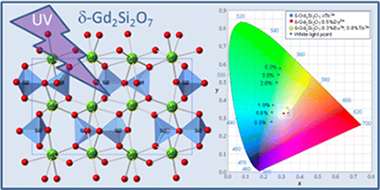
Abstract
Two new white-light (WL)-emitting phosphors (δ-Gd2Si2O7:Dy and δ-Gd2Si2O7:Eu,Tb) have been synthesized by the sol–gel method. The Gd-Ln3+ (Ln3+= Dy3+, Tb3+, Eu3+) energy-transfer band has been used to excite both phosphors, which provides an enhancement of the Ln3+ emissions. First, WL was generated from δ-Gd2Si2O7:xDy thanks to the particular ratio of the blue and yellow emissions observed in all three compositions, which had chromatic coordinates of x = 0.30, y = 0.33 and CCT values of between 7077 and 6721 K. The decay curves of the main transitions of Dy3+ showed a maximum lifetime value for δ-Gd2Si2O7:0.5%Dy, which is, therefore, the most efficient doping level. Second, a broad spectral range, single-phase, WL-emitting phosphor was generated by codoping δ-Gd2Si2O7 with Tb3+ and Eu3+. The composition δ-Gd2Si2O7:0.3%Eu3+;0.8%Tb3+ showed CIE coordinates well inside the ideal WL region of the CIE diagram and a CCT value of 5828 K. The single-phase WL-emitting phosphors presented in this paper are promising materials to be used in white solid-state lighting systems and field-emission displays due to the advantages provided both by Gd3+ ions and by the high thermal and chemical stabilities of the rare earth disilicate matrix.
August, 2014 · DOI: 10.1021/jp505524g
Materiales Coloidales - Materiales Nanoestructurados y Microestructura - Materiales y Procesos Catalíticos de Interés Ambiental y Energético
Bifunctional, Monodisperse BiPO4-Based Nanostars: Photocatalytic Activity and Luminescent Applications
Becerro, AI; Criado, J; Gontard, LC; Obregon, S; Fernandez, A; Colon, G; Ocana, MCrystal Growth & Design, 14 (2014) 3319-3326 DOI: 10.1021/cg500208h
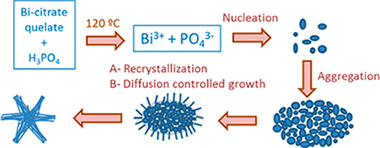
Abstract
Monodisperse, monoclinic BiPO4 nanostars have been synthesized by a homogeneous precipitation reaction at 120 °C through controlled release of Bi3+ cations from a Bi–citrate chelate, in a mixture of glycerol and ethylene glycol, using H3PO4 as the phosphate source. The set of experimental conditions necessary to obtain uniform nanoparticles is very restrictive, as the change in either the polyol ratio or the reactant concentrations led to ill-defined and/or aggregated particles. The morphology of the particles consists of a starlike, hierarchical structure formed by the ordered arrangement of nanorod bundles. Transmission electron tomography has revealed that the nanostars are not spherical but flattened particles. Likewise, Fourier transform infrared spectroscopy and thermogravimetry have shown that the synthesized nanostars are functionalized with citrate groups. The mechanism of formation of the nanostars has been analyzed to explain their morphological features. The as-synthesized BiPO4 nanostars exhibit an efficient photocatalytic performance for the degradation of Rhodamine B. Finally, it has been demonstrated that the stars can be Eu3+-doped up to 2 mol % without any change in the particle morphology or symmetry, and the doped samples show emission in the orange-red region of the visible spectrum after ultraviolet excitation. These experimental observations make this material a suitable phosphor for biotechnological applications.
July, 2014 · DOI: 10.1021/cg500208h
Materiales Coloidales
Synthesis and luminescence of uniform europium-doped bismuth fluoride and bismuth oxyfluoride particles with different morphologies
A. Escudero; E. Moretti; M. OcañaCrysEngComm, 16 (2014) 3274-3283 DOI: 10.1039/C3CE42462F
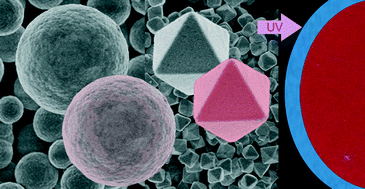
Abstract
Facile synthesis routes have been developed for the preparation of uniform cubic bismuth fluoride and bismuth oxyfluoride particles. The synthesis methods are based on homogeneous precipitation reactions at 120 °C in solutions of bismuth nitrate and sodium tetrafluoroborate precursors in polyol-based solvents. Both the nature of the solvent and the heating modes (conventional or microwave-assisted heating) have a remarkable effect on the morphology and crystallinity of the resulting particles. Thus, polycrystalline spheres of α-BiF3 with a mean diameter ranging from 1.2 to 2 μm could be obtained by heating solutions with the appropriate reagent concentrations in a mixture of ethylene glycol and glycerol (1 : 1 by volume) using a conventional oven, whereas octahedral single crystals of α-BiOyF3−2y with mean edges ranging from 250 nm to 920 nm precipitated when using a diethylene glycol–water mixture (8 : 2 in volume) as solvent and a microwave reactor for heating. To explain these different morphological and structural features, the mechanism of formation of such particles was investigated. Both kinds of particles were also doped with Eu3+, and both the morphological and luminescence properties of the resulting materials were evaluated. It was found that the luminescence intensity of the europium-doped α-BiOyF3−2y nanoparticles was higher than that of the europium-doped α-BiF3 sub-micrometric spheres, which was associated with the higher crystallinity of the former. Moreover, the presence of oxygen in the europium-doped α-BiOyF3−2y samples permits the excitation of the europium cations through an Eu–O energy transfer process, which results in a much higher luminescence intensity with respect to that corresponding to the direct excitation of the europium cations. Finally, the effect of the amount of dopant on the luminescence properties of the phosphors was also evaluated.
April, 2014 · DOI: 10.1039/C3CE42462F
Materiales Ópticos Multifuncionales
Nanometer-Scale Precision Tuning of 3D Photonic Crystals Made Possible Using Polyelectrolytes with Controlled Short Chain Length and Narrow Polydispersity
Wang, Z; Calvo, ME; Masson, G; Arsenault, AC; Peiris, F; Mamak, M; Miguez, H; Manners, I; Ozin, GAAdvanced Materials Interfaces, 1 (2014) Art. 1300051 DOI: 10.1002/admi.201300051

Abstract
Nanometer-scale tuning of the optical properties of prefabricated photonic crystals is achieved via layer-by-layer assembly of polyelectrolytes in the interstitial spaces of the photonic lattice. The key to the approach is using polyelectrolytes with controlled short chain lengths. This ensures they do not block the air voids, thereby maintaining uniform coating and thus precise and reproducible optical
February, 2014 · DOI: 10.1002/admi.201300051
Materiales Ópticos Multifuncionales
Dye sensitized solar cells as optically random photovoltaic media
Galvez, FE; Barnes, PRF; Halme, J; Miguez, HEnergy & Environmental Science, 6 (2014) 1260-1266 DOI: 10.1039/C3EE42587H
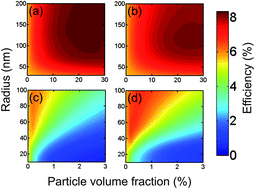
Abstract
In order to enhance optical absorption, light trapping by multiple scattering is commonly achieved in dye sensitized solar cells by adding particles of a different sort. Herein we propose a theoretical method to find the structural parameters (particle number density and size) that optimize the conversion efficiency of electrodes of different thicknesses containing spherical inclusions of diverse composition. Our work provides a theoretical framework in which the response of solar cells containing diffuse scattering particles can be rationalized. Optical simulations are performed by combining a Monte Carlo approach with Mie theory, in which the angular distribution of scattered light is accounted for. Several types of scattering centers, such as anatase, gold and silver particles, as well as cavities, are considered and their effect compared. Estimates of photovoltaic performance, insight into the physical mechanisms responsible for the observed enhancements, and guidelines to improve the cell design are provided. We discuss the results in terms of light transport in weakly disordered optical media and find that the observed variations between the optimum scattering configurations attained for different electrode thicknesses can be understood as the result of the randomization of the light propagation direction at different depths within the active layer. A primary conclusion of our study is that photovoltaic performance is optimised when the scattering properties of the film are adjusted so that the distance over which incident photons are randomized is comparable to the thickness of the film. This simple relationship could also be used as a design rule to attain the optimum optical design in other photovoltaic materials.
February, 2014 · DOI: 10.1039/C3EE42587H
Materiales Ópticos Multifuncionales
Fully stable numerical calculations for finite one-dimensional structures: Mapping the transfer matrix method
Luque-Raigon, JM; Halme, J; Miguez, HJournal of Quantitative Spectroscopy and Radiative Transfer, 134 (2014) 9-20 DOI: 10.1016/j.jqsrt.2013.10.007
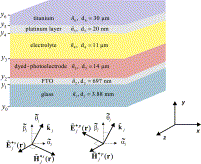
Abstract
We design a fully stable numerical solution of the Maxwell's equations with the transfer matrix method (TMM) to understand the interaction between an electromagnetic field and a finite, one-dimensional, non-periodic structure. Such an exact solution can be tailored from a conventional solution by choosing an adequate transformation between its reference systems, which induces a mapping between its associated TMMs. The paper demonstrates theoretically the numerical stability of the TMM for the exact solution within the framework of Maxwell's equations, but the same formalism can efficiently be applied to resolve other classical or quantum linear wave-propagation interaction in one, two, and three dimensions. This is because the formalism is exclusively built up for an in depth analysis of the TMM's symmetries.
February, 2014 · DOI: 10.1016/j.jqsrt.2013.10.007
Materiales Coloidales
Synthesis of antibacterial silver-based nanodisks and dendritic structures mediated by royal jelly
Mendoza-Resendez, R; Gomez-Trevino, A; Barriga-Castro, ED; Nunez, NO; Luna, CRSC Advances, 4 (2014) 1650-1658 DOI: 10.1039/C3RA45680C
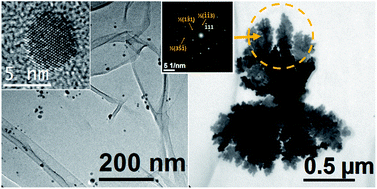
Abstract
The one-step preparation of silver nanoparticles and dendritic structures mediated by aqueous royal jelly solutions has been investigated for the first time. It has been found that royal jelly (RJ) is a complex organic matrix that can be simultaneously used as a reducing and stabilizing agent in the chemical synthesis of colloidal silver-based nanostructures from aqueous AgNO3 solutions, without the requirement of additional reagents or heating sources to initiate the oxidation–reduction reactions. The resulting product consisted of very fine single-crystal disks of Ag and silver 4,4′-dimethyldiazoaminobenzene (a triazenic compound). Both kinds of particles tended to coalesce and form supramolecular dendritic structures, the AgNO3/RJ weight ratio chosen in the synthesis being a key parameter to control the crystal growth and the microstructural properties of the Ag nanodisks. Data obtained from Fourier transform infrared and Raman spectroscopy analysis indicated that these nanostructures are coated by RJ biomolecules (residues of proteins and carbohydrates). In vitro biological assays showed that these nanostructures exhibit a promising enhanced antibacterial activity against both Gram-positive and Gram-negative bacteria.
January, 2014 · DOI: 10.1039/C3RA45680C
Materiales Ópticos Multifuncionales
Panchromatic porous specular back reflectors for efficient transparent dye solar cells
Lopez-Lopez, C; Colodrero, S; Miguez, HPhysical Chemistry Chemical Physics, 16 (2014) 663-668 DOI: 10.1039/C3CP53939C
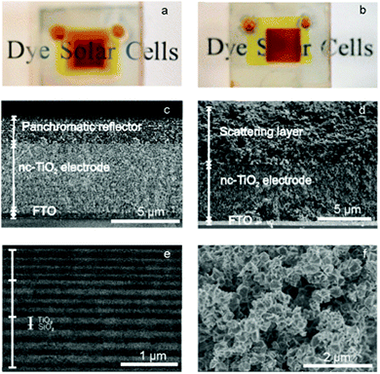
Abstract
A panchromatic specular reflector based dye solar cell is presented herein. Photovoltaic performance of this novel design is compared to that of cells in which standard diffuse scattering layers are integrated. The capability of the proposed multilayer structures to both emulate the broad band reflection of diffuse scattering layers of standard thickness (around 5 microns) and give rise to similarly high light harvesting and power conversion efficiencies, yet preserving the transparency of the device, is demonstrated. Such white light reflectors are comprised of stacks of different porous optical multilayers, each one displaying a strong reflection in a complementary spectral range, and are designed to leave transmittance unaltered in a narrow red-frequency range in which the sensitized electrode shows negligible absorption, thus allowing us to see through the cell. The reflectance bandwidth achieved is three times as broad as the largest bandwidth previously achieved using any photonic structure integrated into a dye solar cell.
January, 2014 · DOI: 10.1039/C3CP53939C
2013
2013
Materiales Ópticos Multifuncionales
Symmetry analysis of the numerical instabilities in the transfer matrix method
Luque-Raigon, JM; Halme, J; Miguez, H; Lozano, GJournal of Optics, 15 (2013) 125719 DOI: 10.1088/2040-8978/15/12/125719
Abstract
This paper discusses the numerical exponential instability of the transfer matrix method (TMM) in the framework of the symmetry formalism. This numerical weakness is attributed to a series of increasingly extreme exponentials that appear in the TMM when it is applied to geometries involving total internal reflection (TIR) or very high absorption. We design a TMM formalism that identifies the internal symmetries of the multilayer geometry. These symmetries suggest particular transformations of a reference system in the TMM that improve its ill-conditioned exponentials. To illustrate the numerical improvements, we present examples with calculations of electric fields.
December, 2013 · DOI: 10.1088/2040-8978/15/12/125719
Materiales Coloidales
Crystal Structures and Photoluminescence across the La2Si2O7–Ho2Si2O7 System
Fernandez-Carrion, AJ; Allix, M; Ocana, M; Garcia-Sevillano, J; Cusso, F; Fitch, AN; Suard, E; Becerro, AIInorganic Chemistry, 52 (2013) 13469-13479 DOI: 10.1021/ic401867c
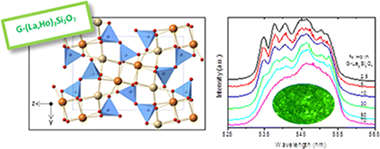
Abstract
The La2Si2O7−Ho2Si2O7 system displays a solid solubility region of G-(La,Ho)2Si2O7 which extends to the La0.6Ho1.4Si2O7 composition. Compositions richer in Ho3+ show a two-phase domain (G+δ), while δ-(La,Ho)2Si2O7 is the stable phase for Ho3+ contents higher than La0.2Ho1.8Si2O7. A preferential occupation of Ho for the RE2 site of the G-unit cell is observed. Luminescence measurements have shown that the lifetimes remain unchanged in the range 0.5% < [Ho3+] < 10%, and only above this value does concentration quenching become operative.
November, 2013 · DOI: 10.1021/ic401867c
Materiales Coloidales
Synthesis of metallic silver nanoparticles and silver organometallic nanodisks mediated by extracts of Capsicum annuum var. aviculare (piquin) fruits
Mendoza-Resendez, R; Nunez, NO; Barriga-Castro, ED; Luna, CRSC Advances, 43 (2013) 20765-20771 DOI: 10.1039/C3RA43524E
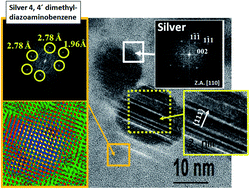
Abstract
Silver-based nanostructures were prepared through reduction/oxidation reactions of aqueous silver nitrate solutions mediated by extracts of red fruits of the piquin pepper (Capsicum annuum var. aviculare) at room temperature. Detailed morphological and microstructural studies using X-ray diffraction, conventional and high-resolution transmission electron microscopy and selected area electron diffraction revealed that the product was constituted by three kinds of nanoparticles. One of them was composed of twinned metallic silver nanoparticles with a size of few nanometers. Other kind of particles was ultrafine disk-like single crystals of silver 4,4′-dimethyldiazoaminobenzene, being in our best knowledge the first time that this compound is reported in the form of nanoparticles. Both kinds of nanoparticles experienced processes of self-assembly and subsequent grain growth to form the third kind of nanoparticles. Such resulting nanostructures are monocrystalline and flattened metallic silver nanoparticles that have diameters around tens of nanometers, the [112] direction perpendicular to the particle plane, and are coated by a surface organometallic layer and residues of biomolecules. The ultraviolet-visible spectrum of the biosynthesized product showed a surface plasmon resonance (SPR) extinction band with an absorbance maximum at around 400 nm, thereby confirming the presence of fine Ag particles. Studies carried out by Fourier transform infrared spectroscopy indicated that the principal active compounds responsible of the reduction of the Ag ions are proteins and capsaicin (through the amino groups) and phenolic compounds (through hydroxyl groups).
November, 2013 · DOI: 10.1039/C3RA43524E
Materiales Coloidales
Perfectly Transparent Sr3Al2O6 Polycrystalline Ceramic Elaborated from Glass Crystallization
Alahrache, S; Al Saghir, K; Chenu, S; Veron, E; Meneses, DD; Becerro, AI; Ocana, M; Moretti, F; Patton, G; Dujardin, C; Cusso, F; Guin, JP; Nivard, M; Sangleboeuf, JC; Matzen, G; Allix, MChemistry of Materials, 25 (2013) 4017-4024 DOI: 10.1021/cm401953d
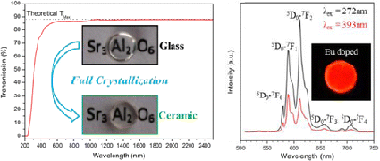
Abstract
The highly visible and infrared (up to 6 mu m) transparent Sr3Al2O6 polycrystalline ceramic was obtained by full crystallization of the corresponding glass composition. The glass synthesis and the direct congruent crystallization processes are described, and the material transparency is discussed in light of its microstructure. This new transparent ceramic exhibits a high density (i.e., complete absence of porosity) and micrometer-scale crystallites with very thin grain boundaries. These microstructural characteristics, inherent to the preparation method, minimize light scattering and demonstrate the advantages of this synthesis route compared to the high-pressure process used for the few reported transparent polycrystalline materials. This Sr3Al2O6 ceramic shows a H = 10.5 GPa hardness, a E-r = 150 GPa reduced elasticity modulus, and a 9.6 x 10(-6) K-1 thermal expansion coefficient. Such a transparent strontium aluminate ceramic opens the way to a wide range of applications, especially photonics when doped by various doping agents. As examples, the luminescence of Sr3Al2O6:Eu3+ and Sr3Al2O6:Er3+, which show strong emissions in the visible and infrared ranges, respectively, is presented. Moreover, the Sr3Al2O6:Ce3+ material was found to exhibit scintillation properties under X-ray excitation. Interestingly, the analogous Sr3Ga2O6 transparent polycrystalline ceramic material could equally be prepared using the same elaboration method, although its hygroscopicity prevents the preservation of its high transparency under normal conditions. The establishment of the key factors for the transparency of this economical and innovative synthesis method should enable the prediction of new classes of technologically relevant transparent ceramics.
October, 2013 · DOI: 10.1021/cm401953d
Materiales Coloidales
Crystal Structure and Luminescent Properties of Eu3+-Doped A-La2Si2O7 Tetragonal Phase Stabilized by Spray Pyrolysis Synthesis
Fernandez-Carrion, Alberto J.; Ocana, Manuel; Florian, Pierre; Garcia-Sevillano, Jorge; Cantelar, Eugenio; Fitch, Andrew N.; Suchomel, Matthew R.; Becerro, Ana I.Journal of Physical Chemistry C, 117 (2013) 20876-20886 DOI: 10.1021/jp407172z
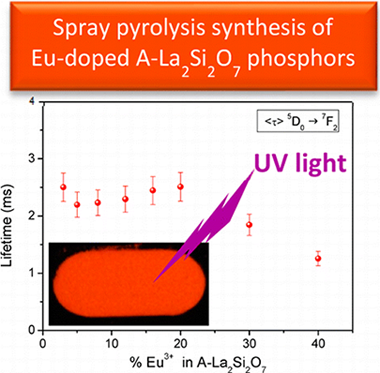
Abstract
Pure A-La2Si2O7 powder has been synthesized through a spray pyrolysis method followed by calcination at 1100 degrees C for 15 h. The crystallographic structure, refined from the synchrotron powder diffraction pattern of the sample, showed tetragonal symmetry with space group P4(1), a = 6.83565(1) angstrom, and c = 24.84133(1) angstrom. The Si-29 and La-139 NMR spectra have been described here for the first time in the literature and could be simulated with four Si and four La resonances, respectively, in good agreement with the presence of four Si and four La crystallographic sites in the unit cell. The same synthesis method was 2 successful for the synthesis of Eu3+-doped A-La2Si2O7 (%Eu = 3-40). The analysis of the unit cell volumes indicated that Eu3+ replaces La3+ in the unit cell for all Eu3+ substitution levels investigated. However, anomalous diffraction data indicated that the La/Eu substitution mechanism was not homogeneous, but Eu much prefers to occupy the RE3 sites. The Eu-doped A-La2Si2O7 phosphors thus synthesized exhibited a strong orange-red luminescence after excitation at 393 nm. Lifetime measurements indicated that the optimum phosphor was that with an Eu3+ content of 20%, which showed a lifetime of 2.3 ms. The quantum yield of the latter was found to be 12% at 393 nm excitation. These experimental observations together with the high purity of the phase obtained by the proposed spray pyrolysis method make this material an excellent phosphor for optoelectronic applications.
October, 2013 · DOI: 10.1021/jp407172z
Materiales Coloidales - Materiales y Procesos Catalíticos de Interés Ambiental y Energético
Monoclinic–Tetragonal Heterostructured BiVO4 by Yttrium Doping with Improved Photocatalytic Activity
Usai, S; Obregon, S; Becerro, AI; Colon, GJournal of Physical Chemistry C, 117 (2013) 24479-24484 DOI: 10.1021/jp409170y
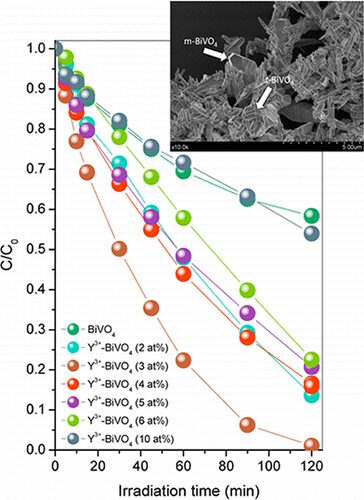
Abstract
Yttrium-doped BiVO4 has been synthesized by means of a surfactant free hydrothermal method having good photoactivities under sun-like excitation for the degradation of Methylene Blue (MB). From the structural and morphological characterization it has been stated that the presence of Y3+ induces the progressive stabilization of the tetragonal phase and the slight higher surface area values. By following the tetragonal cell parameters, the substitutional incorporation of Y3+ into the BiVO4 tetragonal lattice might be considered. Best photocatalytic performances were attained for the samples with Y3+ content of 3.0 at. % for which the MB degradation rate constant appears 2-fold higher. Furthermore, photoactivities for visible-light-driven O2 evolution demonstrate that the photocatalytic performance of the best Y-doped system (initial rate of O2 evolution, 285 μmol g–1 h–1) was more than 5 times that of undoped m-BiVO4 (initial rate of O2 evolution, 53 μmol g–1 h–1). The occurrence of Y3+ doping and a monoclinic–tetragonal heterostructured BiVO4 system induces the higher photocatalytic activities. PL analysis provides a clear evidence of the lower charge carriers recombination in heterostructured yttrium-doped systems.
October, 2013 · DOI: 10.1021/jp409170y
Materiales Coloidales
Small Particle-Size Talc Is Associated with Poor Outcome and Increased Inflammation in Thoracoscopic Pleurodesis
Arellano-Orden, E; Romero-Falcon, A; Juan, JM; Jurado, MO; Rodriguez-Panadero, F; Montes-Worboys, ARespiration, 86 (2013) 201-209 DOI: 10.1159/000342042
Abstract
Rationale: Talc is very effective for pleurodesis, but there is concern about complications, especially acute respiratory distress syndrome. Objectives: It was the aim of this study to investigate if talc with a high concentration of small particles induces greater production of cytokines, and if pleural tumor burden has any influence on the local production and spillover of cytokines to the systemic circulation and eventual complications. Methods: We investigated 227 consecutive patients with malignant effusion submitted to talc pleurodesis. One hundred and three patients received ‘small-particle talc' (ST; containing about 50% particles <10 µm) and 124 received ‘large-particle talc' (with <20% particles <10 µm). Serial samples of both pleural fluid and blood were taken before and 3, 24, 48 and 72 h after thoracoscopy. Also, mesothelial cells were stimulated with both types of talc in vitro. Measurements and Results: Interleukin-8, tumor necrosis factor-α, vascular endothelial growth factor, basic fibroblast growth factor and thrombin-antithrombin complex were measured in all samples. Early death (<7 days after talc) occurred in 8 of 103 patients in the ST and in 1 of 124 in the ‘large-particle talc' group (p = 0.007). Patients who received ST had significantly higher proinflammatory cytokines in pleural fluid and serum after talc application, and also in supernatants of the in vitro study. Pleural tumor burden correlated positively with proinflammatory cytokines in serum, suggesting that advanced tumor states induce stronger systemic reactions after talc application. Conclusions: ST provokes a strong inflammatory reaction in both pleural space and serum, which is associated with a higher rate of early deaths observed in patients receiving it.
September, 2013 · DOI: 10.1159/000342042
Materiales Coloidales
Surface modified Eu:GdVO4 nanocrystals for optical and MRI imaging
Nuñez, Nuria O.; Rivera, Sara; Alcantara, David; de la Fuente, Jesus M.; Garcia-Sevillano, Jorge; Ocaña, ManuelDalton Transactions, 42 (2013) 10725-10734 DOI: 10.1039/C3DT50676B
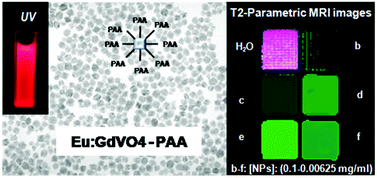
Abstract
A facile solvothermal route has been developed for the preparation of europium doped gadolinium orthovanadate nanoparticles ([similar]70 nm) with tetragonal structure, based on a homogenous precipitation reaction at 120 °C from rare earth precursors (yttrium nitrate and europium nitrate) and sodium orthovanadate solutions using an ethylene glycol–water mixture as the solvent. The effects of the doping level on the luminescence properties were evaluated in order to find the optimum nanophosphors. These nanocrystals were successfully functionalized with amino (two step process) and carboxylate (one-pot process) groups provided by amino-dextran polymers (AMD) and polyacrylic acid (PAA), respectively. It was found that while the luminescent properties of both kinds of functionalized systems were similar, the colloidal stability of the PAA-modified sample was higher, because of which, it was selected to study their cytotoxicity and magnetic properties (relaxivity and phantom analyses) to assess their potentiality as multifunctional probes for both “in vitro” optical biolabels and negative contrast agents for magnetic resonance imaging.
August, 2013 · DOI: 10.1039/C3DT50676B
Materiales Coloidales
Thermal Expansion of Rare-Earth Pyrosilicates
Fernandez-Carrion, AJ; Allix, M; Becerro, AIJournal of the American Ceramic Society, 96 (2013) 2298-2305 DOI: 10.1111/jace.12388
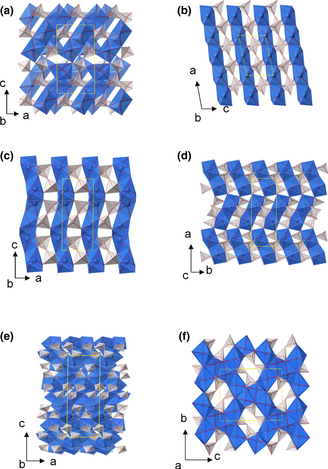
Abstract
The use of RE2Si2O7 materials as environmental barrier coatings (EBCs) and in the sintering process of advanced ceramics demands a precise knowledge of the coefficient of thermal expansion of the RE2Si2O7. High-temperature X-ray diffraction (HTXRD) patterns were collected on different RE2Si2O7 polymorphs, namely A, G, α, β, γ, and δ, to determine the changes in unit cell dimensions. RE2Si2O7 compounds belonging to the same polymorph showed, qualitatively, very similar unit cell parameters behavior with temperature, whereas the different polymorphs of a given RE2Si2O7 compound exhibited markedly different thermal expansion evolution. The isotropy of thermal expansion was demonstrated for the A-RE2Si2O7 polymorph while the rest of polymorphs exhibited an anisotropic unit cell expansion with the biggest expansion directed along the REOx polyhedral chains. The apparent bulk thermal expansion coeficcients (ABCTE) were calculated from the unit cell volume expansion for each RE2Si2O7 compound. All compounds belonging to the same polymorph exhibited similar ABCTE values. However, the ABCTE values differ significantly from one polymorph to the other. The highest ABCTE values correspond to A-RE2Si2O7 compounds, with an average of 12.1 × 10−6 K−1, whereas the lowest values are those of β- and γ-RE2Si2O7, which showed average ABCTE values of ~4.0 × 10−6 K−1.
July, 2013 · DOI: 10.1111/jace.12388
Materiales Ópticos Multifuncionales
Selective UV Reflecting Mirrors Based on Nanoparticle Multilayers
Smirnov, JRC; Calvo, ME; Miguez, HAdvanced Functional Materials, 23 (2013) 2805-2811 DOI: 10.1002/adfm.201202587
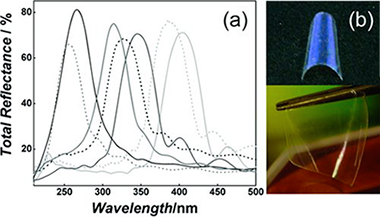
Abstract
A new type of nanostructured selective ultraviolet (UV) reflecting mirror is presented. Periodic porous multilayers with photonic crystal properties are built by spin-coating-assisted layer-by-layer deposition of colloidal suspensions of nanoparticles of ZrO2 and SiO2 (electronic band gap at λ < 220 nm). These optical filters are designed to block well-defined wavelength ranges of the UVA, UVB, and UVC regions of the electromagnetic spectrum while preserving transparency in the visible. The shielding against those spectral regions arises exclusively from optical interference phenomena and depends only on the number of stacked layers and the refractive index contrast between them. In addition, it is shown that the accessible pore network of the as-deposited multilayer allows preparing thin, flexible, self-standing, transferable, and adaptable selective UV filters by polymer infiltration, without significantly losing reflectance intensity, i.e., preserving the dielectric contrast. These films offer a degree of protection comparable to that of traditional ones, without any foreseeable unwanted secondary effects, such as photodegradation, increase of local temperature or, as is the case for organic absorbers, generation of free radicals, all of which are caused by light absorption.
June, 2013 · DOI: 10.1002/adfm.201202587
Materiales Coloidales
Energy transfer efficiency in YF3 nanocrystals: Quantifying the Yb3+ to Tm3+ infrared dynamics
Quintanilla, M; Nuñez, NO; Cantelar, E; Ocaña, M; Cussó, FJournal of Applied Physics, 113 (2013) 174308 (6 pages) DOI: 10.1063/1.4803540
Abstract
In this work, we report on the determination of the infrared Yb3+ → Tm3+ energy transfer efficiency in YF3:Yb3+/Tm3+ nanocrystals through the study of Yb3+ dynamics. The obtained results are compared to those previously reported in macrocrystals to analyze possible changes related to size reduction. Luminescence lifetimes are much shorter in the nanoparticles than in bulk samples, a behavior that can be related to Yb3+ → Yb3+ migration and the enhanced surface/volume ratio of the nanoparticles. On the other hand, Yb3+ → Tm3+ energy transfer macroparameter remains unaltered, demonstrating that spectroscopic intrinsic parameters such as radiative and non-radiative probabilities are not affected by size reduction. Finally, a formula that describes Yb3+ lifetime dependence with Yb3+ and Tm3+ concentration is proposed, considering both the effects produced by migration between Yb3+ ions and energy transfer from Yb3+ to Tm3+ ions.
May, 2013 · DOI: 10.1063/1.4803540
Materiales Ópticos Multifuncionales
Resonant Photocurrent Generation in Dye-Sensitized Periodically Nanostructured Photoconductors by Optical Field Confinement Effects
Anaya, M; Calvo, ME; Luque-Raigon, JM; Miguez, HJournal of the American Chemical Society, 135 (2013) 7803-7806 DOI: 10.1021/ja401096k

Abstract
Herein we show experimental evidence of resonant photocurrent generation in dye-sensitized periodically nanostructured photoconductors, which is achieved by spectral matching of the sensitizer absorption band to different types of localized photon modes present in either periodic or broken symmetry structures. Results are explained in terms of the calculated spatial distribution of the electric field intensity within the configurations under analysis.
May, 2013 · DOI: 10.1021/ja401096k
Materiales Ópticos Multifuncionales
Angular response of photonic crystal based dye sensitized solar cells
López López, C.; Colodrero, S.; Calvo, M.E. and Míguez, H.Energy & Environmental Science, 6 (2013) 1260-1266 DOI: 10.1039/C3EE23609A

Abstract
Herein we report an experimental analysis of the performance of photonic crystal based dye solar cells (PC-DSCs) as the incident light angle moves away from the normal with respect to the cell surface. Nanoparticle multilayers operating at different wavelength ranges were coupled to the working electrode of a dye solar cell for this study. The interplay between optical and photovoltaic properties with the incident light angle is discussed. We demonstrate that an efficiency enhancement is attained for PC-DSCs at all angles measured, and that rational design of the photonic crystal back mirror leads to a reduction of the photocurrent losses related to the tilt angle of the cell, usually labeled as cosine losses. Angular variations of the cell transparency are also reported and discussed. These angular properties are relevant to the application of these solar devices in building integrated photovoltaics as potential window modules.
April, 2013 · DOI: 10.1039/C3EE23609A
Materiales Coloidales
Ionic Liquid Mediated Synthesis and Surface Modification of Multifunctional Mesoporous Eu:GdF3 Nanoparticles for Biomedical Applications
Rodriguez-Liviano, S; Nunez, NO; Rivera-Fernandez, S; de la Fuente, JM; Ocana, MLangmuir, 29 (2013) 3411-3418 DOI: 10.1021/la4001076
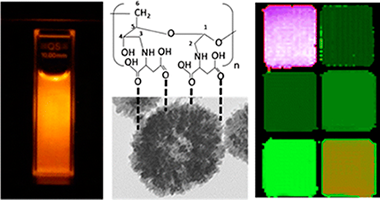
Abstract
A procedure for the synthesis of multifunctional europium(III)-doped gadolinium(III) fluoride (Eu:GdF3) nanoparticles (85 nm) with quasispherical shape by precipitation at 120 °C from diethylene glycol solutions containing lanthanide chlorides and an ionic liquid (1-Butyl, 2-methylimidazolium tetrafluoroborate) as fluoride source has been developed. These nanoparticles were polycrystalline and crystallized into a hexagonal structure, which is unusual for GdF3. They were also mesoporous (pore size = 3.5 Å), having a rather high BET surface area (75 m2 g–1). The luminescent and magnetic (relaxivity) properties of the Eu:GdF3 nanoparticles have been also evaluated in order to assess their potentiality as “in vitro” optical biolabels and contrast agent for magnetic resonance imaging. Finally, a procedure for their functionalization with aspartic-dextran polymers is also reported. The functionalized Eu:GdF3 nanoparticles presented negligible toxicity for Vero cells, which make them suitable for biotecnological applications.
March, 2013 · DOI: 10.1021/la4001076
Materiales Coloidales
LaPO4:Er microspheres with high NIR luminescent quantum yield
Garcia-Sevillano, J; Cantelar, E; Justo, A; Ocana, M; Cusso, FMaterials Chemistry and Physics, 138 (2013) 666-671 DOI: 10.1016/j.matchemphys.2012.12.036
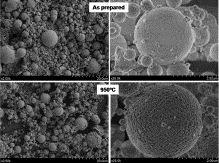
Abstract
Er-doped LaPO4 microspheres have been synthesized by spray pyrolysis and the near infrared (NIR) properties have been characterized. It has been found that, following an adequate post-annealing treatment, the emission properties are remarkably improved. The NIR luminescence intensity is highly enhanced and its decay time increases to a value almost coincident with the reported radiative lifetime, which implies that the quantum yield approaches η ≈ 100%. This improvement in luminescence characteristics is probably related to the suppression of residual OH− radicals, that otherwise act as NIR luminescence quenchers, and to the increase in material's crystallinity.
March, 2013 · DOI: 10.1016/j.matchemphys.2012.12.036
Materiales Coloidales - Materiales Ópticos Multifuncionales
Microwave-Assisted Synthesis of Biocompatible Europium-Doped Calcium Hydroxyapatite and Fluoroapatite Luminescent Nanospindles Functionalized with Poly(acrylic acid)
Escudero, A; Calvo, ME; Rivera-Fernandez, S; de la Fuente, JM; Ocana, MLangmuir, 29 (2013) DOI: 10.1021/la304534f

Abstract
Europium-doped calcium hydroxyapatite and fluoroapatite nanophosphors functionalized with poly(acrylic acid) (PAA) have been synthesized through a one-pot microwave-assisted hydrothermal method from aqueous basic solutions containing calcium nitrate, sodium phosphate monobasic, and PAA, as well as sodium fluoride in the case of the fluoroapatite particles. In both cases a spindlelike morphology was obtained, resulting from an aggregation process of smaller subunits which also gave rise to high specific surface area. The size of the nanospindles was 191 (32) × 40 (5) nm for calcium hydroxyapatite and 152 (24) × 38 (6) nm for calcium fluoroapatite. The luminescent nanoparticles showed the typical red luminescence of Eu3+, which was more efficient for the fluoroapatite particles than for the hydroxyapatite. This is attributed to the presence of OH– quenchers in the latter. The nanophosphors showed negligible toxicity for Vero cells. Both PAA-functionalized nanophosphors showed a very high (up to at least 1 week) colloidal stability in 2-(N-morpholino)ethanesulfonic acid (MES) at pH 6.5, which is a commonly used buffer for physiological pH. All these features make both kinds of apatite-based nanoparticles promising tools for biomedical applications, such as luminescent biolabels and tracking devices in drug delivery systems.
February, 2013 · DOI: 10.1021/la304534f
Materiales Coloidales
A Novel 3D Architecture of GdPO4 Nanophosphors: Multicolored and White Light Emission
Becerro, AI; Rodriguez-Liviano, S; Fernandez-Carrion, AJ; Ocaña, MCrystal Growth & Design, 55 (2013) 454-460 DOI: 10.1021/cg301023k
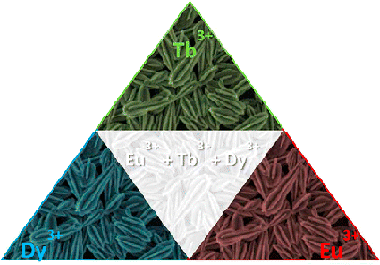
Abstract
Homogeneous monoclinic GdPO4 particles composed of three intersecting lance-shaped crystals forming a penetration twin have been synthesized following a very restrictive, simple, and fast (10 min) method consisting of the hydrothermal reaction of gadolinium acetylacetonate with H3PO4 in a mixture of ethylene glycol and water at 180 °C. Slightly increasing the amount of water in the solvent mixture leads to hexagonal rodlike GdPO4·0.5H2O nanoparticles, whereas the variation of the Gd source, PO4 source, aging temperature, and polyol type gave rise to heterogeneous particles. The synthesis procedure is also suitable for the preparation of Eu3+-, Tb3+-, and Dy3+-doped GdPO4 particles with the same morphology and crystalline structure as the undoped materials. The effect of the doping level on the luminescent properties of the twinlike nanophosphors was evaluated, finding optimum doping levels of 5, 5, and 1% for the Eu3+-, Tb3+-, and Dy3+-doped materials, respectively. The twinlike GdPO4 nanophosphors were found to be more efficient than the rodlike GdPO4 ones in terms of emission intensity. Finally, a solid-state single-phase white-light-emitting nanophosphor has been fabricated for the first time in this system by triply doping the GdPO4 twined particles with appropriate concentrations of Eu3+, Tb3+, and Dy3+ and exciting through the Gd–Ln energy-transfer band at 273 nm. In addition to this energy transfer band, other energy charge transfer processes among the three dopants (Eu3+, Tb3+, and Dy3+) have been observed in the triply doped material.
February, 2013 · DOI: 10.1021/cg301023k
Materiales Coloidales
Synthesis and Properties of Multifunctional Tetragonal Eu:GdPO4 Nanocubes for Optical and Magnetic Resonance Imaging Applications
Rodriguez-Liviano, S; Becerro, AI; Alcantara, D; Grazu, V; de la Fuente, JM; Ocana, MInorganic Chemistry, 52 (2013) 647-654 DOI: 10.1021/ic3016996
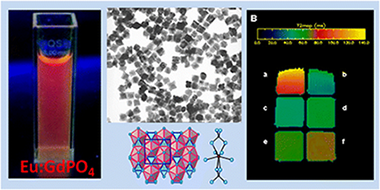
Abstract
A simple and fast (7 min) procedure for synthesis of gadolinium phosphate nanocubes (edge = 75 nm) based on the microwave-assisted heating at 120 °C of gadolinium acetylacetonate and phosphoric acid solutions in buthylene glycol is reported. These nanocubes were highly crystalline and crystallized into a tetragonal structure, which has not been ever reported for pure gadolinium phosphate. Determination of such crystal structure has been carried out here for the first time in the literature by means of powder X-ray diffraction. The developed synthesis procedure was also successful for preparation of multifunctional europium(III)-doped the gadolinium phosphate nanocubes, which were nontoxic for cells and exhibited strong red luminescence under UV illumination and high transverse relaxivity (r2) values. These properties confer them potential applications as biolabels for in vitro optical imaging and as negative contrast agent for magnetic resonance imaging.
January, 2013 · DOI: 10.1021/ic3016996
Nanotecnología en Superficies y Plasma - Materiales Coloidales
Synthesis and functionalization of biocompatible Tb:CePO4 nanophosphors with spindle-like shape
Rodriguez-Liviano, S; Aparicio, FJ; Becerro, AI; Garcia-Sevillano, J; Cantelar, E; Rivera, S; Hernandez, Y; de la Fuente, JM; Ocana, MJournal of Nanoparticle Research 15 (2013) 15:1402 DOI: 10.1007/s11051-012-1402-7
Abstract
Monoclinic Tb:CePO4 nanophosphors with a spindle-like morphology and tailored size (in the nanometer and micrometer range) have been prepared through a very simple procedure, which consists of aging, at low temperature (120 °C), ethylene glycol solutions containing only cerium and terbium acetylacetonates and phosphoric acid, not requiring the addition of surfactants or capping agents. The influence of the heating mode (conventional convection oven or microwave oven) and the Tb doping level on the luminescent, structural and morphological features of the precipitated nanoparticles have also been analyzed. This study showed that microwave-assisted heating resulted in an important beneficial effect on the luminescent properties of these nanophosphors. Finally, a procedure for the functionalization of the Tb:CePO4 nanoparticles with aspartic-dextran is also reported. The functionalized nanospindles presented negligible toxicity for Verocells, which along with theirs excellent luminescent properties, make them suitable for biomedical applications.
January, 2013 · DOI: 10.1007/s11051-012-1402-7
2012
2012
Materiales Coloidales
Revealing Structural Detail in the High Temperature La2Si2O7–Y2Si2O7 Phase Diagram by Synchrotron Powder Diffraction and Nuclear Magnetic Resonance Spectroscopy
Fernandez-Carrion, AJ; Allix, M; Florian, P; Suchomel, MR; Becerro, AIJournal of Physical Chemistry C, 116 (2012) 21523-21535 DOI: 10.1021/jp305777m
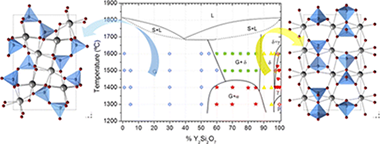
Abstract
High resolution synchrotron powder XRD, 89Y CPMG NMR, and 139La MAS NMR spectroscopy have been applied to eventually draw the phase diagram of the La2Si2O7–Y2Si2O7 system. The diagram presents a solid solubility region of G-(La,Y)2Si2O7, which extends to the La0.9Y1.1Si2O7 composition at any temperature of this study. Compositions richer in Y show two-phase domains, with G + α at T < 1450 °C and G + δ at T > 1450 °C. The Y-rich extreme is more complex, showing two solid solution regions of δ- and γ-(La,Y)2Si2O7 polymorphs which appear with increasing Y content, respectively. It is interesting to note that the La for Y substitution mechanism in the G-(La,Y)2Si2O7 polymorph is not homogeneous, but a preferential occupation of Y for the RE2 site is observed. Finally, the 89Y and 139La isotropic chemical shift values in G-(La,Y)2Si2O7 have been described here for the first time and assigned to the different RE crystallographic sites of the unit cell.
October, 2012 · DOI: 10.1021/jp305777m
Materiales Ópticos Multifuncionales
Characterization of Mesoporous Thin Films by Specular Reflectance Porosimetry
Hidalgo, N; Lopez-Lopez, C; Lozano, G; Calvo, ME; Miguez, HLangmuir, 28 (2012) 13777-13782 DOI: 10.1021/la3025793
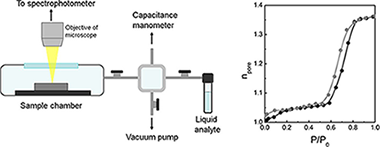
Abstract
The pore size distribution of mesoporous thin films is herein investigated through a reliable and versatile technique coined specular reflectance porosimetry. This method is based on the analysis of the gradual shift of the optical response of a porous slab measured in quasi-normal reflection mode that occurs as the vapor pressure of a volatile liquid varies in a closed chamber. The fitting of the spectra collected at each vapor pressure is employed to calculate the volume of solvent contained in the interstitial sites and thus to obtain adsorption–desorption isotherms from which the pore size distribution and internal and external specific surface areas are extracted. This technique requires only a microscope operating in the visible range attached to a spectrophotometre. Its suitability to analyze films deposited onto arbitrary substrates, one of the main limitations of currently employed ellipsometric porosimetry and quartz balance techniques, is demonstrated. Two standard mesoporous materials, supramolecularly templated mesostructured films and packed nanoparticle layers, are employed to prove the concept proposed herein.
October, 2012 · DOI: 10.1021/la3025793
Materiales Ópticos Multifuncionales
Optical interference for the matching of the external and internal quantum efficiencies in organic photovoltaic cells
Betancur, R; Martinez-Otero, A; Elias, X; Romero-Gomez, P; Colodrero, S; Miguez, H; Martorell, JSolar Energy Materials and Solar Cells, 104 (2012) 87-91 DOI: 10.1016/j.solmat.2012.04.047
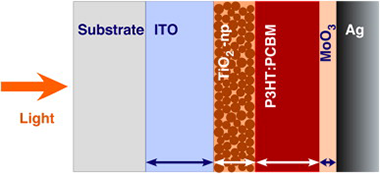
Abstract
We demonstrate experimentally that an appropriate combination of the layer thicknesses in an inverted P3HT:PCBM cell leads to an optical interference such that the EQE amounts to 91% of IQE. We observe that reflectivity between layers is minimized in a wavelength range of more than 100 nm. In that range the EQE closely matches the IQE. The role played by the optical interference in improving the performance of the fabricated solar cells is confirmed by EQE calculated numerically using a model based on the transfer matrix method. Additionally, we observed that a similar cell with an active material 1.7 times thicker exhibited a lower PCE. The poor photon harvesting in the later cell configuration is attributed to an EQE that amounts only to 72% of the IQE.
September, 2012 · DOI: 10.1016/j.solmat.2012.04.047
Materiales Coloidales
Structural and kinetic study of phase transitions in LaYSi2O7
Fernandez-Carrion, AJ; Escudero, A; Suchomel, MR; Becerro, AIJournal of the European Ceramic Society, 32 (2012) 2477-2486 DOI: 10.1016/j.jeurceramsoc.2012.03.009
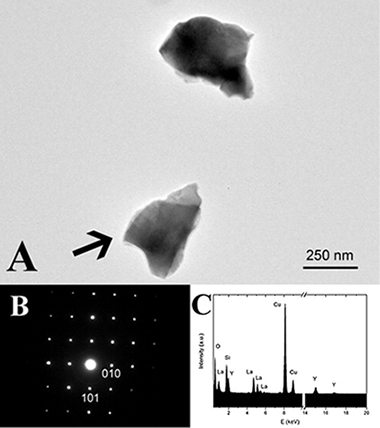
Abstract
Phase transitions in LaYSi 2O 7 have been investigated as a function of temperature using XRD, NMR and TEM. Previously described empirical crystal structure guidelines based on average cation radius in rare-earth RE 2Si 2O 7-type disilicates predict a stable tetragonal A-LaYSi 2O 7 polymorph at temperatures below 1500°C. This study demonstrates that A-LaYSi 2O 7 is not thermodynamically stable at these temperatures and suggests that guidelines based on average cation size do not accurately describe the equilibrium behaviour of this silicate system. The A to G-type polymorph transition is extremely sluggish; complete transformation requires ~250h at 1200°C, and more than 3 weeks of calcination at 1100°C. This observation is important when this type of material is used as environmental barrier coating (EBC) of advanced ceramics. Analysis of XRD and TEM data reveal complete substitution of Y and La on the rare-earth cation sites in both LaYSi 2O 7 polymorphs, but indicate preferential site occupancies in the G-type polymorph.
August, 2012 · DOI: 10.1016/j.jeurceramsoc.2012.03.009
Materiales Ópticos Multifuncionales
Introducing structural colour in DSCs by using photonic crystals: interplay between conversion efficiency and optical properties
Colonna, D; Colodrero, S; Lindstrom, H; Di Carlo, A; Miguez, HEnergy & Environmental Science, 5 (2012) 8238-8243 DOI: 10.1039/c2ee02658a
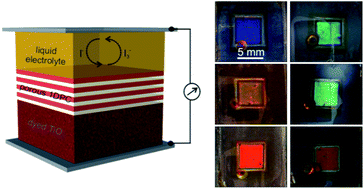
Abstract
Herein we analyze experimentally the effect that introducing highly reflecting photonic crystals, operating at different spectral ranges, has on the conversion efficiency of dye sensitized solar cells. The interplay between structural colour and cell performance is discussed on the basis of the modified spectral response of the photogenerated current observed and the optical characterization of the cells. We demonstrate that, with the approach herein discussed, it is possible to achieve relatively high efficiencies using thin electrodes while preserving transparency. At the same time, the appearance of the device can be controllably modified, which is of relevance for their potential application in building integrated photovoltaics (BIPV) as window modules.
August, 2012 · DOI: 10.1039/c2ee02658a
Materiales Ópticos Multifuncionales
Effect of nanostructured electrode architecture and semiconductor deposition strategy on the photovoltaic performance of quantum dot sensitized solar cells
Samadpour, M; Gimenez, S; Boix, PP; Shen, Q; Calvo, ME; Taghavinia, N; Zad, AI; Toyoda, T; Miguez, H; Mora-Sero, IElectrochimica Acta, 75 (2012) 139-147 DOI: 10.1016/j.electacta.2012.04.087
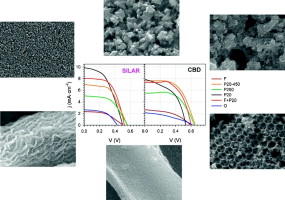
Abstract
Here we analyze the effect of two relevant aspects related to cell preparation on quantum dot sensitized solar cells (QDSCs) performance: the architecture of the TiO 2 nanostructured electrode and the growth method of quantum dots (QD). Particular attention is given to the effect on the photovoltage, V oc, since this parameter conveys the main current limitation of QDSCs. We have analyzed electrodes directly sensitized with CdSe QDs grown by chemical bath deposition (CBD) and successive ionic layer adsorption and reaction (SILAR). We have carried out a systematic study comprising structural, optical, photophysical and photoelectrochemical characterization in order to correlate the material properties of the photoanodes with the functional performance of the manufactured QDSCs. The results show that the correspondence between photovoltaic conversion efficiency and the surface area of TiO 2 depends on the QDs deposition method. Higher V oc values are systematically obtained for TiO 2 morphologies with decreasing surface area and for cells using CBD growth method. This is systematically correlated to a higher recombination resistance of CBD sensitized electrodes. Electron injection kinetics from QDs into TiO 2 also depends on both the TiO 2 structure and the QDs deposition method, being systematically faster for CBD. Only for electrodes prepared with small TiO 2 nanoparticles SILAR method presents better performance than CBD, indicating that the small pore size disturb the CBD growth method. These results have important implications for the optimization of QDSCs.Elect
July, 2012 · DOI: 10.1016/j.electacta.2012.04.087
Materiales Ópticos Multifuncionales
Novel approaches to flexible visible transparent hybrid films for ultraviolet protection
Calvo, ME; Smirnov, JRC; Miguez, HJournal of Polymer Science Part B-Polymer Physics, 50 (2012) 945-956 DOI: 10.1002/polb.23087
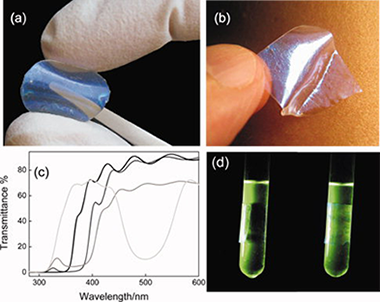
Abstract
Herein, we present an overview of the most recent achievements and innovations regarding the development of flexible visible transparent films for selective ultraviolet (UV) shielding, with focus on those based on hybrid inorganic-organic materials. The main synthetic paths used nowadays to ensure a high degree of protection are reviewed. Polymers containing organic UV absorbing molecules, hybrid mixtures of polymers and nanoparticles, and the recently introduced series of structures displaying structural color, are identified as the three main types of materials used for this purpose. The use of biocompatible and flexible films to achieve spectrally selective UV protection can find applications in a wide diversity of fields such as photo-treatment of skin diseases, food and beverage packing, and storage of cosmetics. © 2012 Wiley Periodicals, Inc. J Polym Sci Part B: Polym Phys, 2012 In this review, the different approaches taken to obtain flexible and transparent films that block ultraviolet radiation based on the use of hybrid materials are covered. The synthetic pathways that lead to films that can shield against UV radiation either by absorption or by interference are described.
July, 2012 · DOI: 10.1002/polb.23087
Materiales Coloidales
Aluminum solubility in TiO2 rutile at high pressure and experimental evidence for a CaCl2-structured polymorph
Escudero, A; Langenhorst, F; Muller, WFAmerican Mineralogist, 97 (2012) 1075-1082 DOI: 10.2138/am.2012.4049
Abstract
Aluminum incorporation into TiO 2 has been studied in the TiO 2-Al 2O 3 system as a function of pressure at temperatures of 900 and 1300 °C using commercial Al 2TiO 5 nanopowder as starting material. A new orthorhombic TiO 2 polymorph with the CaCl 2 structure has been observed in the recovered samples synthesized from 4.5 to 7 GPa and 900 °C and from 2.5 to 7 GPa at 1300 °C. The phase transition to the α-PbO 2 type TiO 2 phase takes place between 7 and 10 GPa at both temperatures. Two mechanisms of Al incorporation in TiO 2 rutile have been observed in the recovered samples. The substitution of Ti 4+ by Al 3+ on normal octahedral sites is dominant at lower pressures. High pressure induces the incorporation of Al 3+ into octahedral interstices of the rutile structure, which is responsible for an orthorhombic distortion of the TiO 2 rutile structure and gives rise to a (110) twinned CaCl 2 type structure. This phase is probably a result of temperature quench at high pressure. Aluminum solubility in TiO 2 increases with increasing pressure. TiO 2 is able to accommodate up to 9.8 wt% Al 2O 3 at 7 GPa and 1300 °C. Temperature has a large effect on the aluminum incorporation in TiO 2, especially at higher pressures. High pressure has a strong effect on both the chemistry and the microstructure of Al-doped TiO 2. Enhanced aluminum concentration in TiO 2 rutile as well as TiO 2 grains with a microstructure consisting of twins are a clear indication of high-pressure conditions.
July, 2012 · DOI: 10.2138/am.2012.4049
Materiales Ópticos Multifuncionales
Integration of Gold Nanoparticles in Optical Resonators
Jimenez-Solano, A; Lopez-Lopez, C; Sanchez-Sobrado, O; Luque, JM; Calvo, ME; Fernandez-Lopez, C; Sanchez-Iglesias, A; Liz-Marzan, LM; Miguez, HLangmuir, 28 (2012) 9161-9167 DOI: 10.1021/la300429k
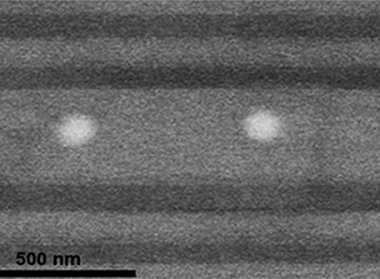
Abstract
The optical absorption of one-dimensional photonic crystal based resonators containing different types of gold nanoparticles is controllably modified by means of the interplay between planar optical cavity modes and localized surface plasmons. Spin-casting of metal oxide nanoparticle suspensions was used to build multilayered photonic structures that host (silica-coated) gold nanorods and spheres. Strong reinforcement and depletion of the absorptance was observed at designed wavelength ranges, thus proving that our method provides a reliable means to modify the optical absorption originated at plasmonic resonances of particles of arbitrary shape and within a wide range of sizes. These observations are discussed on the basis of calculations of the spatial and spectral dependence of the optical field intensity within the multilayers.
June, 2012 · DOI: 10.1021/la300429k
Materiales Coloidales
Chromium incorporation into TiO2 at high pressure
Escudero, A; Langenhorst, FJournal of Solid State Chemistry, 190 (2012) 61-67 DOI: 10.1016/j.jssc.2012.01.041
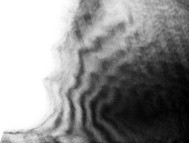
Abstract
Chromium incorporation into TiO 2 up to 3 GPa at 1300 °C and 900 °C has been studied by XRD as well as TEM. A CaCl 2 type TiO 2 polymorph has been observed in the quenched samples from high pressure. Two different mechanisms of solubility occur in the recovered samples. Chromium replaces titanium on normal octahedral sites but it also occupies interstitial octahedral sites, especially in the samples recovered from higher pressures. Interstitial chromium is responsible for an orthorhombic distortion of the TiO 2 rutile structure in the quenched samples and gives rise to a (1 1 0) twinned CaCl 2-structured polymorph. This phase is very likely the result of temperature quench at high pressure. The formation of this phase is directly related to the chromium content of the TiO 2 grains. Chromium solubility in TiO 2 increases with increasing the synthesis pressure. TiO 2 is able to accommodate up to 15.3 wt% Cr 2O 3 at 3 GPa and 1300 °C, compared to 5.7 wt% at atmospheric pressure at the same temperature.
June, 2012 · DOI: 10.1016/j.jssc.2012.01.041
Materiales Ópticos Multifuncionales
Effect of diffuse light scattering designs on the efficiency of dye solar cells: An integral optical and electrical description
Galvez, FE; Kemppainen, E; Miguez, H; Halme, JJournal of Physical Chemistry C, 116 (2012) 11426-11433 DOI: 10.1021/jp2092708

Abstract
Herein, we present an integral optical and electrical theoretical analysis of the effect of different diffuse light scattering designs on the performance of dye solar cells. Light harvesting efficiencies and electron generation functions extracted from optical numerical calculations based on a Monte Carlo approach are introduced in a standard electron diffusion model to obtain the steady-state characteristics of the different configurations considered. We demonstrate that there is a strong dependence of the incident photon to current conversion efficiency, and thus of the overall conversion efficiency, on the interplay between the value of the electron diffusion length considered and the type of light scattering design employed, which determines the spatial dependence of the electron generation function. Other effects, like the influence of increased photoelectron generation on the photovoltage, are also discussed. Optimized scattering designs for different combinations of electrode thickness and electron diffusion length are proposed.
May, 2012 · DOI: 10.1021/jp2092708
Materiales Coloidales
Incorporation of Si into TiO2 phases at high pressure
Escudero, A; Langenhorst, FAmerican Mineralogist, 97 (2012) 524-531 DOI: 10.2138/am.2012.3941
Abstract
Silicon incorporation in TiO 2 phases at increasing pressures until 20 GPa at 1300 °C has been studied by XRD and TEM. Rutile is the stable Si-doped TiO 2 phase until at least 7 GPa, transforming into α-PbO 2 structured TiO2 between 7 and 10 GPa. The further transformation to the TiO 2 polymorph with the baddeleyite structure, akaogiite, has not been observed on the quenched samples. XRD and TEM-EDX data suggest that the Si-doped TiO 2 akaogiite polymorph is non-quenchable and reverts to a-PbO2 structured TiO 2 when releasing the pressure. This transformation gives rise to α-PbO 2 structured TiO 2 grains decorated with p fringes stacking faults. Silicon solubility in TiO 2 phases increases with increasing the synthesis pressure until 16 GPa, implying the substitutional solid solution to be the mechanism of solubility. The influence of the dopants on the stability of the rutile and the α-PbO2 structured TiO 2 has also been analyzed.
April, 2012 · DOI: 10.2138/am.2012.3941
Materiales Ópticos Multifuncionales
Efficient Transparent Thin Dye Solar Cells Based on Highly Porous 1D Photonic Crystals
Colodrero, S; Forneli, A; Lopez-Lopez, C; Pelleja, L; Miguez, H; Palomares, EAdvanced Functional Materials, 22 (2012) 1303-1310 DOI: 10.1002/adfm.201102159
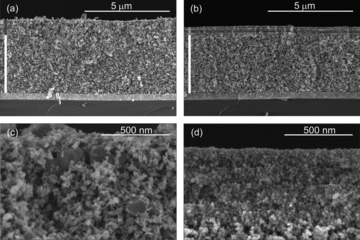
Abstract
A working electrode design based on a highly porous 1D photonic crystal structure that opens the path towards high photocurrents in thin, transparent, dye-sensitized solar cells is presented. By enlarging the average pore size with respect to previous photonic crystal designs, the new working electrode not only increases the device photocurrent, as predicted by theoretical models, but also allows the observation of an unprecedented boost of the cell photovoltage, which can be attributed to structural modifications caused during the integration of the photonic crystal. These synergic effects yield conversion efficiencies of around 3.5% by using just 2 mu m thick electrodes, with enhancements between 100% and 150% with respect to reference cells of the same thickness.
March, 2012 · DOI: 10.1002/adfm.201102159
Materiales Coloidales
Synthesis and Structure Resolution of RbLaF4
Rollet, AL; Allix, M; Veron, E; Deschamps, M; Montouillout, V; Suchomel, MR; Suard, E; Barre, M; Ocana, M; Sadoc, A; Boucher, F; Bessada, C; Massiot, D; Fayon, FInorganic Chemistry, 51 (2012) 2272-2282 DOI: 10.1021/ic202301e

Abstract
The synthesis and structure resolution of RbLaF4 are described. RbLaF4 is synthesized by solid-state reaction between RbF and LaF3 at 425 degrees C under a nonoxidizing atmosphere. Its crystal structure has been resolved by combining neutron and synchrotron powder diffraction data refinements (Pnma, a = 6.46281(2) angstrom, b = 3.86498(1) angstrom, c = 16.176:29(4) angstrom, Z = 4). One-dimensional Rb-87, La-139, and F-19 MAS NMR spectra have been recorded and are in agreement with the proposed structural model. Assignment of the F-19 resonances is performed on the basis of both F-19-La-139 J-coupling multiplet patterns observed in a heteronudear DQ-filtered J-resolved spectrum and F-19-Rb-87 HMQC MAS experiments. DFT calculations of both the F-19 isotropic chemical shieldings and the Rb-87, La-139 electric field gradient tensors using the GIPAW and PAW methods implemented in the CASTEP code are in good agreement with the experimental values and support the proposed structural model. Finally, the conductivity of RbLaF4 and luminescence properties of Eu-doped LaRbF4 are investigated.
March, 2012 · DOI: 10.1021/ic202301e
Materiales Ópticos Multifuncionales
Enhanced diffusion through porous nanoparticle optical multilayers
Lopez-Lopez, C; Colodrero, S; Raga, SR; Lindstrom, H; Fabregat-Santiago, F; Bisquert, J; Miguez, HJournal of Materials Chemistry, 22 (2012) 1751-1757 DOI: 10.1039/c1jm15202e
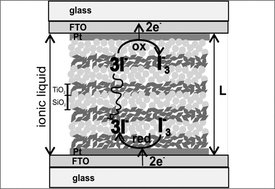
Abstract
Herein we demonstrate improved mass transport through nano-particle one-dimensional photonic crystals of enhanced porosity. Analysis is made by impedance spectroscopy using iodine and ionic liquid based electrolytes and shows that newly created large pores and increased porosity improve the diffusion of species through the photonic crystal. This achievement is based on the use of a polymeric porogen (polyethylene glycol), which is mixed with the precursor suspensions used for the deposition of nanoparticle TiO2 and SiO2 layers and then eliminated to generate a more open interconnected void network, as confirmed by specular reflectance porosimetry. A compromise between pore size and optical quality of these periodic structures is found.
February, 2012 · DOI: 10.1039/c1jm15202e
Materiales Nanoestructurados y Microestructura - Tribología y Protección de Superficies - Materiales Coloidales
Microwave-Assisted Synthesis and Luminescence of Mesoporous REDoped YPO4 (RE = Eu, Ce, Tb, and Ce plus Tb) Nanophosphors with Lenticular Shape
Rodriguez-Liviano, S; Aparicio, FJ; Rojas, TC; Hungria, AB; Chinchilla, LE; Ocana, MCrystal Growth and Design, 12 (2012) 635-645 DOI: 10.1021/cg201358c
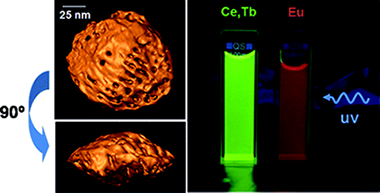
Abstract
Mesoporous tetragonal RE:YPO 4 nanophosphors (RE = Eu, Ce, Tb, and Ce + Tb) with a lenticular morphology, narrow size distribution, and high surface area have been prepared by an homogeneous precipitation procedure consisting of aging, at low temperature (80-120 °C) in a microwave oven, ethylene glycol solutions containing only yttrium acetylacetonate and phosphoric acid. This synthesis method involves important advantages such as its simplicity, rapidness (reaction time = 7 min), and high reaction yields. The mechanism of nanoparticle growth has been also addressed finding that the lenticular nanoparticles are formed through an ordered aggregation of smaller entities, which explains their porosity. In all cases, the doping levels were systematically varied in order to optimize the nanophosphors luminescence. All optimum nanophosphors presented a high luminescence quantum yield (QY). In particular, for the Eu and Tb doped systems, the obtained QY values (60% for Eu and 80% for Tb) were the highest so far reported for this kind of nanomaterial. The morphological, microstructural, and luminescent properties of these nanophosphors and their dispersibility in water make them suitable for biomedical applications.
February, 2012 · DOI: 10.1021/cg201358c
Materiales Ópticos Multifuncionales
Collective osmotic shock in ordered materials
Paul Zavala-Rivera, Kevin Channon, Vincent Nguyen, Easan Sivaniah, Dinesh Kabra, Richard H. Friend, S. K. Nataraj, Shaheen A. Al-Muhtaseb, Alexander Hexemer, Mauricio E. Calvo & Hernan MiguezNature Materials, 11 (2012) 53–57 DOI: 10.1038/nmat3179
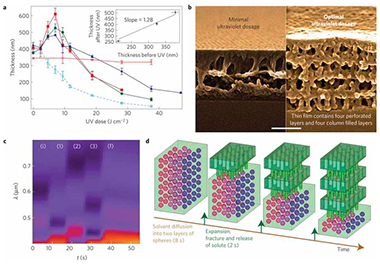
Abstract
Osmotic shock in a vesicle or cell is the stress build-up and subsequent rupture of the phospholipid membrane that occurs when a relatively high concentration of salt is unable to cross the membrane and instead an inflow of water alleviates the salt concentration gradient. This is a well-known failure mechanism for cells and vesicles (for example, hypotonic shock) and metal alloys (for example, hydrogen embrittlement). We propose the concept of collective osmotic shock, whereby a coordinated explosive fracture resulting from multiplexing the singular effects of osmotic shock at discrete sites within an ordered material results in regular bicontinuous structures. The concept is demonstrated here using self-assembled block copolymer micelles, yet it is applicable to organized heterogeneous materials where a minority component can be selectively degraded and solvated whilst ensconced in a matrix capable of plastic deformation. We discuss the application of these self-supported, perforated multilayer materials in photonics, nanofiltration and optoelectronics.
January, 2012 · DOI: 10.1038/nmat3179
2011
2011
Materiales Ópticos Multifuncionales
Porous one dimensional photonic crystals: novel multifunctional materials for environmental and energy applications
Mauricio E. Calvo, Silvia Colodrero, Nuria Hidalgo, Gabriel Lozano, Carmen López-López, Olalla Sánchez-Sobrado and Hernán MíguezEnergy and Environmental Science, 4 (2011) 4800-4812 DOI: 10.1039/C1EE02081A
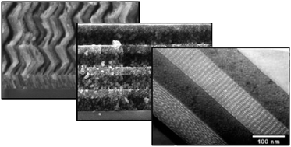
Abstract
In recent times, several synthetic pathways have been developed to create multilayered materials of diverse composition that combine accessible porosity and optical properties of structural origin, i.e., not related to absorption. These materials possess a refractive index that varies periodically along one direction, which gives rise to optical diffraction effects characteristic of Bragg stacks or one-dimensional photonic crystals (1DPCs). The technological potential of such porous optical materials has been demonstrated in various fields related to energy and environmental sciences, such as detection and recognition of targeted biological or chemical species, photovoltaics, or radiation shielding. In all cases, improved performance is achieved as a result of the added functionality porosity brings. In this review, a unified picture of this emerging field is provided.
December, 2011 · DOI: 10.1039/C1EE02081A
Materiales Coloidales - Nanotecnología en Superficies y Plasma
Synthesis, through pyrolysis of aerosols, of YIn1−xMnxO3 blue pigments and their efficiency for colouring glazes
M. Ocaña, J.P. Espinós, J.B. CardaDyes and Pigments, 91 (2011) 501-507 DOI: 10.1016/j.dyepig.2011.03.009
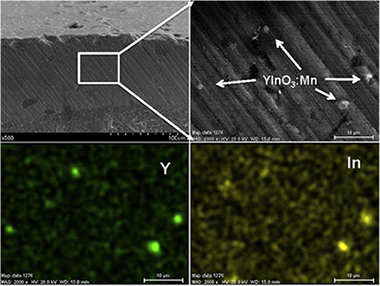
Abstract
Mn-doped YInO3 blue pigments have been synthesised at a much lower temperature (1100 °C) than that required by the traditional solid state method (1400 °C). The developed procedure, which is based on the pyrolysis at 600 °C of aerosols generated from aqueous solutions of Y, In and Mn nitrates followed by an annealing treatment at 1100 °C, yields spherical pigments particles with heterogeneous size in the optimum range required for ceramic applications (<10 μm). The amount of Mn introduced in the YInO3 matrix has been systematically varied in order to evaluate the effects of the Mn content on the colour properties of the pigments. It has been found that the optimum pigment composition (bluer colour with the lowest Mn content) is given by the formula YIn0.90Mn0.10O 3. The technological performance of these YIn1-xMn xO3 blue pigments has also been evaluated by testing their efficiency for colouring ceramic glazes of different composition (boracic and plumbic) and properties, aiming to find a less toxic alternative for the Co-based pigments commonly used by the ceramic industry.
December, 2011 · DOI: 10.1016/j.dyepig.2011.03.009
Materiales Coloidales - Materiales Ópticos Multifuncionales
Angular emission properties of a layer of rare-earth based nanophosphors embedded in one-dimensional photonic crystal coatings
Sánchez-Sobrado, O., Yacomotti, A.M., Calvo, M.E., Martínez, O.E., Ocaña, M., Núñez, N., Levenson, J.A., Míguez, H.Applied Physics Letters, 99 (2011) Article number 051111 DOI: 10.1063/1.3619814

Abstract
The angular properties of light emitted from rare-earth based nanophosphors embedded in optical resonators built in one-dimensional photonic crystal coatings are herein investigated. Strong directional dependence of the photoluminescence spectra is found. Abrupt angular variations of the enhancement caused by the photonic structure and the extraction power are observed, in good agreement with calculated polar emission patterns. Our results confirm that the optical cavity favors the extraction of different wavelengths at different angles and that integration of nanophosphors within photonic crystals provides control over the directional emission properties that could be put into practice in phosphorescent displays.
August, 2011 · DOI: 10.1063/1.3619814
Materiales Ópticos Multifuncionales
Porous supramolecularly templated optical resonators built in 1D photonic crystals
Hidalgo, N., Calvo, M.E., Bellino, M.G., Soler-Illia, G.J.A.A., Míguez, H.Advanced Functional Materials, 21 (2011) 2534-2540 DOI: 10.1002/adfm.201002486
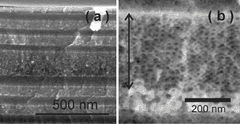
Abstract
A synthetic route to attain photonic multilayers that presents controlled porosity only at the middle-layer level is shown. The spectral resonance associated with this porous layer shows strong sensitivity to the presence of vapors adsorbed or condensed within the void network, providing a potentially relevant material for gas detection. The importance of the interplay between pore and probe-molecule diameters is studied and its implications in size-selective detection are discussed. Controlled porosity: Photonic multilayers that presents controlled porosity only at the middle-layer level are herein introduced. The optical response of the ensemble shows strong sensitivity to the presence of vapors adsorbed or condensed within the void network, providing a potentially relevant material for gas detection.
July, 2011 · DOI: 10.1002/adfm.201002486
Materiales Ópticos Multifuncionales
Interplay of Resonant Cavity Modes with Localized Surface Plasmons: Optical Absorption Properties of Bragg Stacks Integrating Gold Nanoparticles
Olalla Sánchez-Sobrado, Gabriel Lozano, Mauricio E. Calvo, Ana Sánchez-Iglesias, Luis M. Liz-Marzán, Hernán MíguezAdvanced Materials, 23 (2011) 2108-2112 DOI: 10.1002/adma.201004401
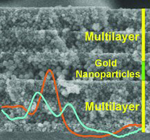
Abstract
A procedure to prepare porous photonic crystal resonators containing gold nanoparticles is reported. The optical absorption of the ensemble, resulting from the excitation of the localized surface plasmon of the metallic beads, is finely tuned by a gradual shift of the cavity mode. This is achieved by infiltration of the void network with different guest compounds.
May, 2011 · DOI: 10.1002/adma.201004401
Materiales Ópticos Multifuncionales
Analysis of artificial opals by scanning near field optical microscopy
Barrio, J; Lozano, G; Lamela, J; Lifante, G; Dorado, LA; Depine, RA; Jaque, F; Miguez, HJ. Appl. Phys., 109 (2011) 083514(5 pages) DOI: 10.1063/1.3573777
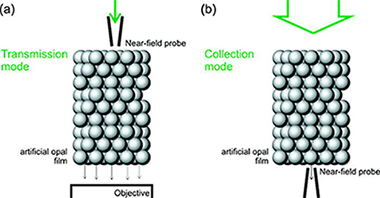
Abstract
Herein we present a detailed analysis of the optical response of artificial opal films realized employing a near-field scanning optical microscope in collection and transmission modes. Near-field patterns measured at the rear surface when a plane wave impinges on the front face are presented with the finding that optical intensity maps present a clear correlation with the periodic arrangement of the outer surface. Calculations based on the vector Korringa-Kohn-Rostoker method reproduce the different profiles experimentally observed as well as the response to the polarization of the incident field. These observations constitute the first experimental confirmation of the collective lattice resonances that give rise to the optical response of these three dimensional periodic structures in the high-energy range.
April, 2011 · DOI: 10.1063/1.3573777
Materiales Coloidales
Tuning from blue to magenta the up-converted emissions of YF3:Tm3+/Yb3+ nanocrystals
Quintanilla, M; Nunez, NO; Cantelar, E; Ocana, M; Cusso, FNanoscale, 3 (2011) 1046-1052 DOI: 10.1039/c0nr00676a
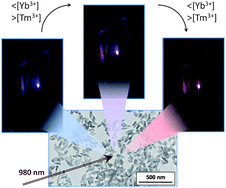
Abstract
Monodisperse YF3:Tm3+/Yb3+ nanocrystals have been synthesized to explore the visible up-converting properties under near infrared (975 nm) excitation. It has been found that the nanoparticles exhibit intense red up-converted emissions, in addition to the characteristic UV and blue Tm3+-bands. It is demonstrated that, by carefully selecting Tm3+ and Yb3+ contents, the relative intensity of the different emissions can be changed producing an overall emission colour that can be tuned from blue to magenta.
March, 2011 · DOI: 10.1039/c0nr00676a
Materiales Coloidales
A facile single-step procedure for the synthesis of luminescent Ln 3+:YVO4 (Ln = Eu or Er + Yb)-silica nanocomposites
Ocana, M; Cantelar, E; Cusso, FMaterials Chemistry and Physics, 125 (2011) 224-230 DOI: 10.1016/j.matchemphys.2010.09.011
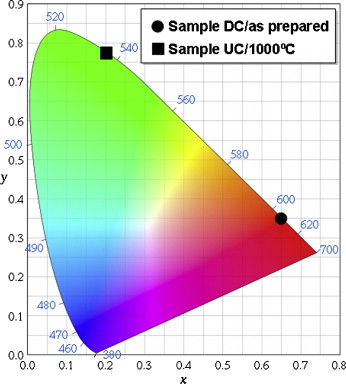
Abstract
A simple and single-step method for the production of Ln-doped YVO 4 nanocrystals and their simultaneous encapsulation in a silica network based on the pyrolysis of liquid aerosols at 800 °C is reported. The procedure is illustrated for Yb,Er:YVO4-silica nanocomposites consisting of spherical particles, which present up-converted green luminescence after IR excitation whose efficiency increased on annealing up to 1000 °C due to the release of impurities (adsorbed water, and residual anions). XPS spectroscopy and TEM observations revealed that the surface of the composite particles was enriched in silica, which would facilitate their functionalisation required to use them in biological applications. The procedure can also be used to prepare other rare earth doped systems as illustrated for the case of Eu-doped YVO4/silica having down-converted red luminescence.
January, 2011 · DOI: 10.1016/j.matchemphys.2010.09.011
2010
2010
Materiales Ópticos Multifuncionales
Versatility and multifunctionality of highly reflecting Bragg mirrors based on nanoparticle multilayers
Olalla Sánchez-Sobrado, Mauricio E. Calvo and Hernán MíguezJournal of Materials Chemistry, 20 (2010) 8240-8246 DOI: 10.1039/c0jm01508c
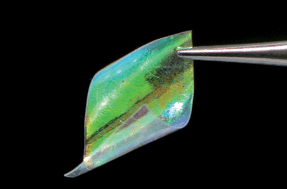
Abstract
The use of both supported and flexible self-standing nanoparticle-based one dimensional photonic crystal films as effective frequency selective filters in the UV-vis-NIR is herein evaluated. The requirements to achieve a flat spectral response at the desired frequency range are analyzed and a synthetic route to realize materials with such properties presented. Strict control over the structural parameters yields multilayers in which the opening or closing of higher order photonic band gaps can be devised, thus leading to films capable of blocking the UV and NIR ranges simultaneously. Furthermore, the physico-chemical properties of the mirror can be modified to yield either moisture-repelling or, on the contrary, environmentally responsive optical filters. These materials present a great potential to be used as versatile and multifunctional optical elements.
October, 2010 · DOI: 10.1039/c0jm01508c
Materiales Coloidales
Citrate mediated synthesis of uniform monazite LnPO(4) (Ln = La, Ce) and Ln:LaPO4 (Ln = Eu, Ce, Ce plus Tb) spheres and their photoluminescence
Nuñez, NO; Liviano, SR; Ocaña, MJournal of Colloid and Interface Science, 349 (2010) 484-491 DOI: 10.1016/j.jcis.2010.05.079

Abstract
A simple method for the synthesis of spherical LaPO4 (monazite) particles with narrow size distribution and tailored size in the 150-500 nm range is reported. The procedure is based on a homogeneous precipitation process at low temperature (120 degrees C) from solutions containing La3+, citrate and phosphate ions under a very restrictive set of experimental conditions, which involves the use of La nitrate, citric acid and phosphoric acid as precursors and ethylene glycol as solvent. The growth mechanism of the spheres was investigated aiming at explaining the differences in particle size and shape observed when varying the experimental conditions. The applicability of this method for the synthesis of spherical particles of other lanthanide (Ce, Tb, Eu) phosphates is also analyzed. Finally, it is shown that the developed procedure can be used to dope the lanthanum phosphate particles with lanthanide cations, which resulted in spherical phosphors as illustrated for the Eu-doped, Ce-doped and Ce, Tb codoped systems, whose luminescent properties are also evaluated.
September, 2010 · DOI: 10.1016/j.jcis.2010.05.079
Materiales Coloidales
Uniform YF3:Yb,Er up-conversion nanophosphors of various morphologies synthesized in polyol media through an ionic liquid
Nuñez, NO; Quintanilla, M; Cantelar, E; Cusso, F; Ocaña, MJournal of Nanoparticle Research, 12 (2010) 2553-2565 DOI: 10.1007/s11051-009-9824-6
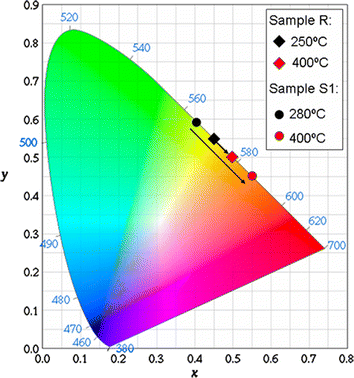
Abstract
We describe a facile procedure for the synthesis at low temperature (120 A degrees C) of water-dispersible uniform YF3:Yb,Er up-conversion nanophosphors of various morphologies (rhombic and spheroidal) by homogeneous precipitation in polyol solutions containing different lanthanide salts and an ionic liquid (1-butyl, 2-methylimidazolium tetrafluoroborate) as fluoride source. It is shown that the shape of the obtained nanoparticles is mainly determined by the nature of both, the polyol and the lanthanide precursors, which also affects to their colloidal stability in water suspensions. These morphological differences are explained on the basis of a different mechanism of particle formation. The efficiency of the up-conversion processes in the synthesized rhombic and spheroidal nanoparticles is also comparatively analyzed and the observed differences are justified on the basis of the different impurities incorporated to the nanophosphors during their synthesis process.
September, 2010 · DOI: 10.1007/s11051-009-9824-6
Materiales Ópticos Multifuncionales - Nanotecnología en Superficies y Plasma
TiO2-SiO2 one-dimensional photonic crystals of controlled porosity by glancing angle physical vapour deposition
Gonzalez-Garcia, L; Lozano, G; Barranco, A; Miguez, H; Gonzalez-Elipe, ARJournal of Materials Chemistry, 20 (2010) 6408-6412 DOI: 10.1039/C0JM00680G
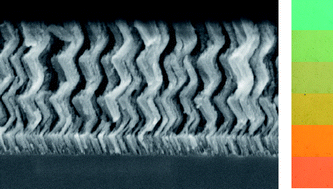
Abstract
Herein we present a synthetic route to attain porous one-dimensional photonic crystals of high optical quality. The method employed, based on the alternate deposition of TiO2 and SiO2 porous layers by glancing angle physical vapour deposition, yields a highly accessible interconnected pore network throughout the entire multilayer structure. Furthermore, it allows a strict control over the average size and density of the interstitial sites, which results in the precise tuning of the refractive index of the individual layers and thus of the optical response of the ensemble. The controlled environmental response of the multilayer is confirmed by the optical monitoring of the infiltration of liquids of different refractive index.
August, 2010 · DOI: 10.1039/C0JM00680G
Materiales Ópticos Multifuncionales
Anomalous group velocity at the high energy range of a 3D photonic nanostructure
Botey, M; Martorell, J; Dorado, LA; Depine, RA; Lozano, G; Miguez, HOptics Express, 18 (2010) 15682-15690 DOI: 10.1364/OE.18.015682
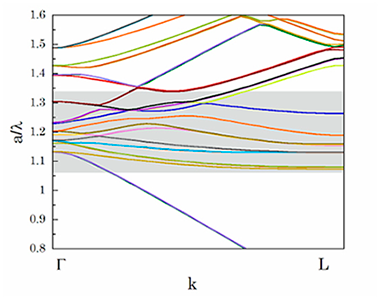
Abstract
We report on a study of electromagnetic waves propagation in thin periodically ordered photonic nanostructures in the spectral range where the light wavelength is on the order of the lattice parameter. The vector KKR method we use allows us to determine the group index from finite photonic structures including extinction providing confirmation of recently emerged results. We show that for certain frequencies the group velocity of opal slabs can either be superluminal or approach zero depending on the crystal thickness and the unavoidable presence of losses. In some cases, group velocity can be negative. Such behavior can be clearly attributed to the finite character of the three-dimensional structure and reproduces previously reported experimental observations. Calculations show that contrary to the predictions of extraordinary group velocity reductions for infinite periodic structures, the group velocity of real opals may exhibit strong fluctuations at the high energy range. Hence, a direct identification between the calculated anomalous group velocities, for an actual opal film, and the predicted propagating low dispersion modes for an ideal infinite ordered structure seems difficult to establish.
July, 2010 · DOI: 10.1364/OE.18.015682
Materiales Ópticos Multifuncionales
Porous One-Dimensional Photonic Crystal Coatings for Gas Detection
Hidalgo, N; Calvo, ME; Colodrero, S; Miguez, HIEEE Sensors Journal, 10 (2010) 1206-1212 DOI: 10.1109/JSEN.2010.2043525
Abstract
Herein, we present an overview of recent progress on the development of different types of porous 1-D photonic crystal coatings which are optically responsive to gas pressure changes in the environment. Modification of the surrounding vapor pressure gives rise to adsorption and condensation phenomena within the porous networks of the photonic crystal building blocks, varying their refractive index and hence their optical features. This effect can be put into practice to precisely detect and monitor changes in the ambient through the spectral shift of either the photonic bandgap of the structure or of some other optical features. Our results demonstrate the potential of these optical coatings as new materials for gas sensing devices.
July, 2010 · DOI: 10.1109/JSEN.2010.2043525
Materiales Ópticos Multifuncionales
Flexible, Adhesive, and Biocompatible Bragg Mirrors Based on Polydimethylsiloxane Infiltrated Nanoparticle Multilayers
Calvo, ME, Miguez, HChemistry of Materials, 22 (2010) 3909-3915 DOI: 10.1021/cm1001016

Abstract
Herein we present a series of self-standing, flexible, and biocompatible optical interference filters obtained through infiltration and polymerization of an elastomer (polydimethylsiloxane) in a porous Bragg mirror prepared by alternating deposition of layers of TiO2 and SiO2 nanoparticles. The method proposed yields the uniform filling of the nanopores of the multilayer by the polymer, which allows lifting off the hybrid structure as long as the ensemble is cooled to temperatures below the glass transition of the polymer. This multifunctional material combines the optical properties of the periodic nanoporous multilayer and the structural and physicochemical characteristics of polydimethylsiloxane. Experimental demonstrations of their potential use as flexible and adhesive UV-protecting filters, as well as of light, highly-efficient conformal back reflectors to enhance the efficiency of photovoltaic devices are provided.
July, 2010 · DOI: 10.1021/cm1001016
Materiales Ópticos Multifuncionales
Angular dependence of the intensity of light beams diffracted by colloidal crystals
Lozano, G; Mazzaferri, JE; Dorado, LA; Ledesma, S; Depine, RA; Miguez, HJournal of the Optical Society of America B-Optical Physics, 27 (2010) 1394-1399 DOI: 10.1364/JOSAB.27.001394
Abstract
An experimental and theoretical analysis of the angular dependence of the diffracted light beams emerging from three-dimensional colloidal photonic crystals is herein presented. Diffracted beams are identified according to their associated reciprocal-lattice vectors, and their intensities are obtained as a function of the zenithal and azimuthal incidence angles. Significant changes in the beam intensities are observed for large zenithal incidence angles as the azimuthal angle is varied. This phenomenon is related to the excitation of new resonant modes inside the photonic crystal which cannot be observed under normal incidence conditions.
June, 2010 · DOI: 10.1364/JOSAB.27.001394
Materiales Ópticos Multifuncionales
Gallium Arsenide Infiltration of Nanoporous Multi layers: A Route to High-Dielectric-Contrast One-Dimensional Photonic Crystals
Sanchez-Sobrado, O; Thomas, K; Povey, I; Pemble, ME; Miguez, HSmall, 6 (2010) 1283-1287 DOI: 10.1002/smll.200902190
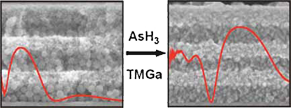
Abstract
Periodic multilayers of wide photonic bandgap and high reflectance in the visible and near infrared regions are fabricated. Optical properties show that reflectance intensities close to 90% are reached for stacks of only six layers, as well as gap-to-midgap ratios of 50%. The optical response of the hybrid ensemble can be accurately tuned through the number of infiltration cycles performed.
June, 2010 · DOI: 10.1002/smll.200902190
Materiales Coloidales - Materiales Ópticos Multifuncionales
Environmentally responsive nanoparticle-based luminescent optical resonators
Sanchez-Sobrado, O; Calvo, ME; Nunez, N; Ocana, M; Lozano, G; Miguez, HNanoscale, 2 (2010) 936-941 DOI: 10.1039/b9nr00338j
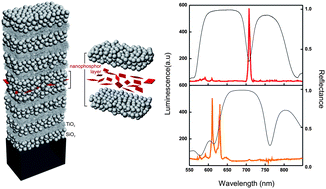
Abstract
In this work, we demonstrate that optical resonators built using all-nanoparticle-based porous building blocks provide a responsive multifunctional matrix, totally different emission spectra being attained from the same embedded luminescent nanophosphors under varying environmental conditions. We show a clear correlation between modifications in the ambient surroundings, the induced changes of the resonant modes, and the resulting variations in the emission response. The method is versatile and allows nanophosphors of arbitrary shape to be integrated in the cavity. By precise control of the spectral features of the optical resonances, luminescence is strongly modulated in selected and tuneable wavelength ranges. Applications in the fields of sensing and detection are foreseen for these materials.
June, 2010 · DOI: 10.1039/b9nr00338j
Materiales Ópticos Multifuncionales
Theoretical Analysis of the Performance of One-Dimensional Photonic Crystal-Based Dye-Sensitized Solar Cells
Lozano, G; Colodrero, S; Caulier, O; Calvo, ME; Miguez, HJournal of Physical Chemistry C, 114 (2010) 3681-3687 DOI: 10.1021/jp9096315
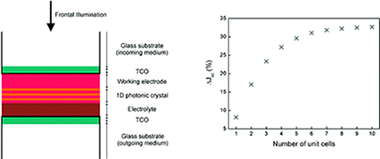
Abstract
A simple analytical model that allows designing one-dimensional photonic crystal based dye sensitized solar cells of optimized performance, accounting for the actual optical features of the device, is herein presented. Based on the theoretical description of the effect of coupling such Bragg mirrors to the light harvesting electrode, recently reported experimental values of the spectral dependence of incident photon to current conversion efficiency attained for such Structures are fairly reproduced and rationalized. A thorough analysis or them in terms of the interplay between the effect of the electrode thickness and the characteristics of the Bragg reflection, such as intensity, spectral position, and width, is provided. Predictions on the maximum enhancement factors expected for realistic Structures are also presented.
March, 2010 · DOI: 10.1021/jp9096315
Nanotecnología en Superficies y Plasma - Materiales Ópticos Multifuncionales
Conformal Growth of Organic Luminescent Planar Defects within Artificial Opals
Aparicio, FJ; Lozano, G; Blaszczyk-Lezak, I; Barranco, A; Miguez, HChemistry of Materials, 22 (2010) 379-385 DOI: 10.1021/cm902819x
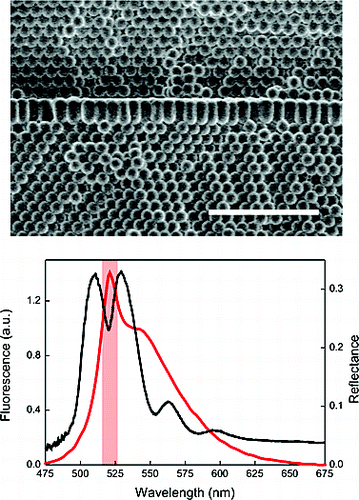
Abstract
Herein, we present the result of combining, for the first time, the techniques of colloidal self-assembly and plasma-enhanced chemical vapor deposition to create a novel, high-quality, purely Organic active photonic crystal structure of controlled optical properties. We show a fast. reliable, and accurate procedure to introduce two-dimensional luminescent organic defect layers within artificial polystyrene opals via a versatile room-temperature remote plasma deposition process. This method is gentle enough to allow highly coil formal growth on polystyrene microspheres without altering their morphology or the ordered arrangement that they form. The luminescent organic layer behaves both as all optical dopant, causing the opening of transmission windows within the forbidden frequency interval of the lattice, and as an optically active material, whose emission call be tailored by the photonic environment.
January, 2010 · DOI: 10.1021/cm902819x
2009
2009
Materiales Ópticos Multifuncionales
Mesostructured Thin Films as Responsive Optical Coatings of Photonic Crystals
Hidalgo, N; Calvo, ME; Miguez, HSmall, 5 (2009) 2309-2315 DOI: 10.1002/smll.200900411

Abstract
A synthetic route is presented to attain high-optical-quality multilayered structures that residtfront coupling ordered n7esoporous tilaniuni oxide thin films to the surface of a dense one-dimensional photonic crystal. Such architectures present spectrally well-defined photon resonant modes localized in the outer coating that finely respond to physicochemically induced modifications of its pore volume. The potential of these porous coatings in detection of environmental changes through variations of the photonic response of the ensemble is demonstrated by performing isothermal optical reflectance measurements under controlled vapor-pressure conditions.
October, 2009 · DOI: 10.1002/smll.200900411
Materiales Ópticos Multifuncionales
Optical Analysis of the Fine Crystalline Structure of Artificial Opal Films
Lozano, G; Dorado, LA; Schinca, D; Depine, RA; Miguez, HLangmuir, 25 (2009) 12860-12864 DOI: 10.1021/la903077r

Abstract
Herein, we present a detailed analysis of the structure of artificial opal films. We demonstrate that, rather than the generally assumed face centered cubic lattice of spheres, opal films are better approximated by rhombohedral assemblies of distorted colloids. Detailed analysis of the optical response in a very wide spectral range (0.4 ≤ a/λ ≤ 2, where a is the conventional lattice constant), as well as at perpendicular and off-normal directions, unambiguously shows that the interparticle distance coincides very approximately with the expected diameter only along directions contained in the same close-packed plane but differs significantly in directions oblique to the [111] one. A full description of the real and reciprocal lattices of actual opal films is provided, as well as of the photonic band structure of the proposed arrangement. The implications of this distortion in the optical response of the lattice are discussed.
October, 2009 · DOI: 10.1021/la903077r
Materiales Coloidales
Synthesis by pyrolysis of aerosols and ceramic application of Cr-doped CaYAlO4 red–orange pigments
Lyubenova, TS; Carda, JB; Ocana, MJournal of the European Ceramic Society, 29 (2009) 2193-2198 DOI: 10.1016/j.jeurceramsoc.2009.01.020

Abstract
The synthesis of red–orange Cr-doped YCaAlO4 pigments has been improved (softer thermal conditions and lower environmental impact) and optimised by using the pyrolysis of aerosols method. We also study the crystallochemical features of the Cr chromophore with special emphasis on its oxidation state which has not been yet clarified, finding that Cr(III) and Cr(IV) species are present in the octahedral and interstitial tetrahedral sites of the YCaAlO4 lattice, respectively. Finally, the applicability of this system as ceramic pigment was tested using conventional industrial glazes. A change from orange to pink shades was detected after glaze firing, which is mainly attributed to the Cr3+ to Cr4+ oxidation.
August, 2009 · DOI: 10.1016/j.jeurceramsoc.2009.01.020
Materiales Ópticos Multifuncionales
Light generation at the anomalous dispersion high energy range of a nonlinear opal film
Botey, M; Maymo, M; Molinos-Gomez, A; Dorado, L; Depine, RA; Lozano, G; Mihi, A; Miguez, H; Martorell, JOptics Express, 17 (2009) 12210-12216 DOI: 10.1364/OE.17.012210
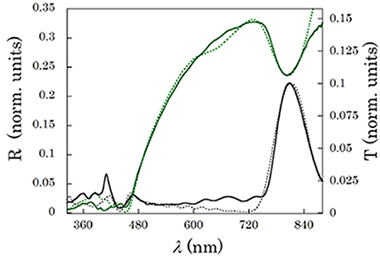
Abstract
We study experimentally and theoretically light propagation and generation at the high energy range of a close-packed fcc photonic crystal of polystyrene spheres coated with a nonlinear material. We observe an enhancement of the second harmonic generation of light that may be explained on the basis of amplification effects arising from propagation at anomalous group velocities. Theoretical calculations are performed to support this assumption. The vector KKR method we use allows us to determine, from the linear response of the crystal, the behavior of the group velocity in our finite photonic structures when losses introduced by absorption or scattering by defects are taken into account assuming a nonzero imaginary part for the dielectric constant. In such structures, we predict large variations of the group velocity for wavelengths on the order or smaller than the lattice constant of the structure, where an anomalous group velocity behavior is associated with the flat bands of the photonic band structure. We find that a direct relation may be established between the group velocity reduction and the enhancement of a light generation processes such as the second harmonic generation we consider. However, frequencies for which the enhancement is found, in the finite photonic crystals we use, do not necessarily coincide with the frequencies of flat high energy bands.
July, 2009 · DOI: 10.1364/OE.17.012210
Materiales Coloidales
M-Doped Al2TiO5 (M=Cr, Mn, Co) Solid Solutions and their Use as Ceramic Pigments
Dondi, M; Lyubenova, TS; Carda, JB; Ocaña, MJournal of the American Ceramic Society, 92 (2009) 1972-1980 DOI: 10.1111/j.1551-2916.2009.03172.x
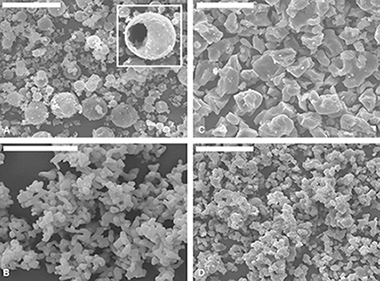
Abstract
New ceramic pigments based on the tialite (Al2TiO5) structure, doped with Co (pink), Cr (green), or Mn (brown), were prepared through the pyrolysis of aerosols followed by calcination of the obtained powders at 1400°C. The expected decomposition of Al2TiO5 into a mixture of Al2O3 and TiO2 on refiring was inhibited by Cr-doping and also by co-doping with Mg the Mn- or Co-doped samples. Microstructure and phase evolution during pigment preparation were monitored by scanning electron microscopy and XRPD. Unit cell parameters of tialite were determined by Rietveld refinement of the X-ray diffraction patterns, revealing in all cases the formation of solid solutions where the solubility of dopants in the Al2TiO5 lattice followed the trend Co<Mn<Cr. The valence state and possible location of dopants in the tialite lattice were investigated by X-ray photoelectron spectra and diffuse reflectance spectroscopies, which suggested the presence of Cr3+ ions in a large interstitial site of the tialite lattice with a distorted octahedral geometry, and of Mn3+ and Co2+ ions in the Al3+ octahedral sites of the tialite lattice in the former case, and in both Al3+ and Ti4+ octahedral sites in the latter. Testing the ceramic glazes assessed the technological behavior of pigments, which found that the color stability was reasonably good for the Mn-doped tialite and the Cr-doped pigment, although the latter suffered a small loss of green hue. The Co-doped pigment was found to be not stable in glazes, undergoing a cobalt-leaching effect.
June, 2009 · DOI: 10.1111/j.1551-2916.2009.03172.x
Materiales Ópticos Multifuncionales
Molding with nanoparticle-based one-dimensional photonic crystals: a route to flexible and transferable Bragg mirrors of high dielectric contrast
Calvo, ME; Sobrado, OS; Lozano, G; Miguez, HJournal of Materials Chemistry, 19 (2009) 3144-3148 DOI: 10.1039/B902090J
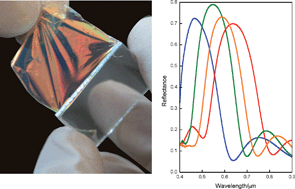
Abstract
Self-standing, flexible Bragg mirror films of high refractive index contrast and showing intense and wide Bragg peaks are herein presented. Nanoparticle-based one-dimensional photonic crystals are used as templates to infiltrate a polymer, which provides the multilayer with mechanical stability while preserving the dielectric contrast existing in the mold. Such films can be lifted off the substrate and used to coat another surface of arbitrary shape.
May, 2009 · DOI: 10.1039/B902090J
Materiales Ópticos Multifuncionales
Towards a full understanding of the growth dynamics and optical response of self-assembled photonic colloidal crystal films
Lozano, GS; Dorado, LA; Depine, RA; Miguez, HJournal of Materials Chemistry, 19 (2009) 185-190 DOI: 10.1039/b811955d
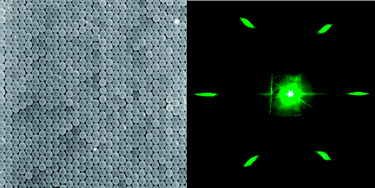
Abstract
Recent advances in the comprehension of the growth dynamics of colloidal crystal films opens the door to rational design of experiments aiming at fabricating lattices in which the density of intrinsic defects is minimized. Since such imperfections have a dramatic effect on scattered light of wavelength smaller than the lattice constant, the evaluation of the experimental optical response at those energy ranges, based on the comparison to rigorous calculations, is identified as the most sensitive guide to accurately evaluate the progress towards the actual realization of defect-free colloidal crystals.
February, 2009 · DOI: 10.1039/b811955d
Materiales Ópticos Multifuncionales
Control over the Structural and Optical Features of Nanoparticle-Based One-Dimensional Photonic Crystals
Calvo, ME; Sanchez-Sobrado, O; Colodrero, S; Miguez, HLangmuir, 25 (2012) 2443-2448 DOI: 10.1021/la8030057
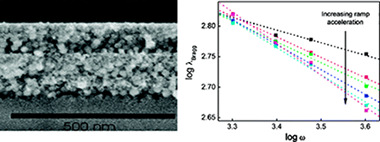
Abstract
Herein we present a detailed analysis of the effect of the spin-coating protocol over the optical properties of nanoparticle-based one-dimensional photonic crystals. Based on these results, we provide a reliable synthetic route to attain high-quality porous multilayers in which the effect of imperfections is minimized and whose Bragg diffraction can be precisely tuned over the entire visible and near-infrared spectrum. We present a systematic study of the effect of the acceleration ramp and final rotation speed over the structural and optical quality of these materials. This allows us to relate the structural variations observed with the different relative importance of fluid flow and solvent evaporation on the thinning of each layer in the stack for the different deposition conditions employed.
February, 2009 · DOI: 10.1021/la8030057
Materiales Coloidales - Materiales Ópticos Multifuncionales
Porous One-Dimensional Photonic Crystals Improve the Power-Conversion Efficiency of Dye-Sensitized Solar Cells
Colodrero, S; Mihi, A; Haggman, L; Ocana, M; Boschloo, G; Hagfeldt, A; Miguez, HAdvanced Materials, 21 (2009) 764-770 DOI: 10.1002/adma.200703115

Abstract
A device for solar-energy conversion was introduced in which a porous and highly reflecting 1D photonic crystal (1D PC) was coupled to a dye-sensitized nanocrystals anatase (NC-TiO2) electrode. The results show that the transparency of the PC-based dye-sensitized solar cells (DSSC) in the visible range of the electromagnetic spectrum is very similar to that of the reference cell. The multilayer whose photonic bandgap has a larger overlap with the absorption band of the ruthenium dye, gives rise to a larger enhancement of the photocurrent. It is also seen that the porous 0.5μm thick PC, whose deleterious effect is compensated by the large increment in photocurrent. The spectral photoelectric response of the cell clearly shows the effect that coupling to a PC has on the current photogenerated in the dye-sensitized electrode.
February, 2009 · DOI: 10.1002/adma.200703115
Materiales Coloidales - Materiales Ópticos Multifuncionales
Experimental Demonstration of the Mechanism of Light Harvesting Enhancement in Photonic-Crystal-Based Dye-Sensitized Solar Cells
Colodrero, S; Mihi, A; Anta, JA; Ocaña, M; Miguez, HJournal of Physical Chemistry C, 113 (2012) 1150-1154 DOI: 10.1021/jp809789s

Abstract
Herein, we report an experimental analysis of the photogenerated current of very thin and uniform dye-sensitized nanocrytalline titanium oxide (nc-TiO2) electrodes coupled to high-quality one-dimensional photonic crystals. The effect of well-defined optical absorption resonances are detected both in optical spectroscopy and photogenerated current experiments, a clear correspondence between them being established. Our study demonstrates that light trapping within absorbing electrodes is responsible for the absorption enhancement that has previously been reported and unveils the mechanism behind it. We prove that this effect improves significantly the power conversion efficiency of very thin electrodes.
January, 2009 · DOI: 10.1021/jp809789s
2008
2008
Materiales Coloidales
Synthesis of Spherical Down- and Up-Conversion NaYF4-Based Nanophosphors with Tunable Size in Ethylene Glycol without Surfactants or Capping Additives
Nunez, NO; Miguez, H; Quintanilla, M; Cantelar, E; Cusso, F; Ocana, MEuropean Journal of Inorganic Chemistry, 29 (2008) 4517-4524 DOI: 10.1002/ejic.200800363
Abstract
A very simple route for the synthesis of spherical down-conversion (DC) and up-conversion (UC) NaYF4-based nanophosphors is described which consists of a precipitation reaction at rather low temperature (max. 120 degrees C) from solutions containing sodium fluoride and appropriate Ln precursors in a common solvent (ethylene glycol/water mixtures), without the use of any other additive (complexing agent or surfactant). The role played by the nature of the yttrium precursor and the solvent on the morphological characteristics of the nanoparticles is discussed. The size of the nanospheres, which crystallized in the cubic alpha-NaYF4 phase, could be tuned within the 45-155 nm range by adjusting the reaction parameters (temperature and ethylene glycol/water ratio). The applicability of this method is illustrated for the synthesis of Eu-III-doped (DC), Tb-III-doped (DC) and Yb-III/Er-III codoped (UC) NaYF4 nanophosphors, whose luminescent properties were also analysed.
October, 2008 · DOI: 10.1002/ejic.200800363
Materiales Ópticos Multifuncionales
Comment on "Observation of higher-order diffraction features in self-assembled photonic crystals"
Dorado, LA; Depine, RA; Miguez, HPhysical Review A, 78 (2008) 037801 DOI: 10.1103/PhysRevA.78.037801
Abstract
The purpose of this Comment is to show that we find that the conclusions presented in a paper by Nair and Vijaya [Phys. Rev. A 76, 053805 (2007)], concerning the perfect periodic ordering of self-assembled photonic crystals, are not supported and contradict previous studies of this matter.
September, 2008 · DOI: 10.1103/PhysRevA.78.037801
Materiales Coloidales - Materiales Ópticos Multifuncionales
Photoconducting Bragg Mirrors based on TiO2 Nanoparticle Multilayers
Calvo, ME; Colodrero, S; Rojas, TC; Anta, JA; Ocana, M; Miguez, HAdvanced Functional Materials, 18 (2008) 2708-2715 DOI: 10.1002/adfm.200800039
Abstract
A synthetic route to building photoconducting films of TiO2 nanoparticles that display bright structural color is presented. The color arises as a result of the periodic modulation of the refractive index, which is achieved by controlling the degree of porosity of each alternate layer through the particle size distribution of the precursor suspensions. The suspensions are cast in the shape of a film by spin-coating, which allows tailoring of the lattice parameter of the periodic multilayer, thus tuning the Bragg peak spectral position (i.e., its color) over the entire visible region. Photoelectrochemical measurements show that the Bragg mirrors are conductive and distort the photocurrent response as a result of the interplay between photon and electron transport.
September, 2008 · DOI: 10.1002/adfm.200800039
Materiales Coloidales - Nanotecnología en Superficies y Plasma - Materiales Ópticos Multifuncionales
Response of nanoparticle-based one-dimensional photonic crystals to ambient vapor pressure
Colodrero, S; Ocana, M; Gonzalez-Elipe, AR; Miguez, HLangmuir, 24 (2008) 9135–9139 DOI: 10.1021/la801210q
Abstract
Herein we report an analysis of the variation of the optical properties of different nanoparticle-based one-dimensional photonic crystal architectures versus changes in the ambient vapor pressure. Gradual shift of the optical response provides us with information on the sorption properties of these structures and allow us to measure precise adsorption isotherms of these porous multilayers. The potential of nanoparticle-based one-dimensional photonic crystals as base materials for optical sensing devices is demonstrated in this way.
August, 2008 · DOI: 10.1021/la801210q
Materiales Coloidales - Materiales Ópticos Multifuncionales
A universal curve for the magnetocaloric effect: an analysis based on scaling relations
Colodrero, Silvia; Ocana, Manuel; Miguez, HernanLangmuir, 24, (2008) 4430–4434 DOI: 10.1021/la703987r
Abstract
Herein we present a fast, reliable method for building nanoparticle-based 1D photonic crystals in which a periodic modulation of the refractive index is built by alternating different types of nanoparticles and by controlling the level of porosity of each layer. The versatility of the method is further confirmed by building up optically doped photonic crystals in which the opening of transmission windows due to the creation of defect states in the gap is demonstrated. The potential of this new type of structure as a sensing material is illustrated by analyzing the specific color changes induced by the infiltration of solvents of different refractive indexes.
March, 2008 · DOI: 10.1021/la703987r
Nanotecnología en Superficies y Plasma - Materiales Ópticos Multifuncionales
Sorption properties of mesoporous multilayer thin films
Fuertes, MC; Colodrero, S; Lozano, G; Gonzalez-Elipe, AR; Grosso, D; Boissiere, C; Sanchez, C; Soler-Illia, GJDAA; Miguez, HJournal of Physical Chemistry C, 112 (2008) 3157-3163 DOI: 10.1021/jp710612y
Abstract
The vapor sorption properties of multilayers made of ordered mesoporous thin films with tailored composition and mesostructure are herein investigated. Optical reflectance measurements versus partial pressure of several vapors are performed to analyze the interplay between the affinity to and the accessibility of the different types of layers in the structure. We find that the behavior of a mesoporous oxide layer within the multilayer largely differs from that of the isolated thin film, its sorption properties being determined by the interaction with neighboring films. An explanation of the phenomena observed in these complex systems is provided in terms of the pore size, the affinity of each type of layer to specific compounds, and the effect of neighboring layers in the sorption properties of bilayers by an independent environmental ellipsometric study.
March, 2008 · DOI: 10.1021/jp710612y
Materiales Ópticos Multifuncionales
Relation between growth dynamics and the spatial distribution of intrinsic defects in self-assembled colloidal crystal films
Lozano, G; Miguez, HApplied Physics Letters, 92 (2008) 091904 DOI: 10.1063/1.2883943
Abstract
Herein we establish a clear relation between the parameters that govern the growth dynamics and the structural quality of colloidal crystal films. We report an optical analysis of the spatial distribution of intrinsic defects in colloidal crystal films and correlate our results with a theoretical model describing the growth dynamics of such lattices. We find that the amount of defects fluctuates periodically and decreases along the growth direction of the lattice. We demonstrate that these spatial variations are a direct consequence of the temporal oscillations of the crystal film formation velocity, which are inherent to the colloidal particle deposition process.
March, 2008 · DOI: 10.1063/1.2883943
Materiales Ópticos Multifuncionales
Spectral Response of Opal-Based Dye-Sensitized Solar Cells
Mihi, A.; Calvo, M. E.; Anta, J. A.; Miguez, H.Journal of Physical Chemistry C, 112 (2008) 13-17 DOI: 10.1021/jp7105633
Abstract
Herein we present an experimental study of the spectral dependence of the photogenerated current of opal-based solar cells. We analyze the incident photon-to-current conversion efficiency (IPCE) for dye-sensitized solar cells in which colloidal crystals are introduced in different configurations. We prove that a dye-sensitized nanocrystalline titanium oxide electrode moulded in the shape of an inverse opal shows a decrease of efficiency for the spectral region in which a photonic stop band opens up. Contrarily, when a standard thin film of disordered titania nanocrystallites is coupled to an inverse opal, the mirror effect of the photonic crystal at band gap frequencies increases the light harvesting efficiency of the cell and thus the IPCE. This effect is further demonstrated by coupling an inverse opal multilayer to a homogeneous electrode, with two well-defined spectral ranges of increased photogenerated current being detected.
January, 2008 · DOI: 10.1021/jp7105633
|
||
|
||
|
|
|
|
|
icms






